 |
Old KOS Bird Reports and Latest News Archive.
Back to Knutsford Ornithological Society Homepage
Joining the KOS
KOS programme - 2025 / 2026
If you'd like to receive an email when this website is updated - click here
Enter the 2025 Sand Martin Competition - click here
28th December 2025 ...... Christmas wanderings with the KOS.
KOS members have been out far and wide over the Christmas period, none more so then our Hon. Secretary Karina. She'll be home for our annual Christmas walk on Tuesday (30/12) but sent me an email before leaving Hong Kong .........." While you were visiting WWT Martin Mere, we were at WWF Mai Po. It’s on the border with mainland China and we had to go through a very high, barbed wire security fence!
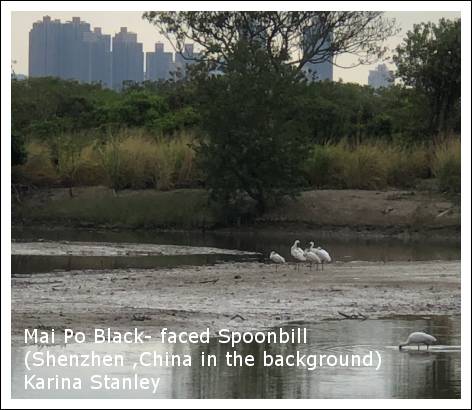
We were lucky to see ~40 of the critically endangered Black-faced Spoonbill which are very similar in appearance to the common Royal Spoonbill I saw in Queensland.
So I asked if these were the same species. Apparently not! The two types have subtle differences, a different range and variations in their mitochondrial DNA. "..........
Meanwhile a little closer to home Geoff and Sheila Blamire enjoyed a Sunday morning stroll around the Plumley area (21/12) ..........."Sunday (21st Dec) morning walk around Plumley/Holford. Ridge Farm: 5 Curlews. Cape of Good Hope Farm area: 50+ Fieldfares, 200+ Starlings, 130+ Pink-footed Geese in 2 skeins flew over. Plumley railway: a perched Raven was ‘singing for ages with a long series of varied, mainly soft sounds, not the usual ‘kruking’ of Ravens in flight. I was expecting another Raven to fly in and to witness a display flight include them rolling together. But no response – such a shame."...........
Phil Rowley headed our way again on Tuesday (23/12)......."Well, that's enough driving for one day!!
I headed back up to Burnágé (as in Farage) to drop off family prezzies and then over to Parkgate for 12.30; the 8.6m high tide was due around 1pm.
A Male Merlin came right overhead at the Old Baths, 7 x Marsh Harriers, several Skylark & Redwing, lots of Brent Geese & Stonechats with big numbers of Curlew, Lapwing and Golden Plover.
Time to put my feet up!".........
On the same day I drove over to Tatton Park, as expected it was very busy so I parked at the Melchett car park and took the path to the Mill Pool. The birds seem happier
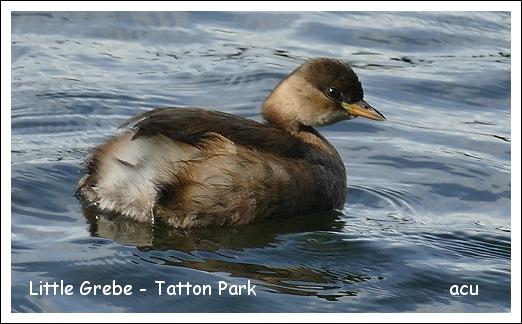 in this quieter part of the Park. A Great White Egret had joined the resident Mallards, Coots, Moorhens, Tufted Ducks, Gadwall and Little Grebes.
in this quieter part of the Park. A Great White Egret had joined the resident Mallards, Coots, Moorhens, Tufted Ducks, Gadwall and Little Grebes.A male Stonechat perched on the wire lattice fence close to the pool, a couple of birders from Crewe had also seen a female - we've learnt over the past few years that where there's a male Stonechat there will be a female nearby (and vice versa) - as is the case with Bullfinches.
On Christmas day Derek and Jean took a walk down nearby Sudlow Lane ......" We went down Sudlow Lane for just over an hour this afternoon, boy was it cold, east wind - the birds had more sense and kept hidden. We saw about a dozen Fieldfare two or three Dunnocks one Blackbird and several Crows and Black headed gulls that was the lot, yet in our garden lovely Great, Blue, Coal, and LT Tits Dunnocks Blackbirds Nuthatch, Collared Dove, Goldfinches and House Sparrows, all from the warmth of our house.
Yesterday a Great Tit was prospecting a bird box and we had a Song thrush in garden, a pleasant surprise "......
Needless to say the Blamires were also out on the big day ......." We did our walk around Holford and Plumley this morning – there was a very, very cold wind – the whole area is really open with no shelter. But it was brilliant! One field opposite Inovyn offices held 60+ Curlews and 54 Lapwings, then close by 40 Fieldfares, then Cape of Good Hope Farm 20+ Wigeon (could have been considerably more). Plumley 20 Fieldfares and few Redwings. Also 1 Buzzard and 2 Kestrels. No Ravens today…."..........
I thought I was lucky to see six Crossbills in Tatton recently, Phil Ashley has gone one step further ..........."I have been looking for nesting crossbill in Macc Forest and Goyt Valley but no luck as yet and unfortunately not a lot of suitable seed cone on conifer trees, fortunately a trip to North Wales came good and found two pairs just finished building, so eggs due next week I reckon.
Also been watching our local covey of grey partridge, 9 in all. I found their night ground roost in the field at the back of Gleave House Farm - with the help of my thermal binoculars!
ironically not seen a roost site for 20yrs in Cheshire, so a nice surprise. "..............
With our Christmas walk coming up on Tuesday, I thought you'd like this reminder of the same outing in 1998.
"27/12/98 Cheshire ornithologist A.W. Boyd always recommended spending part at least of the holidays of the Church out of doors a fine sentiment
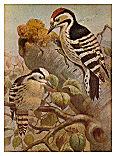 and one we have tried to follow at some stage over the Christmas period for some years now. By tradition those able to attend meet at Arley Hall and follow the public footpaths to picturesque Great Budworth (now the home our independent MP and ex-BBC correspondent Martin Bell, probably the most famous white suit wearer in the world!). The dreaded flu bug reduced numbers somewhat but the most original excuse must go to Pete Hall who felt unable to attend this year owing to the fact that his roof was removed by last night's 80 mph+ gales! Despite the wind and recent rain the going was not too bad, Winter Thrushes were everywhere especially Redwings who seem to outnumber Fieldfares at the moment, a flock of 30 Tree Sparrows was nice to see but the best bird was a superb male Lesser Spotted Woodpecker watched at close range in the grounds of Arley Hall shortly after setting off from the "walker's car park"."
and one we have tried to follow at some stage over the Christmas period for some years now. By tradition those able to attend meet at Arley Hall and follow the public footpaths to picturesque Great Budworth (now the home our independent MP and ex-BBC correspondent Martin Bell, probably the most famous white suit wearer in the world!). The dreaded flu bug reduced numbers somewhat but the most original excuse must go to Pete Hall who felt unable to attend this year owing to the fact that his roof was removed by last night's 80 mph+ gales! Despite the wind and recent rain the going was not too bad, Winter Thrushes were everywhere especially Redwings who seem to outnumber Fieldfares at the moment, a flock of 30 Tree Sparrows was nice to see but the best bird was a superb male Lesser Spotted Woodpecker watched at close range in the grounds of Arley Hall shortly after setting off from the "walker's car park"."OK that's it for another year of fun and frolics with the KOS. It only remains for me to wish all members and anyone else who passes this way a happy, peaceful and healthy new year.
Some statistics.
This page of latest news contains 66,276 words and 202 images and has been accessed by 5,237 people since January 1st 2025.
Since I installed the counter in 2015 folk from 88 countries have arrived and read all about what we get up to!!.
Tony Usher.
22nd December 2025 .............. The winter solstice.
 |
Yes, yesterday - the 21st December was the shortest day of the year, today we'll have a full 2 seconds more daylight and our thoughts can turn to Spring!
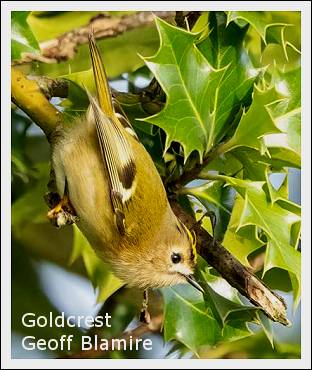 The birds seem to share our, probably mistaken, optimism; yesterday along Gleavehouse Lane in Mobberley Song Thrushes and Dunnocks were both singing, something Geoff and Sheila Blamire found on their daily walk last Tuesday (16/12) ..........." Tuesday: Mereside Lane a Song Thrush was singing in the sunshine! Peacock Lane, High Legh were c24 Fieldfares and c6 Redwings feeding on berries in a hawthorn tree; c12 Goldfinches and 2+ Siskins feeding in an alder; then 2 skeins of Pink-footed Geese (c200) flew overheard. On Moss Lane we watched a Goldcrest feeding close by us (we had 2 Goldcrests yesterday).".............
The birds seem to share our, probably mistaken, optimism; yesterday along Gleavehouse Lane in Mobberley Song Thrushes and Dunnocks were both singing, something Geoff and Sheila Blamire found on their daily walk last Tuesday (16/12) ..........." Tuesday: Mereside Lane a Song Thrush was singing in the sunshine! Peacock Lane, High Legh were c24 Fieldfares and c6 Redwings feeding on berries in a hawthorn tree; c12 Goldfinches and 2+ Siskins feeding in an alder; then 2 skeins of Pink-footed Geese (c200) flew overheard. On Moss Lane we watched a Goldcrest feeding close by us (we had 2 Goldcrests yesterday).".............Derek Pike was feeling optimistic too on a journey back from Macclesfield .........."On the way back from Macclesfield Hospital yesterday afternoon (20/12) having to drive slow behind a tractor in Ollerton there was a Rookery in full swing several pairs of birds, soon be Spring! "............
I've been spending some time in the quieter part of Tatton Park......" I thought it might be a bit busy in Tatton today with an improvement in the weather. It was! The Knutsford drive was crowded with pedestrians, so I drove to the Melchett car park and walked to Millennium Wood via the Swan Clump hoping to bump into some Crossbills.
Plenty of activity in the trees surrounding the Old Hall, mainly noisy Jackdaws but a small flock of Long-tailed Tits moved through the lower branches. Walking along the bank towards Swan clump I thought the stand of Sweet Chestnut trees looked good in the bright sunlight. They look even better in black and white. The clump was quiet, no Crossbills just a couple of Coal Tits and a single Siskin. Only a couple of distant dog walkers; this is the best part of the park at this time of the year.
The Mill Pool held Moorhen, Coot, Little Grebe, Cormorant, Mallard and no less than 10 Gadwall. The Fieldfares I saw last week are still around in large numbers, I guessed about 50, I assume there were some Redwings in the flock as well but they were a good distance away.
Millennium Wood was quiet - Robin, Blackbird, Blue Tit and Goldcrest.
A few new species for my list at Melchett - Black-headed Gull, Pochard (6), Mute Swan (2). Great Tit and Great Spotted Woodpecker on the feeders. More Siskins in the alders at the south end of Tatton Mere.
Heading back to the car I met Darren who confirmed his last day as a ranger will be 27th February, so he'll miss our meeting that night as his colleagues are insisting on going for a quiet(?) drink."........
........." Nice to see you Tony, and Sheila and Geoff earlier.
I had a quick scan of the meres too but not much to report…. A few goldeneye and 6 little grebe on Tatton Mere.
Sorry I missed the pavlova and the Christmas party. I was on driving duty taking my daughter to her work Christmas party in Crewe.
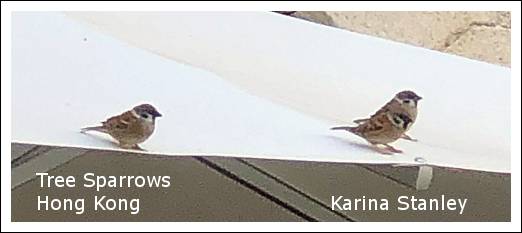
Yes, not long until I join you and get to spend more time birding. Just in time for spring migration!"...............
Thanks Darren - I'm looking forward to being inundated with records for the website once you've hung up your ranger's boots!!
Also enjoying her retirement is our Hon. Secretary, Karina who's hopefully recovered from the disappointment of the Brisbane test match and is now in Hong Kong. She's kindly sent me one her "special" snaps.
Simon and Lyn have paid a second visit to the Southport area ........." We made a return visit yesterday to Marshside, to have a look for the Smew on the Marine Lake. No luck there, but the Pink-footed geese were showing nicely near to the edge of the marsh. We returned via Lunt Meadows,
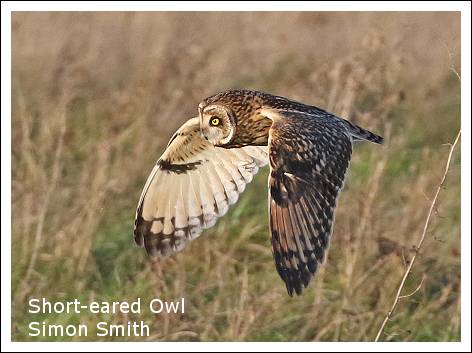 which has changed since we were last there: more & better paths, a learning centre with the possibility of a tearooms opening soon and a ? parking charge. However, the highlight was the appearance of a Short-eared Owl that quartered the field alongside the drive, giving close views in the winter afternoon sunshine. "...........
which has changed since we were last there: more & better paths, a learning centre with the possibility of a tearooms opening soon and a ? parking charge. However, the highlight was the appearance of a Short-eared Owl that quartered the field alongside the drive, giving close views in the winter afternoon sunshine. "...........Thanks Simon a great picture of the owl.
The highlight of our November field trip to Burton Mere Wetlands was the discovery of an Eastern lesser Whitethroat on the walk down to the Border Hide: it's apparently still there and attracting a good deal of attention, according to the Burton Mere Facebook page, although I don't think anyone has managed any photos yet.
Saturday (20/12) Geoff and Sheila now have four Goosanders on their local patch! ............." Little Mere: 4 Goosanders (2m 2f) – bearing in mind that the size of Little Mere is only a little bit bigger than Ciceley Mill pool and a fraction of Rostherne Mere it gets some tremendous birds! Song Thrush singing close by.
Ciceley Mill pool: Water Rail squealing and pair of Mute Swans.
Rostherne Mere: 1f Goosander, Cetti’s Warbler heard and 2 pairs of Mute Swans (1 male wasn't happy having the other pair there). All the other usual wildfowl there except for any Goldeneye.".............
A reminder that it's our Christmas walk on Tuesday 30th December. This year around Neumann's Flash and Dairy House Meadows. 09:30am meeting at the Witton Mill car park CW9 5LN, Sheila Blamire will be leading so please let her know if you're coming along. chairman@10X50.com
Finally a reminder of what we were up to at the end of the last century!!
"21/12/97 Overwintering Blackcaps have been increasing in numbers over the past 20 years, this year though we have not had any locally so a male of the species on the Moor today was a welcome sight, it was in the company of a loose, mixed flock of Tits and finches. Also present in the flock was a single male Brambling and a super little female Lesser Spotted Woodpecker, nice to see one at this time of year when they are very elusive - we normally have to wait until the breeding season when one or two pairs can be located by call."
Lesser Spotted Woodpecker - those were the days!!
15th December 2025 .......... The trip to Marshside and Martin Mere.
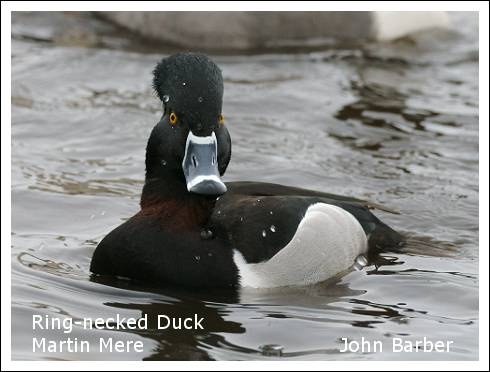 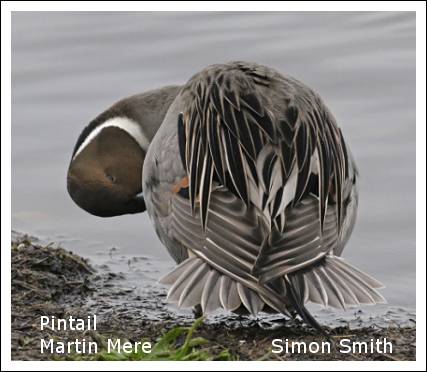 |
I'm afraid this update begins with some sad news. David Cogger died recently (3rd December); At one time he was Secretary of CAWOS (The Cheshire and Wirral Ornithological Society) and had been a KOS member since January 2015. David accompanied us on many field trips over the years and was an ever-present figure at our indoor meetings. Our thoughts are with his wife, Fran, at this most difficult of times.
The BTO is organising a new Bird Atlas covering four Summers and Winters.
.........."In November 2024 BTO announced that we would be leading on another atlas - Bird Atlas 2027-31. This is really exciting and we’ve spent the last year working with potential partners which we plan to announce in the New Year. We’ve also been working hard on considering the fieldwork methods we are going to use, and how we might incorporate new technology such as passive acoustic recording. We’ve established a working group on engagement and inclusion to consider how we can engage with birdwatchers and also reach new audiences to take part. Finally, we’ve had a group working on conservation impact and legacy and how we can have the greatest impact from the atlas on birds, science and people.
We plan to start fieldwork on 1 November 2027 and finish at the end of the breeding season 2031, with four winters and four breeding
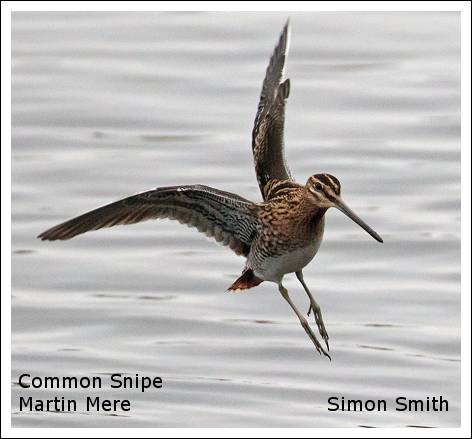 seasons of fieldwork.
seasons of fieldwork.As in Bird Atlas 2007-11 we plan to support bird clubs and groups who would like to undertake a county or regional atlas - we call these ‘local atlases’. We plan to support local atlases as we did last time with data entry, validation, visualisations on progress towards Timed Tetrad Visit coverage, species richness and breeding evidence, plus basic map production and provision of data."..........
The Cheshire and Wirral Ornithological Society will be organising a County atlas that will run concurrently with the national survey.
So, fieldwork will end in mid-2031 and then, of course, the data generated will have to be analysed, maps and text produced before the publication. I think we're looking at 2033.
My proof and sensitivity reader did a quick calculation and suggested that I shouldn't bother ordering one in advance!!
We're currently sitting under a slow-moving belt of rain, so far today (15/12 : 4:30pm) we've had 35.1mm and there's probably more to come. The roads were awash this morning as I drove to Rostherne, the water was yellow with runoff from adjacent fields. This was also evident at Rostherne and a brown stain of sediment was spreading across the mere from Rostherne Brook. I was joined in the obs by Jude Halman, Phil Rowley, Geoff and Sheila Blamire. The wildfowl, like us, didn't seem to be enjoying the rain. The Wigeon, a grazing species, floated in the shelter of overhanging vegetation but five Goldeneye, including a fine adult male, weren't affected as they dived for food just beyond the boathouse. A little male Sparrowhawk passed quickly in front of the obs but didn't bother with the birds on the bird table which was quite busy today with Blue, Great, Coal and Long-tailed Tits. As I left Phil spotted a small group of Siskins flying past
 and later one fed on the table; a pity I'd gone, they're very photogenic, but then again the light today was very poor.
and later one fed on the table; a pity I'd gone, they're very photogenic, but then again the light today was very poor.Geoff and Sheila noticed that a lovely male Goosander had joined the female on Little Mere: it was on its own on Friday (12/12) when they walked past .........." Over the last couple of days heard Coal and Great Tits singing, and this morning 2 Song Thrushes singing along Ciceley Mill Lane! Female Goosander still on Little Mere, along with 12 Tufted Ducks, 7 Gadwalls, 4 Shovelers and numerous Mallards, Coots and Canada Geese."...........
Rain today and rain on Sunday (14/12) for our field trip to Marshside and Martin Mere, heavy to begin with when we arrived at Marshside but by the time we got to Martin Mere it had largely passed over.
Marshside held the usual species we've come to expect with huge flocks of Lapwing and Golden Plover, Mallard, Wigeon, Teal, Shoveler, Coot and Moorhen. Pink-footed, Canada and Greylag Geese fed out on the marsh but this year they'd been joined by a Snow Goose that was initially way off in the distance, before it flew a little closer in the company of a Greylag. It was still hundreds of yards away though and Simon did well to get such a good shot of the pair. The Snow Goose didn't seem to be ringed.
Most of the party decided against visiting any hides other than the Sandgrounders' but Phil Rowley walked to Nell's Hide where he added Brent Goose, Cetti's Warbler, Redshank and Black Swan to our overall day list (any bird seen or heard by any member of the party). Rather than travel to Martin Mere Phil went to Hesketh Bank where he had Skylark, Linnet and Barn Owl.
After a quick visit to the cafe for a coffee our first port of call on the reserve at Martin Mere was the Discovery Hide. As usual it was choc a bloc with birds - Pintail, Tufted Duck, Pochard, Whooper Swans and Mallards but the star of the show was undoubtedly a male Ring-necked Duck that sped about amongst the other wildfowl, constantly diving for food, weaving in out of the scrummage! All of us with cameras took some good shots of the RnD but John's, reproduced at the top of this update, was the best - a real cracker!
Moving on to the Ron Barker Hide we met up with Bob Groom who'd already had a Sparrowhawk plus five Marsh Harriers in the air at the same time. Four Cattle Egret flew by in the distance and, even further away, a Short-eared Owl was picked up as it approached the reserve; it eventually vanished from sight over the far side of the reserve. We had a long trek down to the Harrier Hide but had only two Gadwall, nevertheless a day tick! We sat in the Discovery Hide for the feed at 3pm, I took a bit of video, you can see it here https://www.youtube.com/watch?v=Y2sEb0h4pY0.
We ended the day with a total of 63 different species recorded, slightly down on last year's 68 but a fine effort considering the prevailing weather.
Our thanks go to Frank Dearden for leading this trip, which included a recce the previous weekend!
Further thanks go to Frank, this time with his KOS Treasurer's hat on, for speedily calculating the profit from this years Christmas party on Friday (12/12)
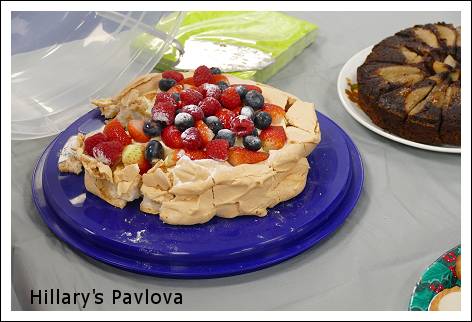
My thanks to all those who attended last night’s party, for all the work that went into arranging and preparing for it and for the many contributions of delicious food. The raffle table was also well loaded with generously donated prizes. And, finally, thank you for your company.
In addition to having a most enjoyable evening, we also raised substantial funds for KOS operations. These were as follows:
Admission £112.00
Raffle £68.00
Bring and Buy £52.20
Donations £30.00
Total £262.20
A great result. Best wishes to all.
Frank
Well done Frank and thanks to everyone who attended, especially those who provided such wonderful food, ranging from Goostrey's pork pies through to that incredible pavlova prepared by Hillary; it stood no chance and vanished in the blink of an eye!
Our next get together is on Tuesday 30th December with our traditional post-Christmas walk. This year around Neumann's Flash and Dairy House Meadows. 09:30am meeting at the Witton Mill car park CW9 5LN, Sheila Blamire will be leading so please let her know if you're coming along. chairman@10X50.com
A look back at Christmas 1999 and our first encounter with a digital camera!
4/12/99 The now annual "Budworth Walk" will take place on Tuesday 28th December, a gentle stroll from Arley to Budworth
 and back, with lunch at the "Red Lion" always marked by the appearance of one or two non-birders anxious to prove that despite their predilection for warm fires and a good book they're as fit as the rest of us!
and back, with lunch at the "Red Lion" always marked by the appearance of one or two non-birders anxious to prove that despite their predilection for warm fires and a good book they're as fit as the rest of us! Another much anticipated event, the KOS Christmas party took place last Friday - the food gets even better, it must be worth joining the Society just to enjoy this yearly feast!! - what's more Barbara's trifle, made to an old Mobberley recipe, made a welcome re-appearance - magic! A further first this year with the appearance of a digital camera (this images was taken using the said instrument). After 40 years helping to push conventional photographic technology as far as it would go I have to admit it's very impressive and can I have one please!
Species recorded on our trip to Marshside and Martin Mere 14th December 2025 |
 |
Geoff and Sheila Blamire found themselves amongst the Curlews on their walk on Sunday morning (7/12) ............"This morning we did our walk around Holford/Plumley – very worthwhile. Started with 78 Curlews in a field opposite Ridge Farm – apparently they are roosting in the fields to west of Birches Crematorium and foraging between there and Ridge Farm. In addition birds are commuting between the Lime beds with highest count of 124 on the beds. Then 20 Wigeon (very flighty), 110 Jackdaws (no other species with them), c40 Starlings and 4 Fieldfares. Towards Plumley 80+ Redwings and 2 Jays making a real racket (the Jays not Redwings!). "...............
Down in the colonies KOS Hon. Sec., Karina also sends news of a Curlew she came across (probably on the day set aside for day#5 of the test!) .........."Following on from the final talk of the year by Andrew Brockbank, ‘Curlews in the Landscape’; whilst walking through the mangroves of Queensland
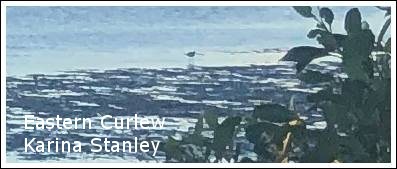 today, what was one of the first birds I saw - an Eastern Curlew!
today, what was one of the first birds I saw - an Eastern Curlew!(If you zoom in you can just about identify its form on the edge of the ocean in the right of the photo)?? Karina "...........
Thanks Karina, not the very best image I've been sent this year but a commendable effort all the same !!!
I spent a couple of hours in the Rostherne obs. on Monday morning ..........."8°C this morning but colder in the obs. so it was a bit damp again. I'd found a suitable thick stick to position on the bird table, more natural for picture taking. Phil Rowley arrived shortly after me and Bob some time later.
72 Wigeon, 11 Mandarin and 110 Teal were counted on the Sunday morning WeBS count; I looked carefully but found only one Teal although two
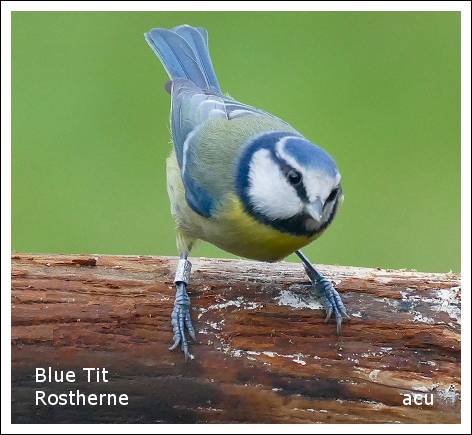 Goosanders, a male and female, appeared at about 10 am. The flock of Wigeon moved to centre of the mere at one point and I counted 36. Also present three Goldeneye, a female and two males, one of which was a bird of the year, showing signs of adult plumage. 26 Shovelers remained amongst the overhanging vegetation at the far end of the mere.
Goosanders, a male and female, appeared at about 10 am. The flock of Wigeon moved to centre of the mere at one point and I counted 36. Also present three Goldeneye, a female and two males, one of which was a bird of the year, showing signs of adult plumage. 26 Shovelers remained amongst the overhanging vegetation at the far end of the mere.A "singing" Stock Dove was a reminder that were approaching the shortest day, then spring will be just around the corner! "............
After Rostherne Phil visited his Mum in Burnage, watched the reds and the following morning headed west .........." Good to see you and Roberto at Rostherne on Monday morning, I stopped over in Burnagé for the MUFC match!!
With storm "Bram" battering away outside whilst tucking into a full proper English brekky in one of Manchester's best café (The Coffee House, Copson St.) I thought a drive over to Denhall Lane would be time well spent and it was.
The lane was empty and within minutes of the car window being down sheltered from the rain a Male Merlin not 50 yards away was hunting Meadow Pipits over the roadside marsh!
The rains gave way for a wander (hobble, sore knee) up to the Firing Range, still not a soul about resulting in really close views of all of the following maybe due to the lack of cyclists and dog walkers?
Several Stonechat, Cetti's, Water Rail, 4 Kestrel, 3 Marsh Harriers, Snipe, Redshank, Great & Little Egret, Peregrine, a huge flock of Lapwing c.1000 and Golden Plover, Pinkies and Brent Geese, sadly no Shorties.
The previous Sundays(7th) stroll through the ruins at the bottom of the garden where I flushed a Woodcock and Tawny Owl proved the same today (no Goshawk this time) with the addition of a Barn Owl quartering the winter wheat fields."..................
The weather on Tuesday (9/12) was certainly a bit challenging, as Phil found. Geoff and Sheila sought shelter in the Rostherne obs. ............"We had a brilliant visit to Rostherne Obs – but only because it started to pour down as we settled in rather than on our walk!
The bird table was very quiet – no Goldfinches (!), very few tits, but 2 Nuthatches. The mere was very quiet as well – no Tufties, no Shovelers, just some Wigeon of note.
Ciceley Mill Pool was better – R-n Parakeet on the way through, then a Little Egret on the way back! ".............
Confirmation from Wendy Stratford that at least one of Mobberley's Stonechats is still on Gleavehouse Lane ........"After 3 walks up Gleavehouse Lane over the last week unsuccessfully looking for the stonechats I finally saw one today! The male was perched on the pile of metal rubbish in front of the hay barn - couldn't see the female anywhere. The weather was windy with rain in the air, but there were about 200 starlings feeding in the first field on the right as you turn into the lane. About the same number were in the field opposite us when I left home - could be the same group. "..........
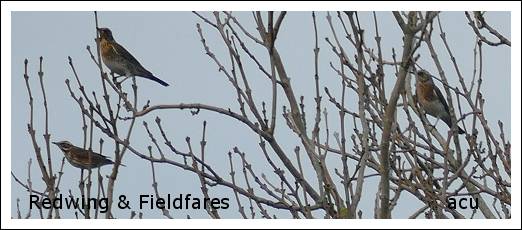 I had an interesting walk in Tatton on Wednesday (10/12).........."11°C this afternoon as I walked from the Melchett car park towards the Mill Pool but it seemed much cooler with a strong southerly wind blowing. Just before reaching the pool six birds flew overhead calling and seemed to land in the conifers of Swan Clump, my mind went back to a similar event some time ago. (a long time ago!)
I had an interesting walk in Tatton on Wednesday (10/12).........."11°C this afternoon as I walked from the Melchett car park towards the Mill Pool but it seemed much cooler with a strong southerly wind blowing. Just before reaching the pool six birds flew overhead calling and seemed to land in the conifers of Swan Clump, my mind went back to a similar event some time ago. (a long time ago!)22/02/98 It appears that my recent Crossbill record was the start of a mini invasion! On Wednesday two observers located 3 birds in "Swan Clump" a small stand of Scots Pine to the rear of the Old Hall, this had increased to 10 on Thursday with 5 remaining yesterday. None were in evidence this morning until 11:00am when a group of three flew in from Hanging Bank. Also this week the first Curlews of the Season, a group of 21 returned to the Park - they were seen in the deer enclosure, where today no less than 9 Buzzards were counted.
(Notice the returning Curlews: the first of the season!!)
I immediately changed course and made for the conifers and spent some time there but failed to catch up with them. The only birds present were single Goldcrests and Wren.
There was a good selection of species on the Mill Pool and I counted 8 Gadwall, 41 Mallard, 6 Coot, 1 Moorhen, 4 Tufted Duck and a Little Grebe. A large (c.70) flock of Winter thrushes appeared, settling briefly in an ash tree next to the pumping station. I thought they were all Fieldfares but, looking at one of the snaps I took, it revealed at least one was a Redwing."...........
I returned this afternoon (11/12) but there was no sign of the birds, although I did see and hear a Green Woodpecker.
Don't forget that tomorrow night it's the annual Christmas party, followed on Sunday (14/12) with the December field trip to Marshside and Martin Mere.
7th December 2025 ........ Great White Egrets back in Tatton.
KOS members have been on their travels over the past couple of weeks; Jude Halman, Colin Butler and Phil Ashley returned from Fuerteventura last Friday (28/11) and Geoff and
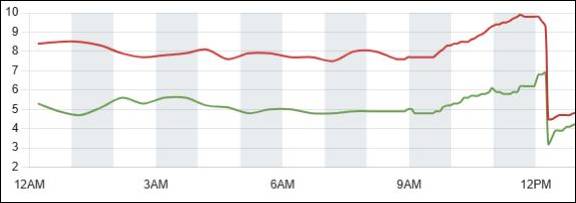 Sheila Blamire from India on Thursday (4/12). Our Hon. Secretary has hopped over to Brisbane for a cricket match, she and David have tickets for all five days. Perhaps a tad optimistic!
Sheila Blamire from India on Thursday (4/12). Our Hon. Secretary has hopped over to Brisbane for a cricket match, she and David have tickets for all five days. Perhaps a tad optimistic!Back here in Blighty we've had some interesting weather conditions........."9.5°C this morning (1/12) with some rain showers but it wasn't half as bad as the Met Office had predicted. The inside of the obs was 4 degrees colder than outside so windows and optics steamed up and everywhere was very soggy!
Jude and I were joined by John Adshead who had decided, given the forecast, against ringing but he'd brought along some apples that he was going to spread on the ground in Dolls Meadow hoping to attract winter thrushes to his ringing patch. He was reacquainted with many of the birds he'd ringed recently - just about every Blue, Great and Coal Tit was sporting a tiny silver BTO ring!
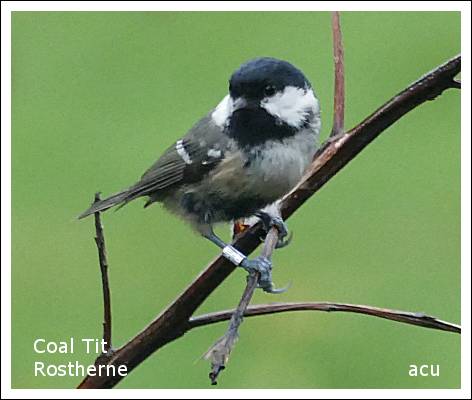
Not much activity on the mere but we did record Little and Great Crested Grebes, Goldeneye, Pochard and Wigeon. A small male Sparrowhawk came by, very close to the obs. A Redpoll appeared for a short time in the tangle of vegetation below us and further out, in the mereside alders, a mixed flock of about 40 Goldfinches and Siskins provided some colour on a dull and misty morning.
Last Friday (28/11) I spent an hour in Dog Wood but recorded nothing of note, so I decided to drive through Knutsford and try my luck on the other side of Tatton Mere. As I started down the Knutsford Drive a tremendous storm broke - heavy rain and hailstones: the mere seemed to be boiling! When I arrived home my weather station revealed that the temperature dropped by 5.5°C in as many minutes. (see the chart)"..........
Tatton Ranger, Darren Morris tells me that the two Great White Egrets have returned to the park (1/12) ........" Two GWE’s on Tatton mere today one of which was the red ringed one.
You and Sheila will have an email from my colleague, Saul. He is taking over writing the Tatton Wildlife Newsletter and I have asked him to forward a copy to you both each season.".........
Thanks Darren and thanks Saul, the aforementioned Winter Wildlife Newsletter duly arrived and you can read it by clicking here.
On Friday(5/12) I stopped off at Tatton on the way back from Ashley Pool (the big stretch of water next to the railway line, just after leaving Ashley station on the way to Mobberley). Apart from a few Mallard
 it was deserted unlike this time last year when it hosted Tufted Duck, Goosander, Teal and Little Grebe. It wasn't a wasted journey though as I managed a reasonable image of one of Darren's Great White Egrets; the un-ringed one at the north end of Tatton Mere.
it was deserted unlike this time last year when it hosted Tufted Duck, Goosander, Teal and Little Grebe. It wasn't a wasted journey though as I managed a reasonable image of one of Darren's Great White Egrets; the un-ringed one at the north end of Tatton Mere.Earlier in the week (3/12) I'd been in the park again ........." A cold easterly this morning, just 3.8°C as I walked from the Melchett car park in Tatton up towards the Mill Pool. Plenty of squeaking Meadow Pipits and, at the other end of the audio spectrum, croaking Ravens in the Swan Clump were very active; they'll be nest building in a few weeks time. Seven Gadwall on the Mill Pool plus single figures of Coot, Tufted Duck and Mallard.
Perhaps taking a cue from the Ravens a Mistle Thrush sang briefly as I approached the Millennium Wood, very quiet inside the wood just a single Goldcrest and a few Blue Tits. Overhead a small flock of Redwings heading north.
Returning back to Melchett Mere I spent a short time in the Allen Hide. More Tufted Duck, a few Pochard, one Mute Swan, a single Little Grebe and a Great Spotted Woodpecker on the feeders with the usual members of the Tit family.
Walking back to the car the resident pair of Stonechats were still finding flying insects, presumably Winter Gnats.
.................." Winter gnats or winter crane flies are the long legged, swarm forming, flies of the cold. This is a small family, formally called Trichoceridae, with only 10 species occurring in the UK from just two genera. However British crane flies are now included in this family and there is thought that maybe there is up to 14 species. Even in the UK there are species still to be described or reassessed and new discoveries
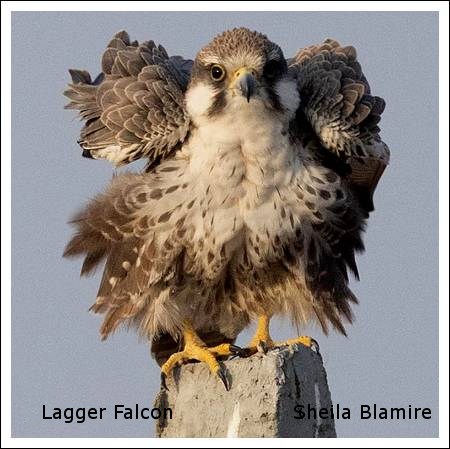 to be had. There are only 160 species that have been described globally, a not unexpected number given how tough it is to live in the adverse conditions of winter."...................
to be had. There are only 160 species that have been described globally, a not unexpected number given how tough it is to live in the adverse conditions of winter."...................The alders near the car park are still in leaf and were populated by an unknown number of Siskins. "...........
It didn't take long for Geoff and Sheila to get out and about again following their return from India ........." Got back from holiday on Thursday afternoon (4/12) and we resumed our walking Friday morning (5/12). Little Mere: 1m 1f Goosanders, 1 Great Crested Grebe, 2m 1f Gadwalls, 1m Shoveler, Grey Heron, several Tufted Ducks, Coots and 1 Cormorant. Saturday 1f Goosander on Ciceley Mill Pool with 1m 1f Goosanders still on Little Mere. Rostherne Mere was quite, but numerous small birds frequented the table (Goldfinch, Chaffinch, Nuthatch, 3 species tit, Robin, Blackbird, etc). Earlier had Simon had heard Water Rail and nice to see a Goldcrest. "...........
Sheila sent me the Lagger Falcon picture while they were still in India. If there are any more of that quality it looks like the basis of a good presentation one evening!
On the subject of presentations, guest speakers at our indoor meetings, on the fourth Friday of the month, don't come cheap nowadays. This coming Friday (12th December) it's our annual Christmas party in the Jubilee Hall and the only fund raiser of the year, so I hope all members will make an effort to attend; last year we made a much-needed profit of £468, enough for three speakers during 2025.
Please let Sheila know if you're coming along chairman@10x50.com
Next Sunday it's our field trip to Marshside and Martin Mere,
Sunday 14th Dec RSPB Marshside and Martin Mere WWT, meet in Marshside car park at 10 am. Leader: Frank Dearden frank.dearden@icloud.com Please let Frank know if you're coming along.
Assemble at car park PR9 9NT for RSPB Marshside off Marine Drive, Southport (Free parking for RSPB members; £1.50 for up to 2 hrs parking for non-members)
https://www.rspb.org.uk/reserves-and-events/reserves-a-z/marshside/
(It's about 1hr 10 mins from Knutsford)
Head to Martin Mere for lunch.
WWT Martin Mere, Fish Lane, Burscough, Lancashire, L40 0TA
You can save 10% by purchasing tickets on-line.
Adult on-line pre-booked £16.29 (no Gift Aid)
Concession on-line pre-booked £14.81 (no Gift Aid)
The 10% discount is available until midnight on the day before your visit.
This trip has always been popular - here's what we saw 26 years ago -
"07/12/99 The annual trip to Marshside and Martin's Mere, two reserves in Merseyside run by the RSPB and the Wildfowl and Wetlands Trust respectively, is always popular with KOS members providing good views of species in the wild combined with an opportunity for a closer approach in the pens at Martin's Mere. Very strong westerly winds blew for most of the day and we were glad of the shelter afforded by the RSPB's "Sandgrounders" hide on the front at Marshside, large flocks of Pink-footed Geese, Greylags and Wigeon were present but there was little movement with the birds sensibly sitting out the gales. A passing Merlin caused a certain amount of consternation and forced the wintering flocks of Lapwings into the air, many hundreds were counted, it appears that there has been an influx from the continent, with some species anxious to escape the already freezing temperature on mainland Europe, these include Waxwings with many records from the east coast but few so far in our area, although singles have been seen at Sandbach and Heald Green. Moving on to Martin's Mere we lunched in the warmth of the main building reluctantly venturing out round the hides where we were rewarded by the usual super views of Whooper and Bewick's Swans and a Cattle Egret that had arrived back on the reserve earlier in the day, it was apparently resident for some time earlier in the year! Back in the shop there were some bargains to be had "Where to Watch birds in Scandinavia" by Gustaf Aluén was available £2.49 with the Macmillan Guide only £4.99."
You'll notice we saw Bewick's Swans at Martin Mere: those days have gone now!
26th November 2025 .........Stonechats in Mobberley
 |
Geoff and Sheila Blamire enjoyed the company of two welcome guests in their garden last Friday (21/11)..........." After a quick 5+km walk this morning (it was chilly!), I was looking out of the back window and saw a male Blackcap feeding on our spindle berries – fabulous to see. Then a short time later I saw a female Blackcap feeding on the berries. Saw both birds a couple times again but never together. If the male and female weren't so distinctive I would have assumed there was just one bird."..........
We've had some cold nights of late, the temperature on my weather station recorded a low of -5⁰C early on Friday morning; Pavement Lane, here in Mobberley, was like an ice rink but it was OK the following day and I walked down to Gleavehouse Lane and was pleased to catch up with the two Stonechats reported recently by Wendy Stratford, it was a gloomy day so I didn't manage to get any pictures of the birds. They were in the hedge next to Blackthorn Farm so, despite the recent cold snap, there were plenty of flying insects available for the two. Hopefully they'll spend the winter there.
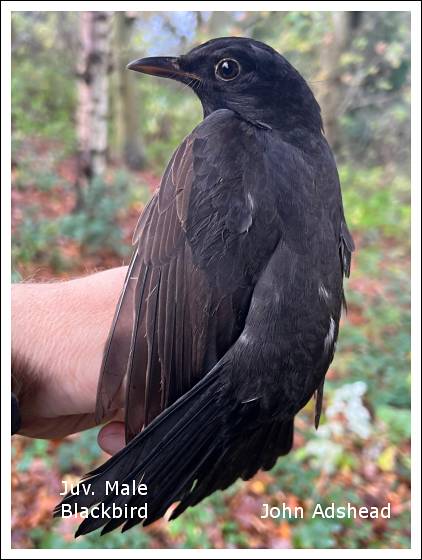 Monday morning (24/11) found me, as usual, at Rostherne mere NNR. ..........." 4.9°C in the Rostherne obs this morning, rising to only 6°C when I left at about 12:15pm; the northerly wind didn't help as it blew straight in through the open windows, especially during one of the frequent showers. There were some intervals of bright sunshine though, giving me a chance to do a wildfowl count as it was very bright and exceptionally clear. In fact through the big binocs. set to 40X I could make out sheep grazing on the slopes of Winter Hill, 22 miles away!
Monday morning (24/11) found me, as usual, at Rostherne mere NNR. ..........." 4.9°C in the Rostherne obs this morning, rising to only 6°C when I left at about 12:15pm; the northerly wind didn't help as it blew straight in through the open windows, especially during one of the frequent showers. There were some intervals of bright sunshine though, giving me a chance to do a wildfowl count as it was very bright and exceptionally clear. In fact through the big binocs. set to 40X I could make out sheep grazing on the slopes of Winter Hill, 22 miles away!Mute Swan 2, Goosander 2 - f/imm., Wigeon 10, Gadwall 8, Pochard 4, Tufted Duck 8, Teal 36, Shoveler, 1, Goldeneye 2 (one of which showed signs of moulting into male plumage; lots of white speckling on it's flanks).
Also there one Buzzard (found by Bob), a Water Rail calling, one Grey Heron, one female Bullfinch and a Peregrine seen by Malcolm Calvert and John Adshead, over the church, as they left.
The two ringers had a Great White Egret early doors but I never saw it during the time I was there.
From John - 27 birds ringed this morning before rain and wind halted proceedings. Three new Blackbirds including this young male (showing retained juv brown feathers) and a nice Treecreeper..".............
John was back at the reserve this morning (26/11) ........" Limited nets due to weather this morning still caught well. Another new fem. Cetti Warbler, Lesser Redpoll and several Goldfinches the highlights. Saw Water Rail, Raven, Snipe, 3 Goldeneye Inc drake, Ring-necked Parakeet, dozen Lesser Redpolls and 100 Woodpigeons left the Harper's Bank Wood roost. "..........
I spent a couple of hours this morning (26/11) in Tatton Park's Dog Wood - just 1⁰c , so quite chilly and there weren't many other people about. Jays were busy collecting acorns and the resident Nuthatches were very active, as were the Mallards on Tatton Mere - they seemed to think it was already Spring. Calm down chaps there's a long way to go yet!
There's a just discernible path down to the side of the mere overlooking the Knutsford (south) end, I could hear, but not see, Teal. Also present Tufted Duck, Gadwall, Mute Swans, Canada and Greylag Geese, Pochard, Goldeneye, Great White Egret, Grey Heron, Great Crested and Little Grebes, Moorhens and Coot: I didn't attempt a count.
I found this entry in the archive section of the website from 27 years ago.
"26/11/98 Pintails were quite common in Tatton during the 1970's and 80's the record is a count of c.130 birds present during a wildfowl count on a cold and misty morning in February 1979, [a memorable day for those present as there was also a Red-necked Grebe on the main Mere at the same time. Always ready to put one over on the Rostherne crew we hastened to the nearest phone box (no cell phones in those days!) to report our mega tick to the then Warden, Tom Wall who offered us his congratulations but then spoilt things by informing us that they had just had two on their Rostherne count!] Anyway back to Pintails - at that time they were common visitors in their hundreds to Rostherne, Tatton was not as attractive to the species but flocks from Rostherne often overflew the Park. Numbers visiting this part of Cheshire have, for some reason, dropped dramatically since then, in fact the latest Cheshire Bird Report (1997) records Rostherne's lowest maximum count since 1961; only 9 birds, consequently Tatton now has very few records so a fine male was a welcome sight last week as it swam on Melchett Mere with a group of 15 Wigeon. Elsewhere finch flocks are currently smaller than last year at this time, but they were exceptionally large in 1997, nevertheless we did come across a gathering of 60 in Dog Wood feeding below the Oak trees, mostly Chaffinches but they were accompanied by a handful of Bramblings, their white rumps showing well as they moved in a loose group through the wood."
A reminder from our KOS Secretary Karina about upcoming events -
Our final indoor speaker meeting of 2025 takes place next Friday 28th November. We look forward to seeing you there in the warmth and comfort of Jubilee Hall.
28th November 2025 8pm Jubilee Hall, Stanley Road, Knutsford. WA16 0GP.
‘Curlews in the Landscape’ by Andrew Brockbank
Delayed from last year due to ill health, Andrew Brockbank will review the factors affecting population decline, the conservation measures and the main actions required if we are to see the recovery of this much-loved wader.
Planning for our Christmas party on Friday 12th December is well under way. Thank you everyone for your kind offers of help and contributions. It will be great to see you there.
Please contact Sheila: chairman@10x50.com if you require any further information.
Two days after the Christmas party (Sunday 14th December) it's our December trip to RSPB Marshside and WWT Martin Mere.
Dec 14 Sun Marshside RSPB and Martin Mere WWT, meet in Marshside car park at 10am. Leader: Frank Dearden.
Please let Frank know in advance if you're coming along frank.dearden@icloud.com
Our traditional Christmas walk will take place again this year. Sheila is leading so kindly let her know to expect you: chairman@10x50.com
Tuesday 30th December. Neumann’s Flash and Dairy House Meadows. 9:30 am. Meet at the Witton Mill car park.
Sat.Nav.CW9 5LN near the entrance to the Northwich Recycling Centre.
With very best wishes to everyone for a happy and healthy Christmas & New Year.
Karina
secretary@10x50.com
19th November 2025 ......... Burton Mere.
The November field trip to the RSPB's Burton Mere Wetlands began with a period of some confusion! With a start time of 09:30am most people enjoyed a stress free journey up the M6 then along the M56 arriving at our destination in good time at about 09:10am.
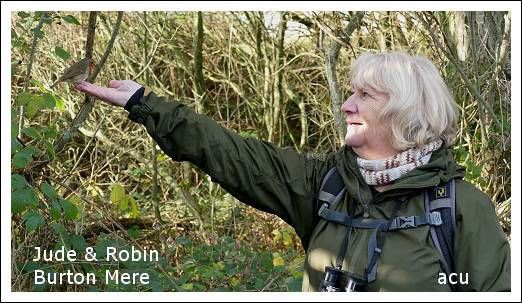 Unfortunately those who left Knutsford later than 08:30am found the M6 closed at junction 19 due to an incident involving a pedestrian and a motor vehicle. One of our number, travelling from further south, spent over an hour stationary on the motorway!
Unfortunately those who left Knutsford later than 08:30am found the M6 closed at junction 19 due to an incident involving a pedestrian and a motor vehicle. One of our number, travelling from further south, spent over an hour stationary on the motorway!Eventually everyone arrived safely and the day rapidly improved, but not before initial disappointment with the view from the visitor centre; the water level was very high and the islands on the scrape that normally hold flocks of waders and wildfowl were practically deserted. Nevertheless there were some birds to be seen and the day list began with some of the expected species we've become accustomed to at Burton: Coot, Teal, Moorhen, Mallard, Shoveler, Gadwall, Mute Swan, Grey Heron. Overhead smaller than expected flocks of Pink-footed, Greylag and Canada geese; good views of two female/immature Marsh Harriers that were joined by an adult male. Folk who walked up to the Bunker hide reported Little Egret, Mistle Thrush and Great Spotted Woodpecker.
Leaving the visitor centre the feeders were very busy and Blue, Great and Coal Tit, Nuthatch and Chaffinch were added to a rapidly expanding list. The cafe was now open so, as some stragglers had yet to arrive, we popped in for a coffee plus a slice of fruit cake, I took the healthy option and enjoyed a Goostrey's sausage roll.
A nice selection of birds from the Marsh Covert hide included Kingfisher, Stonechat, Water Rail, Redshank, Little Grebe, Ruff, Raven and Chiffchaff.
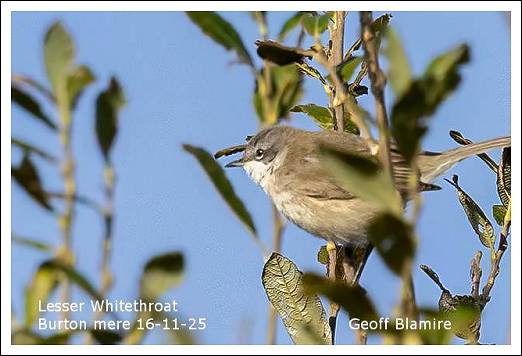
It was here we met up with a group of four kids and their three leaders, members of the Liverpool RSPB Wildlife Explorers - great to see such enthusiasm from tomorrow's birders! I took a nice picture of the four explorers scanning the pool with their binoculars and said I'd give them a mention in the latest update. I also took the precaution of contacting the chap who runs the group and asked if it would be OK to include the picture on 10X50.com .........."The RSPB has safeguarding procedures in place to protect young people, and photos cannot be taken of them without their permission. Unfortunately, the photo cannot be used and needs to be deleted."............
A sign of the times we live in!
We bumped into the group later as they lined up, arms outstretched, as they tempted a very tame Robin to land on their hands and pick up the crumbs on offer. Again pictures verboten! So I've included a picture of Jude Halman with the Robin, she gave her permission for me to include it!!
There followed a great example of observational skills from two of out newer members - Phil Ashley and Colin Butler.
Phil located a very active LBJ (actually an LGJ!) in a tall willow overhanging the path. After 15' or so and much discussion it was identified as a Lesser Whitethroat, Geoff Blamire managed some good images of the bird. As the nominate species (Sylvia curruca) is a summer visitor to the UK we thought it might be one of the eastern races but that's as far as our combined knowledge went!
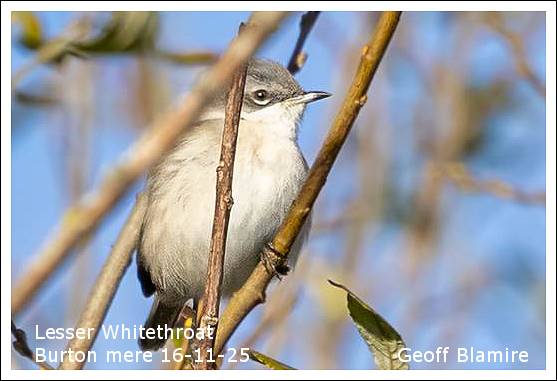
I sent Geoff's images to Hugh Pulsford ........." Always a difficult one these birds, they are meant to be shorter winged than the standard Curruca, always difficult to note in the field, it does seem to have a supercilium, but its not very distinctive from this photo, although it does seem to have more brown than grey going up the back of the head, and generally looks brown rather than greyish, particularly underparts.. I think other features would be a completely white outer tail feather (T6) and a white notch on the next tail feather (T5) but these are more "in the hand" features. I guess it probably is on the blythi—halimodendri spectrum somewhere !
any self respectable Curruca should be warming its toes in Africa/Arabia by now.
Nice bird nonetheless. "........... Thanks Hugh!
Sheila Blamire also did some investigations ......" I've been talking to Tony Broome (also Jane Turner) it is a Blythi Lesser Whitethroat (eastern) but you can't prove it without DNA!"...........
So, after all that excitement, we finally made it to the Border hide overlooking the centenary and border pools. Again the water level was very high and I don't think the list received any new ones from there. On the return leg back to the visitor centre some of the more active team members walked up the trail to the viewpoint overlooking the estuary and we were able to add Whooper Swan, Glossy Ibis and Curlew to the list. The stand of alder trees viewable from the boardwalk contained Goldfinches, Siskins and a single Goldcrest.
Arriving back at the centre some of the party decided to drive up to Parkgate where Great White Egret, Short-eared Owl, Barn Owl, Tawny Owl and Peregrine brought the total number of species recorded to a very respectable 67 species.
Back at home Wendy Stratford enjoyed a walk around Tatton park on Saturday (15/11)........." Today we have a small pond in the field opposite, and I watch a buzzard feeding around it (worms etc presumably) for about 15 mins. He was like a blackbird - walk, stop and listen, run and catch (repeat)!
Then we went into Tatton and had a good walk around the mere. Lots of tufted duck, pochard and so many coots (must have been a good year), 4 gcg (no chick), a male goldeneye with at least 2 females/juveniles, a little grebe and the great white egret near the fence across the mere at the Knutsford end. There were 2 (maybe 3) stonechats on the west bank - they were around most of the walk up on the bank. Looked like 2 males - one a juvenile maybe. They were very busy, one had a hairy caterpillar which he worked hard to de-hair! ".............
In Mobberley Phil Ashley has sent me a couple of texts this week regarding birds seen whilst at work at Gleave House farm.
.........."(17/11) Flock of possibly 200 to 300 linnets, around maize stubble."
Today (19/11) one or two Jack Snipe about in the stubble field and paddocks around my works area .............
I've received a request from Kevin Griffiths who is on the Friends of the Heath committee.
I recently watched a webinar hosted by the Cheshire Wildlife Trust (CWT) about the Mersey Estuary, and I thought you and the other KOS members might find the discussion on wetland birds interesting. You can watch it here:
https://www.youtube.com/watch?v=RHSFdTrw-Zo
After viewing the webinar, I signed an open letter calling for the establishment of an independent commission to review tidal energy generation in the Mersey Estuary. Such a commission would operate free from political influence, providing unbiased and transparent advice that prioritises the public's best interests. If you support the formation of a commission, I encourage you to add your signature to CWT's letter to the National Energy Systems Operator, which you can find at the link below:
https://actionnetwork.org/petitions/we-need-an-independent-commission-to-scrutinise-tidal-energy-generation-in-the-mersey-estuary?source=direct_link&mc_cid=73820b601e&mc_eid=34be03730b
Please spread the word. Thanks, Kevin.
Finally another look back in time, from this week 26 years ago.
19/11/99 A run of easterly winds during the week has brought in a second wave of Winter thrushes, mainly Fieldfares, these now outnumber the Redwings that had been the most numerous until now. Arriving at the same time, more Siskins, seen and heard flying over open country in substantial groups in a general south-westerly direction. Also much in evidence further flocks of Pink-footed Geese heading west to east, I believe there are 23,000 in the Southport area and a massive 75,000 in Norfolk. I watched a flock of c50 for over 10 minutes as they passed over Mobberley at 8.00am on a frosty, crystal clear morning, they passed over the Pennines between Macclesfield and Congleton, unnoticed by most people but a stirring experience for all birders especially if the birds were first picked up by sound; wild, evocative and timeless.
Species recorded on our trip to the Wirral on 16th November 2025 |
The mid-range weather forecast predicts much colder conditions next week as a cold front descends from the north. In the mean time we're enjoying some wild and windy weather, quite mild, at 7⁰C with frequent squally showers (14/11).
After recovering from the first 'flu bug of the winter it was nice to be out after more than a week indoors......." It was great to be out in the fresh morning air at Rostherne once again after 10 days or so languishing indoors. Just 10°C, but it was clear and bright and the big 40X binoculars were able to pick out most of the wildfowl, many of which were well concealed in the tangle of roots and overhanging branches at the far side of the mere.
A count revealed two Mute Swans, 18 Tufted Duck, 19 Pochard, 14 Shoveler, four f/imm. Goldeneye and, later, two Teal. There were probably many more but they remained undisturbed all the time we were there. I believe that a complete circuit of Rostherne Mere is now impossible due to the poor state of the footpaths which, presumably, will make the monthly wildfowl counts less reliable than in the past, unless a way can be found to persuade the birds to move away from the sides and out towards more open water so they can be more accurately counted.
A Cetti's Warbler sang intermittently and we had a quick view of a Sparrowhawk but, this time, no Buzzards. There were plenty of Goldfinches enjoying the sunflower hearts on the bird table, along with Blue, Great, Long-tailed and Coal Tits. A single Goldcrest passed through the undergrowth and overhead a flock of about 20 Redwings just as we were preparing to leave. A flock of finches in the mereside alders contained a few Siskins, my first of the Autumn.
John Adshead, ringing in Doll's Meadow, noted Siskins too ……………" Another productive ringing session in Dolls Meadow. 66 birds caught. Another new Cetti (male) and a late Chiffchaff (3rd one in Nov). Another new flock of Long Tailed Tits ringed. More Lesser Redpoll ringed and Siskin seen in the flock. "…………………"
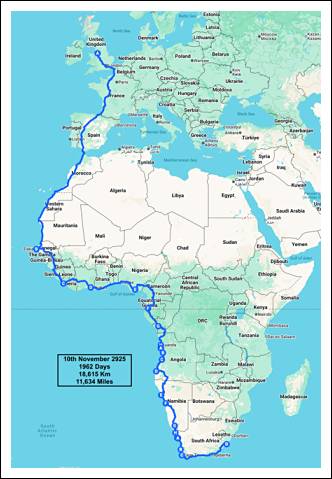 Derek and Jean are recovering well too, Derek has ventured from home with a walk down nearby Sudlow Lane ........" We had a Blackcap on the fence only six feet from the patio door.
Derek and Jean are recovering well too, Derek has ventured from home with a walk down nearby Sudlow Lane ........" We had a Blackcap on the fence only six feet from the patio door.I've been down the lane again, not far, Covid seems to be gone but I am tired out, my get up and go gone. According to Dr Google this is quite common after Covid etc.
In a field down Sudlow Lane there was a line of Starlings on the ground some 80 yards long, 3-4 yards wide and in places dropping down to a couple of yards wide. Hell of a lot I could have counted them if they had flown "........
Covid appears to be less of a threat now than it was in 2020 before the development of the first vaccines. We no doubt all remember the first, and subsequent, lockdowns; very difficult times but KOS members rose to the challenge and the time-limited walks we enjoyed during March and April of that year reminded us what satisfaction could be had birding close to home. http://www.10x50.com/covid_index.htm.
It was during the first lockdown that Geoff and Sheila Blamire began their daily walks close to home. They've continued ever since and Geoff's map, shown here, illustrates just how many miles they've travelled!!
Their latest sightings, since the last update, are summarised here ......"Sunday 9th Nov to Holford and Plumley: 5 Curlews, Sparrowhawk perched on low fence completely in the open, 20 Fieldfares, 1 Grey Wagtail, 60+ Starlings, 3 Pied Wagtails and Barn Owl.
Monday 10th Nov around Mere and Millington. Moss Lane: 21 Redwings and 2 Fieldfares (80+ winter thrushes were there last Friday), 3 Kestrels in different places and a single Meadow Pipit. Little Mere: pair Mute Swans, 3 Gadwalls, 3 Shovelers, 3 Moorhens, 2 Cormorants, plus many Coots, Tufties and Mallards.
Back garden: 1m 2f Great Spotted Woodpeckers in the garden at the same time. Usual Sparrowhawk. "........
On Wednesday (12/11) I ventured into Tatton Park ........" 12°C and a steady drizzle at 10:00am with the promise of more to come, so I drove
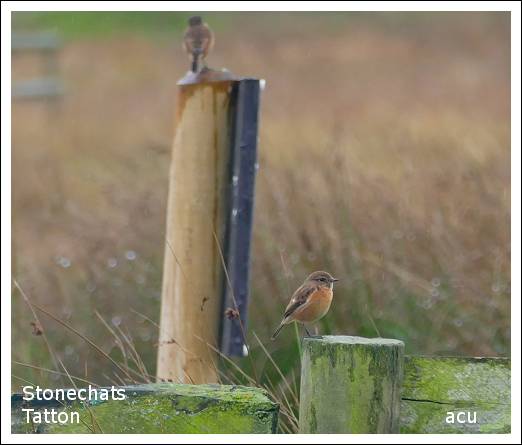 over to Tatton and spent an hour in the Allen Hide. I counted 26 Tufted Duck and one Pochard on Tatton Mere when I paused halfway down the Knutsford Drive, but there were no doubt more further up towards the Knutsford Moor end.
over to Tatton and spent an hour in the Allen Hide. I counted 26 Tufted Duck and one Pochard on Tatton Mere when I paused halfway down the Knutsford Drive, but there were no doubt more further up towards the Knutsford Moor end.The late-nesting Great Crested Grebes with their single chick were feeding close to the road, the youngster still has its black and white striped plumage but appears to be doing very well. The usual suspects on the well-stocked feeders - Blue, Coal and Great Tits and a male Great Spotted Woodpecker. On Melchett Mere, six more Pochard, seven Gadwall, two Little Grebes, Coots and Mallards.
From the north end of Tatton Mere more Tufted Ducks, Pochard, a Grey Heron and a single Moorhen. I finished with a pair of Stonechats feeding in the reeds and, from time to time, aerobatic fly catching from their perches on the wooden fence posts by the side of the mere.".........
Stonechats here in Mobberley too. From Wendy Stratford ....." Just back from walking to Gleavehouse Lane, and the stonechats were outside the livery stables! He was on the wires jumping up every few seconds, she was at the top of the small tree in the hedge opposite. ??wonder if it’s the same pair?
As I was watching them several large groups of starlings (c80-100 in each) flew west, and as I was walking back down to Pavement lane a murmuration of roughly 2000 were over the fields ahead! Really lovely. They started to break up and go down to roost - will go back on the next dry afternoon and try and see where they go. This was a minute after 4pm.
"......
A Great White Egret is back on Tatton Mere. It was seen yesterday by park ranger Darren Morris......." Male goldeneye on Tatton Mere earlier and a great white egret, not the one with the red ring.".......
I was in the park later in the day and managed a record shot of the egret which confirmed that it wasn't ringed ........." I went in this afternoon with a view to see if any of the Black-headed Gulls were ringed. If you remember, in 2021
 a Polish ringed bird was present on the north end jetty.
a Polish ringed bird was present on the north end jetty.None of the gulls were ringed, neither was the great White Egret that didn't allow a close approach, so record shots only this time.
At about 2:30pm noisy flocks of Greylag Geese flew in and settled on Melchett Mere. I took some distant shots and later analysis shoed there we 115 Greylags and a handful of Canadas.
The Stonechat pair were right next to the road where it crosses the Melchett outlet.
"..........
Don't forget that it's our trip over to the RSPB's Burton Mere Wetlands on Sunday (16/11). This is always a good outing, it's a great reserve no matter what the weather.
This week 27 years ago.
14/11/98 The first Bramblings of the Winter arrived back with us this week, the Tatton log has details of two birds on Wednesday and a single last weekend, all were identified by their distinctive calls, well worth learning if possible so avoiding the frustration of yet another unidentified flyover! None were seen or heard this morning amongst a substantial flock of c. 100 finches feeding in the alder trees on Knutsford Moor, most of these were Goldfinches with a few Siskins and, surprisingly, what seemed a high percentage of Redpolls.
8th November 2025 ............Some Winter arrivals are not appreciated!
Olwen and I were caught up in the season's first wave of winter maladies and caught a 'flu bug that flattened both of us for a week or so. Over in Knutsford Derek and Jean both caught covid; all parties are on their way to full recoveries!
The enforced confinement gave me the chance to install Windows 11 on this computer. It gurgled and rattled along for about three hours before completion, thankfully everything that worked before is still doing so.
Birding has been confined to watching the coming and goings on the garden feeder; Goldfinches are the most numerous visitors joined by an encouraging number of Greenfinches. This morning a male great Spotted Woodpecker dropped in but vanished before I could get my camera.
Needless to say Geoff and Sheila Blamire have continued with their daily walks through the Cheshire countryside ............" Saturday 1st November: on Rostherne Mere we had 2m 8f Mandarins (unusually to have so many females!), 1f Goldeneye, 31 Pochards (good number), 2m 1f Gadwalls, 3 Mute Swans, 2 Mistle Thrushes (on top of the split lime) and 2+ Jays (making a real racket!). No R-n Parakeets!
Sunday 2nd November: Cape of Good Hope Farm – 2 Yellowhammers, 6+ Linnets, 18 Black-headed Gulls, 1 Lesser Black-backed Gull, 30+ Starlings, several Pied Wagtails; overgrown area between Inovyn offices and Cape of Good Hope Farm – 1+ Yellowhammers,
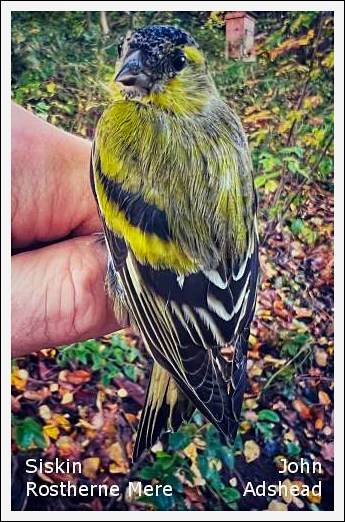 4+ Reed Buntings, 6+ Blackbirds (feeding on berries), c80 Starlings; Holford track – 18 Curlews, Barn Owl in the Barn Owl box and John Jones had 6 Yellowhammers at Hame Farm earlier but we couldn't see them on the way back. Walking back to the car we came across a Ruby Tiger moth caterpillar. Apparently Ruby Tiger moths normally hibernate over the winter as full-grown caterpillars and only spin cocoons (to pupate in) in spring.
4+ Reed Buntings, 6+ Blackbirds (feeding on berries), c80 Starlings; Holford track – 18 Curlews, Barn Owl in the Barn Owl box and John Jones had 6 Yellowhammers at Hame Farm earlier but we couldn't see them on the way back. Walking back to the car we came across a Ruby Tiger moth caterpillar. Apparently Ruby Tiger moths normally hibernate over the winter as full-grown caterpillars and only spin cocoons (to pupate in) in spring.We've also done the Winter Bird Survey on our BBS tetrad – 1st of 4 visits! It took more time recording the habitats than birds!!! 1 Blue Tit, 1 Robin, plus loads of Woodpigeons, gulls and corvids, then at the last minute we had 16 Redwings feeding on holly berries. "..................
Bob Groom visited Rostherne on Monday (3/11) ........." I had a reasonable session. Didn't see the 3 whoopers that were logged yesterday but great Raven flyround and confrontation with 1 of 4 Buzzards that were having their own barney. Usuals but thankfully no rnps..".........
Ringer, John Adshead had another successful session on the reserve on Thursday morning (6/11) ..........." Over seventy birds caught this morning in Dolls Meadow. The Starlings gave a fly pass in their thousands at 0703 hours and two Water Rails flushed from the path. Redpolls roosted again in the Willows and over twenty caught. Three more Redwings ringed and four Blackbirds. Good mixture of woodland birds too. First Siskin of the year caught and the 100th individual Cetti Warbler to be caught at Rostherne ringed too! A busy morning!! ".............
Geoff and Sheila were there, later in the morning ........."Brilliant visit this morning – most of birds within half an hour!
Rostherne: Great White Egret perched in a tree right of the obs, female Goosander, female Goldeneye, 38 Pochards, Grey Heron, Cetti’s Warbler heard, Little Grebe, 2 Mute Swans, Jay, Goldcrest, Long-tailed Tits, etc and finally, but not least, 6+ R-n Parakeets including 3 feeding on apples in front of the obs.
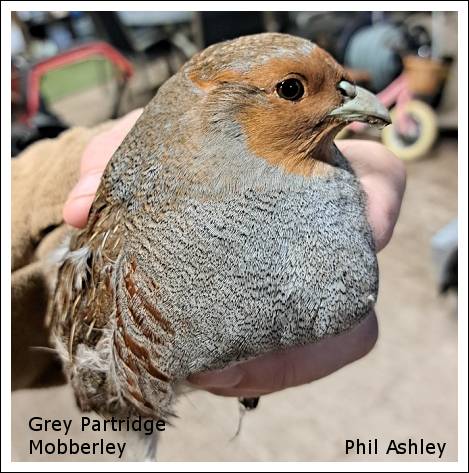 Little Mere: pair Egyptian Geese, pair Mute Swans, 4m 2f Gadwalls (lot of fighting between the males), pair Shovelers, Great Crested Grebe (not seen very frequently), Cormorant, Tufties, etc. No sign of the Grey Wagtail – probably too much water in the outfall where we usually see it."............
Little Mere: pair Egyptian Geese, pair Mute Swans, 4m 2f Gadwalls (lot of fighting between the males), pair Shovelers, Great Crested Grebe (not seen very frequently), Cormorant, Tufties, etc. No sign of the Grey Wagtail – probably too much water in the outfall where we usually see it."............Back here in Mobberley Phil Ashley has cat problems. Unfortunately they belong to the people who pay his wages!!
........."Hi Tony, we have 2 farm cats which I hate to be honest, and this is why - this morning still while it was still dark one of the cats had a Grey Partridge; no doubt the ones we have been watching, anyway managed to save it and release in open stubble field. Cats are a pain! "............
Derek's still confined to barracks and, like me, doing his birding from home. ........" Sat looking through patio door around 9 00am (7/11) and we had an invasion of LTT (15+), one came within 6 foot of door, a great sight. We also had at same time Blue,Great,Coal tits plus the resident Dunnocks House Sparrows and now a frequent visitor a Nuthatch.
We are lucky. "............
Some important dates and reminders from Karina -
KOS November events
We’re heading to Burton for a fine festive Birdwatch: Sunday 16th November.
RSPB Dee Estuary Nature Reserve, Burton Mere Wetlands, Puddington Lane, Burton, Cheshire, CH64 5SF
Meet 9:30am (Reserve opens at 9:00) Leader: Bob Groom. bobbluesgroom@hotmail.co.uk
Kindly let Bob know if you are coming along.
RSPB membership cards at the ready! They are expecting us.
28th November 2025 8pm Jubilee Hall, Knutsford. ‘Curlews in the Landscape’ by Andrew Brockbank
Delayed from last year due to ill health, Andrew Brockbank will review the factors affecting population decline, the conservation measures and the main actions required if we are to see the recovery of this much-loved wader.
This will be our final speaker meeting of the year as we celebrate our Christmas Party on FRIDAY 12th December in the Jubilee Hall ,7:45 pm. Friends and members are all welcome. £8pp.
We share food, fun and friendship together. This is our major fundraiser of the year and thanks to the generosity of our members, Sheila has been able to book a full programme of very enjoyable speakers. All raffle prizes /bring and buy gifts gratefully received.
Don't forget to bring your own cutlery, crockery and beverage!
Numbers please by 28th November and if you feel willing and able to contribute food, or have any additional food requirements, please let me know asap. Thank you! karina.stanley@ntlworld.com
Finally, from this week 26 years ago.
10/11/99 In their book "The Birds of Cheshire" published in 1900 Coward and Oldham described the Water Rail as "....a not uncommon resident.......but owing to it's shy and retiring habits it has been overlooked in many parts" this is probably still true today, the species is recorded more often in the Winter months, especially during cold spells when the Cheshire Meres freeze over and they are forced from the cover of the reed beds in search of food. They are easily picked out in the Spring having a distinctive "song" but as this is heard mostly at dusk or after dark breeding birds are thus often overlooked. Two birds were present today on Knutsford Moor, one of only 2 tetrads where breeding was confirmed during the County Breeding Bird Survey that took place during the years from 1978 to 1984, also on the Moor a dozen or so Siskins, difficult to see in the Alder trees that are still covered in leaves as the current warm spell continues.
29th October 2025 .............. Whoopers at Tatton.
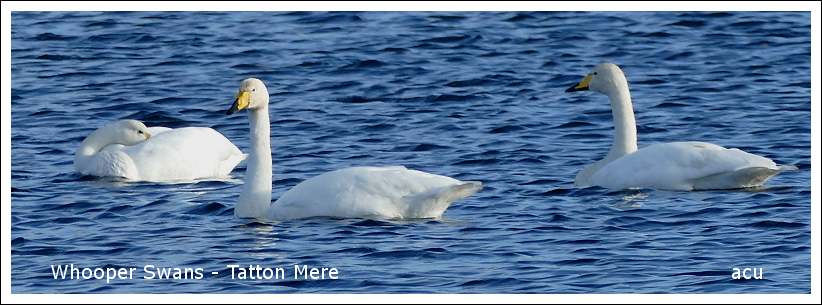 |
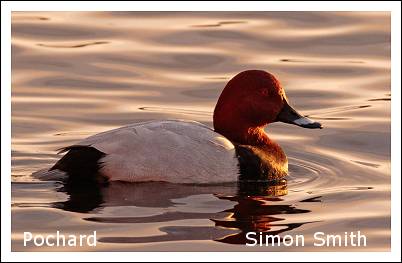 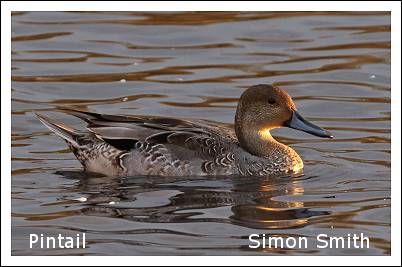 |
Hot on the heels of Tatton Mere's four long-staying Common Scoters the park was again the centre of attention last Saturday afternoon (25/10) with the arrival of three adult Whooper Swans.
They were found by John Barber who was taking his two dogs out for some exercise; unfortunately he'd not taken his camera out with him (I'm sure there's a lesson there somewhere!)
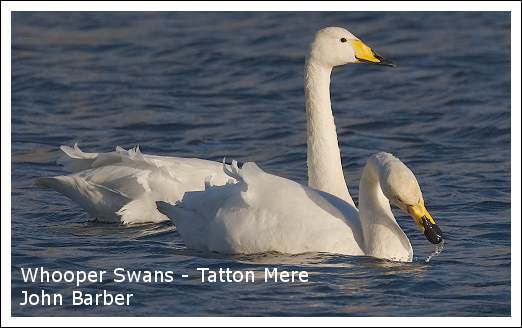 but he sent me a text as he hurried home for the appropriate equipment and I was able to drive over to Knutsford and get some good shots of the three birds prior to John's return.
but he sent me a text as he hurried home for the appropriate equipment and I was able to drive over to Knutsford and get some good shots of the three birds prior to John's return.The Swans were still there at dusk but must have left at first light, as Bob Groom failed to connect with them when the park re-opened at 10:00am the following morning.
On the subject of wildfowl, Simon Smith and Lyn Graves visited Martin Mere last week and it seems the light was just right for Simon's camera .................." We visited Martin Mere during the week to see the Pink-footed Geese returning to roost at sunset. The main hide was kept open between 5:30 & 7pm and the action started just as the sun sank below the horizon at 6. First the ducks & swans on the apron in front of the hide zoomed off into deeper water and then came the sound of hundreds of Pink-footed Geese passing overhead. It was quite the spectacle as the geese circled round and landed on the water, accompanied by a cacophony of calls. We’d picked a night with good sunset colour, which showed the usual suspects in great light while we waited. (pictures attached)".................
Thanks Simon another great set of images!
Geoff and Sheila Blamire were out and about again over the weekend on their daily yomps through the Cheshire countryside ..........." Saturday morning (25/10) walk around Holford and Plumley. The forecast was sunny and no rain – turned out with rain and very cold with no sun! Anyway the walk was worthwhile. As we parked near Inovyn offices c70 Pinkfeet flew over. Next stop was Cape of Good Hope farm with 17 Wigeon on the big pool – obviously just in because they were very nervous and flew off before we got anyway close. 20+ Black-headed Gulls on the flooded field. Amongst sheep were 10+ Meadow Pipits, 8+ Goldfinches and 1 Pied Wagtail. In the area 80+ Rooks, 20+ Jackdaws and a few Carrion Crows. Langford Farm 15+ Collared Doves and c50 Starlings. No sign of any Curlews.
Sunday morning (26/10)was Rostherne area. The forecast was rain all morning – but most of the time it was clear and not very cold. Female Goldeneye, male Mandarin, mixture of Pochards, Shovelers, Tufties, male GS Woodpecker (on the split lime) and Buzzard. Simon had a Little Grebe before we arrived, and also saw GC Grebe feeding a juvenile with a big fish! ".............
I've yet to see of hear any Fieldfares yet this season but the Blamires found a field full of them! ............"Yesterday morning (27/10) we started our 12km walk around Mere and Millington with a rainbow (third rainbow in 4 days including a double) and finished with a skein of 31 Pinkfeet flying overhead. In the middle of the walk we had a field "full" of Fieldfares, Mistle Thrushes and Starlings!"..............
 Here in Mobberley Wendy Stratford has plenty of winter thrushes too..........." While watching pheasants in the field yesterday late afternoon (1 male and 4 females! He's pushing it...) noticed that there were 8 fieldfares eating in the same patch as the pheasants. The field has been severely cut back to the tree line on all boundaries this summer, and the dense undergrowth was removed using a serious machine that was driven into the tree line and reversed out - leaving just a small amount of debris! These areas seem good feeding grounds - for pheasants and now it seems fieldfares. Then approximately 8 redwings arrived in the same area. Would like to know what they were eating! "...........
Here in Mobberley Wendy Stratford has plenty of winter thrushes too..........." While watching pheasants in the field yesterday late afternoon (1 male and 4 females! He's pushing it...) noticed that there were 8 fieldfares eating in the same patch as the pheasants. The field has been severely cut back to the tree line on all boundaries this summer, and the dense undergrowth was removed using a serious machine that was driven into the tree line and reversed out - leaving just a small amount of debris! These areas seem good feeding grounds - for pheasants and now it seems fieldfares. Then approximately 8 redwings arrived in the same area. Would like to know what they were eating! "...........Wendy also has a little male Sparrowhawk frequenting the garden .........."Now appearing more days than not…. Not seen it catch anything yet "..........
Wendy took advantage of the pleasant weather this morning (29/10) with a walk over to Gleavehouse Pool .........."" Stonechat (male and possible female) on pile of metal stuff outside sometime cattle barn on Gleavehouse lane. This a first for me in Mobberley!
Crossing the original skylark field a flock of about 30 meadow pipits flew up, and a kestrel concealed in the hedge tried to grab one (failed). At the pool only a gang of young cows, but it was good to see the water level getting closer to normal levels. c50 linnets in the ash tree by the gate down to the pool.
No sign of stonechat on return walk, but there were about 50 starlings on the wires on Pavement lane. ............
The Linnets are enjoying the three acres of mixed wild flowers that have grown from seed spread by the farmer, David Simcock, as part of a government scheme; he's obliged to leave the area untouched for two years. There's more than enough seed from the plants to last the current flock right though the winter. Perhaps they'll be joined by more as the seasons progress.
 |
24th October 2025 .......... Common Scoters on Tatton Mere.
 |
Sheila Blamire has kindly sent me short accounts of the highlights from her and Geoff's activities on the three days following the last of these updates.
 Tuesday (14/10): Grey Heron and Mute Swan on Little Mere and 2 Egyptian Geese in field off Mereside Road. Rostherne: 4 Ring-necked Parakeets feeding in an apple tree in the village, 8+ Mistle Thrushes on cricket field, Cetti’s Warbler heard from the Obs plus the usual species. Heard Pinkfeet as we left the Obs.
Tuesday (14/10): Grey Heron and Mute Swan on Little Mere and 2 Egyptian Geese in field off Mereside Road. Rostherne: 4 Ring-necked Parakeets feeding in an apple tree in the village, 8+ Mistle Thrushes on cricket field, Cetti’s Warbler heard from the Obs plus the usual species. Heard Pinkfeet as we left the Obs.Wednesday (15/10): 50+ Lapwings Chapel Lane, Mere.
Thursday (16/10): Kingfisher on Little Mere (on the way to Rostherne and the way back!). 10 Ring-necked Parakeets feeding in apple tree in the village (could only count them when they flew off! – see photo) and 21+ Redwings (particularly like yew berries), Cetti’s Warbler heard from the Obs and Pochard, Wigeon, etc (no Cormorants!!!) and 3 Ring-necked Parakeets spent lot of time on top of the split limes and 6 Ring-necked Parakeets flying off when we left the Obs.
A quick change of plan for me, last Friday (17/4) "I had intended to have a stroll down to Gleavehouse Pool this morning but changed direction to Tatton following a text from Darren with news of four Common Scoters on the mere.
I was just getting into the car at home when my eye caught a flock of birds flying overhead: Redwings and my first of the season, there were at least 50!
Arriving in the park I had a quick look from the Knutsford Drive to confirm they were still there: they were, so I parked up in the official car park and walked back. They came reasonably close and I was able to obtain a record shot of three adult males plus a female/immature. I don't know the difference between females and this year's models!
Also there c.60 Tufted Duck, c.30 Pochard, five Egyptian Geese. Skylarks over, high and numerous Meadow Pipits."
John Barber found the Scoters the following morning and managed a good shot of the birds, It's reproduced at the start of this update........."The Scoter were a long way out so images heavily cropped. On the positive side, nice to get all four close together.
I found it interesting to watch them feeding, diving and resurfacing in unison.
Great result for United."..............
Thanks John great pictures and, as you say, a great result for the reds at Anfield!
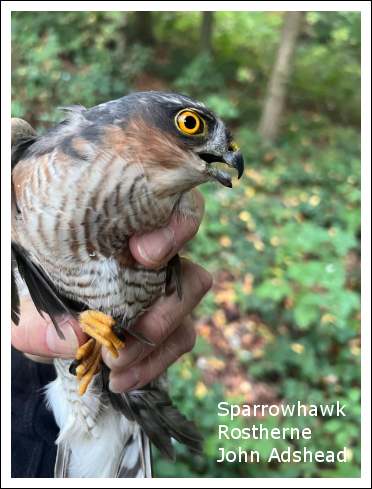
Our Monday morning at Rostherne Mere this week (20/10) got off to a good start ....." Just Jude and I this morning; things began well with a flock of 229 Pinkfeet as we left the NE car park. They actually came over in three groups, but obviously flying together as they were only a few seconds apart and were all visible at the same time as they headed east towards the Cheshire gap.
Five Mistle Thrushes and one Song Thrush on the split lime, followed by a single Redwing. They were replaced by a male Sparrowhawk that we took to be a juvenile bird. I managed a record shot.
Perhaps it was this one caught and ringed last week (15/10) by John Adshead. His picture is a bit better than mine......"Sighting today from Dolls Meadow - 2 Snipe, Curlew, Water Rail, Cetti's, 20 Lesser Redpoll, Great Spotted Woodpecker.
Ringing - first 2 Redwings of the winter caught one chased into the net by a Sparrowhawk which was also caught."........
We counted 12 Pochard (all adult males) and five Mandarins. A nice little group of RNP in the churchyard. I went home via Tatton, had a quick scan of the mere but didn't see the Scoters, but Darren tells me they are still there."..........
Geoff and Sheila had been there the previous day (19/10) ..........." We were impressed what the working party have done with the Rostherne Brook area – over 2 days. They've coppiced the trees, tidied the bushes and, most importantly, put in new leaky dams. They've used stakes made from willow, Rupert says they should root and make the dams even more efficient. We used to see Grey Wagtails frequently in the area but since it had overgrown haven’t seen them for a few months. Bill Bellamy saw the Grey Wagtails while they working there! ".............
Last Saturday(18/10) found the Blamires on one of their favourite walks ........" First bird we saw by Inovyn offices was a single Curlew – well better than none!
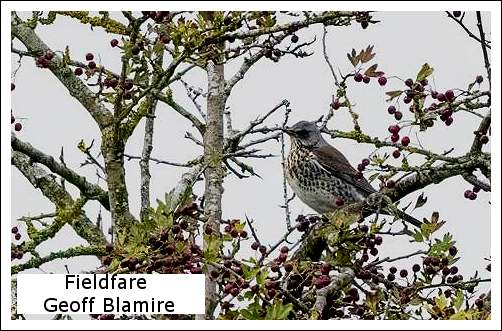 By Cape of Good Hope Farm a Buzzard was mobbed by couple of Carrion Crows. Then a flock of 31 Pink-footed Geese flew low overhead and out of sight, then another 23 Pinkfeet came from the same area - again flying low - possibly moving between fields. Then 3 skeins of Pinkfeet flew high overheard - c190 + 90 + 85 = 365. All over within 10 minutes - marvelous sight and sound. The rest of the area produced: 100+ Rooks and c25 Jackdaws, 2 flocks of Starlings (100+ and 80+), flock of 55+ linnets, 4 Pied Wagtails and 14 Collared Doves both on Langford Farm, plus other usual species."..........
By Cape of Good Hope Farm a Buzzard was mobbed by couple of Carrion Crows. Then a flock of 31 Pink-footed Geese flew low overhead and out of sight, then another 23 Pinkfeet came from the same area - again flying low - possibly moving between fields. Then 3 skeins of Pinkfeet flew high overheard - c190 + 90 + 85 = 365. All over within 10 minutes - marvelous sight and sound. The rest of the area produced: 100+ Rooks and c25 Jackdaws, 2 flocks of Starlings (100+ and 80+), flock of 55+ linnets, 4 Pied Wagtails and 14 Collared Doves both on Langford Farm, plus other usual species."..........On Wednesday (22/10) they had their first Fieldfares of the season .........."Wednesday – walk around Mere and Millington: Moss Lane is a very short lane (about 400-500m?) but there we saw: 31 Black-headed Gulls in the field, 4 Pied Wagtails on the road, Buzzard on one of the posts, 1+ Long-tailed Tit and finally 8+ Fieldfares feeding on hawthorn berries (the first of the winter for us!).
In the afternoon I was looking out of our bedroom and noticed a Goldcrest in a conifer just a few feet away – watched it for a few minutes while it was looking for insects. Such a lovely bird. "...........
Yesterday (23/10) I went into Tatton to find that the Scoters had moved on, but I didn't waste the morning .............." Only 8°C this morning in the park, but the sun still has some warmth in it and it remained dry.
 23-10-25 acu.jpg) The Common Scoters have moved on so I tried a full wildfowl count on Tatton and Melchett meres.
The Common Scoters have moved on so I tried a full wildfowl count on Tatton and Melchett meres.A total of 32 Pochard (4 on Melchett) 72 Tufted Duck, all on the main mere, 6 Great Crested Grebe, including the young bird with one of its parents on Melchett, 2 Little Grebes (one on each mere), 17 Mallard, 2 Greylag geese on Melchett, just 1 Canada Goose on the main mere where I counted 5 Goldeneye, 2 Pinkfeet flew the length of Tatton Mere, quite low but they didn't land. 12 Wigeon on Melchett and a solitary Moorhen on Tatton Mere.
The pair of Stonechats were in hawthorn bushes, half way along Tatton mere. I've had better pictures in past but I think the sun was just too bright this morning. "...............
Finally don't forget that tonight (Friday 24th October) it's our October indoor get together when the speaker will be Nick Martin, Karina has sent out an email to all KOS members
October speaker meeting:
Friday October 24th ‘ A Celebration of British Birds’ Speaker: Nick Martin https://allthingswildlife.co.uk/index.php/about-us/#nick
Jubilee Hall, 24 Stanley Rd, Knutsford, 8pm
We love birds and in this talk we will find out more about our relationship with them and how many species have adapted to live alongside us and our activities. We'll look at the rare birds, the common species and the new kids on the block. We'll enjoy the best of the dawn chorus, seabirds, birds of prey and many more.
15th October 2025 ....... The trip to North Wales.
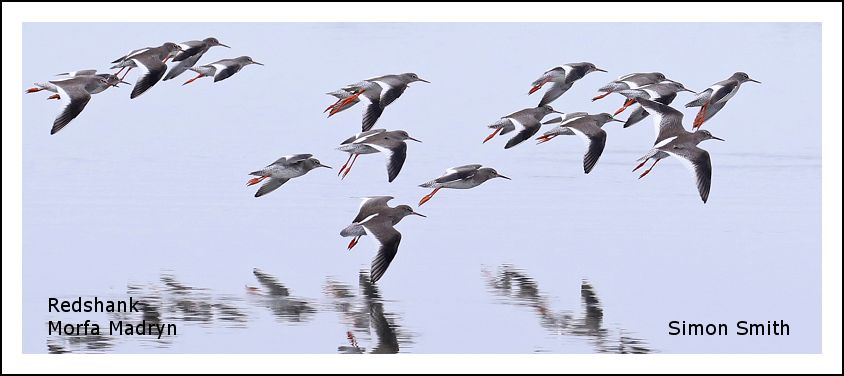 |
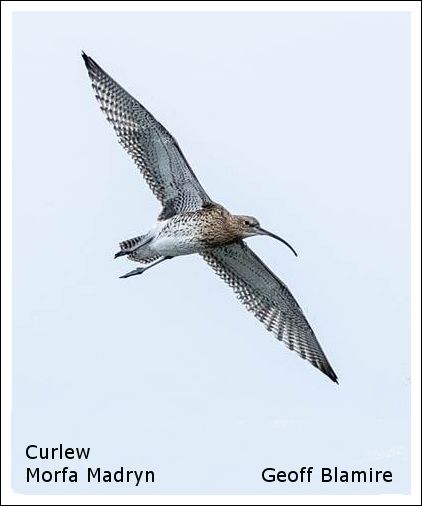 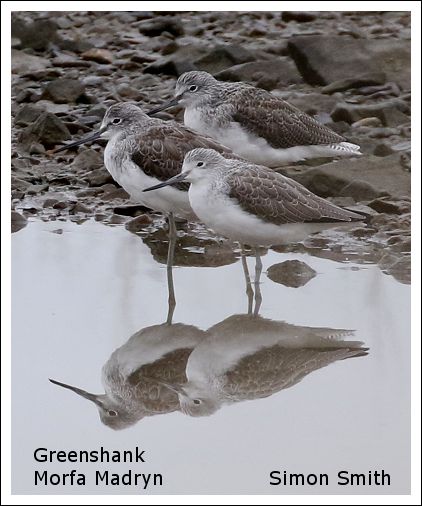 |
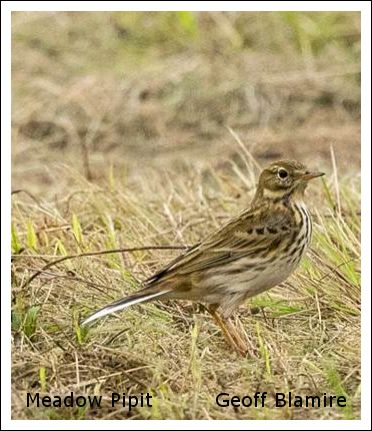 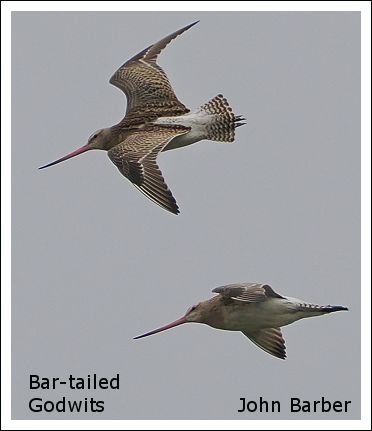 |
Geoff and Sheila Blamire were out and about on their daily walks during the week preceding our October field trip to North Wales. Sheila has kindly sent me brief details of their outings.
..............."Monday (6/10): pair of Egyptian Geese on Little Mere and Grey Wagtail on the outlet. Not much around Millington except 1 Buzzard!
Tuesday (7/10): Our walk this morning took in Swains Walk (bridleway) – haven’t been there for some time. They had taken up the potatoes and ploughed the field with c300 gulls attended – mostly Lesser Black-backed with c 50 Black-headed Gulls.
Wednesday (8/10): 9+ Pochards on Rostherne Mere, 2 Mute Swans (adult and cygnet), Cetti’s Warbler (heard), 2 Jays, 1 R-n Parakeet and the usual other wildfowl species and small birds. Single Gadwall on Little Mere (haven’t seen them there for ages) and Grey Wagtail on the outlet.
Thursday (9/10): Only of note was a flock of 13 Long-tailed Tits on Moss lane, Mere.
Friday (10/10): 2 Redwings in Rostherne village, and c100 Pinkfeet flew west over Rostherne Mere, plus Cetti’s Warbler (heard), 2 Jays, 1 R-n Parakeet, GS Woodpecker and the usual other species. Pair Gadwall on Little Mere and Grey Wagtail on the outlet. "..............
Derek Pike saw what were probably the same Pinkfeet on Friday morning ......."8:45am today Friday the 10th 100+ Pinkfeet flying from South to North could be going to High Legh"..........
The British Isles have been under the influence of a large area of high pressure since Friday last week. As a consequence of these benign conditions the weather
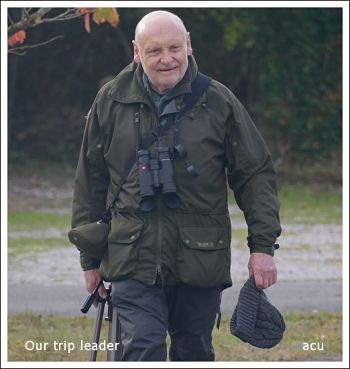 for our trip to North Wales on Saturday (11/10) was quite acceptable; overcast but nice and dry. The walk from Llanfairfechan to the Morfa Madryn reserve would be a bit of a challenge in the wind and rain!
for our trip to North Wales on Saturday (11/10) was quite acceptable; overcast but nice and dry. The walk from Llanfairfechan to the Morfa Madryn reserve would be a bit of a challenge in the wind and rain!A group of 17 members arrived in the car park at Llanfairfechan at 10am, following the drive down the M56 and A55. Our leader for the day was KOS Treasurer Frank Dearden: Frank takes the job very seriously, he'd done a full recce the previous week and gave us a comprehensive briefing before we set off towards the Morfa Madryn reserve. It was considered such a good briefing that it engendered a round of applause. I can't remember that happening before in the 50+ years we've been running trips!!
Unlike our last visit that coincided with one of the highest tides of the year, this time the tide was well and truly out. High water wasn't due until around 2pm. Nevertheless careful 'scoping revealed Gannets, Common Scoters, Great Crested Grebes, Eider, Red-breasted Merganser and both Red-throated and Great Northern Divers out on the sea.
The allotments and carefully tended gardens we walked past gave us a few list-fillers in the form of House Sparrow, Robin, Chaffinch, Blue Tit, Great Tit and Blackbird, whilst a little further on Coal Tit and Goldcrest were recorded in the small conifer plantation before the view opened up towards the Glan y Mŏr Elias reserve, with it's long shingle bank, on which Oystercatchers, Ringed Plover and Bar-tailed Godwits were beginning to gather ready to sit out the rising tide.
Continuing on along the path through open country towards Morfa Madryn, Skylarks were ever present overhead, along with Teal, Wigeon, Redshanks and squeaking Meadow Pipits.
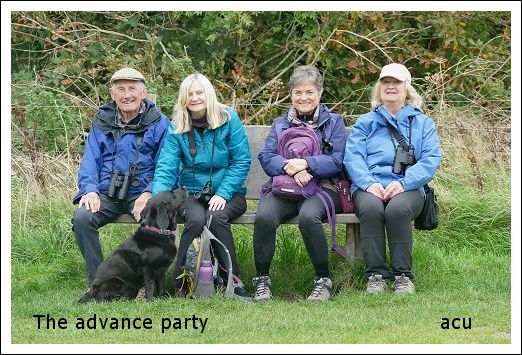 Stonechats gave good views as they perched on the scattered gorse bushes and some members of the party had two late Wheatears feeding on the sea wrack.
Stonechats gave good views as they perched on the scattered gorse bushes and some members of the party had two late Wheatears feeding on the sea wrack.Reaching Morfa Madryn some of us first walked past the hides and down to the viewing screen overlooking the main pool. On the way we had Long-tailed Tit for the list and a squealing Water rail somewhere in the trackside phragmites. From the screen we had a Goosander and two Little Grebes. The bottom hide gave better views of the pool, it was here most of the photos I've used at the top of this update were taken. I was spoilt for choice this time, the boys had really excelled themselves and sent me a terrific set of images!! Morfa Madryn seems to be very attractive for Greenshanks, we never fail to see them here and Simon has captured three of the seven present perfectly.
Re-tracing our steps we arrived back at the long shingle beach of the Glan y Mŏr Elias reserve where we met the leader of a ringing group who had set up cannon nets on the shingle spit and were waiting patiently for the right moment to fire the cannons that would propel the nets over the roosting birds, trapping them underneath allowing them to be carefully removed and ringed.
Shortly after we'd moved on, back towards Llanfairfechan, the cannons were fired - a tremendous BOOM!, the 100s of waders that weren't caught left the scene in huge flocks, heading out to sea. Geoff's picture,
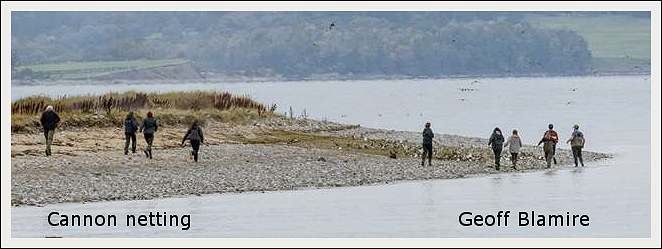 taken a few moments after the firing, shows the ringers and helpers sprinting down the spit to start removing the birds they'd caught. (ChatGPT tells me that fatalities do occur .........."Mortality rates are generally very low — typically less than 1% of captured birds, according to published data from organizations such as the British Trust for Ornithology (BTO) and the Australasian Wader Studies Group (AWSG)."..............)
taken a few moments after the firing, shows the ringers and helpers sprinting down the spit to start removing the birds they'd caught. (ChatGPT tells me that fatalities do occur .........."Mortality rates are generally very low — typically less than 1% of captured birds, according to published data from organizations such as the British Trust for Ornithology (BTO) and the Australasian Wader Studies Group (AWSG)."..............)Packed lunches were enjoyed in the Llanfairfechan car park before we drove the short distance back down the coast road to the RSPB's Conwy Reserve.
As expected we added quite a few new species for the day list at Conwy with Chiffchaff, Coot, Moorhen, and Shoveler ticked off. One or two more energetic members of the party did a complete circuit of the reserve and added Spotted Redshank and Pintail whilst others took a stroll back to the cafe for a well-earned cup of RSPB coffee!
We ended the day with a list of 74 different species recorded in just six hours of birding (nine more than the same trip last year) - good going by any standard. A most enjoyable outing - well done team!
Our garden lawns have now recovered from the long, hot summer weather so I've taken advantage of the continuing dry spell to give them what will, hopefully, be their final cut of the year. The feeder is, at times, covered by Goldfinches; now joined by raucous flocks of Starlings. We still await our first Redpolls, they are about, John Adshead ringed six at Rostherne on Monday (13/10) - it could be an expensive winter!
On Sunday, Wendy Stratford walked from home down towards Mobberley's Gleavehouse Pool ........"I walked round Pavement Lane and Gleavehouse Lane yesterday afternoon. Large flocks of meadow pipits and goldfinches (50+)
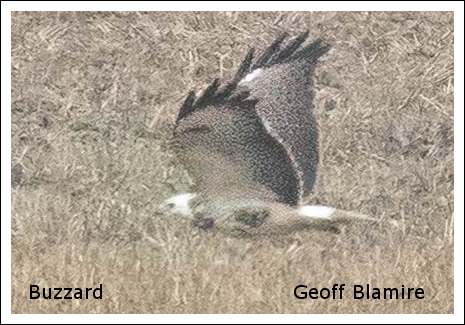 near the livery stables. I saw a bird of prey fly into the open barn opposite the livery stables gate - but on the edge of my vision, so waited a few minutes and a kestrel flew out from under the roof, worth watching out for! In Smith Lane there were 2 or 3 house martins looking like they were feeding over the first field, which was cut on Saturday.".......... Thanks Wendy, it's getting late now for House Martins; we have had them as late as the first week in November in Mobberley but that was many years ago.
near the livery stables. I saw a bird of prey fly into the open barn opposite the livery stables gate - but on the edge of my vision, so waited a few minutes and a kestrel flew out from under the roof, worth watching out for! In Smith Lane there were 2 or 3 house martins looking like they were feeding over the first field, which was cut on Saturday.".......... Thanks Wendy, it's getting late now for House Martins; we have had them as late as the first week in November in Mobberley but that was many years ago.Geoff and Sheila came across a bit of a puzzle on Monday morning (13/10) this week ............" We did one of our usual walks around Mere and Millington this morning. Started off with a distant bird of prey on the ground in a field – white and brownish. Was it an Osprey? Or Bonelli’s or Booted Eagle?!!! My imagination was in overdrive… Then Crows and Rooks started to mob it and it flew to perch on a hedge (even further away!). Have a look at Geoff’s heavily cropped photos to give you an idea.
I'll give you more context. We were standing on the bridge over A556 and looking over the fields. The bird was pinprick – just could make out white and some brown/black. The mobbing crows gave some size comparison. Initially on the ground and when it flew and perched on a hedge gave a real clue to its identity. So was it a Buzzard with abnormal plumage. Geoff’s photos shows a juvenile Buzzard – 100% certainty, even shows the 'black commas' on the under wings.".............
Species recorded on the KOS trip to North Wales. 11th October 2025. |
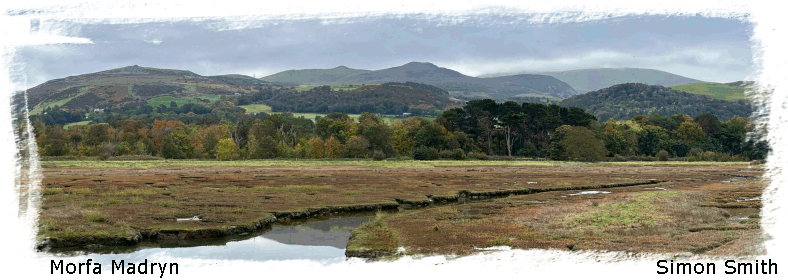 |
8th October 2025 ........ The first Fieldfares and the last Swallows.
 |
Two updates from Geoff and Sheila to begin with - received just as I was uploading the last update!
.........."Rostherne this morning (29/9): 4 Wigeon, female Goldeneye, 1 R-n Parakeet, 10+ Long-t Tits and loads of Goldfinches.
Holford/Plumley Sunday morning (28/9): not much to report bird wise (no Curlews) but driving to Inovyn we passed several groups of youngsters carrying rucksacks, tents, etc – thought it must be for the Duke of Edinburgh Award. But when we arrived there was a small gazebo with 8+ adults in high viz jackets, coffee making facilities, and portoloo. Apparently it was the Cheshire Hike weekend which is an annual event run by Cheshire Scouts. This year c800 scouts and guides, split into 3 age groups (youngest 10½ and oldest 17) and they walk between 30-60 km over Sat and Sun and camping Sat night. The older ones carry everything including their food. Was great to talk to the organisers and volunteers.
Cheshire Hike 2025 | A Cheshire Scouts Event for Scouts & Guides "..............
The first of our winter thrushes arrived on time with six Fieldfares in Mobberley last Thursday.
............" Two texts yesterday morning (2/10); the first from Wendy Stratford who was watching six Fieldfares in a field across the road from their house on Smith Lane. This fits in nicely with the average arrival date of 4th October in the 2023 Cheshire Bird Report.
I received the second text as I was sat in the obs. overlooking Gleavehouse Pool, it was from Phil Ashley who was watching a flock of c100 Linnets on overhead wires at Gleave House Farm (where he works). I presume they were the same birds that I'd been watching earlier as I made my way to the pool.
Good numbers of Meadow Pipits and Skylarks heard and seen throughout the morning plus a noisy flock of about 30 House Sparrows moving along the hawthorn hedges."...............
......... "Last night's weather forecast predicated a dry morning, with rain in the afternoon; a prelude to the arrival of the first named storm of the autumn - storm Amy
 but this morning heavy rain had already started at 10am so I decided to drive into Tatton and spend some time in the Allen Hide, overlooking Melchett Mere.(3/10)
but this morning heavy rain had already started at 10am so I decided to drive into Tatton and spend some time in the Allen Hide, overlooking Melchett Mere.(3/10)Three Black-bellied Whistling Ducks has sought shelter in front of the hide as I opened the shutters but flew off before I could get the camera out. The two Egyptian Geese were more obliging though as they trundled towards me. Also present three Gadwall as well as the usual Coot, Moorhen, Mallard and a single Canada Goose. A Great Crested Grebe was carrying a small youngster on its back, well sheltered from the rain, it only showed briefly. I remember seeing a bird that appeared to be incubating on an earlier visit in September. Better late than never!"..........
On Sunday morning (5/10), after Amy had passed over I walked down to Gleavehouse Pool....... "The back end of storm Amy provided westerly winds just as strong this morning as we had all day yesterday. The only difference was that today it was dry: not a spot of rain so far.
Not much to report on a walk over to Gleavehouse Pool, the Linnet flock is still there and Skylarks and Meadow Pipits were passing over as I sat in the GHP obs, well-sheltered from the wind behind the hawthorn hedge. Nevertheless I was pleased to see two Swallows as I passed Beech Cottage at the start of the driveway from Town Lane. They arrived from the south-east, battling against the cross-winds, heading north. I remember Stuart Burnet, a ringer who I worked with many years ago, telling me that Swallows do, sometimes, head north in the autumn before heading south to Africa."...........
After lunch I made my way over to High Legh ........" This morning Phil Dell posted, on the Rostherne WhatsApp group, that there were 100s of Pinkfeet on a stubble field in High Legh, visible from Crabtree Lane. They were still there when I went along just after lunch, the flock had thinned out somewhat but I thought there were about 60 birds, well camouflaged in the stubble that remains after the harvesting of the maize crop.".........
My 60 birds had increased somewhat when Phil and Susan arrived later in the day ......" I took Susan to see the Pink-footed this afternoon after a delicious and very substantial Sunday lunch at the newly refurbished Wheatsheaf, Agden. Anyway we somehow managed to spook them and they took off enabling me to count at least 1k. This was about 3:30pm. ".........
It remained dry In Mobberley on Sunday but Geoff and Sheila found conditions a little more challenging in their neck of the woods ........."This morning we planned to do our usual walk around Holford and Plumley. The wind was, at times, ferocious, so I had to hang onto my hat and sometimes onto Geoff as well! On a field near Inovyn Offices there were 25 Curlews (mostly hunkered down) and 10 Starlings. Then in a marshy area by Cape of Good Hope Farm we flushed a Snipe. Walking back towards Langford Farm the heavens opened. The farmer said we could shelter in his barn but we decided to abort the walk – wind and rain was too much (we got so wet yesterday we couldn't face getting soaked 2 days running)."..........
A reminder from Karina about this Saturday's trip ........." KOS October Events
Oct 11 Saturday Llanfairfechan and Morfa Madryn followed by Conwy RSPB.
Leader: Frank Deardon. frank.dearden@icloud.com
It takes about 1:30 hrs to get there. 10:00am meet at the Beach Pavilion car park at Llanfairfechan, LL33 0BY then walk to Morfa Madryn.
We hope to see you if you can make it. Please let Frank know to expect you. The car park has been updated, and it looks like charges are now in place. Take a packed lunch and your RSPB card, if you have one, for Conwy ~ 15mins from Llanfairfechan.
RSPB Conwy Nature Reserve, Llandudno Junction, Conwy, LL31 9XZ "..........
The KOS has had a presence, in one form or another, on the internet since 1995. In the early days u-net from Warrington charged 1p a minute for access, so I restricted myself to an hour a day! The 10X50.com url was registered in 2000 and the website has evolved slowly ever since then.
I thought it might be an idea to look back from time to time to the early days. So here we are, this is what we were up to this week in 2002!
04/10/02 The A.W. Boyd Memorial Observatory at the Rostherne National Nature Reserve was opened in 1962 three years after Boyd's death, it proved to be very popular, so much so that in 1976 an extension was built, doubling the viewing capacity.
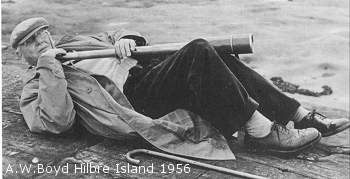 Predictably it was
always at its busiest during the weekend, in the early 1970's before the advent
of "Bird Lines" and pagers, as the gulls were pouring into the Winter
roost many of the "youngsters" would arrive at the Observatory to
swap the latest news - Adam Davison, Paul Ellison, Alan Roberts and of course
Jonathan Guest complete with Hardyesque army greatcoat, astride a Honda 50
moped spring to mind. It was normally standing room only on a Sunday morning,
especially when there was a duck count on and T. Hedley Bell and L.P. Samuels
would make their monthly appearance to walk round the margins of the mere,
flushing the wildfowl as they went so that the minions back in the Observatory
could establish the current population. The then Warden Tom Wall introduced us
one morning to a rather special visitor Charles Tunnicliffe no less, a charming man
who sketched a Cormorant and added a
few comments amongst the graffiti and general insults on the inside of the back
cover of the log-book, what a splendid memento - I wonder if it's still around?
We paid a long overdue visit to the Rostherne Observatory on Tuesday morning,
it's changed little since those early days, black and white photos of
Coward, Boyd and Bill Mulligan look down from the walls, a
constant reminder of our own mortality and still so peaceful, despite its
proximity to the A556 and the M56. Recent counts show a slow build-up in
wildfowl numbers plus the earliest ever record for Bittern, perhaps of British
Predictably it was
always at its busiest during the weekend, in the early 1970's before the advent
of "Bird Lines" and pagers, as the gulls were pouring into the Winter
roost many of the "youngsters" would arrive at the Observatory to
swap the latest news - Adam Davison, Paul Ellison, Alan Roberts and of course
Jonathan Guest complete with Hardyesque army greatcoat, astride a Honda 50
moped spring to mind. It was normally standing room only on a Sunday morning,
especially when there was a duck count on and T. Hedley Bell and L.P. Samuels
would make their monthly appearance to walk round the margins of the mere,
flushing the wildfowl as they went so that the minions back in the Observatory
could establish the current population. The then Warden Tom Wall introduced us
one morning to a rather special visitor Charles Tunnicliffe no less, a charming man
who sketched a Cormorant and added a
few comments amongst the graffiti and general insults on the inside of the back
cover of the log-book, what a splendid memento - I wonder if it's still around?
We paid a long overdue visit to the Rostherne Observatory on Tuesday morning,
it's changed little since those early days, black and white photos of
Coward, Boyd and Bill Mulligan look down from the walls, a
constant reminder of our own mortality and still so peaceful, despite its
proximity to the A556 and the M56. Recent counts show a slow build-up in
wildfowl numbers plus the earliest ever record for Bittern, perhaps of British 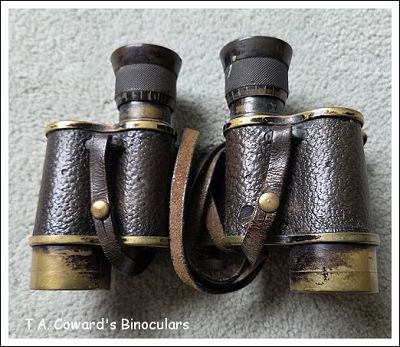 origin rather than from the continent, which is where these birds normally come
from. We had little of note, fine views of a Mistle Thrush across in
the split Lime, Buzzards over Mere Covert and a Sparrowhawk only inches from us
as it scattered the Chaffinches and Nuthatches feeding on the bird table. A
typical morning at Rostherne, yes it's got a big species list to its name, but
it's something that's built up slowly over many years - it's definitely not a
place for twitchers! Perhaps, as the oil runs out and the internet looses its
fascination, people will learn again how to communicate face to face and Rostherne will regain its popularity.
origin rather than from the continent, which is where these birds normally come
from. We had little of note, fine views of a Mistle Thrush across in
the split Lime, Buzzards over Mere Covert and a Sparrowhawk only inches from us
as it scattered the Chaffinches and Nuthatches feeding on the bird table. A
typical morning at Rostherne, yes it's got a big species list to its name, but
it's something that's built up slowly over many years - it's definitely not a
place for twitchers! Perhaps, as the oil runs out and the internet looses its
fascination, people will learn again how to communicate face to face and Rostherne will regain its popularity.Derek Pike remembers the extension being built ........." I am probably the only person alive who helped on the extension, built by J Shaw and Sons, Bexton Lane, Knutsford. Their lorries were to big and heavy to take materials to the site so we collected and I delivered some on our smaller lorry J E Pike and Sons Knutsford, of course I was very young at the time!
The legendry Bill Whiston , Joe Mulany a couple of names I remember working there ".........
In the 2002 extract I mentioned T.A.Coward. I'm pleased to say that the great man's binoculars have been returned from Canada by Maggie Sale who's grandfather, Roy Storey, was given the optics by Coward's wife when he died in 1933. Maggie is visiting her brother, Rob David who has kindly sent the binoculars on to me, I took them to Rostherne last Monday, their first time on the reserve for almost 100 years!
I'm hoping that we can find a permanent home for them: a place where they can be put on display and their significance appreciated.
29th September 2025 ...... The first Pinkfeet!
If the first Sand Martin of the year marks the start of our ornithological Spring, then the sight and sound of Pink-footed Geese heralds the arrival of autumn and the gradual decline into winter.
Geoff and Sheila Blamire had the first last Sunday (21/9) during their daily walk.
........" We did our usual walk around Holford and Plumley this morning. What a difference in the temperature – just over 6c at 8am! But so nice to see blue skies rather than rain – definitely raised the spirits. Notable sightings around Holford included: a Raven flying low over 52 Curlews in a field, then soon after heard Pinkfeet but couldn't see them (total of 82 Pinkfeet recorded over Neumann’s Flash this morning).
In the garden: Greenfinches (1m 1f), Chaffinches (1m 1f), Goldfinches, GS Woodpeckers (2m 1f), 4 Dunnocks, 2 Robins, Sparrowhawk, Chiffchaff and numerous tits including a singing Coal Tit!".........
The Neumann's birds were seen by our old friend, Barrie Armitt, during his early morning stakeout. - https://www.trektellen.nl/count/view/3918/20250921
KOS Secretary, Karina Stanley, had two flocks of Pinkfeet last Monday flying over Tatton Park (22/9) ........." I saw 2 skeins fly over the park (I was caddying for husband on Knutsford golf course). First skein was high up at 8:30 (the 1st hole), 60+ birds, and the second was a bit lower at 8:50 (4th hole)~30 birds. Both skeins were heading West. I also spent some time retrieving lost balls in the woods and looking up for Tawny Owls. No owls seen."...........
Park ranger, Darren Morris reports that the red-ringed Great White Egret is back at Melchett Mere. It's been away since May.
Geoff and Sheila were at Rostherne two days earlier (20/9) .........." A very eventful morning. Bill and us arrived at the same time. Notable sightings: Hobby (juvenile), Marsh Harrier (juvenile with its gingery-yellow crown), GS Woodpecker (female), c6 Song Thrushes and single Mistle Thrush,
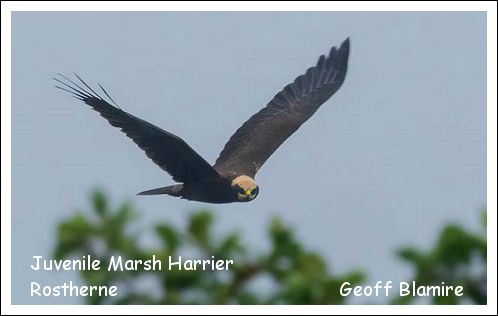 several Long-tailed Tits on the edge of Wood Bongs, Jays, etc. Hobby didn’t try to catch anything while we were there.
several Long-tailed Tits on the edge of Wood Bongs, Jays, etc. Hobby didn’t try to catch anything while we were there.Rupert Randall, Tom and Gisele Wall and Malcolm Calvert (and John Dawson's family) arrived later to scatter John Dawson's ashes through the Obs window! So nice to chat with everyone.
Malcolm is so pleased that John Adshead is gradually taking over ringing. BTO was very worried that the Reed Warbler project might stop in the future. Of course John gets there at sunrise, whilst Malcolm gets up when he wakes up and turns up later (he doesn't set an alarm clock!). I said that it’s so nice of John to walk up to the obs with some birds to show to anyone in the obs. Malcolm said it takes him all his time to walk up the hill and has to stop 3 times on the way. If I remember right they've rung 1400 birds this year! "..............
Wendy Stratford enjoyed a walk to Mobberley's Gleavehouse Pool last Sunday morning (21/9) and had what will probably the last Yellow Wagtail this year ..........."I went to the pool this morning - couldn't resist the glorious weather! Very quiet generally but there were greenfinches at the pool, and a single lapwing which must have been on the grass and flew up over the pool and circled round into the field behind the obs, calling as it went. The margins of the pool are noticeably greener than last week - full of weeds thanks to the rain and warmth! I heard a yellow wagtail call near ‘quail corner’ but couldn't see it. 4 house martins and a mewing buzzard as I approached the SQ. "..........
I walked down to the pool yesterday morning (28/9), the field that housed two pairs of Yellow Wagtails earlier in the season
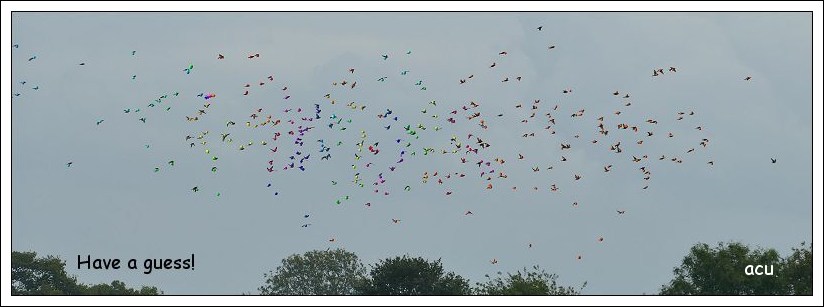 has been cleared and the recently sowed winter barley is beginning to push through. The big field of maize next door has been harvested and harrowed, it's attracting a big flock of Linnets; I took a picture and counted them marking each with a coloured ball as I progressed - there were 295! This is a better way of counting a flock of birds than the usual "count the legs and divide by two". Yes, I know - that's an old one!
has been cleared and the recently sowed winter barley is beginning to push through. The big field of maize next door has been harvested and harrowed, it's attracting a big flock of Linnets; I took a picture and counted them marking each with a coloured ball as I progressed - there were 295! This is a better way of counting a flock of birds than the usual "count the legs and divide by two". Yes, I know - that's an old one!We had an excellent morning at Rostherne last Monday (22/9) ........."September 22nd, the autumnal equinox and the first day of the astronomical autumn. Fittingly the temperature dropped to zero at 07:13am.
A bit chilly in the Rostherne obs. but excellent viewing conditions.
The reserve was pretty quiet, not much to report but Phil Rowley arrived and, as the air temperature rose raptors began to appear. First a Buzzard which was being harried by a Sparrowhawk then, over Bowdon Church, a Peregrine, followed a short time later by two Hobbies; through his big 'scope Phil could see them reaching down to eat their prey. By this time Bob had arrived and was able to join in the fun! Phil left about noon and missed the female/imm. Marsh Harrier that made a brief appearance, floating over the boathouse reedbed.
Also today - Singing Cetti's Warbler and Chiffchaff plus several views of Raven."..........
Bob stayed a little longer ........" Just before I left there were no less than 4 Sparrowhawks circling together, surely a family".......
G&S walked to the reserve the following day ......."
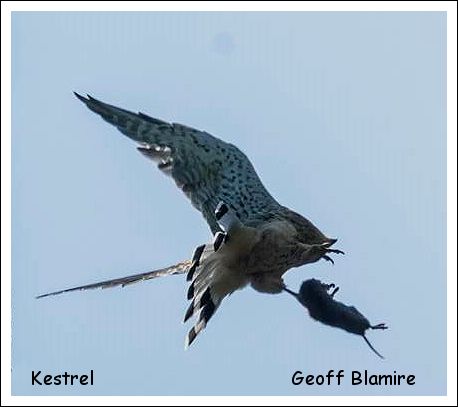 Did our usually Tuesday morning to Rostherne. The only new species added were a Kestrel, 2 Song Thrushes and a Mute Swan. Simon arrived just as we were leaving first question was “Have we seen any Hobbies?”. He thought they might have flown south but I said you saw them yesterday – but not the usually places – high over Mere Covert. I said I’ll look forward to receiving his Whatsapp messages to say Hobbies, Marsh Harrier, etc. Not to be, but Sheelagh had a Bittern which flew past the bittern hide! Unfortunately not towards to the obs and Simon. He puts the hours in.
Did our usually Tuesday morning to Rostherne. The only new species added were a Kestrel, 2 Song Thrushes and a Mute Swan. Simon arrived just as we were leaving first question was “Have we seen any Hobbies?”. He thought they might have flown south but I said you saw them yesterday – but not the usually places – high over Mere Covert. I said I’ll look forward to receiving his Whatsapp messages to say Hobbies, Marsh Harrier, etc. Not to be, but Sheelagh had a Bittern which flew past the bittern hide! Unfortunately not towards to the obs and Simon. He puts the hours in.We spent some time with a Kestrel yesterday along Moss Lane, High Legh – he caught a vole but kept being disturbing by a walker, then a tractor, then a car. Flew to one pole, then the next, then another…
At lunchtime there were at least 12 hornets on our ivy – could have been many more – difficult to count!!! "...........
Bob had a bit of luck yesterday (28/9) at Rostherne ......" I had a couple of hours at the Ob today, which was lucky as Mike Duckham had located 2 Black-Necked Grebes which were moving about the mere quite quickly and I had a decent view through his 'scope.. Otherwise usuals. Lots of Long-Tailed Tits. Five pesky parakeets screamed over my head as I walked back to my car, like an alien invasion.. "..........
Bringing us up-to-date, two reports from the Blamires ......." Friday morning (26/9) around Millington area: Chiffchaff singing, several Mistle Thrushes battling for berries, 20+ mixed flocks feeding on seed heads – mostly Goldfinches and couple of Linnets, Buzzard perched on its usual dead tree and joined by a female, Starlings, and another Buzzard near Children's Adventure Farm.
Saturday morning Rostherne (27/9): Rostherne Brook/Rostherne Lane 12+ Long-tailed Tits and mixed feeding flock including Chiffchaff, Blue and Great Tits, and Wren. Obs there were so many Goldfinches going to the bird table – 20+ but could have been many more, female Kestrel, adult Mute Swan and a cygnet, 5 Shovelers, Jay, no geese! and 2 Ring-necked Parakeets. Phil had Wigeon later but they weren't there when we there.".........
Goldfinches have enjoyed a good breeding season, our feeder, containing sunflower hearts (from Bulgaria), needs replenishing every day!
Friday's indoor meeting, the first of the new season, drew a good crowd who thoroughly enjoyed the presentation by Chris Galvin. Chris certainly knows his birds, is an excellent photographer and combines the two to produce a memorable evenings entertainment!
Finally in an email titled - It's all over now Baby Blue, Bob contemplates the last of the Hobbies and the transient nature of summer!
..........." Had a long scan from the ob pm without success. Geoff and Sheila had no luck earlier either so it looks like the hobbies may have departed. Oh well, it was good while it lasted..".................
Forget the dead you've left, they will not follow you
The vagabond who's rapping at your door
Is standing in the clothes that you once wore
Strike another match, go start anew
And it’s all over now, Baby Blue
19th September 2025 ......Rostherne proving very popular.
 |
Our regular contributors have been spending much of their time lately at Rostherne Mere NNR, where the Hobbies are still present and remain the main attraction.
Bob Groom was there after we'd left on Monday the 8th ............"2 Hobbies during my visit to the ob yesterday (8/9), perched together at one point and one did a spectacular flying display over the mere. Ah the energy of youth.. Good view of Sparrowhawk in dead tree. Also 2 GSW chasing each other in same dead tree. A family of Goldfinches visited the bird table. Heron, Buzzards, Nuthatch, 4 Swallows, 6 Mute Swans..
This morning (Tues 9/9) I tried to get into Tatton for a quick pre-duty visit but found the Knutsford gate closed. Taking the longer route cut down my time, just a few Swallows seen and the juvenile Great Crested Grebe was calling loudly for food on Tatton Mere.."..................
The Knutsford entrance to Tatton has been temporarily closed. The red deer that, pre-covid, remained well away from areas frequented by the public can now be found close to the Knutsford Drive leading down to Melchett Mere. There have been some incidents this year and people have ended up in hospital, hence the closure.
Geoff and Sheila Blamire included the reserve in their morning walk the following day (10/9) ........." When we arrived a Buzzard was perched on the dead trees right of the Obs by the mere – still there when we left – hadn't moved at all! John, then Mike, arrived – then later Steve. One juvenile
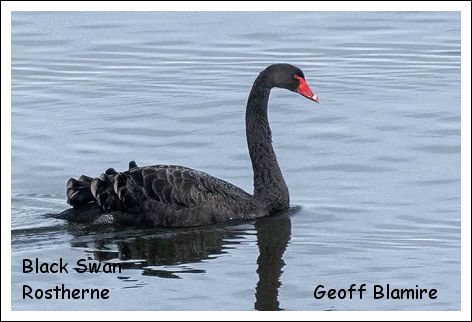 Hobby appeared on the ‘hobby’ trees but spent a lot of time out of sight. The Bullfinch with papilloma virus was around – still appears healthy but lame and might lose its left leg at some stage. 4 Gadwalls notable. Soon after we left to walk home John & co had a Marsh Harrier over the ‘hobby’ tree! Oh well…."............And again on Saturday last (13/9)........."The Hobby was waiting for us when we arrived at 10am. It was there on the ‘hobby’ trees when we left. But not much in between except occasionally trying to catch insects over the mere without much success. Buzzard was on the dead tree right of the obs but that disappeared quickly. Other birds: Black Swan (first seen on Tatton Mere Monday 8th Sep), GS Woodpecker (no sign of the Green Woodpecker), Chiffchaff, Cetti’s Warbler (heard briefly), Grey Wagtail, male Bullfinch, Goldfinches, fem Chaffinch (perched on the top of the split limes!), Long-tailed Tits, Jays, 2 Greylags, Grey Heron, just 1 Mute Swan, etc."...........
Hobby appeared on the ‘hobby’ trees but spent a lot of time out of sight. The Bullfinch with papilloma virus was around – still appears healthy but lame and might lose its left leg at some stage. 4 Gadwalls notable. Soon after we left to walk home John & co had a Marsh Harrier over the ‘hobby’ tree! Oh well…."............And again on Saturday last (13/9)........."The Hobby was waiting for us when we arrived at 10am. It was there on the ‘hobby’ trees when we left. But not much in between except occasionally trying to catch insects over the mere without much success. Buzzard was on the dead tree right of the obs but that disappeared quickly. Other birds: Black Swan (first seen on Tatton Mere Monday 8th Sep), GS Woodpecker (no sign of the Green Woodpecker), Chiffchaff, Cetti’s Warbler (heard briefly), Grey Wagtail, male Bullfinch, Goldfinches, fem Chaffinch (perched on the top of the split limes!), Long-tailed Tits, Jays, 2 Greylags, Grey Heron, just 1 Mute Swan, etc."...........Bob's prayers were answered on Sunday morning (14/9) ......." Having been booked for duty Monday morning I decided to chance a Sunday morning visit and I was lucky with just one space left in the church car park. It was a rewarding session with a female Marsh Harrier giving good views as it hunted the mereside and a Hobby present until just before the rain arrived, mostly static on the left hand trees with just a couple of food forays. A Sparrowhawk hurtled down into Harpers Bank wood.There were dozens of hirundines, mostly House Martins. Couple of Buzzards and a couple of Jays. Also Heron, Great Spotted , Goldfinches and a perishing R.R Parakeet (where are the peregrines when you need them..).".........
Meanwhile G&S decided on a trip around Plumley and Holford Moss ........"" Managed to complete our walk around Holford and Plumley this morning before it started to rain, but it was cold and windy! Most notable: 6 Curlews (in flight), 2 Ravens (one flew in carrying a sweet corn and proceeded to eat it and 2nd one perched on Langford Farm railings before a mob of Jackdaws saw it off), Kestrel, 3 Buzzards, c30 Starlings and 1 Swallow around Langford Farm and just odd ones around the area............
On the same morning (14/9) I stuck to our local patch in Mobberley ........."A chilly 11°C this morning (in fact it's become warmer this evening, now 13°C at 7:30pm). I walked down to Gleavehouse Pool for the third time this week.
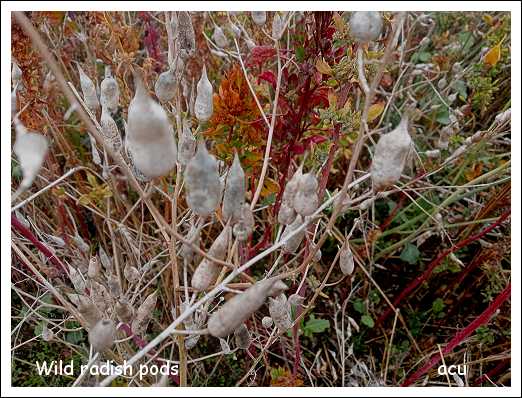 With 73 species on our trip to the Wirral last Sunday and all sorts of goodies turning up, even at Rostherne, it's hard work at this time of the year belonging to the "Friends of Gleavehouse Pool"!
With 73 species on our trip to the Wirral last Sunday and all sorts of goodies turning up, even at Rostherne, it's hard work at this time of the year belonging to the "Friends of Gleavehouse Pool"!Just Blue Tits, Jackdaws, a Robin, and family of Dunnocks on the track from Beech Cottage. The maize tunnel is still there although I think it will be harvested this week, the field next to the farm has been cleared. I met the farmer, David Simcock and he told me that it's normally done in October. The wildflower meadow I thought was 5 acres is actually only 3 and the wild radish plants have their pods, filled with tiny seeds, ready for winter finch flocks.
The pool is now circular and about 80' in diameter, so more a pond than a pool, nevertheless it has a nice muddy margin and I was delighted when a Green Sandpiper flew in and landed briefly. Only about 10'' and it was away, it's white rump shining against the approaching grey rain clouds. It would have made a great picture had I not left the camera at home to save weight....
Wendy was on Swallow counting duty at Blackthorn Farm, they've moved on but she'd had a few birds flying south.".........
Monday (15/9) found us at Rostherne, ready to sample Jude's delicious rock cakes for elevenses ............"13.5°C with very strong westerly winds this morning at Rostherne as Jude, Wendy and I arrived. Numerous hirundines feeding in the lee of Harper's Bank, mostly House Martins with a scattering of Swallows and Sand Martins.
No Hobby today, although I believe one turned up later in the day. A male Sparrowhawk was being bullied by two screaming Jays and a Magpie but seemed unfazed and gave good views as it twisted and turned over the mere
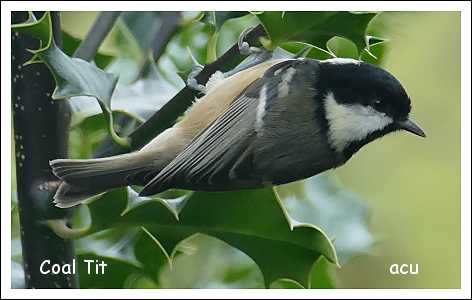 leaving it's perusers floundering, it seemed to be enjoying the chase.
leaving it's perusers floundering, it seemed to be enjoying the chase.The bird table was very busy and Coal Tits were feeding on the sunflower chips, the first we've seen for some time. Three juvenile Chiffchaffs were with us all morning.
Both Great Spotted and Green Woodpeckers were present, the latter heard only. A Great Black-backed Gull landed on one of the buoys, nearby three Lesser Black-backed gulls; at least 850 were counted in the roost this evening.
I drove home via Tatton but forgot the Knutsford drive was closed so I had to re-trace my steps! Loads of Swallows over the short grass next to the road, skimming just over the ground in search of food."............
On Wednesday 17/9) Wendy had a close encounter with a Sparrowhawk in her Smith Lane garden ..........."We’ve just had a very fluffed up sparrowhawk sat on the swing frame where the feeders hang. Usually the small birds vanish into the conifer hedge when this happens, but this time some continued flying between the hedge and the feeder on the kitchen window - very foolish as the sparrowhawk several times performed a spotted flycatcher action, leaping up to try and grab one and then returning to the frame. Very fortunately it was unsuccessful every time. Throughout there were acts of bravery by blue tits risking grabbing food from the hanging feeders. I went out and shooed it away!
Think I’m going to walk to the pool this afternoon.".........
Wendy did go over to Gleavehouse Pool during the afternoon and had a quick view of the Green Sandpiper. This prompted me to journey down there yesterday (18/9) and this time I took my camera! ............"A pleasant morning for a stroll down to GHP in search of the Green Sandpiper;
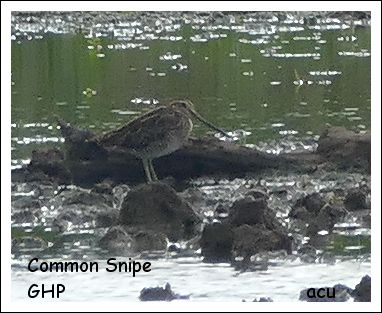 Wendy had a quick view of the bird yesterday. Today I took my camera but, needless to say, there was no sign of any Green Sandpiper!
Wendy had a quick view of the bird yesterday. Today I took my camera but, needless to say, there was no sign of any Green Sandpiper!A good morning for viewing 16°C and slightly overcast so I wasn't looking into the sun when sat in the obs. Some good vis.mig. with Swallows passing through all morning, not high, and often dipping down to the surface of the pool before continuing south. At one point a large group of about 30 gave a local Sparrowhawk a hard time as it circled overhead, later I saw what was presumably the same bird chasing a Meadow Pipit, one of a large number that have appeared over the past few days.
The only bird of any consequence was a Common Snipe that remained motionless at the far side of the pool all the time I was there but eventually it zig-zagged away when I moved closer to try and get a better picture. "..............
A timely reminder, from Derek Pike, that it's that time of the year again ........" Tony always says you can hear a Chiffchaff around here until at least when Gordon Yates used to visit us first indoor meeting of the season. I heard one in the garden this afternoon in the glorious unexpected warm sunshine of 22c; lovely.
I just realise one or two of you might not remember Gordon from Rochdale, a bit of a lad. The last to use, I believe, 16mm film. "...........
Yes that's right Derek, Gordon gave over 40 presentations to the KOS and they were always on the fourth Friday of September - the beginning of our new season of indoor and outdoor get togethers. It only came to an end in 2009 when the world ran out of Kodachrome 16mm colour film!
Gordon's still going strong though and now concentrates on producing video films - https://www.gordon-yates.com
As ever it's our first indoor meeting of the season coming up - a week today Friday 26th September when Chris Galvin will be presenting his talk - "North West Year"
Chris's talk will begin at 8:00pm but the Jubilee Hall will be open from about 7:15pm, allowing time for members and visitors to do some catching up and socialising. Non-members will be made most welcome - Jubilee Hall, Stanley Road, Knutsford, WA16 0GP
Admission is £3 for members and £6 for non-members. Admission and membership is FREE for under 18s!!
Our next field trip is on Saturday 11th October, when we'll be visiting Llanfairfechan and Morfa Madryn followed by Conwy RSPB, meeting at Llanfairfechan car park at 10am. Frank Dearden will be our leader for the day and you may want to let him know in advance if you're coming along - treasurer@10X50.com
9th September 2025 ........ The Wirral outing.
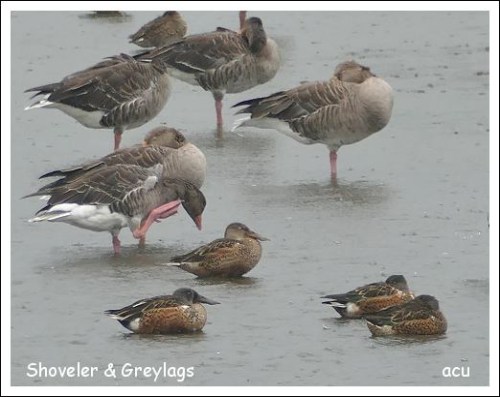 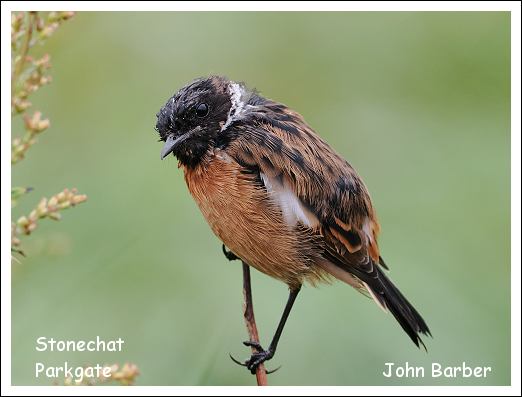 |
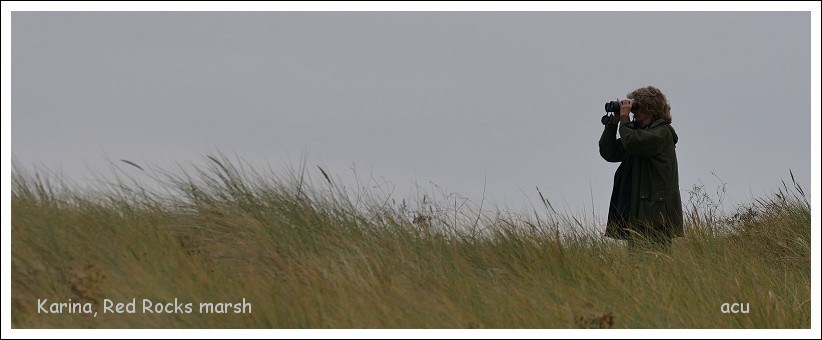 |
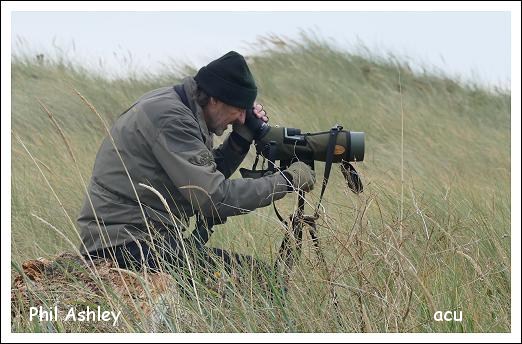 but there's a well-worn path and plenty of local folk using it, so we followed suit). Reaching a clear spot with views across to Hilbre, Middle Eye and the Little Eye 'scopes were deployed and revealed distant views of Ringed Plover, Dunlin, Redshank, Knot, Oystercatcher and Curlew.
but there's a well-worn path and plenty of local folk using it, so we followed suit). Reaching a clear spot with views across to Hilbre, Middle Eye and the Little Eye 'scopes were deployed and revealed distant views of Ringed Plover, Dunlin, Redshank, Knot, Oystercatcher and Curlew.Walking back to Red Rocks we positioned ourselves behind the handy perimeter wall of the Red Rocks Nursing home that gave some respite from the light drizzle that had now set in.
The tide was never going to come in fully (8.3M) and with an easterly wind, 50 yards and that was it. One or two waders landed within camera range - Dunlin and Ringed Plover and out on the sea a single Sandwich Tern passed through with four Brent Geese bobbing on the waves.
We left Red Rocks at about 12:30pm and, in the best traditions of the KOS, split up into smaller groups; some people went straight to Burton Mere, a couple to the seafront at Hoylake, others to Parkgate either to 'scope the pools there or visit the Parkgate Fish and Chip shop. I fell into the latter category and can report that the food is as good as ever - £7:80 for a small fish & chips, more than adequate.
Walking back to the car we came across two rather bedraggled Stonechats that posed nicely for John's camera - see the image at the start of this update.
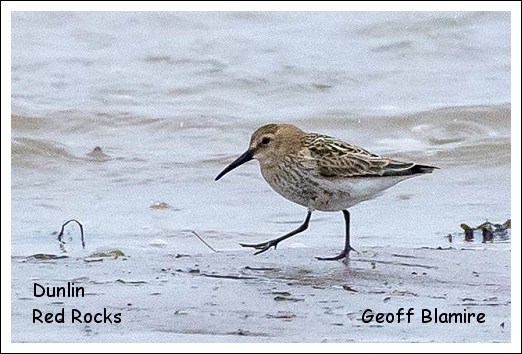
Plenty of room in the car park at Burton Mere, the weather was perhaps keeping visitors at home. From the visitor centre, the usual wildfowl were on view - Mallard, Canada Geese, Teal, Coot, Moorhen, Greylags and Shoveler. We spent a short time in the excellent new cafe before moving down to the Border Hide, overlooking the Centenary Pool. There's never normally much to see from the Marsh Covert Hide but on this occasion those that paid it a visit reported three Greenshanks, a Kingfisher and a Common Sandpiper.
Goldcrest, Chiffchaff and Cetti's Warbler were added to a rapidly expanding day list as we reached the Border Hide.
Teal, Shoveler, Mallard and Gadwall loafed on the pool whilst in the shallows and the muddy margins Redshank, Lapwing, Dunlin and two Spotted Redshanks that showed their characteristic white rumps and lack of wing bars as they took to the air. Geoff was quick off the mark and managed a good image as they departed.
Returning to the car park we met Colin Butler and Phil Ashley who'd been to the Hoylake foreshore where they'd had Wood Sandpiper, Linnet and Common Tern and, a few minutes previously, Hobby and Osprey from the visitor Centre!
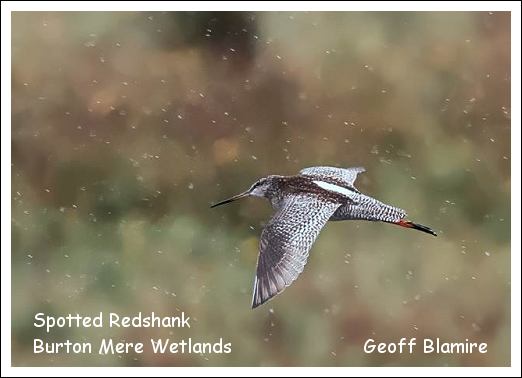
Our list for this trip was completed by Bob and Karina who paid a later visit to Parkgate picking up Spoonbill (13), Great White and Cattle Egrets bringing us up to 73 species for the day - well done team!!
Tatton ranger Darren Morris had what could be the last local Swift of the year last Sunday (29/8)........" A few house martins and sand martins in Tatton today. Swifts yesterday too."..........
Darren has kindly sent me a copy of the Park's Autumn wildlife news from Tatton - you can read it here. Thanks Darren.
More Hobby action last Wednesday (3/9) for the Blamires ..........."As normal we walked the length of Rostherne Lane and back before going to the Obs - to see what is around on a different area of the reserve. First thing we noticed was a load of office furniture, including a printer, that had been dumped near the bridge over Rostherne Brook (the 2 chairs looked better than mine!). I took a photo and sent it to Steve Ormerod (Natural England). Second thing we noticed on the reserve were 2 Ring-necked Parakeets! Not a good start to the morning. But everything improved when we go to the Obs. Juvenile Hobby on the tree opposite – closer than usual. Then I spotted another Hobby on the dead tree by the mere of right
 of the Obs. It was also a juvenile. The 2nd Hobby didn’t move for over an hour – still there when we left just after noon. By that time the original Hobby had moved out of sight. Other highlights: Buzzard perched on the ‘hobby’ trees, 2+ Chiffchaffs, 2+ Long-tailed Tits, male Bullfinch, female GS Woodpecker, 2+ Mistle Thrushes, 2+ Jays, 4 Mute Swans, juv Goldfinch, 1 Grey Heron, etc."............
of the Obs. It was also a juvenile. The 2nd Hobby didn’t move for over an hour – still there when we left just after noon. By that time the original Hobby had moved out of sight. Other highlights: Buzzard perched on the ‘hobby’ trees, 2+ Chiffchaffs, 2+ Long-tailed Tits, male Bullfinch, female GS Woodpecker, 2+ Mistle Thrushes, 2+ Jays, 4 Mute Swans, juv Goldfinch, 1 Grey Heron, etc."............The Hobbies seem to be commuting between Rostherne and Tatton, Roger Barnes reported a bird in the park on Friday (5/9) I went in later in the day but had no luck, although from the Allen Hide I did count a huge flock (for the species) of Mistle Thrushes ..........." Roger Barnes had a Hobby earlier in the morning. I walked from the Melchett car park to the millennium wood, just one Spotted Flycatcher on the dead conifer, three Ravens overhead.
From the hide - Kestrel, c.80 Canada Geese, 4 Greylag Geese, 4 Great Crested Grebes including one that appears to be incubating, one Little Grebe that passed, conveniently, just below the hide. A flock of Mistle Thrushes were feeding at the far side of the mere; they flew up into a tree, then transferred to another in batches - I counted 43!
Coot, Tufted Ducks, Mallards, one Pochard, two Mute Swans. "...........
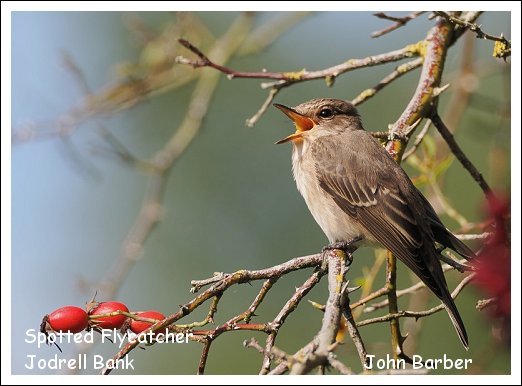 John Barber seems to be finding Spotted Flycatchers everywhere! ............."Inspired by Karina's visit to Jodrell Bank I went for a walk down Bridge Lane, Lower Withington to view the Lovell Telescope on the cheap!
John Barber seems to be finding Spotted Flycatchers everywhere! ............."Inspired by Karina's visit to Jodrell Bank I went for a walk down Bridge Lane, Lower Withington to view the Lovell Telescope on the cheap!Although I got some record shots of a Peregrine, I could not escape the Spot Flys - are they following me!
Spot Fly was on Blackden Firs off Bridge Lane. Good variety of birds down there; Swallow, House Martin, Buzzard, Treecreeper, Great Spotted Woodpecker, Raven, Long tailed Tit, Goldfinch and more. It's a short walk to the bridge at the lowest point of the Firs and that is as far as is went."............ Thanks John sounds like a good location.
Back in Mobberley, Wendy Stratford is predicting a hard winter ........."Walked to co-op this morning via Gleavehouse lane - a single swallow, which flew south (they often do!) and a lovely charm of c20 goldfinches. The feeders are so busy - a pair of green finches and a youngster hogging the sunflower hearts feeder while at least 10 goldfinches panic around them! Nuthatch also in and out, and many tits, robins, starlings, robins and sparrows. I think this winter may be hard weather wise - so many berries and nuts, and the resident hedgehog gets plumper by the night! "............... Thanks Wendy, that's a long route from home to the co-op!!
Wheatears are on the move, we had two on Sunday in the grounds of the Red Rocks Nursing Home, Phil Ashley had an inland bird on Friday (5/9) at his workplace, also on Mobberley's Gleavehouse Lane.
On Monday this week (8/9) Jude Halman, Bob Groom and I spent a couple of hours in the obs. at Rostherne Mere ..........The Hobby duly appeared at about 10:30am. Prior to that we saw a quick movement in the lower branches of the split lime, it turned out to be a Tawny Owl that was being harassed by a Magpie and later a Jay.
On the way back to the cars Jude spotted a Tawny Owl in the grass verge as we walked up to the NE car park. We assumed it wasn't well but after I'd taken a record shot it flew away strongly over the sprout field.
Closer examination of the image revealed a whole host of nasty looking insects on it's head, over its eyes and beak. I don't know if this is normal."..............
I did take a photo but it's not for the squeamish so I've not reproduced it here.
Species recorded on the field trip to the Wirral peninsular. 7th September 2025 |
3rd September 2025 ..........An abundance of Flycatchers.
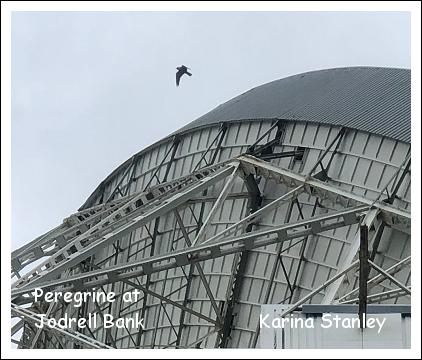 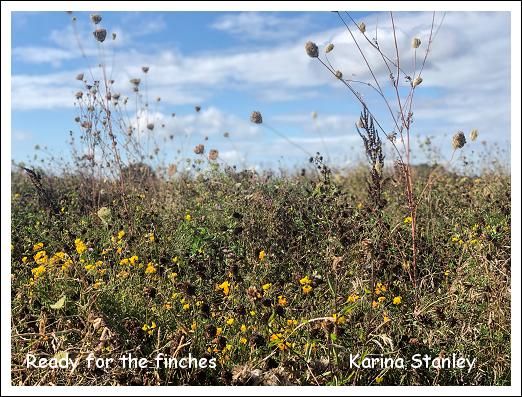 |
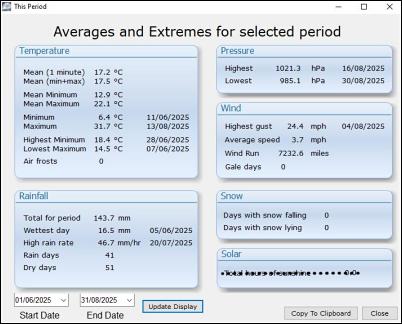 so not too far out and I can tweak it a bit, but not to be relied on when you're measuring global warming - we'll leave that to Great Egrets, Cattle Egrets, Little Egrets, Spoonbills and Cetti's Warblers et al. to prove it's happening!
so not too far out and I can tweak it a bit, but not to be relied on when you're measuring global warming - we'll leave that to Great Egrets, Cattle Egrets, Little Egrets, Spoonbills and Cetti's Warblers et al. to prove it's happening!Swallows and Martins have made the most of conditions this year and many seem to be on their third broods as Geoff and Sheila Blamire noted on a morning walk around Plumley (24/8) .........."This morning we walked around Holford and Plumley area. Highlights were: A family of Ravens (3+), 2+ Buzzards, Kestrel, 4 Linnets, 2 Jays (bumper crop of acorns this year!), 50++ Goldfinches (feeding on thistle heads), Chiffchaff (singing), many Swallows around, House Martins are still going to the nests in Langford Farm. ".............
Wendy Stratford watched Swallows, still with young in the nest, last Thursday(28/8) in Mobberley ..........." I hope you're enjoying the rain?! I am. Before it started I walked to the pond this morning - mainly to see swallows. There were about 8 around the barns in Gleavehouse lane and one was going in through the barn door several times, so maybe on 3rd brood? The pool was very dry - only somewhere between a third and a half still has water. There were no birds at all. Coming back I heard but didn’t see a yellow wagtail near their field, and there were a couple of house martins over the SQ - which looks very pale and dusty.
The garden feeders remain very busy - more so than usual in late Aug. Still many young tits, robins, goldfinches and starlings. We have a hedgehog building a nest in between a huge clump of iris and a low overhanging wall right behind it!
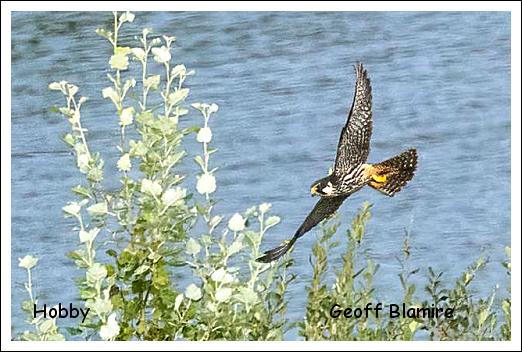 Taking in large amounts of dead forget-me-not leaves etc. Should be very cosy. Don't know why I bother with a hedgehog box!"...........
Taking in large amounts of dead forget-me-not leaves etc. Should be very cosy. Don't know why I bother with a hedgehog box!"...........Bob Groom's fitting in visits to Rostherne Mere in-between grandad commitments (26/8) ........" A short visit before duty. No hobby, unfortunately but did have a female Marsh Harrier circling over the mere. Dozens of House Martins during a heavy shower. Usuals included GSW, Heron, Sparrowhawk.."..........
Geoff and Sheila were there last Thursday (28/8) ........."We were approaching Rostherne village when message came through that John Adshead was going to release a Kingfisher at the Obs at 0950 hours. So we went straight to the Obs rather than walking Rostherne Lane first. It was rather a coincidence that we were there when the last Kingfisher was released by John. This time it was a juvenile male with pristine plumage and such an electric blue back and rump. Gorgeous. Probably ringed the whole family now. He'd a busy morning, having got to Doll’s Meadow at 5.30am and disturbed a Hobby which flew across a beautiful sunrise. He and Sam had rung about 40 birds including 2 Tree Pipits (adult and juvenile), 2 Grey Wagtails, another Cetti’s Warbler and numerous Chiffchaffs and Willow Warblers. One Willow Warbler appeared to have a lump on its back, thought it was a tracker, but it hadn't been caught before as it wasn't wearing a ring so it couldn't be that. On closer examination he managed to pull an enormous maggot-type grub (like a Botfly)which was burying into the poor bird. It left a big hole but it might just survive. He's never seen or heard the like! I said he should write it up.
Other highlights include 91 Greylag Geese (85 in a flock and rest amongst Canada Geese), 150+ Canadas, 2 Gadwall, usual Cetti’s Warbler (heard), Nuthatches (2), GS Woodpecker, Grey Heron, 3 Mute Swans, etc."...........
Bob returned to the mere on Friday (29/8) .........." A lucky sighting was a juvenile Hobby that spent several minutes in mereside dead tree t o right of the Ob. Also seen several Buzzards and, briefly, a very dark Peregrine. Usuals like Heron plus no less than 4 Mute Swans .."..........
He was back the following day (30/8) following a call from G&S ............" When we arrived the juvenile Hobby was perched on the ‘hobby’ tree. We watched it catching dragonflies and taken them back to eat. Unfortunately didn’t perch any closer so Geoff’s photos are heavily cropped. Rang Bob who duly arrived and satisfied his Hobby addiction! As we were leaving Phil and Susan were walking to the obs - hoping for Susan to see it. Stock Doves were sitting on nearer trees - a very underrated species. Also male Bullfinch briefly, but most of the time our attention was on the Hobby."...........
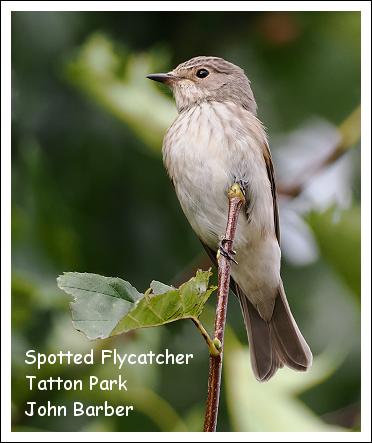 Also on the 30th August KOS Secretary, Karina Stanley visited the Jodrell Bank radio telescope and managed a record shot of Peregrine in what's become its natural environment (see the start of this update) ......" Not a superb image, but thought you might like to see it!
The dish was moved while we were there today and the peregrine pair were unsettled. Great views!
"........
Also on the 30th August KOS Secretary, Karina Stanley visited the Jodrell Bank radio telescope and managed a record shot of Peregrine in what's become its natural environment (see the start of this update) ......" Not a superb image, but thought you might like to see it!
The dish was moved while we were there today and the peregrine pair were unsettled. Great views!
"........On Friday I paid a visit to the Allen Hide, overlooking Tatton's Melchett Mere .........." I spent some time in the Allen hide this afternoon after a quick scan of the main mere promised nothing of any significance.
The feeders were nicely stocked and were attracting the usual species - Blue, Great and Coal Tits and an adult male Great Spotted Woodpecker.
I put some fresh KOS business cards into the holder.
On Melchett - Grey Heron, c 100 Canada geese, 2 Egyptian Geese, Mallard, Pochard, Tufted Duck and a good post-breeding flock of c 25 Mistle Thrushes.
The afternoon was enlivened by the appearance of a young man and his two sons aged 10 and 4. The younger of the two was anxious to demonstrate his transformer truck! The older lad, Arran, had a Canon bridge camera and got some nice shots of a Coal Tit and the GSW. He'd recently won a £100 Opticron voucher for his image of a honey bee in an online competition.
https://www.henharrierday.uk/news/young-wild-photographer-2025-winners (second one down)
Just the sort of people we need in the KOS, so dad got the full spiel!!
You never know. "..........
On then into September and the second found Karina close to home on Blackhill Farm ........" It was good to see the parent Kestrels flying around the railway line patch with a juvenile today. They were making contact calls with each other and hunting around the recently cut wheat fields. A couple of Hare were there too.
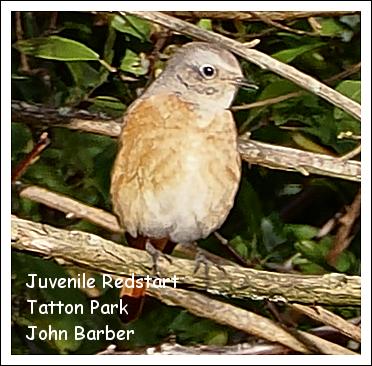
House Martins are still present on the Blackhill farm building with young in the nest.
One field has been left to ‘rewild’. A veritable feast of seed-headed plants is ready for the taking and 3 Yellowhammers were present as were Chaffinch, Linnet, Goldfinch and Bullfinch. I’m hoping the plants will stay a while! "......... (See Karina's image of the wildflower meadow at the top of this update)
On Tuesday this week (2/9) I visited Tatton again........" A lovely morning in the park, 18°C and a light southerly wind. I parked at the Melchett car park and had intended to walk as far as the Mill Pool and then visit the Allen Hide but, making my way past the old hall, I met John Barber on what's become his regular morning stroll to the area in and around the Millennium Wood.
Last Friday (29/8) he'd obtained some good shots of a juvenile Redstart and a Spotted Flycatcher. The flycatcher was only one of 10 (yes ten, one zero) that were feeding in the middle of the wood, in an area centred on a dead conifer. We had none there, although we did see a nice bright yellow Willow Warbler.
Emerging from the far side a flycatcher was operating from the top of one of the trees and, in an adjacent oak, three perhaps four others. They were taking insects in flight and also from the ground. Also there a small flock of Swallows and a Green Woodpecker. John had a picture showing three Green Woodpeckers in the same shot. I never got as far as the Allen Hide."............
Don't forget on Sunday 7th September it's our first field trip of the new season when we'll be visiting Red Rocks and Burton Mere Wetlands.
I'll be leading this trip, so please let me know if you're coming along - tony@10X50.com
We'll meet up at the far end of Stanley Road, Hoylake. CH47 1HN at 10am. High tide is 11:30am so that gives us time to explore Red Rocks Marsh as well as catching up on the latest gossip as we wait to see what the tide brings in.
After the high tide we'll make our way to Burton Mere (they will be expecting us) via (if you wish) the Parkgate Chippie!
27th August 2025 ......... Hobbies.
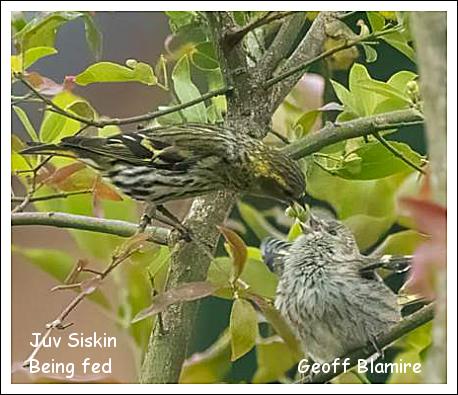 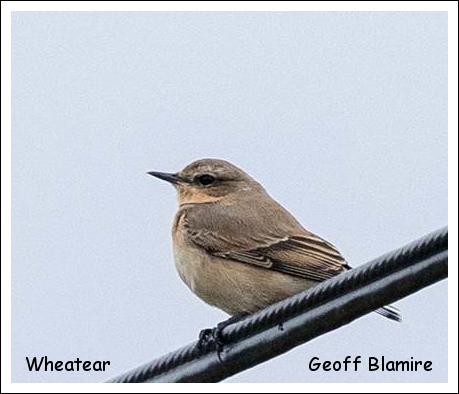 |
Geoff and Sheila Blamire had a pleasant surprise last Wednesday (20/8) on their morning walk, with a Wheatear on its way south for the winter. ........."Did a 11km walk around Millington
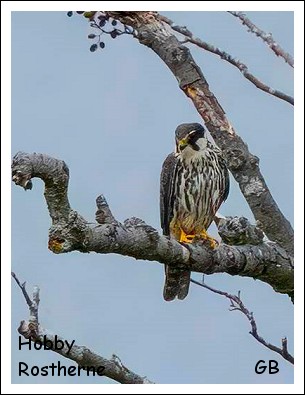 and Mere this morning. The ‘usual’ pair of Linnets Peacock Lane – anxiety calls from the male directed to us - so still breeding? Harvested field held 25 Black-headed and 24 Lesser Black-backed Gulls and 1 Grey Heron. Moss Lane: WHEATEAR!!! Can get Wheatears on the Wirral coast from the end of August, but 20th August seems very early inland. Also seen Buzzard on Moss Lane.
and Mere this morning. The ‘usual’ pair of Linnets Peacock Lane – anxiety calls from the male directed to us - so still breeding? Harvested field held 25 Black-headed and 24 Lesser Black-backed Gulls and 1 Grey Heron. Moss Lane: WHEATEAR!!! Can get Wheatears on the Wirral coast from the end of August, but 20th August seems very early inland. Also seen Buzzard on Moss Lane.Back garden: 2+ Siskin juveniles! One time the female was feeding one of the juveniles (see above).".........
Two days later they were at Rostherne and connected with the Hobbies ..........."Rostherne: 2 Hobbies! 1 adult and 1 juvenile. Lot of interaction and chasing across Dolls Meadow. Spent most of the time in the hobby trees. Phil arrived (he was meant to doing jobs in the house!) and Simon Cook (couldn't resist seeing Hobbies), lastly (but not least) Bob Groom – had a quick view before he had to leave for grandad duties (late!!). Also Grey Wagtail along Rostherne Lane/Rostherne Brook area. It’s so overgrown now it’s very difficult to see anything.
Mere garden: 1 female and 2+ juvenile Siskins including fed by female (sunflower hearts). Blue Tits were feeding on our pears – we only have 5 pears in total anyway! Grrrrr…."..........
On Monday morning (25/8) a small group of us went over to Rostherne, taking advantage of some decent weather before the onset of more autumnal conditions .........."A very pleasant 24°C this morning, ideal for a couple of hours in the Rostherne obs. Reporting for duty - Jude, Derek and me. We joined Brian Dyke, who was on a rare visit to the reserve.
A Hobby was with us for most of the morning, perching in the dead alder at the side of the mere. It was very active making frequent flights (out of our view) in search of food, presumably dragonflies that it was eating on the wing as it never returned to its perch to consume anything substantial.
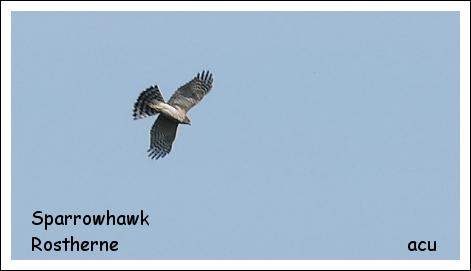 At one stage it was joined by a Magpie and a male Sparrowhawk that chased the magpie away before leaving the scene in the direction of mere Covert. Other raptors - Buzzard and a distant Kestrel.
At one stage it was joined by a Magpie and a male Sparrowhawk that chased the magpie away before leaving the scene in the direction of mere Covert. Other raptors - Buzzard and a distant Kestrel.This has been the last day before the arrival of named storm - "Erin" bringing, so we're told, a period of high winds and rain.
Our new next door neighbours arrived about a year ago - Arnie and Erin. They've not wasted any time and Erin is expecting the arrival of their first child at any time. Wouldn't that be a nice coincidence!"........
It's the right time of the year for sightings of Ospreys as they make their way back to Africa. They can turn up anywhere, from now right up until November and the first frosts. Phil Rowley did well with four on Monday down at Blithfield - mind you they have nested there!
........."Osprey City today!!
4 up over the reservoir this morning whilst sitting on what would have been a waterside bench capacity now is at 45% and the old water mill ruins are showing very well. At one point there was an Osprey and Peregrine soaring together. Last Saturday, whilst trying not to fall out of an ancient Damson tree there were no less than 5 Hobbies circling above"..........
Hirundines seem to be on the move, Bob noticed good numbers on a visit to Rostherne last Friday (22/8) .........." Quick visit to the sprout fields pm. No sign of the flycatcher
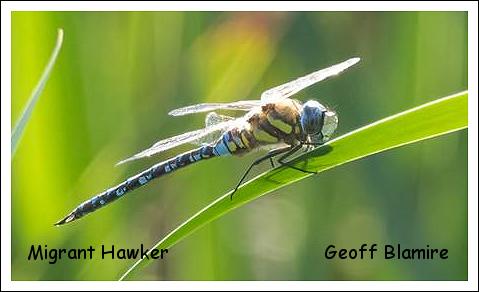 apparently seen earlier; disappointing but did see Sparrowhawk, the 2 juvenile Kestrels interacting, Song Thrush, 4 Linnets and scores and scores of Swallows and House Martins".........
apparently seen earlier; disappointing but did see Sparrowhawk, the 2 juvenile Kestrels interacting, Song Thrush, 4 Linnets and scores and scores of Swallows and House Martins".........Earlier on the same day a text from Phil Ashley also mentioned the early aggregations ........" 60+ Swallow this morning at 6.30am on telephone wires at junction of Gleavehouse Lane, been working here 4 yrs now only came for a weeks works!, but that the most I've ever seen, gathering early for their long journey ".........
On Sunday 7th September it's our first field trip of the new season when we'll be visiting Red Rocks and Burton Mere Wetlands.
I'll be leading this trip, so please let me know if you're coming along - tony@10X50.com
We'll meet up at the far end of Stanley Road, Hoylake. CH47 1HN at 10am. High tide is 11:30am so that gives us time to explore Red Rocks Marsh as well as catching up on the latest gossip as we wait to see what the tide brings in.
After the high tide we'll make our way to Burton Mere (they will be expecting us) via (if you wish) the Parkgate Chippie!
http://www.deeestuary.co.uk/nwirral.htm#hoylake
https://www.cheshirewildlifetrust.org.uk/nature-reserves/red-rocks-marsh
https://www.rspb.org.uk/days-out/reserves/dee-estuary-burton-mere-wetlands
19th August 2025 ...... Hobby & Harrier at Rostherne.
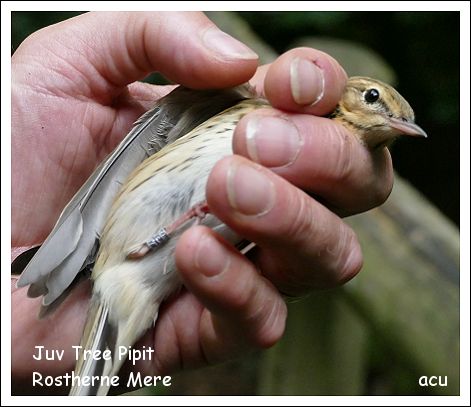 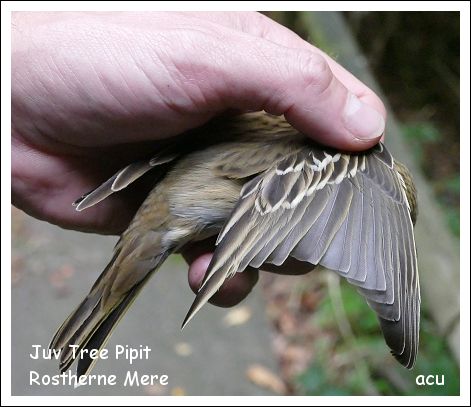 |
...........No sign of Spot Flys this morning (Phil went through Wood Bongs to the Bittern hide – no sign either). Kestrel spent some time on the dead tree by the mere (not the Spot Fly dead tree). Also nice to see a male Bullfinch, but it didn’t come to the bird table. Moment of excitement when a large raptor dropped into the reeds under the ‘hobby’ trees as if it was pouncing on something. But it didn’t reappear (digesting its meal?). Probably Marsh Harrier (what else could it be?) but I hoped someone else would see it. Apparently this afternoon a female Marsh Harrier was seen circling over Tatton Park – the Rostherne end!"..........
The flycatchers are still around as G&S found out two days later (15/8) .........."Good morning this morning. Simon Cook had been there since 8.30am and Bob arrived at the same time as us. Most of note were 2 Kestrels – 1 male and 1 juvenile. Plus usual several Grey Herons, 2 Buzzards, 1 Greylag Goose,
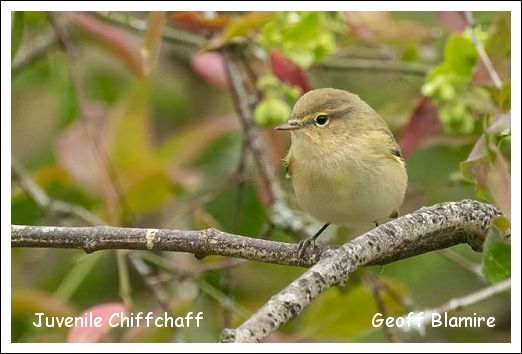 etc. Simon had 1 Little Egret and pair of Bullfinches before we came. Simon walking back to his car and ‘stumbled’ on a pair of Spot Flys at the entrance to Wood Bongs – so they are still around!".............
etc. Simon had 1 Little Egret and pair of Bullfinches before we came. Simon walking back to his car and ‘stumbled’ on a pair of Spot Flys at the entrance to Wood Bongs – so they are still around!".............A short distance away Tatton ranger, Darren Morris had a productive day in the park's deer enclosure (15/8) ......." This afternoon in Tatton's deer enclosure: 5 mandarin duck and a green sandpiper on the River Birkin and two stonechats.
Oh and a little owl calling in front of the mansion in the Ice Pond Field."............
I spent an enjoyable couple of hours at Rostherne on Monday ..........."John Adshead put a Hobby sighting on the Rostherne WhatsApp group early this morning (18/8); promising as I was going there later.
As I was walking through the "sprout field", a second post arrived. John had just ringed a Tree Pipit and would take it to the obs in 10 minutes. Perfect timing.
I was the only birder there and was able to take some pictures as John explained why it was a Tree Pipit and why it was a juvenile!
He wasn't getting many birds in his nets so that gave him time to bring the bird up to the obs from Dolls Meadow.
Back in the obs a Hobby was perched in a dead tree overhanging the mere, just a bit to far for my camera, unfortunately.
I rang Bob who arrived shortly afterwards, just after Phil Dell. It spent a lot of time in view, leaving from time to time returning with dragonflies that it consumed on it's favourite perch.".........
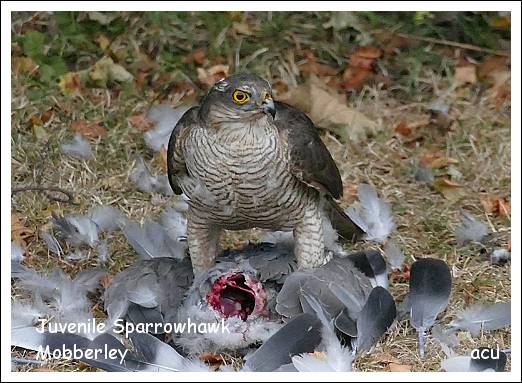 It was thoughtful of John to bring the pipit up to the obs and explain the essential features that identified the bird and its age. It was just a pity that I was the only one present!
It was thoughtful of John to bring the pipit up to the obs and explain the essential features that identified the bird and its age. It was just a pity that I was the only one present!Since its formation in 1971 the South Manchester Ringing Group has always enjoyed a good relationship with local birders and it's members are always on hand with advice and help with difficult ID's. The young female Sparrowhawk pictured yesterday in our garden in Mobberley was identified and aged by Hugh Pulsford who's also a very active member of the group. Hugh rings on Knutsford Moor and you can read about his activities on the Moor here.
In the last update (13/8) I mentioned meeting Malcolm Calvert, a founder member of the SMRG (and season ticket holder at Edgeley Park), as he was just completing another ringing session, with John Adshead, at Rostherne. He's kindly sent me a history of Cetti's Warbler at Rostherne Mere ........."To say that Cetti's Warblers have become established on the Rostherne reserve is an understatement.
Beginning with the capture and ringing of a male in December 2009 we have handled 88 individuals (up to 13 August).
This year alone since 26 March we have achieved 55 trappings involving 28 birds, 10 of which were from ringing in earlier seasons and 14 were this year's young (7 males, 7 females). With such a dimorphic species we can identify the long-winged, heavier birds as males as against the shorter, lighter females.
Mist-netting has enabled us to record captures suggesting breeding at almost all points around the mere."............
Thanks Malcolm, I don't think anyone could have predicted the spread of Cetti's Warbler since 1967 when you gained your ringers licence!
13th August 2025 ........... An unusual visitor to Tatton Mere.
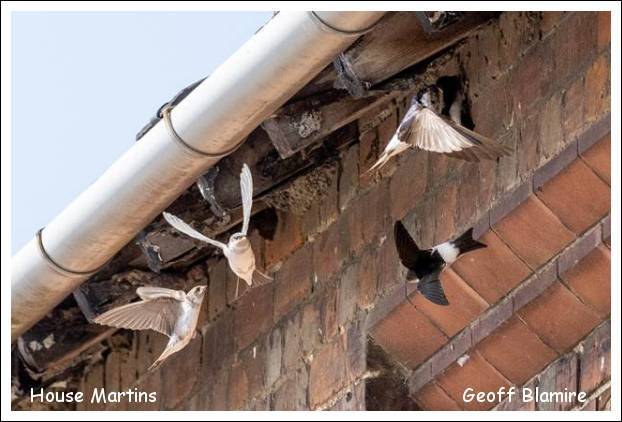 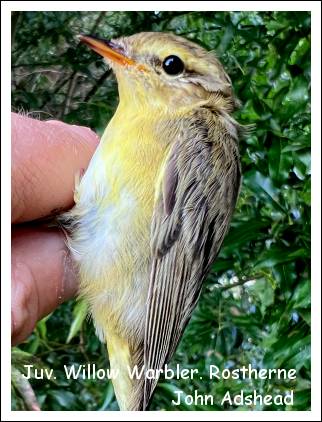 |
Sandwich Terns aren't particularly rare birds, you can see them anywhere along our coastline, but you don't see many inland and I have never seen one on any of our Cheshire meres. I was delighted therefore to receive this quick email (6/8) from John Barber with news of a bird on Tatton Mere
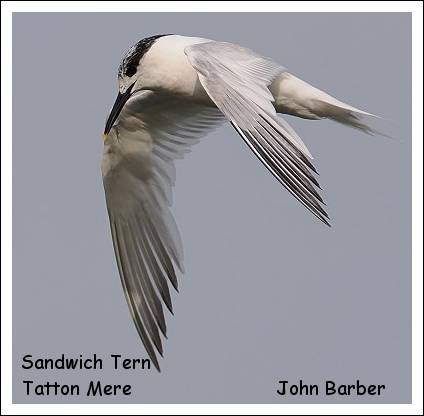
..........."I thought this was worth sharing.
First seen with Common Terns on the fence that cuts across Tatton Mere at the end of Higmere Plantation at about 4 PM..... Cheers, JB"..........
Yes it was certainly worth sharing, John; a good record for the park and what a great image! John is one of our newer KOS members and obviously a dab hand with the camera!
Bob Groom saw the tern the following day but I failed to locate it last Friday (8/8), although I was pleased to see three Common Terns at the same location.
Another recent recruit to the society is Phil Ashley, a very experienced birder who, with his licenced ringer friend, Paul, has spent endless hours in past summer months, ringing bird of prey in Wales on land owned by Dwr Cymru Cyf (Welsh Water) - Merlin, Hen Harrier, Peregrine and Goshawk.
This summer Phil has confined his activities to east Cheshire and has located no less than four active Hobby sites! Hobbies are a very photogenic species and any known nest will attract the attention of droves of photographers in search of "likes" on their facebook and twitter pages, so Phil has, quite rightly, decided to keep the locations to himself.
Wendy Stratford has been down in Poole, Dorset and came across Hobbies there ........" It eventually stopped raining so I walked to the pool this afternoon(5/8), then carried on to the sheep farm and turned right towards Bentleys.
The highlight was that I saw swallows, sand and house martins and swifts!
Swallows and sand martins at several points, 2 swifts at Springwood farm and house martins in Pavement lane. Going through the maize tunnel in the skylark field a yellow wagtail was on the path a couple of yards in front of me and flew along a bit before heading away!
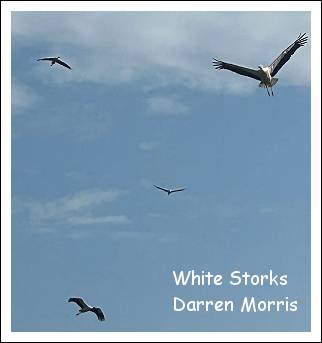
At the pool there were 4 juvenile Egyptian geese - flying around, then landing, then flying around etc. The pool is even drier than last week, and the cows were enjoying the water.
I did a nightjar walk in Poole 2 weeks ago on Slepe Heath, and as it was getting quite dark and we were listening to the nightjars churring, and seeing a few flights, a hobby was calling in nearby tall trees. The guy leading the walk said they had several times seen hobbies hunting bats there! "...........
Also on their travels, Darren and Yvonne Morris ........."We were really privileged to be invited to see the white storks being released at Wadhurst Park.
48 juveniles that were reared at Cotswold Wildlife Park were brought to Wadhurst two weeks ago and put in pens to acclimatise them. Wild, free-flying storks from nearby Knepp estate were already present and when they were released, the 48 juveniles joined 40 wild birds from Knepp and Wadhurst. They will all migrate to Morocco in the next few weeks and will hopefully return to breed next year. "......... Three KOS members will be off to Morocco in November so, you never know, they may meet up down there!
Geoff and Sheila Blamire did their Plumley walk on Sunday (10/8) after a rather disappointing morning at Rostherne the day before. ............" Great walk around Holford and Plumley this morning. Numerous Buzzards, 2 Ravens, 45+ Curlews (Cape of Good Hope Farm), juvenile Whitethroat, pair of Linnets, many hirundines including 30+ House Martins around Langford Farm.
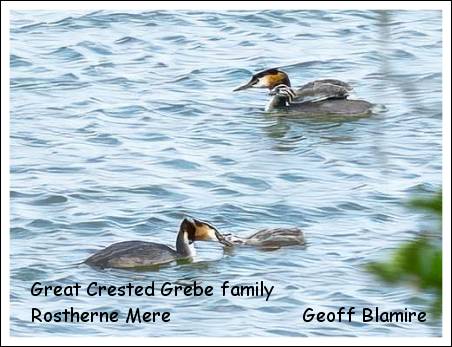 Recently fledged young were around their nests – lovely to see.
Recently fledged young were around their nests – lovely to see.Yesterday morning we walked to Rostherne. No one had been in the obs for 2 days – it was dead! Below the obs just 2 Great Tits, 1 Blue Tit, 1 Robin and 1 Blackbird all the time we were there. But a Great Crested Grebe family kept us amused. 1 of the chicks spent most of the time on the female’s back. The 2nd chick tried to get on her back as well but no room – or was it because its sibling wouldn't let it get on?" ..............
We had a little more success at Rostherne on Monday morning (11/8) when Jude, Wendy and I met up in the reserve's obs. Quiet at first - Chiffchaff in song, one Little Egret and a Great Spotted Woodpecker but then Jude found a Spotted Flycatcher in a dead alder, below and to the right of the obs. It showed really well, perching on one of the upper branches, taking passing insects, then returning to the same place. Great views through the big binocs. We thought there may have been a second bird and there was! Wendy located it in the lower branches of the famous "split lime", both were in view simultaneously.
Returning to the Natural England car park I met ringer Malcolm Calvert who'd been in Shaw Green Willows with John Adshead. They'd ringed over 100 birds during a busy morning, a fact confirmed by John on the Rostherne "WhatsApp" group......."A very busy ringing session in Shaw Green this morning. Big numbers of juv Reed Warbler, Chiffchaff and Blue Tits. This nice juv Willow Warbler amongst them. Two Tree Pipits came to the net ride briefly but avoided capture. Green Woodpecker still around. ".........
We're currently enduring the fourth heat wave of the year (three consecutive days with a temperature greater than 25⁰C) . It's 28⁰C at the moment and it's not yet noon, although there's a little more wind today.
Late news this morning from Karina, our KOS Secretary ........."one beautiful Red Kite flying over the garden. Just now. Heading lazily south east.
I looked up while hanging out the washing! "........
Well done, Karina. It's a good drying day!!
5th August 2025 ...... Tony Ellis.
I'm afraid that this update begins with some sad news.
Sadly, Tony Ellis, a member of KOS for 22 yrs, has recently passed away. He was a committee member from 2007-2024
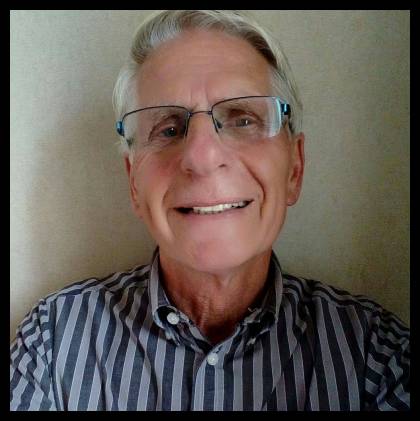 and Lectures Officer from 2009 until 2015.
and Lectures Officer from 2009 until 2015.Apart from being a keen birdwatcher, Tony was active in many local societies and will be missed by all of us.
I first knew Tony through Round Table and every now and again he used to encourage me to join KOS. I will be forever thankful to him for doing so.
Our heartfelt condolences go to Hilary and all his family at this difficult time.
Karina.
Thank you, Karina, sad news indeed. Tony was an enthusiastic birder and a well-respected member of the KOS. He was a great companion on our field trips and will be sadly missed by all.
Geoff and Sheila Blamire were out and about again last week visiting Millington and Rostherne on their travels ........." Millington and Mere Monday 28 July: Grey Wagtail on the outlet of Little Mere; Peacock Lane Yellowhammer and pair of Red-legged Partridges; Moss Farm 20+ House Martins and 13 Swallows; Moss Lane 3 juvenile Pied Wagtails on the mound of soil where Yellow Wagtails were last Friday; the field of barley on the corner of Peacock Lane and Moss Lane has just been harvested and the spilt grain attracted Yellowhammer (plus song), Linnets, Chaffinches, 20+ House Sparrows and family of Pheasants including 4+ very young (never seen such young Pheasants before)
Rostherne Tuesday 29 July: the busiest for ages! Not the mere (just the ‘usual’ Little Egrets, Common Terns, Mute Swans, Grey Herons, Buzzards) but
 the area below the Obs was alive with birds – 3+ Blackcaps feeding on blackberries and elderberries (including a juvenile developing into a male), 2 Chiffchaffs flitting around, female Bullfinch, etc, etc. Song Thrush was singing most of the time we were there (c45mins). The Merlin app surpassed itself – used to it coming up with Common Redstart (usually Chiffchaff) but a Yellow-legged Gull?!!!!
"..........
the area below the Obs was alive with birds – 3+ Blackcaps feeding on blackberries and elderberries (including a juvenile developing into a male), 2 Chiffchaffs flitting around, female Bullfinch, etc, etc. Song Thrush was singing most of the time we were there (c45mins). The Merlin app surpassed itself – used to it coming up with Common Redstart (usually Chiffchaff) but a Yellow-legged Gull?!!!!
"..........The "Merlin" app. is really useful but tends to make mistakes from time to time, so treat its results with caution!
Yesterday (4/8) Jude Halman and I spent a few hours in the Rostherne obs. hoping that the arrival of storm "Floris" might provide some interesting records .........."An eventful morning for me and Jude in the Rostherne obs. With a named storm, "Floris", passing through we thought that perhaps some vagrants from the coast may have been blown in on the promised 60mph winds. As it was though the weather was quite benign; a temperature of 19°C with occasional rain and drizzle as Floris came and went.
The area in front of the obs was sheltered from the worst of the wind and rain and was very busy with small birds. Blackbirds, a single Goldfinch, two Bullfinches, Great Tits and a small army of young Blue Tits were enjoying the sunflower chips on the bird table but they all scarpered when a male Sparrowhawk flew in and perched for about 20 seconds on the table, right in front of us, just a few feet away. Incredible views!
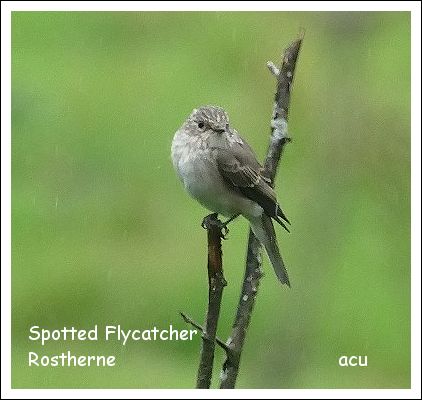 The elderberry bushes were attracting a range of species, especially Blackcaps. One bird wasn't interested in the berries though - a Spotted Flycatcher, my first of the year! It spent the whole morning with us giving excellent views as it sallied forth from prominent twigs to ambush passing insects. I even managed a record shot!
The elderberry bushes were attracting a range of species, especially Blackcaps. One bird wasn't interested in the berries though - a Spotted Flycatcher, my first of the year! It spent the whole morning with us giving excellent views as it sallied forth from prominent twigs to ambush passing insects. I even managed a record shot! So a routine morning was proving to be very interesting, even more so when a female (or perhaps an immature) Marsh Harrier appeared, floating gracefully over the reedbeds. It was bordering on exciting - not something we're used to at Rostherne!"..........
Derek Pike's astute observation (see last update) that our Swifts are already on the move, back to Africa was correct. I saw a substantial flock over one of the fields behind the car park at Rostherne last Monday (28/7) Bob Groom later estimated that there were more than 100 birds in total preparing to move on ..........." Yesterday I checked around and the local birds had obviously gone but meeting Tony at the Observatory he told me that he'd seen a lot of migrating Swifts over the sprout fields on the way in. I checked on the way home and they were still there, well over 100, possibly my last big party of the year. Good to see but a reminder of how brief their stay here is, barely 3 months.."..........
In France the Swift is known as the 100 day bird. Quite appropriate!
Bob and I missed the Lesser Spotted Woodpecker ringed by John Adshead earlier in the day, nor was there any sign of the Hobby he'd seen at first light!
We did, though, count 9 Common Terns perched on the weather buoy, from where they flew from time to time do a spot of fishing.
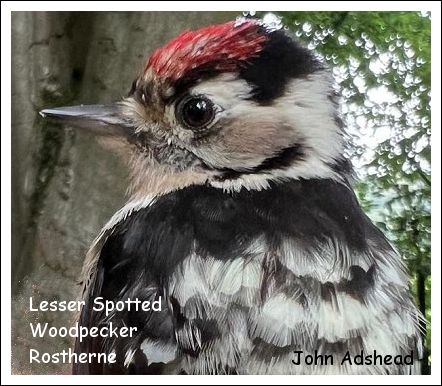
Park ranger, Darren Morris reports Common Terns on Tatton Mere. As well as a couple of other intriguing records! ............." 5 common terns at Tatton today too.
A colleague is adamant he saw a marsh tit in Dog Wood on Monday and last week another described a lesser spotted woodpecker in there also."............
On Saturday (2/8) I had a walk down to the Fox Harbour area of Mobberley, as far as the Sand Martin Colony......."18°C this morning, ideal conditions for a walk down the Fox Harbour before the predicted rain tomorrow and a "named" storm on Monday. I went past the Roebuck and down to Gleavehouse Pool that way, rather than through the maize tunnel that I'd been warned about.
Very quiet to start with, just a couple of calling Ravens and a Linnet in full song. The water level at the pool is very low and the cattle have been given access, so the margins have been churned up; ideal for Green Sandpipers. The moth posed nicely for my camera and later, when I had downloaded the images, the Google "Lens" app. identified it as a Yellow Shell Moth. I posted it on the "Cheshire Moths" facebook group and they kindly confirmed the ID.
A few Swallows and Sand Martins over the pool but no real activity at the Sand Martin colony, a few bird overhead but none were visiting the nest holes. Re-tracing my steps I met a couple who had just navigated the maize field so I gave it a go. It wasn't too bad, It's well over six feet high but you can still see the path; a Yellow Wagtail was calling so, they may have had second broods. Approaching the end of the track leading to Mill Lane
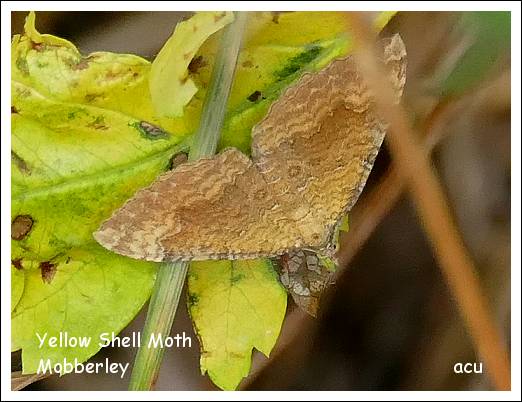 a Partridge ran past me on the other side of the hedge, there was a nice gap so I was able to track the bird, it was a juvenile Grey Partridge that crouched down and froze as I approached, before flying off towards Grimsditch Farm. I didn't have time to find it in the viewfinder, I just pointed the camera in the general direction and pressed the shutter. Luckily on of the shots caught it in flight for a record shot. It's the first Grey Partridge I've seen in Mobberley for many years. Phil Ashley has had a family party in that area, so no doubt it was one of those."..........
a Partridge ran past me on the other side of the hedge, there was a nice gap so I was able to track the bird, it was a juvenile Grey Partridge that crouched down and froze as I approached, before flying off towards Grimsditch Farm. I didn't have time to find it in the viewfinder, I just pointed the camera in the general direction and pressed the shutter. Luckily on of the shots caught it in flight for a record shot. It's the first Grey Partridge I've seen in Mobberley for many years. Phil Ashley has had a family party in that area, so no doubt it was one of those."..........Our KOS Secretary, Karina, has just returned from a trip up to Scotland .........."We were away in Scotland last week and stayed in a house with 8 House Martin nests in the eves. I had the novel experience of seeing juveniles ‘fledge’ then alight very, very momentarily on a branch of a next door tree (a large, semi-dead Ash) before flying off and returning to the nest. Such chatter too! A family of Siskin were much in evidence in the same tree. This house was surrounded by fields with fox, hare and Roe deer in abundance. Magical."............
Simon and Lyn also travelled north but not quite so far ......"We were up in Silverdale on Saturday, to explore the butterflies of Arnside Knott on a walk that was organised by Butterfly Conservation, who are a group of very enthusiastic & knowledgeable naturalists. The Knott is a 500ft high hill of limestone outcrops, mixed woodland & wildflower meadows with an amazing panoramic view over Morecombe Bay. It's managed for nature by the National Trust.
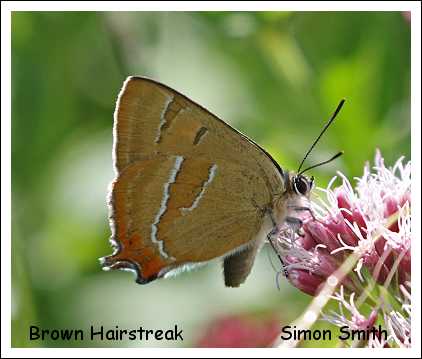
We saw plenty of butterflies, including 4 new species (for us), the best of which was the Brown Hairstreak (pictures attached). We dropped in at RSPB Leighton Moss on the way, but there was very little to see there at this time of year."..........
Last but by no means least, I've had a request from a young lady studying for her master's degree at Liverpool University ......." Good Afternoon, I am a current Masters student at the University of Liverpool Studying Environmental Assessment and Management. I am undertaking my Dissertation on the health benefits of green spaces and how benefits may differ with demographic characteristics using a survey that uses self-reported health measures wherein I aim to attain around 100 responses.
The survey will take approximately 10 minutes to complete. I am passionate about the mental, physical and social health benefits of green space. I was wondering if there is anyone in your group you would be able to send this survey out to?
The link to my survey is here: https://docs.google.com/forms/d/e/1FAIpQLSemY8g82ve0Ss-dkAcOepRTTVrJmlDtn00IpTFK7dFtZgDtKw/viewform?usp=header
Thanks very much for any help you can give me.
Elizabeth Kemp".....
I've completed the survey, it's anonymous and will only take a few minutes to complete. One of the locations used is Tatton Park so no excuses!
27th July 2025 ......... Neumann's Flash.
 |
A good turnout on Friday (25/7) as 15 members gathered at Northwich's Neumann's Flash for our third and final summer evening walk. The last get-together before a short mid-Summer break and the resumption of activities on the 7th of September, with a field trip to the Dee Estuary followed by the first indoor lecture on the 26th September. Amongst the participants we welcomed a new member, John Barber, who has finally joined us after much cajoling by me, Roger Barnes and Darren Morris!
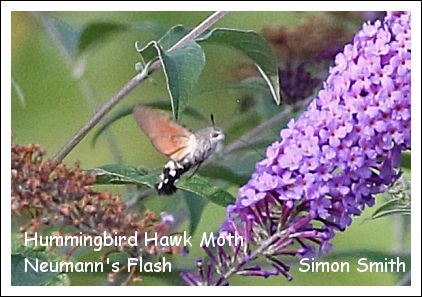 Trip leader, Sheila Blamire, led us first along the track towards the "Scrapyard hide" (it probably has an official designation), along the way we picked up the first entries on the trip list with Woodpigeon, Jackdaw, Chiffchaff, Long-tailed Tit, Swallow, House Martin and a male Bullfinch that had just emerged from a bathing session and was looking decidedly disheveled.
Trip leader, Sheila Blamire, led us first along the track towards the "Scrapyard hide" (it probably has an official designation), along the way we picked up the first entries on the trip list with Woodpigeon, Jackdaw, Chiffchaff, Long-tailed Tit, Swallow, House Martin and a male Bullfinch that had just emerged from a bathing session and was looking decidedly disheveled.The most interesting sight wasn't a bird though, it was a Hummingbird Hawk Moth feeding on a buddleia growing through the brambles that line the path. It was a fair distance away so Simon did well to get the record shot reproduced here. I must confess that I've never seen one before.
Good views from the hide right across Neumann's; a range of waterfowl and a few waders were on offer including Coot, Moorhen, Gadwall, Mallard, Shelduck, Mute Swan, Water Rail and four Goosanders that circled the flash before coming in and landing in the centre. Some of the Canada Geese had completed their post-breeding moult and were on the wing again. A much maligned species that has been the society's emblem for over 50 years, featuring on our official stationary and membership cards. There have been moves in the past to change it to something more "appropriate", whatever that means!
Moving on around the far side of the flash we reached the path to Dairy house Meadows but Sheila and Geoff had done a recce in the week preceding out visit and found the Barn Owl box
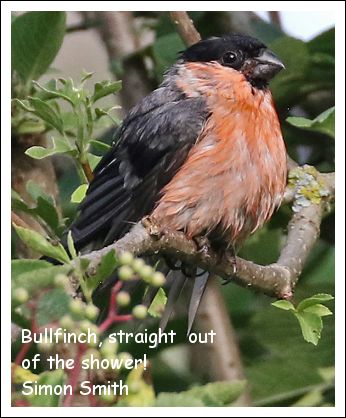 wasn't visible from the path so we gave it a miss this year, turned left and continued over Butterfinch bridge to the large hide on the west side of the flash. Few "new" species from there, so it was onward to the bund that separates Neumann's and Ashton's flashes. A substantial new bench seat has been installed overlooking Ashton's, replacing an older one that was falling to pieces. The flash had completely dried out, so no wildfowl but we did count 35 Curlews preparing for their roost. The view from Pod's Hide was obstructed but from the path down we enjoyed good views of Little Egret, Grey Heron, Lapwing and two Avocets. Arriving back at the start, in the layby on Warrington Road, we'd walked about 4Km and recorded 42 different species, just one short of last year's total. Out thanks go to Sheila for leading the trip and carrying out an earlier recce (with Geoff of course!!)
wasn't visible from the path so we gave it a miss this year, turned left and continued over Butterfinch bridge to the large hide on the west side of the flash. Few "new" species from there, so it was onward to the bund that separates Neumann's and Ashton's flashes. A substantial new bench seat has been installed overlooking Ashton's, replacing an older one that was falling to pieces. The flash had completely dried out, so no wildfowl but we did count 35 Curlews preparing for their roost. The view from Pod's Hide was obstructed but from the path down we enjoyed good views of Little Egret, Grey Heron, Lapwing and two Avocets. Arriving back at the start, in the layby on Warrington Road, we'd walked about 4Km and recorded 42 different species, just one short of last year's total. Out thanks go to Sheila for leading the trip and carrying out an earlier recce (with Geoff of course!!)The Blamires were out and about on their daily walk last Friday (18/7) returning home to another butterfly extravaganza on their buddleias ......."We walked to Rostherne area this morning and most notable was 2 Ravens making a real racket along Rostherne Lane and 1 flew out of Harper’s Bank Wood. There were so many different vocalisations – reminded me when we went to Newborough Forest on Anglesey with KOS where 100s of (mostly) juvenile Ravens gather in the autumn for the winter to socialise and meet their future partners! Never heard so many different calls from Ravens.
From the Obs: 3 Little Egrets, 3 Buzzards, 2 Grey Herons, 3 Mute Swans, just 1 Swallow, male Blackcap in song plus female Blackcap eating one blackberry but it wasn't ripe enough, Chiffchaffs, etc.
Butterfly count this afternoon mainly on just 2 Buddleias (close together): 10 Large Whites, 9 Peacocks, 6 Red Admirals, 2 Commas, 1 Painted Lady, 1 Small Tortoiseshell plus 2 gatekeepers. "........
The Tatton Park rangers carry out butterfly surveys every year and, as I think we've all found, 2025 is a good one. This from Darren Morris, one of the team in the park ......." We continued again this week with our weekly butterfly transect walk. We have been taking part in this for quite a few years and all the information is sent to Butterfly Conservation. This year numbers have thankfully been very impressive compared to last year. We have also found a good haunt for purple hairstreaks.
During the survey it was pleasing to see three juvenile yellow wagtails on the border between the deer sanctuary and the tenant farmer’s potato crop.
On a side note...... Ring-necked Parakeets at Manor Crescent!"........ Thanks Darren!
Common Terns are passing through (and lingering) in our area at the moment. Jude Halman and I had excellent views of the species at Rostherne on Monday (21/7) ......."The water of the mere had a faint greenish tinge this morning and algae was building up enough for it to be readily seen close to the boathouse reedbed. Small fish were seen on one occasion leaping from the water
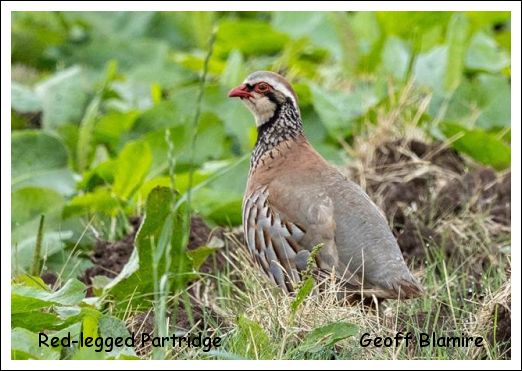 and it was these that were attracting the attention of four Common Terns that were actively fishing for most of the time Jude and I were in the obs. They spent time in-between fishing on the weather buoy or on dead mereside branches. We counted at least 62 Great Crested Grebes and three Little Egrets. Two Swallows passed quickly through, heading south and two foxes appeared, giving good views as they explored the reedbed in front of Harper's Bank.".......
and it was these that were attracting the attention of four Common Terns that were actively fishing for most of the time Jude and I were in the obs. They spent time in-between fishing on the weather buoy or on dead mereside branches. We counted at least 62 Great Crested Grebes and three Little Egrets. Two Swallows passed quickly through, heading south and two foxes appeared, giving good views as they explored the reedbed in front of Harper's Bank.".......Tern numbers had increased to eight the following afternoon. This from G&S .........." Tuesday 22 July at Rostherne: only 1 Common Tern when we were there but later this afternoon there were at least 8 terns including 1 juv being fed, lots of displaying and courting. Also we saw 5 Little Egrets. 4 Mute Swans, 7 Grey Herons, etc.
Monday 21 July around Millington area: Peacock Lane family of 3 Linnets and 1 male Yellowhammer – song from both species. Field opposite I was alerted by the distinctive call of a Red-legged Partridge (see Geoff’s photo). Hoping to see youngsters because we saw a pair back in April but we haven’t see them again, but it was difficult to see anything because of the height of the vegetation. Moss Lane pair of Yellowhammers including song, Buzzard flew over. New insects for us were Greenbottle flies Lucilia Caesar (as opposed to bluebottle!).
Sunday 20 July around Holford and Plumley: on 22nd June I wrote “…… a pair of Shelducks with their 5 chicks on a very small reservoir (assuming the water is used for the brine works when needed). Surrounded by a fence so its fox-predator safe!” I was wrong!!! We saw the adults with 6 well-grown chicks – of course they can't leave the reservoir until they fledge. "............
Derek Pike suspects that our Swallows may be planning to move south earlier this year .........." Yesterday morning we saw about 20-30 Swallows sitting on the wires in Lower Peover, we thought it a bit early. In recent weeks the pupils of the Academy, with the weather being warm, have sat on the rugby field eating their lunch with about twenty gulls circling above, as soon has the bell goes and the pupils go back in the school gulls swoop on the litter left behind. Yesterday gulls all circling and screeching because no kids (holidays), no food plus caretaker goes round playing field collecting all rubbish up that the little darlings have left behind, saves the crisp bags etc blowing in our garden ".............. Perhaps the Swallows know something that we don't, Derek!
Back in his Lilac Avenue garden, Derek observed what could be some early visible migration, this time from Swifts ......." After lunch, at about 1pm, I decided to sit in the garden and read, sleep and watch for Swifts or anything else passing over. No sooner had I got my chair in position than I heard screaming above me - I looked up and there were a minimum of 30 Swifts flying in a northerly direction, they never came around again although the three “local” Swifts which have been circling round all Summer have given a flypast or two in the last hour.
Could I have seen a group getting ready to migrate? "
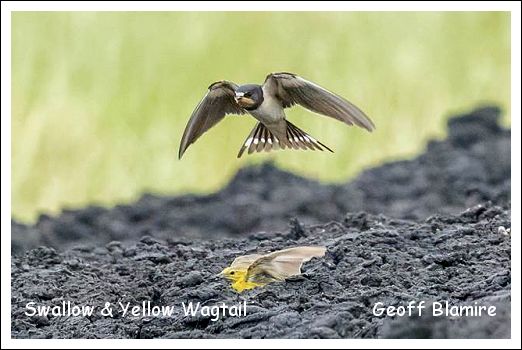 .......... I think it's a bit early, even for Swifts, Derek. It will be another month before the majority have left, although in years gone by we have seen substantial numbers as late as mid-September.
.......... I think it's a bit early, even for Swifts, Derek. It will be another month before the majority have left, although in years gone by we have seen substantial numbers as late as mid-September.Phil Ashley tells me that last week he watched a Hobby hawking for dragonflies in the Fox harbour area of Mobberley on Thursday (24/7). This is location we visited on our evening walk in June. I went down later in the day but had no luck.
Wendy Stratford, now back from a busy period of weddings, holidays and family visits, found time for a walk down to Fox Harbour earlier today (27/7) ..........." Managed to walk to the pool today - pleasantly cool but bright. 10 swallows chasing and calling by the barn. The maize fields (these are only ones not harvested) are very high, and the one across the skylark field like a tunnel! Pool had 33 greylags and 20 canadas, all spread around the dried out rim. One sand martin overhead. At the sand martin cliff 10 birds were flying, and a buzzard high overhead. Coming back through the sweetcorn tunnel I heard a yellow wagtail nearby. She landed on a "spear" at the top of a plant near me - great view!
Otherwise just hundreds of corvids and pigeons - literally! ".............
Geoff and Sheila had Yellow Wagtails on Wednesday (23/7)......"This morning we did one of our Millington area walks. Along Peacock Lane the "usual" male Yellowhammer and Linnet, further along over Moss Farm c35 Starlings and 30+ House Martins but then, on a mound of soil, was a pair of Yellow Wagtails catching flies! We’ve never seen or heard them there so probably just passing through. Then c8 Swallows arrived and proceeded to dive-bomb them – rather think was just for "fun"!"........
Species recorded on the evening walk around Neumann's Flash - Friday 25 July 2025. |
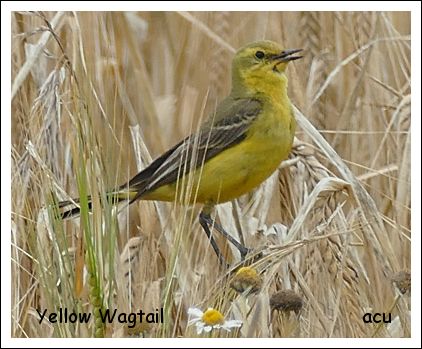 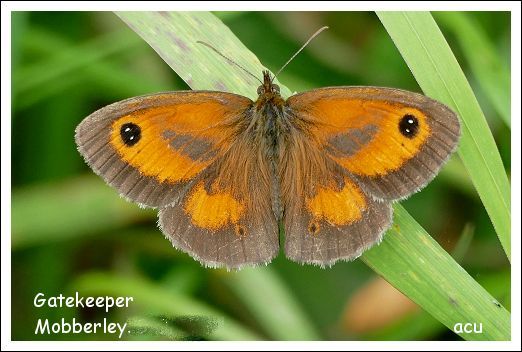 |
The third official heat wave of the year peaked at 31.4⁰ on Saturday afternoon (12/7), too hot for me but our butterflies seem to be finding this Summer's weather to their liking. Geoff and Sheila Blamire are finding a good selection in their garden in Mere......"Sunday (Holford and Plumley) and Monday (Mere and Millington) were Yellowhammer days. Sunday (6/7) had 2 singing Yellowhammers not in the usual places, but on Monday (7/7) had 2 singing Yellowhammers in the usual places, and Skylark.
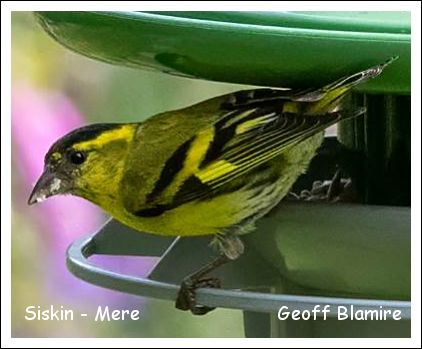
Tuesday (8/7) was Rostherne area morning. 2 Common Terns still on the mere. Ciceley Mill Lane the Mute Swans have lost their 3rd cygnet. Last year they lost 5 cygnets, this year 3 cygnets. Will they try again in 2026 – perhaps 3rd time lucky?
Tuesday afternoon in our back garden male Siskin is back – or probably around since 30 June just haven’t seen it.
Butterflies in the back garden in 5 minutes: 4 Red Admirals, 4 Peacocks, 4 Large White, 3 Commas, 1 Small Tortoiseshell and 1 Holly Blue. We’ll keep dead heading the buddleias to get continuous flowers ".............
Even more yesterday (16/7) on their return home from a morning stroll............"A good morning with a pair of Linnets on their ‘usual’ tree along Peacock Lane with a singing Yellowhammer. Also 10+ House Martins at Moss Farm. Even better was a pair of Yellowhammers along Moss Lane - the female carrying food for their young whilst the male was singing.
This afternoon literally dozens butterflies on the nearest 2 buddleias seen through the window, including 5-6 Peacocks, 4-5 Red Admirals, 2 Commas, 1+ Painted Lady, 10+ Large White Butterflies. No Small White Butterflies (strange), and no Holly Blues though they don't go onto buddleias.
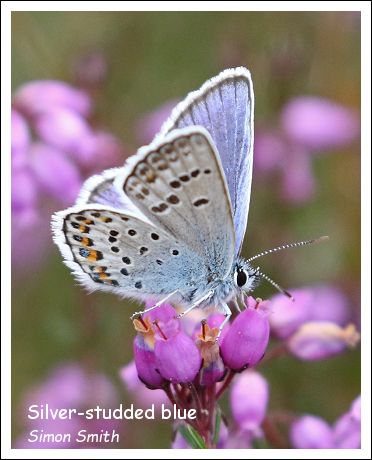 ".............
".............Continuing with the butterfly theme, Simon Smith and Lyn Graves headed to Shropshire again on Wednesday (9/7) and found a Silver-studded Blue.
........"We were back in north Shropshire yesterday and dropped in at Prees Heath Common, just south of Whitchurch, on the way.
Prees Heath is a one of the few locations outside the lowland heaths of the south coast where the Silver-studded Blue butterfly thrives (pictures attached). It’s looking like a good year for butterflies so far and that area of Shropshire seems particularly well blessed – we saw 12 species flying during the day."..........
Thanks Simon, a lovely image.
Last Wednesday (9/7) I ventured down to the south end of Mobberley hoping that the Quail was still about somewhere .........."22°C at noon as I set off to Gleavehouse Pool, not too warm although it went up to 25°C in the afternoon.
Three separate Yellow Wagtails in three different fields, all three calling loudly, one in the big field of maize was carrying food. The maize is now 6' high and obstructing the footpath in places. No Quail, the field of spring barley where I heard it has been harvested.
Two Shelduck and a single Oystercatcher at the pool plus lots of Black-headed Gulls, including some birds of the year. Overhead Sand Martins, Buzzard, Linnets and hoards of Jackdaws and Carrion Crows that were hoovering up the spilt grain lying in the barley fields.
I met David Simcock, the farmer who owns the land. He was placing brightly coloured tubing on the top of barley straw that has been wrapped in black plastic
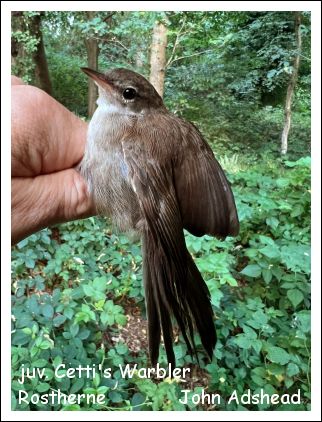 and will be used as cattle feed during the winter months. He's heard that rats and birds think the tubes are snakes and steer clear. I don't think he's convinced it will work!".........
and will be used as cattle feed during the winter months. He's heard that rats and birds think the tubes are snakes and steer clear. I don't think he's convinced it will work!".........An overdue visit yesterday morning to Rostherne after ringer John Adshead reported two Hobbies over the mere early in the day ........."18°C this morning when I joined Jude in the obs, a few cumulus clouds but very pleasant after the recent hot spell.
The two Hobbies seen earlier by John Adshead didn't re-appear during the time we were there.
We suspected that there were four Little Egrets and eventually all four were on view at the same time, scattered around the mere.
A Common Sandpiper flew in and landed on the "crocodile" log, just below Gale Bog, it was in view for a few minutes so we managed some reasonable views through the big binocs set on X40.
Juvenile Blackcaps and Chiffchaffs in front of the obs. ".........
Bill Bellamy's latest Rostherne report, this one covering April to June 2025, has been circulated to all members. It contains some beautiful images - you can read it here
John Adshead's very early morning image of the mere shows just how early he starts ringing operations at Rostherne. He's suitably rewarded and provides many interesting records for the reserve. The juvenile Cetti's Warbler pictured in this update was ringed yesterday morning (16/7).
Derek and Jean had an interesting visitor earlier this week ..........." This morning, before breakfast at about 7.30am, I opened our patio door full width
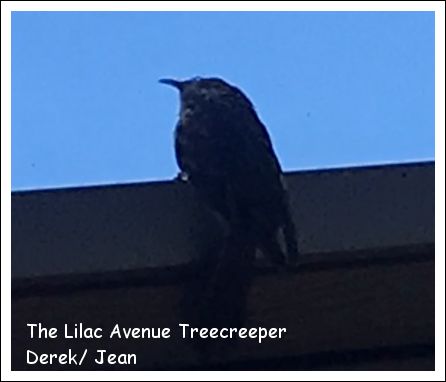 and then went into kitchen to prepare for breakfast. After breakfast we went back into the main room to find bird
and then went into kitchen to prepare for breakfast. After breakfast we went back into the main room to find bird We very rarely get Treecreeper in the garden never mind in the house.
The good news is I got a photo on my iphone12 and on the iphone6. The bad news is we could not down load the photo onto our computer. Hence no attachment! "...........
I can report that Derek wasn't going to be defeated by technology and was, eventually, able to send me an image of the bird!
Thanks Derek, I wish other KOS members would also send me more reports - it would make my job a lot easier!
Living so close to Manchester airport we are all very aware of noise issues, especially during periods of hot weather - keep the bedroom windows open - too noisy : keep them closed - too hot. You just can't win! Anyway members may be interested in this site https://eu.webtrak.aero/man2. It measures the noise at various points around the airport and displays them in real-time or you can backtrack to earlier flights. The noise level is measured in decibels. Being a logarithmic unit an increase of 3dB is a doubling of perceived noise.
Our third and final summer evening walk will take place a week tomorrow - Friday 25th July when we'll be visiting Neumann's and Ashton's Flashes. Meeting at 6:30pm in the usual layby on the B5075. Our leader for this trip will be Sheila Blamire - please let her know if you're coming along. Sheila@onlybirding.com
6th July 2025 .......... Whixall Moss
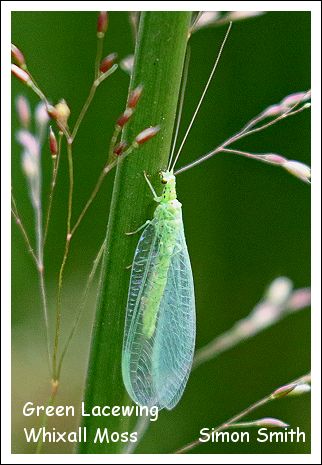 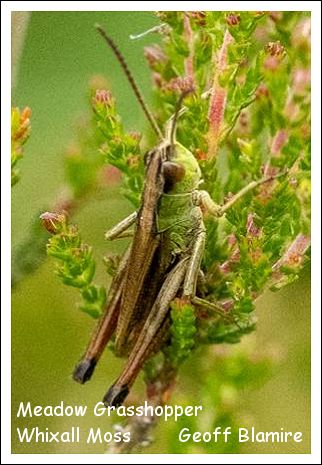 |
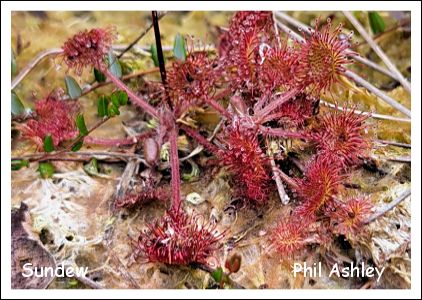 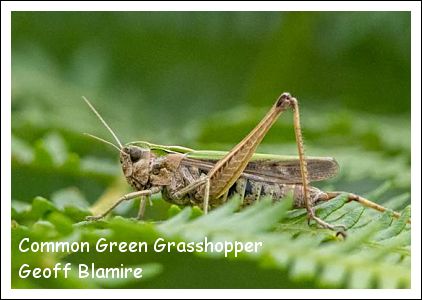 |
Shropshire Wildlife Trust, Natural England and Natural Resources Wales have restored 665ha of the Marches Mosses and their
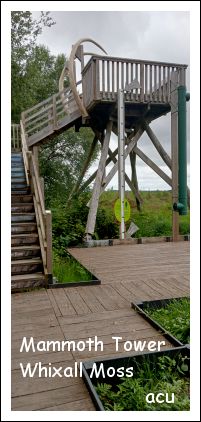 edge habitat to transition them towards healthy functioning eco-systems again.
edge habitat to transition them towards healthy functioning eco-systems again.Six well-maintained and signposted trails criss-cross the mosses, nevertheless there's plenty of scope for confusion for first time visitors. Luckily our trip leader for the day, Phil Ashley, together with Jude Halman and Karina Stanley had carried out recces beforehand, so we were in safe hands!
A party of 14 members gathered at Whixall Marina, where appropriate "facilities" are available, before moving on to the Morris Bridge car park, on the edge of Whixall Moss.
Walking back from the car park, over the Llanngollen canal via the interesting lift bridge, Phil led us to the Charles Sinker bird hide, with views across a small pool and surrounding vegetation. A family of Moorhens were the pool's only occupants but there was still some late song from Reed Bunting, Sedge Warbler, Reed Warbler, Song Thrush and Willow Warbler. Overhead Swallow, Linnet and a Buzzard whilst just across the road, on a smaller pond, three Green Sandpipers that showed briefly before leaving, flashing back and white, like three oversized House Martins.
Back over the bridge and on to Whixall Moss we took the red route for a short distance, picking up Dunnock, Wren and Blackcap for a rapidly expanding day list as we progressed. Taking a short detour to a vantage point overlooking an open area of the moss those at the front of the party had views of three Hobbies, the first of our target species.
Moving on to the green route for a short stretch, one of the small pools that are dotted across the moss held both Mallard and Shoveler, in their drab eclipse plumage. A right turn took us onto the purple route from where we had Red Kite, Stonechat and a female Marsh Harrier that was perched in a low bush, showing well through Sheila's hurriedly set up 'scope.
Further along the purple trial we crossed seamlessly from England into Wales, a weather-beaten post marking the border. No barriers or border guards! Turning left we headed down another long path before reaching the section that runs alongside the canal as far as the
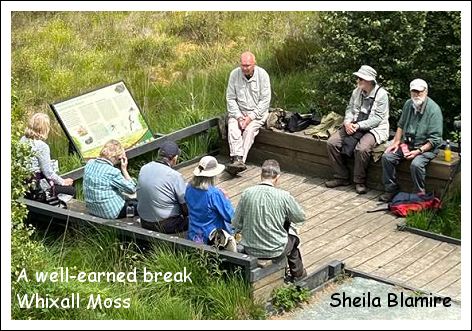 "Mammoth" viewing tower. This stretch proved quite productive and gave us Goldcrest, Coal Tit, Nuthatch and Marsh Tit, the second of our target species.
"Mammoth" viewing tower. This stretch proved quite productive and gave us Goldcrest, Coal Tit, Nuthatch and Marsh Tit, the second of our target species.A well-earned late lunch break was taken at the Mammoth Hide, with views from the top right across the mosses to the far side of Fenn's Moss, a distance of 1½ miles. Phil and Sheila, who were first up the tower, watched a Buzzard being mobbed by 2 Hobbies, then a short time after in the same area, Red Kite being mobbed by probably the same 2 Hobbies! Arriving back at the Morris Bridge car park, after a walk of 7Km, we'd recorded 55 different species; considering the time of year, a commendable effort! Our thanks go to trip leader, Phil and also Jude and Karina for their earlier reconnaissance trips.
I'm sure we'll be doing this trip again, it's a wonderful area for birds and other branches of natural history - beetles, bees, butterflies, moths, flies, grasshoppers, crickets, dragonflies, and lacewings etc. There's a lot out there, we're only scratching the surface - but we enjoy it and that's the main thing!
The week before the Whixall trip (29/6) Geoff and Sheila enjoyed a Sunday morning around the Plumley area, returning home to find an unusual visitor in their garden ..........." We did our "usual" walk around Plumley and Holford Sunday morning, starting at Cape of Good Hope Farm where we watched a Chiffchaff picking off insects along a small hedge, a Lapwing mobbing a Carrion Crow and Reed Bunting ‘belting’ out its song.
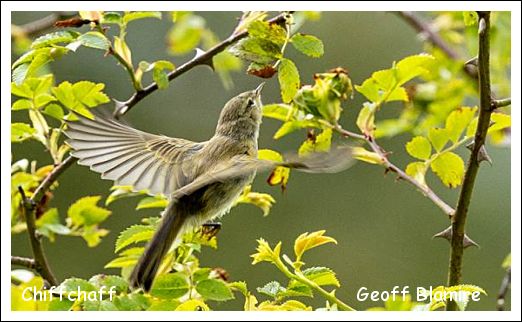
Near Inovyn offices we saw a weasel ‘dancing’ along a track; he wasn't aware of us but unfortunately he was going away from us. Where the footpath is overgrown lot of song from Whitethroat, Yellowhammer, Linnet and Goldfinch.
When we got home I was watching one of our juvenile Great Spotted Woodpeckers on one of our feeders, but then noticed another bird on the other feeder – a male SISKIN! At the end of June? In 2020 we suspected a pair of Siskins bred close by (had a pair and a juvenile in the garden). Perhaps again in 2025?! "............ (Great picture Geoff!)
The following morning (30/6) I set off with every intent to look for the Mobberley Quail, but found it a little too warm! ........."29.8°C today, the hottest so far this year. I set off to walk to GHP to check for the Quail but it was already too warm, so I just had a stroll around Mobberley SQ.
Friday's Reed Bunting was still in song, joined today by a Whitethroat and the ever present Chiffchaffs. The small pool at the far side was almost dry but it did contain a little bit of stagnant water, the muddy margin was covered in small flies that were attracting House Sparrows and a juvenile Yellow Wagtail. House Martins took advantage too but they never landed.".......
I was pleased to see the juvenile Yellow Wagtail, Phil Ashley had four juveniles at nearby Gleave House Farm but is worried about any second broods that may be situated in their favourite fields of spring barley.
We saw plenty of butterflies at Whixall on Saturday, it appears to be a good year for them. Derek Pike has good numbers in his back garden on Lilac Avenue ........." My next door neighbour has a large purple buddleia bush we have a smaller, more lilac buddleia bush, at the moment we have had at any one time 12 white butterflies 3 Red Admirals 2 Commas and 1 Small Tortoiseshell and several small butterflies to quick for us to identify, but we have not had any Peacocks.
Just under half a mile from our house is a field full of rape, on Tuesday there were at least 150- 200 white butterflies feeding on the field, it was quite spectacular to see. "........
A reminder, from Sheila, that the Big Butterfly count is coming up!
Butterfly count 18 July to 10 August – just takes 15 mins!!
The Top tips (below) are good and if you sign up for the count (free!) and you can download a Butterfly guide if you don't know all the common butterflies (and day-flying moths).
Citizen science!!!!
Species recorded on the field trip to Whixall Moss. 5th July 2025 |
Colin Butler and Jude Halman recently returned from their seven day expedition to Morocco. Colin has kindly sent me a full account of their adventures, written in his usual inimitable style!
Colin has also provided me with three links to slide presentations, in the form of Youtube videos, he's produced.
The Gambia 2024 - part #1 https://www.youtube.com/watch?v=_e3ommoN_0A
The Gambia 2024 - part #2 https://www.youtube.com/watch?v=TYXQYyliWAc
Great stuff! Thanks Colin
Meanwhile, closer to home, we're seeing subtle changes to our avifauna as we move past the longest day. Adult Cuckoos are starting to journey back to Africa and Green Sandpipers are
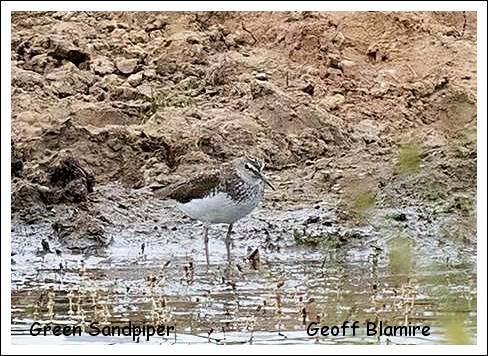 beginning to appear as they return from the north. We saw two on our recent trip to Humberside and, last Monday (23/6), Geoff and Sheila Blamire had one on their morning stroll here in Cheshire.
beginning to appear as they return from the north. We saw two on our recent trip to Humberside and, last Monday (23/6), Geoff and Sheila Blamire had one on their morning stroll here in Cheshire.........." Yesterday morning we did our usual around Plumley and Holford. Walked to Cape of Good Hope Farm and on the big pool there was a Green Sandpiper – first time seen there. Also several House Martins collecting mud (assuming to patch up their nests on Langford Farm) and a Grey Wagtail – all in a very small area. One time the wagtail attempted to chased off the martins! The other of note was a pair of Shelducks with their 5 chicks on a very small reservoir (assuming the water is used for the brine works when needed). Surrounded by a fence so its fox-predator safe! Never seen any Shelducks there. "..........
On the same morning Ken Davies and I spent a couple of hours at Rostherne Mere ......."15°C but it felt much colder with a strong westerly wind as I met up with Ken at the NE car park. The first job was to check for bees in the obs; just 5 dead ones and none flying. 71 Canada Geese that will, presumably, moult on the mere, as will the 33 Great Crested Grebes we counted. Overhead at least one House Martin, "many" Sand Martins and a handful of Swifts. Song from, Reed Warbler, Blackcap, Reed Bunting and Chiffchaff. Two Juvenile Great Spotted Woodpeckers gave good view in a dead tree, just to the right of the obs. A flock of, at least, 20 Long-tailed Tits filed past. Just before we left a Common Tern appeared, ranging widely over the mere and eventually landing on one of the white buoys, before being disturbed by a Lesser Black-backed Gull."........
Bob Groom followed in our footsteps, later in the day. He too found it rather cool!
.........."Phil and I weren't able to add many log entries to Tony and Ken's. He had seen an adult Mistle feeding a young bird on the church wall and I saw them when I left, also one of the juv Gt Spots feeding on the ground in the churchyard. It certainly felt very chilly in the ob. At least no bees. Driving back from Cicely Mill there was a young Fox in the road, looking as confused as a pheasant does. Fortunately car the other way was patient. Eventually it found its way through the hedge."..........
On Wednesday morning (25/6) I did a recce prior to Friday's planned evening walk ........"I did a recce this morning for Friday's KOS evening walk around the lesser-known parts of Mobberley. I have decided to change the route from last year as some of paths we have used in the past, when I checked, have become ill-defined with knee high grass - hard going for some (me especially!). Additionally the steep, narrow path down to the bridge over Pedley Brook has been used by cattle and has become very rough and very slippery
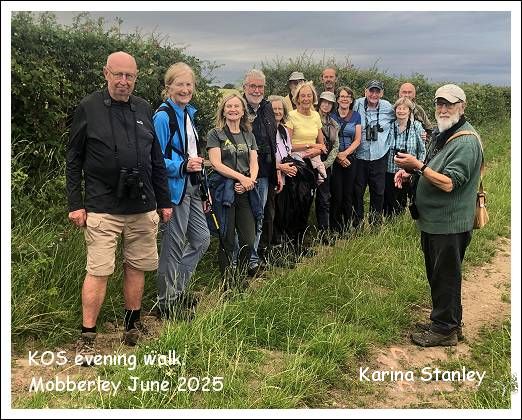 .
.So we'll take a longer route to Gleavehouse Pool - past the Roebuck and along Damson Lane. This morning there was still some song from Blackcaps, a Song Thrush, Chiffchaff and a late Willow Warbler. The path takes us alongside the field planted with wild flowers as part of a government initiative, I think its predominately wild radish with other stuff appearing.
As I joined the track leading down to GHP I was delighted to hear a Quail calling from the barley field, just the other side of the hedge. It continued sporadically for a few minutes before I moved on. Nothing on the pool and I was disappointed to find the Sand Martin colony deserted, although there were some birds still about. They definitely had young on the 6th June when I last visited, with youngsters at the nest holes waiting to be fed. As they have two broods each year I will be keeping an eye on the site.
Walking back I passed the quail site and it was still calling, I hope it stays until Friday evening!
Three Yellow Wagtails were feeding at the corner of another barley field as I approached Mill Lane. One adult male posed nicely on a sprig of hawthorn reaching up from the hedge but I'd left my camera at home to save weight!"..........
We had a good turnout on Friday (27/6) for the Mobberley walk with 15 of us setting off from Mill Lane, with high hopes of an encounter with Wednesday's Quail (I made no promises!!).
We didn't hear the Willow Warbler along Damson Lane but there was song from Chiffchaff, Blackbird, Wren, Chaffinch and a Goldfinch. Reaching the wildflower meadow we had our first encounter of the evening with a Yellow Wagtail, in amongst the wild radish. Unfortunately the Quail wasn't heard as we made our way down to Gleavehouse Pool, where we noted a Coot with one youngster, a single Shelduck and a Pied Wagtail whilst overhead Linnets, Lapwing and singing Skylarks. The Sand Martin colony was quiet but there were birds overhead and one or two birds were watched entering and leaving the nest holes. Walking back towards GHP a Red-legged Partridge called briefly; Phil Ashley works at Gleave House Farm and tells me both Red-legged and Grey Partridges successfully nested this year.
We returned to Mill Lane via Mobberley SQ and had a second encounter with Yellow Wagtails in the ripening field of Barley just before the SQ.
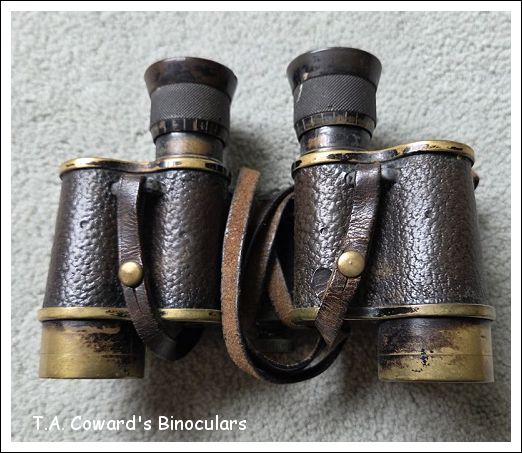
4.5Km, 23⁰C and 36 different species, which is about average for this annual walk. Just a pity that Quail didn't hang about!
I had an intriguing email this week from Rob David, who found us after reading the account of the visit Olwen and I made to Oxford University some years ago, where we were permitted to examine the field notes and correspondence of T.A. Coward http://www.10x50.com/coward/coward.htm. Rob's sister, Maggie, who lives in Canada, is down sizing and would like to present us with a family heirloom - a well-used pair of binoculars. These are no ordinary optics though, they belonged to none other than Thomas Alfred Coward! It's a long story but the provenance of the binoculars is beyond dispute!
Maggie will be coming to England in September and will bring the binoculars with her, so we need to find them a permanent home.
I suggested the observatory at Rostherne Mere would be very appropriate as Coward spent so much time there over the years. Additionally Maggie and Rob's mother, Joan David (nee Storey), who was an algologist and had studied at the Freshwater Biological Association (FBA) in Windermere during the war, had a part time role working for the Nature Conservancy at Rostherne Mere during the period May 1962 to November 1963. Her story and a photo of her at the mere is on page 51 of Tom and Giséle Wall's excellent book "Rostherne Mere. Aspects of a wetland nature reserve - wildlife, people and science through time".
It's been pointed out that there may be security issues (in this day and age). Although, as an item, the binoculars are worth only a few pounds, their value lies in who owned and used them originally.
Anyway that's the current situation if you have any suggestions as to a permanent home for them - let me know please! tony@10X50.com
No matter what, these binocs will be coming home!
This coming Saturday - 5th July it's our July field trip, this year to Whixall Moss NNR, Shropshire. We'll be meeting in the Whixall Marina car park (SY13 2QS) at 10:00am. Phil Ashley will be our leader for the day, so please let him know if you're coming along ash-lee@talktalk.net
Hobby and Marsh Tit will be our target species. Further details have been sent to all members.
Species recorded on the evening walk around the fields of Mobberley - Friday 27 June 2025. |
The three day field trip to Yorkshire and Lincolnshire on the 15,16 and 17th June was very successful. We enjoyed beautiful weather - dry, sunny and not too warm, we managed to (just) reach the species count we set ourselves!
The report is way too long for inclusion on this part of the website, so you can read it by clicking on the link below.
Prior to leaving for Humberside Geoff and Sheila Blamire were out and about again on their daily rambles.
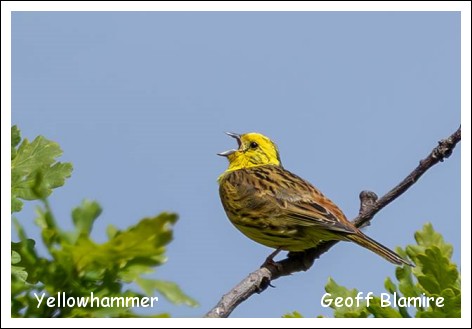
........."Yesterday (Wednesday 11/6) we did our ‘usual’ 12km walk around Mere and Millington. We’ve done this walk numerous times over the last 4-5 years (since Covid) but one thing sticks out – it’s a medium-sized tree on Peacock Lane. Almost without exception (depending on the season) there's a Yellowhammer perched on it and most of the time it’s singing (see the photo). Recently Linnets are sharing the tree as well, sometimes there are 2 Yellowhammers and 3 Linnets. Amazing.
Today(Thursday 12/6) we another 12km walk this time Mere and Rostherne. Because Cicely Mill Lane is still closed (even to pedestrians!) rather than diverting up Rostherne Lane we continued the long way around Cherry Tree Lane to Marsh Lane, across the sprout fields to the Obs. Haven’t been to Cherry Tree Lane for a long time – no Lapwings but had Skylark and Yellowhammer. So good that HS2 isn't going to destroy this countryside… "..........
On the same morning, KOS Secretary was over at Neumann's Flash indulging in a bit of voyeurism!
I went to Neumann's Flash early this morning. Avocet family all fine.
Watched a pair of blackcaps have a cuddle.
Both in full sight, facing me. On the same twig of a branch, about head height. He sang a quiet song.
He on the left. She on the right, tight up against his wing.
He crouching with his head and beak facing away from her. Head held lower than his body. She sitting upright, but nuzzled in.
Then she lowered her body and he jumped on.
Fun was had by all present!
Needless to sat G&S were on the road again the following morning.
............."Around Holford and Inovyn it was a feast of Linnets and Skylarks. We had 3 pairs of Linnets including 1 female carrying nesting material closely guarded by the male. We also had 2 singing Skylarks in 2 different maize fields, and in another field a pair of Skylarks repeatedly dropped down in one area with insects to feed the young and one time one flew up carrying a faecal sac and dropped it away from the nest! It is sometimes very difficult to confirm breeding with Skylarks. At the Cape of Good Hope Farm the pair of Oystercatchers were not very happy with us so we had to retreat. This year we haven’t seen where they are actually nesting. Several Whitethroats and Reed Buntings, usual Chiffchaffs and Blackcaps, many Goldfinches, House Martins going to their nests on Langford Farm, etc. Last Sunday we finished up with the singing Lesser Whitethroat and Red Kite – this time we just finished up getting very wet!!! Oh well….."...............
Next Friday evening (27/6) it's our June evening walk when we'll be exploring some of the lesser known parts of Mobberley.
6:30pm on Mill Lane, Mobberley WA16 7HX. I'll be leading this walk so if you're coming along please let me know - tony@10X50.com
Parking on that lane is at a premium so you may want to get there early and car share if possible.
12th June 2025........ Success for our Sand Martins
Geoff and Sheila Blamire had a close encounter of the bovine kind as they approached the end of their latest BBS survey last Monday (2/6)!
Yesterday we set our alarm for 5:40am to do our second visit of the Breeding Bird Survey. I’ve been doing this BBS for 27 years (first with Derek, then Geoff) – seemed much easier to get up that early 20 years ago! By June we would expect dozens of Starlings – none. The same with House Sparrows – just 2. Very few hirundines (except Moss Farm where 6-7 House Martin nests – best ever!). We used to get Lapwings, Yellowhammers, Linnets, pair of Spotted Flycatchers, even breeding Little Owl. Very few cereals grown now – mostly down to turf. Many gardens tidied up (ie sterile) or completely paved over. Etc. Oh well……
As we neared the last section our hearts sank – there were at less 60 young, very feisty cows. They gathered around the gate which we had to walk through to get into the field. The noise was tremendous. Neither of us fancied trying our luck. There was a footpath but between us and it there was a barbed fence, but Geoff found a section without barbed wire but it was rather high. Geoff managed to get over the fence – then it was my turn. I got one leg over but I ended up straddled over the fence. It was rather uncomfortable! With Geoff’s help I got my last leg over accompanied with some "screams" – it was very, very painful. The cows were still making a racket then we heard a man shouting. We walked down the footpath with the cows keeping pace with us (so pleased there was a hedge and fence between us!). The man (herdsman) succeeded to attract the cows and got them across the field and then into the next field. Phew……
On the same morning, I was exploring the airport tunnel - as far north as you can go in Mobberley......."This morning I paid my first visit of the year to the airport tunnel. Cheated a bit, as I parked on Woodend Lane,
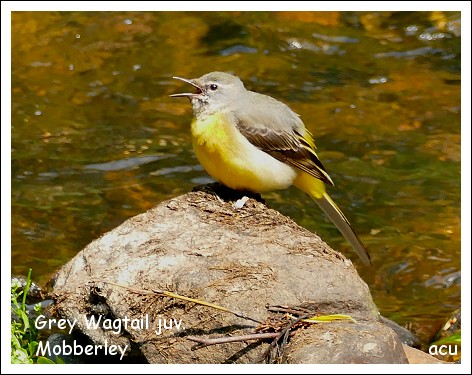 so only a short walk to the path alongside runway 2.
so only a short walk to the path alongside runway 2.Bird song has diminished considerably over the past week or so. Nevertheless I had Chiffchaff, Blackbird, Reed Bunting, Goldfinch, Whitethroat, Collared Dove, Stock Dove, Coal Tit and Blackcap.
I was hoping for Dipper and Grey Wagtails. No sign of Dippers, although a chap from Knutsford Probus Club, who was walking by with four other gentlemen of a certain age, said he'd just seen one. I was there over an hour but didn't come across one.
The Grey Wagtails were there though; a very active family party. I counted four in view at one time but they were very mobile and I suspect there were more.
I think I saw two Ringlet butterflies but couldn't get a picture of them. According to my book that would be very early so I must go down to Mobberley SQ where there were masses of them last year.".........
A week ago (5/6) I met up with Jude Halman in the obs. at Rostherne mere, we were hoping for a glimpse of the recently reported Hobby ........" Arrived, in the rain, at the same time as Jude. Visibility poor to begin with, then things improved and we could see Winter Hill quite clearly.
So
.jpg) good viewing for a time before it became quite misty with frequent showers. Driving back through Tatton it had obviously rained more than at Rostherne and the road was flooded in places. I missed the thunder and lightning that was reported when I arrived home. I must have been driving at the time.
good viewing for a time before it became quite misty with frequent showers. Driving back through Tatton it had obviously rained more than at Rostherne and the road was flooded in places. I missed the thunder and lightning that was reported when I arrived home. I must have been driving at the time.Highlight of the morning was a Cuckoo calling from the direction of Harper's Bank, followed by good views as it flew past the obs. Song from Blackcap, Cetti's Warbler, Reed Bunting and Song Thrush.
Seven Mandarins flew in and settled at the far side of the mere. We were amused by the antics of a juvenile Blue Tit that chased off a pair of Great Tits who arrived at the bird table. It wasn't quite as aggressive with the juvenile Great Spotted Woodpecker that turned up later!"...........
Jude has just returned from a trip to Morocco with fellow KOS member Colin Butler and friends. It was a great success and Colin is planning to return next year. I think he's busy at the moment but I'm hoping that he will be able to find time to write an account of their adventures for publication on this website.
Geoff and Sheila ran into one of the previously mentioned thunder storms later on Thursday (5/6) ........."We decided to delay our walk until this afternoon because the forecast was a little better. We left just after 2pm but caught in a tremendous downpour in Rostherne. We sheltered under a tree and looked with amazement as the rain came down – sheet of white water. We continued along Rostherne Lane as it eased and a Buzzard took to the air from its perch. We continued to the Obs at the same time as Bob. Similar birds to Jude and Tony except for the Cuckoo and I counted 8 Mandarins near Gale Bog. I picked up c20 Swallows and Sand Martins over the mere (no House Martins) and just a couple of Swifts were seen in the air. I also saw a Song Thrush with a beakful of worms and flew into the brambles below the Obs."...........
Last Friday (6/6) I walked down to the quieter, south end of Mobberley and was able to confirm that the Sand Martins have been successful this year ..........."Disappointing to start with this morning on a stroll down to Fox Harbour, but things became better as time went on.
Neither sight nor sound
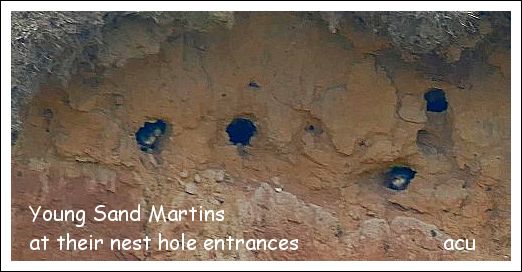 of Yellow Wagtails in their usual fields of barley on the track leading up from the top of Mill Lane. Quiet at Gleavehouse Pool too with no wildfowl, just the local Sand Martins and an overflying Oystercatcher.
of Yellow Wagtails in their usual fields of barley on the track leading up from the top of Mill Lane. Quiet at Gleavehouse Pool too with no wildfowl, just the local Sand Martins and an overflying Oystercatcher.Walking to the Sand Martin colony, big family parties of Blue and Great Tits, Lapwings seeing off marauding Carrion Crows (always a good sign) and, overhead, the usual skylarks.
Reaching the colony I was pleased to see plenty of activity with birds in and out of the nest holes and, in some cases, youngsters waiting at the entrance to the tunnels. So success for the Martins!
Returning along the same route I finally came across Yellow Wagtails; two birds on a dung heap, one flew purposefully across the barley before dropping down into the crop and out of sight. The second acted similarly but in a different direction (again a good sign) "..........
Two days ago (10/6) I did a recce of the route we'll be taking on Friday 27th June on our KOS June evening walk. On the pond - excavated and enlarged by the company housed in the new buildings that our route passes, close to the Rooney mansion, I was delighted to see a pair of Shelducks with two youngsters. So success for the species, despite the Gleavehouse birds failing.
I've only encountered one Lesser Whitethroat this year so far, so reports from G&S about their encounter with my favourite bird on Sunday encouraged me to pay a visit the following morning ( Our walk this morning took us to Holford and Plumley. We parked in our usual place and I got out I heard the rattle of a Lesser Whitethroat right by the car! The first of the year for us. We walked down towards Inovyn offices and always the bird was just in front of us. One time we stopped by a tree and it was singing so close to us, but still couldn't see it. The rest of the walk was tame in comparison) I hurried over the next morning, hoping it hadn't moved on.........."I went in search of the Lesser Whitethroat this morning after having my Covid jab. (the chap who did the deed asked what I was doing for the rest of the day. I told him I was going in search of a LWT; he seemed quite interested, as his wife was keen on birds. It turns out that she is Caroline Williams, who has won the Sand Martin Competition twice - so no need for a KOS business card!!)
Anyway no luck with the LWT but a good place to spend an hour looking and listening, especially the rough area beyond the Inovyn car park. Plenty of Common Whitethroats, Linnets, Goldfinches and Chiffchaffs. Swallows and House Martins at Langford Farm, overhead Buzzards and an Oystercatcher somewhere in the vicinity. "..........
Our three day trip over to Humberside starts this Sunday (15/6) and will include visits to Far Ings, Blacktoft Sands, North Cave Wetlands and Fairburn Ings. Far Ings and Blacktoft featured in a January addition of Countryfile and can be watched on TV (iplayer) it's episode 39 (2025) and I've also found it here. https://www.bbc.co.uk/iplayer/episode/m0028n30/countryfile-humber-estuary so you can view it on your computer.
Then on Friday 27th June it's the second of our Friday evening Summer walks. This time to the quiet side of Mobberley where you'll be able to see Gleavehouse Pool (and the famous GHP obs!), Yellow Wagtails (hopefully), the young Shelducks and High Lake Manor - the ancestral home of the Rooneys! I'll be leading this walk so let me know if you're coming along tony@10X50.com - Mill Lane Mobberley @ 6:30pm. Parking's at a premium so you might want to arrange car sharing and also get there early.
Geoff Blamire has sent me a link to the pictures he took on his and Sheila's recent trip to Dorset/New Forest/Salisbury Plain. You can see them here - cheers Geoff.
Last but certainly not least, Tatton ranger and KOS member Darren Morris has sent me a copy of their Summer edition of Tatton Wildlife News. Thanks Darren.
1st June 2025 ....... The Goyt - Goshawk and Morris Dancing.
Derek Pike and I set off early for the Goyt Valley on Friday (30/5) so that we could spend a few minutes at Cats Tor at the top of the road that runs from Rainow to the Goyt. Recent rain had cleared the atmosphere and from here we enjoyed great views across the Cheshire plain and beyond.
Visibility was so good that, through binoculars, we could make out cranes at Seaforth Docks, the Liverpool cathedral and, even further out, the Gwynt y Môr Wind Farm in the Irish Sea.
We began the trip list here and were able to enter Curlew,
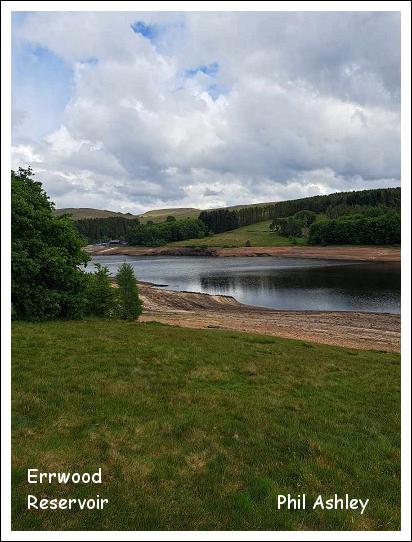 Buzzard, Meadow Pipit, Kestrel, Swift, Skylark, Lapwing and Buzzard. A good start.
Buzzard, Meadow Pipit, Kestrel, Swift, Skylark, Lapwing and Buzzard. A good start.Moving on we met up with our trip leader, KOS Secretary Karina, and 13 other members and friends; a good turnout considering so many of the usual stalwarts were away on holiday. It was nice to renew acquaintances with Alison Lee and Mark Eddowes, ex-KOS members, now living in Bonsall, Derbyshire who'd made the journey over to the Goyt to spend the evening with us. You'll perhaps remember their joint paper, published in 2021 in "British Birds" magazine concerning "wing clapping" by Nightjars. Quite appropriate as we were hoping to add this elusive species to the list at some point during the evening.
The evening was dry but humid and the local midges were out in force. Generous amounts of insect repellant were applied to exposed areas of skin before setting off along the road at the side of a very depleted Errwood Reservoir (see Phil's picture). Common Sandpipers and a Little Ringed Plover patrolled the extensive, muddy margins of the reservoir, whilst from the trees and bushes on the opposite side of the road we had Song Thrush, Blackcap, Garden Warbler, Willow Warbler, Chiffchaff, Robin, Redpoll and an overflying Siskin. Redstarts and Pied Flycatchers had been expected along this stretch of road but, on this occasion, we missed out, although they had been reported by others. Our route then took us down from the road, along a track leading to the River Goyt; recording Cuckoo and Goldcrest on the way before returning to the car park via the top path, overlooking the road, with views of the hills either side of the reservoir. Here a Tree Pipit watched warily as we passed, none too pleased with our presence, I suspect it had a nest nearby. Walking down to the car park the only Spotted Flycatcher of the evening was added to the list.
From the cars we walked down to the bridge, about 100 yards down the road. Here we had distant views of a Barn Owl quartering the fields at the opposite side of the reservoir and then, at 9:25pm - and right on schedule, the grunts and squeaks of a roding Woodcock as it flew overhead. In past years we have moved on from the bridge to an area back towards Rainow where we'd had Nightjars but forestry work has changed the topography and, more recently, we've had little
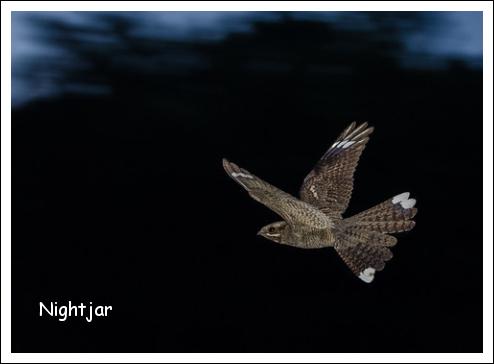 success. We decided to head for home along the valley road towards the Cat and Fiddle, stopping at an interesting looking area, identified by Phil Ashley, on the way - it was a good call, we had great views of four more roding Woodcocks. As it looked good for Nightjars and the light was fading fast, it was decided to put into practice a theory expounded by Bill Oddie some years ago on "Spring Watch". This postulates that Nightjars can be attracted by white handkerchiefs waved in the air, deceiving the birds into thinking that it's another bird straying into their territory. And so it was that Karina and the two Phils (Rowley and Ashley) skipped into the gloom waving their white hankies, like members of Mobberley's Ringheye Morris team!!
success. We decided to head for home along the valley road towards the Cat and Fiddle, stopping at an interesting looking area, identified by Phil Ashley, on the way - it was a good call, we had great views of four more roding Woodcocks. As it looked good for Nightjars and the light was fading fast, it was decided to put into practice a theory expounded by Bill Oddie some years ago on "Spring Watch". This postulates that Nightjars can be attracted by white handkerchiefs waved in the air, deceiving the birds into thinking that it's another bird straying into their territory. And so it was that Karina and the two Phils (Rowley and Ashley) skipped into the gloom waving their white hankies, like members of Mobberley's Ringheye Morris team!!I know it's difficult to believe but, almost immediately, two nightjars appeared about 100 yards away, flew parallel to us before vanishing into the conifers!
Did it work or was it just coincidence? Well we'll never know of course, but the whole episode will become part of KOS folklore and the story recounted for years to come!
The evening wasn't over though as, just as we returned to the cars, a massive barrel-chested Goshawk passed overhead, silhouetted against the last remnants of daylight. A memorable evening and our thanks go to Karina for acting as trip leader.
Last Saturday (24/5) Bob Groom headed over to Mobberley to have a look for our Yellow Wagtails, He wasn't disappointed ........."Nice to see the Swallows and House martins at Blackthorn Farm. Sparrowhawk, Buzzard and few Swifts over the fields, not to mention the lovely Skylarks singing their hearts out. Fortunately on the way back good views of Yellow Wagtails, including a brilliant male.. "........
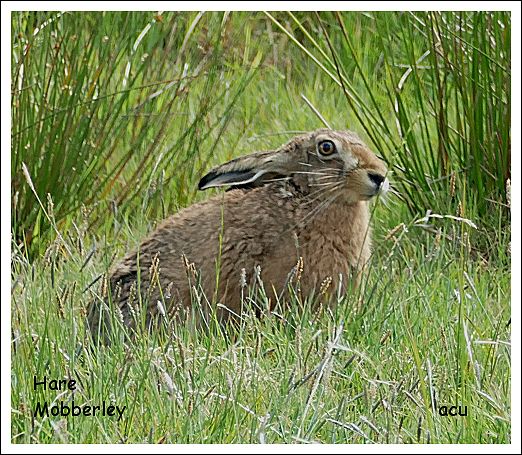 I followed in Bob's footsteps the following morning (25/5) ........."15°C this morning on a walk to Gleavehouse Pool. It felt a lot colder though, with a strong wind from the west.
I followed in Bob's footsteps the following morning (25/5) ........."15°C this morning on a walk to Gleavehouse Pool. It felt a lot colder though, with a strong wind from the west.Three Yellow Wagtails in view at the same time as I walked along the track from Mill Lane. Swifts and Swallows overhead, the latter are local birds.
Two Shovelers, a male and a female as I approached the pool, they were flying so I don't know where they came from, but an unusual species to see at this time of the year.
Two adult Shelducks at the pool but no sign of the youngster today. Two House Martins collecting mud from the margins and half a dozen local Sand Martins and two more Swifts that passed swiftly through! Two hares, including the one shown, close to the pool.
It started to rain and the wind picked up as I walked to the Sand Martin colony. A few birds visiting the holes from time to time so I'm guessing they're not feeding young yet. A Raven croaked in the distance."........
At about the same time Bob was over at Northwich Flashes ......... With recent reports of hobby I went over today but was out of luck, just plenty of Swifts and Buzzards. However on Ashton's Flash (almost dried up in the area near the Bund) I was amazed and delighted to see an Avocet with 4 small chicks! A red letter day indeed..."
Geoff and Sheila Blamire returned on Sunday from a week long trip to Dorset, The New Forest and Salisbury Plain........A great week with 119 birds. Most days had reasonably weather except for one day – of course it was the 3 hour Poole Harbour boat trip!.
Here are the highlights:
Great Bustards on Salisbury Plain (lost count how many we saw c20?) including full display from one of the males (see photos), females on nests and pair of Lapwings mobbing a male bustard. In front of the hide Corn Buntings and to one side Stone Curlews breeding.
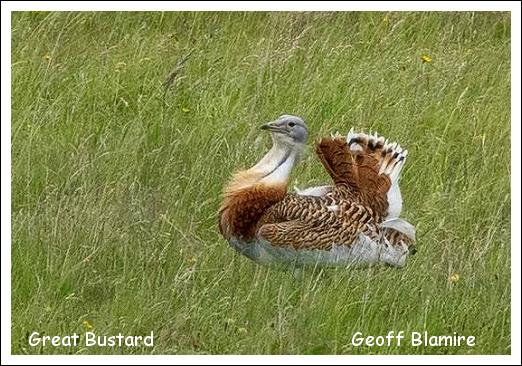 Other special birds: White-tailed eagle (being mobbed by a Buzzard), Goshawk, 2 Hobbies, female Osprey on the nest (1st egg hatched that morning!), many Cuckoos (looking for Tree Pipit nests), Nightjar (only heard), Firecrest (only brief views), close views of Bearded Tits (seen from the boat!), Red Knot (full breeding plumage).
Other special birds: White-tailed eagle (being mobbed by a Buzzard), Goshawk, 2 Hobbies, female Osprey on the nest (1st egg hatched that morning!), many Cuckoos (looking for Tree Pipit nests), Nightjar (only heard), Firecrest (only brief views), close views of Bearded Tits (seen from the boat!), Red Knot (full breeding plumage).Reptiles (2): Smooth Snake, Wall Lizards but Sand Lizards eluded us except for their burrows where the females lay her eggs.
Butterflies (16): Lulworth Skipper (rare), Dingy Skipper, Green Hairstreak, Small Blue (uncommon), Silver-studded Blue, Small Heath, etc.
Dragonflies (c7): Southern Damselfly (very rare), Hairy Dragonfly, Keeled Skimmer, Beautiful Demoiselle, etc.
Moths (17+): Cream-spot Tiger, Mother Shipton, Five-spot Burnet, Bagworm Moth, etc.
Other insects: Bloody-nosed beetle, Heath Tiger Beetle, Minotaur Beetle, Glowworm, (Green) Rose Chafer (nothing like horrible Cockchafers!), Labyrinth Spider, Slave-making Ants, etc.
Plants (+++!): Burnt-tip Orchid, Heath-spotted Orchid, etc, etc.
Mammals (8): Red Squirrel (on Brownsea Island), 3 species of deer, 2 species seal, many New Forest ponies, etc. ............
G&S have returned to find their garden invaded by newly fledged young birds!........." Over the last 3 days there's been an explosion of birds in the garden! Examples: we hadn't see any Great Spotted Woodpeckers since March but now I’ve seen 2 females (not happy when together) and 1 male feeding a juvenile (other juveniles are around); just 2 Goldfinches in April now c10 including 4 juvs; haven’t seen any Bullfinches since January now a male seen over the last 2 days – no sign of the female (yet) perhaps on their nest?; blizzard of Blue Tits – c10 including >5 juvs; 8 Great Tits including 4 juvs; Greenfinch (male) was seen only in March this year but now 2 males and 1 female – no sign of juvs yet; also seen other juvs include Magpie, Robin and Dunnock. Also seen fox at dusk (9.36pm) but 2 on the trail cameras, as well as hedgehogs.
Little Mere: yesterday saw a pair of Great Crested Grebes and further away a single grebe, today the pair where doing their display – no idea what is going on there! The 2 Grey Heron juvs still around and occasionally one of the adults. Canada Geese still have their 5 goslings, while the Coots have 3 young (not so cute!). Pair of Grey Wagtails seen yesterday but the water is flowing too fast on the outflow today. c6 House Martins hawking across the mere.
(Ciceley Mill pool today: Mute Swan with 3 small cygnets and c10 House Martins. The wood nearby has a superb Chicken of the Woods.) "..........
Bob Groom had a splendid morning yesterday (31/5) over at Rostherne Mere.........." This morning, in the peace and quiet of the Crem. we were entertained by a Pied Wagtail working flat out to gather food for the family from the lawns. There was plenty. This afternoon I got to the Rostherne Ob to find I had just missed a hen harrier. Durn. However I did manage to catch an overflying Red Kite later on, amongst the swirl of Swifts. Also several Buzzards. There was a lot of Great Spot activity, at least 3 birds flying round.. The Cuckoo was calling but now from the far right and out of sight."............
Species recorded on the evening trip to the Goyt Valley on Friday 30th May 2025 |
25th May 2025 ......... Platform permission.
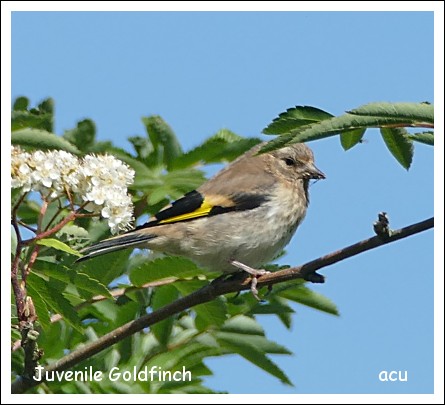 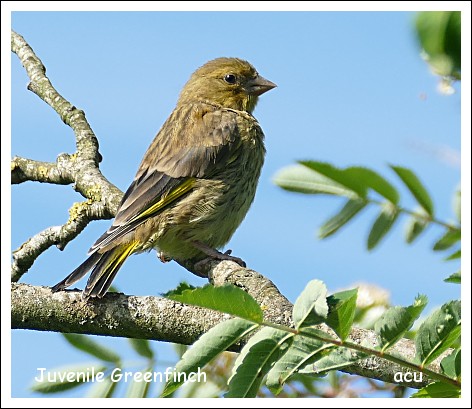 |
Good news from Warrington where the elevated viewing platform at the Woolston Eyes Nature Reserve has been granted retrospective planning permission.

The Development Management Committee met on Thursday evening (22/5); they voted unanimously to grant permission.
I watched the proceedings online and found it quite entertaining. I have made a sound recording of the event and you can listen to it here. Brian Martin, who many of you will know, has his say after about 3½ minutes.
Well we've finally had some detectable rain! My weather station recorded 0.3mm just before midnight and 8.1mm today (24/5), so far. A full month since the last precipitation on the 24th April. I'm sure our local farming community will be relieved, the fields of spring-sown barley, here in Mobberley, weren't showing much sign of growth.
The Hobbies seen last year at Rostherne seem to have given the reserve a miss this year but they are about. Phil Ashley had one in Mobberley a couple of weeks ago and Colin Butler has found a pair at an undisclosed site ........."I thought that I would provide you with summary of a couple of recent visits to a local site.
On Saturday 17th I had a couple of hours spare so I decided to visit a site that I had never had occasion to visit previously.
I had been advised that it was a good site for Dragonflies late last year.
Never having heard of the site before I had a couple of unsuccessful attempts to locate it, but on this occasion I did manage to locate the area.
Being unsure of the exact location I was initially unsure that I had arrived at my intended site, but unperturbed I decided to investigate further.
Straight away I became aware that the number of warblers was significant hearing numerous Willow Warblers and Blackcap, along with the occasional Chiffchaff. However what was surprising was the number of Garden Warblers that were singing.
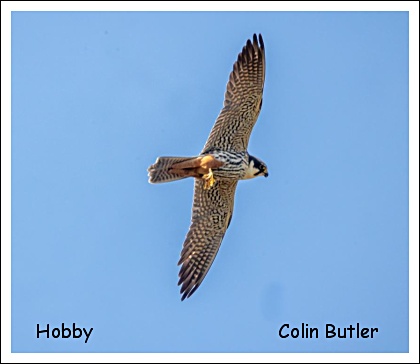 However that was not what I had hoped to see , but as I was about to leave after around 30 to 45mins what I had come to look for appeared. All of my prayers answered, a Female Hobby appeared.
I had come looking for Hobby but never in my wildest dreams did I think that I would actually find one!
However that was not what I had hoped to see , but as I was about to leave after around 30 to 45mins what I had come to look for appeared. All of my prayers answered, a Female Hobby appeared.
I had come looking for Hobby but never in my wildest dreams did I think that I would actually find one!Today, Monday 19th I decided to re-visit the site once the cloud had lifted and the weather warmed up. Initially I walked a different route in order to familiarized myself with the area without any further sighting before ending up at the area where I had observed the Hobby on Saturday. Straight away I flushed a male Cuckoo and shortly afterwards a male Hobby appeared.
As I was under cover the Hobby flew over my head and was observed hunting a head height around 20yds away. Shortly after the male was joined by a female with the pair actively hunting and observed feeding on the wing.
I remained in the general location for around 90 mins with the birds continuing giving close up views and occasionally seen to land in the trees in the distance."..........
Thanks Colin, I suspect you'll be giving the area another coat of looking at on your return from Morocco!
I wish I could afford to go to Morocco but, being a poor impoverished pensioner, I have to be content with tramping down to the Fox harbour area of Mobberley!
Only 18°C this morning (18/5) on a walk down to Gleavehouse Pool. It felt a lot warmer though, as there's little in the way of shelter to get out of the sun.
Swallows and House Martins at Blackthorn Farm and a Yellow Wagtail close to the gates of Gleave House Farm. The single Shelduck chick is growing rapidly, watched over by just one of the parent birds today. At one point a second pair of Shelducks appeared and one appeared to attack the youngster, who quickly dived below the surface as the lone parent saw the intruders off.
A handful of local Sand Martins were joined by four House Martins that collected mud from the margins of the pool, before flying away to the east. The Sand Martin colony was relatively quite today but birds did appear from time to time, flying directly into the nest holes. I counted 17 newly excavated holes. I assume that they now have eggs and things are settling down after the initial flurry of activity we saw when they first arrived, that was on the 25th April, so almost a month ago now.
Returning to the pool a flock of 13 House Martins appeared, they weren't collecting mud but spent a few minutes taking on water before leaving to the north. Visible migration. A couple of Swifts turned up too and left in the same direction. A Buzzard was soaring in the thermals, high over Rooney's before folding its wings and diving down towards the ground in display flight.
More Yellow Wagtails as I returned via Mobberley SQ, passing a Painted Lady butterfly investigating the thistles along the edge of the field. The new houses opposite the SQ have substantial eves and, as in previous years, seem to attracting newly returned House Martins.
It was encouraging to see local House Martins collecting mud for their nests and a flock pausing on their journey north. They do seem to be a little late this year.
Derek Pike also spotted some House Martins from his garden on Acacia Avenue ........."Earlier this evening when I went out to shut the gates, I glanced over to the Redrow estate looking for House Martins. I could not see any but I could hear Swifts. I looked up, they were as high as I have ever seen them, just specks in the sky and mixed among them House Martins, looking not much bigger than large mossies at ground level.
I tried counting them with naked eye I gave up , I was spinning round and round a wonderful sight - not me spinning round, the birds!!!
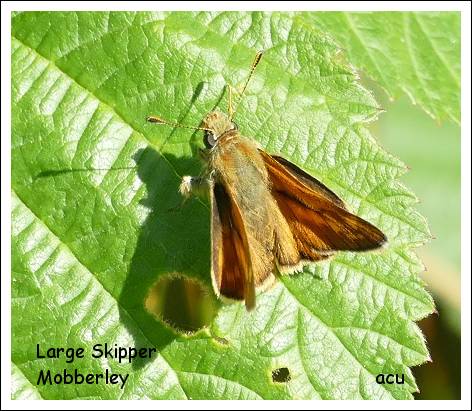 ".......
".......Thanks Derek another description conjurering up some wonderful images!
Bob Groom and Pete Kelly seem to have had little success on their WeBS count at Tabley Mere on Sunday (18/5) ........." Nothing unusual on the mere but Cuckoo calling the whole time we were there.. The oystercatchers seem to have given up on nesting on Tower island."........
Disappointment for Bob and also for me yesterday on a visit to the north side of Mobberley in search of Lesser Whitethroats. This bit of the village, along Breach House Lane then over to Wood Lane and the airport boundary has always been a favourite area for the birds. Not this year though; I hope the bird I had singing on the 4th May is not the only one this year for me!
The were plenty of Common Whitethroats, Blackcaps, Garden Warblers and Chiffchaffs but neither sight nor sound of my favourite bird!
The Large Skipper butterfly was one of a number along the road parallel to the second runway at the airport. I had to join the Facebook "Cheshire Butterflies" group to have it confirmed!
A reminder that this coming Friday it's the first of our Summer evening walks. This time it's to the Goyt Valley.
Friday May 30th Goyt Valley evening walk, meet in 2nd car park along the Goyt at 7.30 pm Leader: Karina Stanley secretary@10x50.com We kick off our evening walks with a visit to the beautiful Goyt. Meet at the Errwood Hall car park.
Not many KOS members, past or present, can boast of having their name printed in the Times newspaper. Mark Eddowes has now joined this select group!!
.............""This complex of heathlands, conifer and broad-leaved woodlands and parklands is an important site for birds such as woodcock, tree pipit, nightjar and goshawk. These are not rare birds but this place is a fantastic spot to see these less common species. A group of us set our alarms for a morning bird walk on Farley Moor led by local ornithologist Mark Eddowes for dawn chorus day and were rewarded by a wealth of singing birds, including a very active tree pipit launching itself vertically from a birch tree and “parachuting” downwards, much as my first bird books described.............
15th May 2025 ...... Field trip to Belvide.
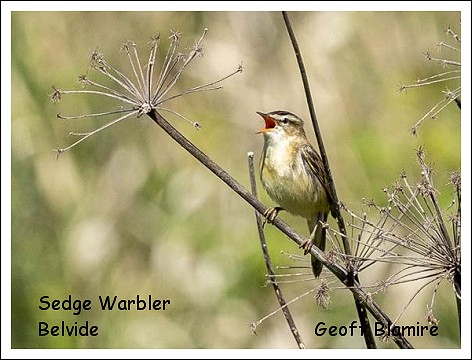 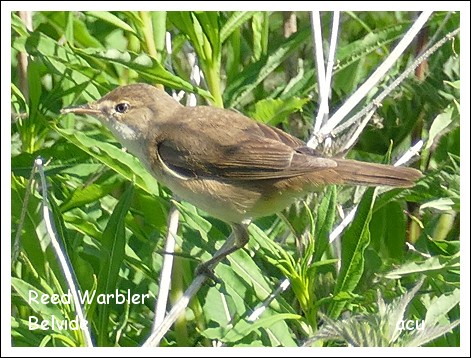 |
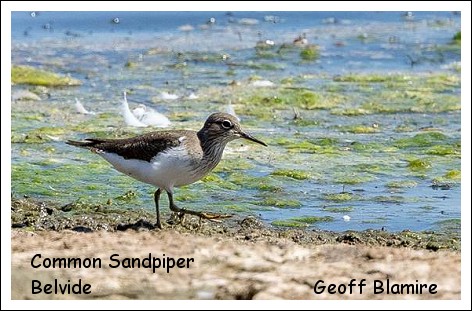 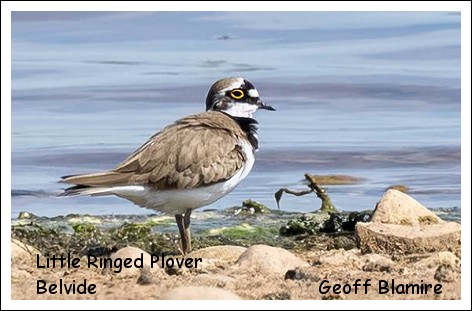 |
We visited Belvide Reservoir for the first time in July last year and enjoyed it so much it was decided there and then to include it in the 2025 programme of field trips, but perhaps a little earlier in the season to catch the Spring migrants in full song.
With so many regulars away on holiday (11/5) it was just a small group of stalwarts that met up with our host for the day, Phil Rowley, at the padlocked gates to the reserve's car park. Phil lives locally and is a member of the West Midlands Bird Club who lease the reserve from the Canal and River Trust.
"Belvide, a 180 acre canal feeder reservoir, was constructed in 1834 to supply what is now the Shropshire Union Canal, but did not attract the attention of ornithologists until the 1920s, when A.W. Boyd (who referred to the reservoir as ‘Bellfields’, to disguise its identity) began visiting regularly and published many of his observations in the magazine British Birds. Boyd, and H.G. Alexander who was a regular visitor in the 1930s, were responsible for putting Belvide on the bird-watching map and the reservoir was soon established as one of the most important ornithological sites in the Midlands."
So we were following in the footsteps of some early ornithological legends!
We wanted the bird song and there was plenty to listen for - Chiffchaff, Blackbird, Chaffinch, Wren, Stock Dove, Blackcap, Robin, Song Thrush and Whitethroat. All before we'd left the car park!
The reserve has five hides, four along the south side, with a fifth overlooking the west side of the reservoir. There are wide-ranging views from each, with reedbeds in front of the first three; the Chappell,
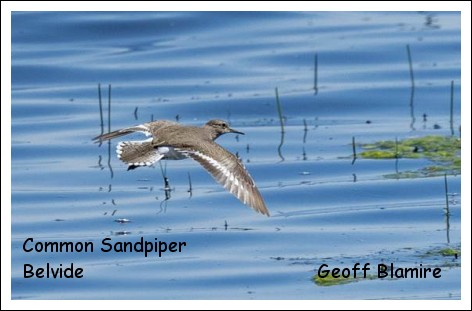 Gazebo and Scott. Out on the water all the usual favourites - Moorhen, Coot, Tufted Duck, Pochard, Shoveler, Mallard, Gadwall, Canada, Greylag and Egyptian Geese, Great Crested and Little Grebes. Highlights were three Black-necked Grebes, spotted by Phil, at the far side of the reservoir but closer views of a well-marked male Garganey, resting on a sand spit in front of the Gazebo Hide.
Gazebo and Scott. Out on the water all the usual favourites - Moorhen, Coot, Tufted Duck, Pochard, Shoveler, Mallard, Gadwall, Canada, Greylag and Egyptian Geese, Great Crested and Little Grebes. Highlights were three Black-necked Grebes, spotted by Phil, at the far side of the reservoir but closer views of a well-marked male Garganey, resting on a sand spit in front of the Gazebo Hide.Also added to the day list - Common Terns, about 20 all told, scattered around the reserve, a handful of Swallows but very few House Martins and a complete absence of Swifts. Reed and Sedge Warblers gave great views in the reeds, the latter were really enjoying the warm sunny weather, from time to time leaping into the air as they continued with their energetic, scratchy song.
Blackcaps and Garden Warblers were both singing from the undergrowth alongside the path between the hides. A good opportunity for comparing the two. Some folk have no trouble separating these songs - I'm not among them!
KOS Hon. Treasurer Frank Dearden heard a distant Cuckoo as we walked towards the last hide, the Hawkshutts, where we enjoyed lunch and excellent views across the whole length of the reservoir, from west to east.
It was from here we could see in the distance, a Great White Egret and a lone Greenshank. Much better views though of a common Sandpiper, just in front of the hide and, on a shingle island a little further out, displaying Little Ringed Plovers that showed every intention of nesting there.
We met back at the car Park at 1:30pm before driving over to Phil's local patch - Blithfield Reservoir, where we hoped to catch a glimpse of the nesting Ospreys. No luck with them this time but we managed to add three new species to the list - Skylark, Great Black-backed Gull and Greenfinch.
A great days birding with 62 species recorded. Our thanks go to Phil for arranging the visit and for acting as trip leader.
Meanwhile, back in Mobberley, I had a pleasant surprise last Friday (9/5) during a visit to Gleavehouse Pool...." Only 1.7°C at 5am, rising to 16°C at noon, peaking at 20.5°C at 5pm. I walked to Gleavehouse pool, passing newly fledged Green and Goldfinches in the garden of Beech Cottage at the top of Mill
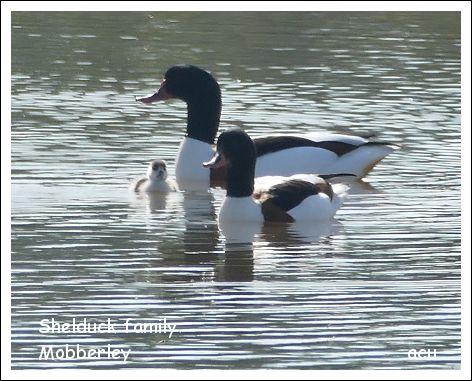 Lane.
Lane.Yellow Wagtails on the way, lots of Sand Martins again but there seems to be a lack of House Martins this year. Normally they're busy collecting mud by now but I've yet to see one at the pool.
Biggest surprise was a family of Shelducks, albeit not a big family; just the parent birds and one youngster - but at least it will receive their full attention!
I'm guessing they've had big problems this spring.".....
The little Shelduck was still there on Sunday (11/5) when Wendy Stratford ventured in that direction ......"I walked to pool, just before 9am. Mixed results. 4 swallows seemed to be seeing off a house Martin at the horse barns. Quiet walk to the pool - only the shelducks with one youngster and a mallard. No lapwing chicks or parents on guard. No sand martins. When I walked down to the ‘cliff’ there was a fox on the slope up to the back of the cliff. He ran off when he saw me. No activity at the cliff - waited about 15 mins and 3 sand martins appeared and flew around - not many insects. 2 went into different burrows after a while. I didn’t see more than 3 until I was walking back up to GHP when there were briefly 5. Still none at the pond. There were at least 30 a week ago.
On a brighter note the south ends of the big field and the field behind the obs were busy with lapwings (flying and calling occasionally) and skylarks singing and being territorial!
When I got back to the swing gate into the big (corn this year) field a pair of yellow wags bombed past heading south - the male circled round and ended up on the hedge by the barley field. I saw at least 8 yellow wags - including 3 females flying down into the barley. A skylark did the same.
Everywhere is very dry and generally low numbers of insects.".........
We haven't had any detectable rain since the 24th April, perhaps it's this that's led to the shortage of insects and subsequent low counts of hirundines and Swifts. Bob Groom also found a paucity of these species on Saturday last (10/5) ......."An unfruitful hobby vigil in Plumley. Checked where G & S & I had lesser whitethroat last year but no luck either. 2 Oystercatchers went over and that was it. However, I called at Sudlow Lane en route (Trouthall Lane was closed) and saw 2 Grey Partridges, until a cock Pheasant moved them on. Also Buzzard, Pied Wagtail - but no yellow, perhaps foraging further afield. What was disturbing was the lack of Swallows, I hardly saw any and the total absence of house martins, not to mention swifts.."........
Meanwhile, on the same day, Derek Pike had no problems with Swifts, he didn't even have to leave his garden! ........." Red letter day for me after part mornings toil in the garden, I was sat under the willow tree in the dappled sunlight and looked up, instinct I suppose, 5 Swifts swirling around - magic.".........
A species that definitely need flying insects are Spotted Flycatchers. One has been seen at Rostherne Mere NNR but didn't show for Geoff and Sheila Blamire, again on Saturday (10/5)......." We spent some time on the boardwalk in Wood Bongs but no sign of the Spotted Fly. As Steve Collins said on Thursday,
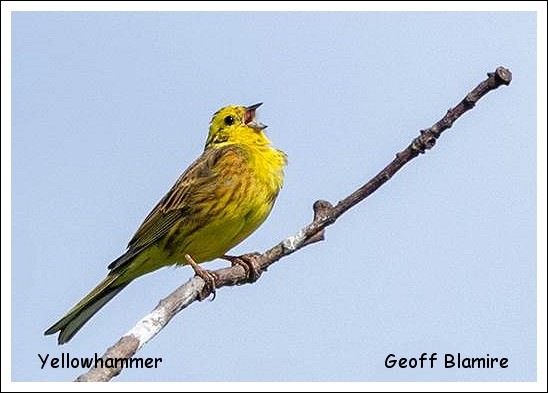 when we chatted for half an hour while waiting (Sheelagh had seen the Spot Fly earlier), there are no flies so probably it is looking for caterpillars. Still early so hopefully the partner will turn up in one or two weeks time – hopefully will be easier to see then. Otherwise the Obs was quiet – 2 Sparrowhawks circling, 3 Long-tailed Tits, etc. Also on the path between Obs and Wood Bongs I spotted a female Muslin moth (much smarted than the male!). The females occasionally fly during the day. "..........
when we chatted for half an hour while waiting (Sheelagh had seen the Spot Fly earlier), there are no flies so probably it is looking for caterpillars. Still early so hopefully the partner will turn up in one or two weeks time – hopefully will be easier to see then. Otherwise the Obs was quiet – 2 Sparrowhawks circling, 3 Long-tailed Tits, etc. Also on the path between Obs and Wood Bongs I spotted a female Muslin moth (much smarted than the male!). The females occasionally fly during the day. "..........More garden birding from Derek yesterday (14/5) ......." While walking down our drive on way to wash the Lexus (about time some would say) I stopped to chat with my neighbour - low and behold two House Martins over the new Redrow estate. Some while later, while actually cleaning the car, heard screaming noise above - there were six Swifts in Lilac Avenue. I was glad to have a rest and look up looking for more.
Still the wheels to clean after lunch now, might get a couple of Swallows with a bit of luck ".......
Geoff and Sheila were out and about yesterday and were again pleased to find a singing Yellowhammer that posed nicely for Geoff's camera ...... "Did Mere plus some of Millington this morning. Little Mere: just one fledged Grey Heron (the trees and bushes obscuring our view of the mere now). Chapel Lane: singing Skylark, singing Whitethroat, Buzzard (on its usual telegraph pole). Peacock Lane: singing Yellowhammer (see photo), one Lapwing. Moss Lane: pair of Linnets (one carrying a feather into its nest). Plus usual species such as Chiffchaff, Blackcap, etc.".......
Species recorded on the KOS trip to Belvide and Blithfield reservoirs. Sunday 11th May 2025 |
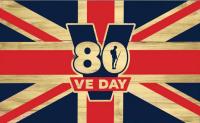 8th May 2025 ....... Cuckoos and Lesser Whitethroat.
8th May 2025 ....... Cuckoos and Lesser Whitethroat.Following a dry and sunny March (the sunniest in England since records began in 1910), April followed suit and this has, so far, continued into May. My weather station hasn't detected any rain since the 24th April.
No doubt we'll soon be having hose pipe bans and there will be much discussion, once again, about a national network of pipe work to supply water from the Lake District to the south-east of England!
New Summer visitors are continuing to arrive and, since the latest update less than a week ago, Lesser Whitethroat, Cuckoo and Spotted Flycatcher have all been recorded locally.
The first Cuckoo was found at Rostherne Mere on Saturday (3/5), by Pete Kelly. Geoff and Sheila Blamire didn't manage to locate it on the 3rd but had more luck on Tuesday (6/5), when Geoff managed a more than adequate record shot
 ......."Rostherne: We were walking up Ciceley Mill Lane when Pete Kelly stopped to say he'd heard a Cuckoo in Gale Bog area. Couldn’t hear anything from Rostherne Lane nor from the Obs. But we had many Swifts over the mere, followed by numerous hirundines (Swallows, Sand Martins and few House Martins). 2 Buzzards, 4 Mute Swans, Cetti’s Warbler, etc…..
......."Rostherne: We were walking up Ciceley Mill Lane when Pete Kelly stopped to say he'd heard a Cuckoo in Gale Bog area. Couldn’t hear anything from Rostherne Lane nor from the Obs. But we had many Swifts over the mere, followed by numerous hirundines (Swallows, Sand Martins and few House Martins). 2 Buzzards, 4 Mute Swans, Cetti’s Warbler, etc…..Little Mere: 1 of 3 (at least) Grey Heron chicks has fledged and perched with one of the adults on the side of the mere. Great Crested Grebe and male Shoveler, but no sign of Reed Warbler. "...............
Yesterday (7/5) a Spotted Flycatcher was recorded in Rostherne's Wood Bongs.
Bob Groom was in the reserve's observatory yesterday and had good views of the Cuckoo ..........."Really good view of the Cuckoo calling from the right-hand 'hobby tree'. It then flew right across the mere, still calling, and disappeared. Usual Buzzard, Raven, Stock Dove etc. but no sign of any hirundines or swifts. Visited Cicely Mill, male Mandarin, Little Grebe and millions of midges but sadly no sign of any farm swallows to eat them; should be back by now if they are coming.."...........
On Sunday (4/5) I walked over to Gleavehouse Pool and came across my first Lesser Whitethroat of the year. I was getting a bit worried! ..........."A very pleasant way to spend Sunday morning; 9°C when I left home, rising to 13°C by 1:00pm.
 I walked to Gleavehouse Pool via Gleavehouse Lane. Taking the diagonal path from the farm gates, I heard the unmistakable rattle of a Lesser Whitethroat. I've attached the file from "Merlin" - you can just about make it out (turn your sound up!).
I walked to Gleavehouse Pool via Gleavehouse Lane. Taking the diagonal path from the farm gates, I heard the unmistakable rattle of a Lesser Whitethroat. I've attached the file from "Merlin" - you can just about make it out (turn your sound up!).Two Yellow Wagtails, a male and a female, in the next field. The maize is just beginning to show.
At the pool a single Shelduck with lots of local Sand Martins overhead. A Little Ringed Plover has returned and was feeding along the muddy margins of the pool. I walked down to the SM colony where I counted about 20 new nest holes. No Whitethroat, Garden Warbler or Blackcap today.
Returning to the pool I saw a tiny bird swimming in the centre - perhaps a young Coot or Moorhen? But no - it was a Lapwing chick that progressed to the far side, scrambled out and vanished in the long grass!
On my way home, two Swifts, my first of the year, showing some interest in the converted farm buildings.".........
Wendy Stratford went down the following day (5/5) and counted six Lapwing chicks. So, success so far for these Lapwings that have nested in the Spring barley - unlike the birds to the west of Smith Lane who's breeding attempts have been thwarted by repeated farming activities. This from Wendy on Tuesday (6/5) ............" I walked down to the lapwings yesterday evening - didn’t see any chicks but 2 grey partridges by the railway steps and a whitethroat in same tree as previously. Lots of lapwing activity over the recently ploughed field - synchronised flying and calling. Maybe re-nesting? Still some lapwings on the field over railway.".........
Tatton ranger, Darren Morris reports at least one Cuckoo in the park (6/5) ........"Gauntlet Birds of Prey centre have been in and the have had a black kite escape.
Cuckoo calling all morning at Higmere/Moor area… hopefully it will find a mate. Looking to use a reed warbler no doubt "..........
Derek Pike was there the same morning ........"I spent couple hours in Tatton am 10-12 ish
Melchett
Several Grey Herons
One Great White Egret, very obligingly stood about 4 yards from heron, you could compare the two.
Pair of GCG, I thought she was ill lying flat down on nest about 5 yards from where I was then he appeared and copulation took place.
Two Carrion Crows mobbing a Buzzard - a good fight.
Three Cormorants and several Coots.
A number of Egyptian Geese, loafing on the shore. Blackcap singing or was it a Garden Warbler? (later in the year O2 are making 3G obsolete so I will have to get a phone with Merlin). Wren singing about two inches from my ear. Well it felt like that!
Interesting; a pair of Mute Swans walked from Melchett to Tatton.
Tatton Mere
Lots of Mute Swans, pair of GCG. lots of activity but visibility looking toward Knutsford not good.
No Sand Martins, no House Martins, no Swallows, no Swifts but a very beautiful, good to be alive morning having Tatton on your doorstep, so to speak.
Negatives - no Dictaphone - broke. No pen
Positives all above from memory so short term memory ok except for a pen. ".........
 |
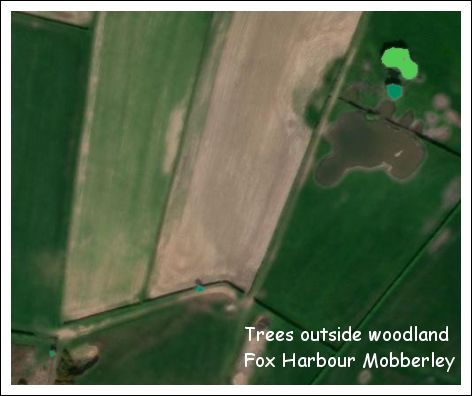
I took the back and white image of a lone oak tree a few weeks ago in Fox Harbour, Mobberley. It reminded me of the vandalised sycamore tree near Hadrian's wall, in Northumberland.
A short time later I was getting my morning fix of doom and gloom, listening to the "Today" programme on Radio 4. They had a very interesting piece about a new map that shows all the "lone" trees in England.
" England's non-woodland trees have been mapped for first time, revealing these trees make up nearly third of our nation's tree cover.
Using one of the very latest methods of laser detection and satellite imagery, the country's top tree scientists at the UK Government’s Forest Research agency built a comprehensive picture of non-woodland trees across England.
By providing a better national picture, the ground breaking map will allow conservation groups and local authorities to target tree planting efforts more accurately. The map can pinpoint lone trees that could be connected to nearby wooded areas to create better habitat for wildlife in support of the Government’s manifesto commitment to expand nature-rich habitats and help achieve our legal target to increase England's woodland canopy to 16.5%. "
You can find the map by clicking here
The other image shows how the area around Gleavehouse pool is represented. The pool is top right; the small quarry hosting the Sand Martin colony is bottom left. The lone oak tree is marked by a small green dot between the two.
Well I thought it was interesting anyway!!
2nd May 2025 ......... First Swifts.
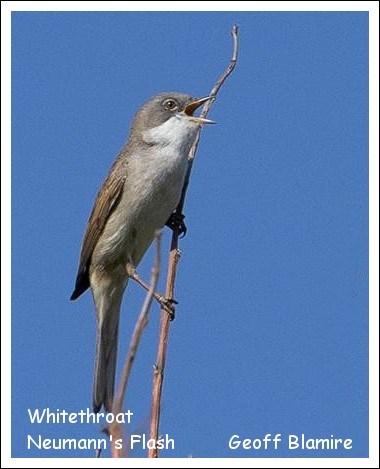 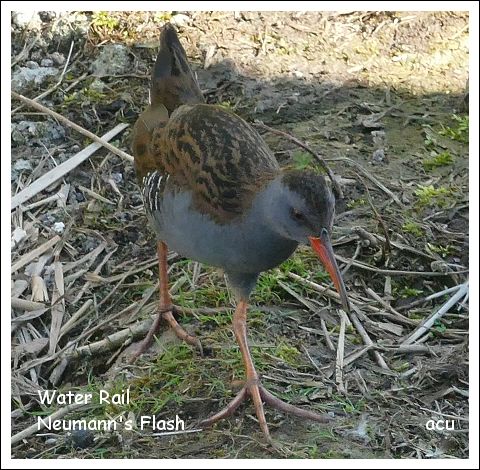 |
Sam Peers, an "old timer" from Mobberley, who told me of the stuff that he found locally in the 1920s, always said that the first Swifts invariably appear in time for the Knutsford May Day festivities. So they just made it this year, with Swifts seen and heard yesterday (1/5) by Jude Halman and Karina Stanley.
Another first last Friday (25/4), with a Hobby at Rostherne Mere, found by Bob Groom - who else!! .........."On Friday SH logged what was probably the last goldeneye (f) of the winter season. We watched Buzzard display and 2 Ravens, which I saw again today. Later in the day I briefly
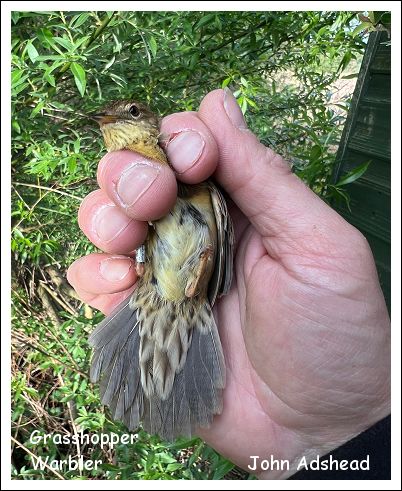 clocked the unmistakable silhouette of my first Hobby of the year, but it didn't drop down. Today I was pleased to see no less than 3 late drake Goosanders, all close to the weather station, but oddly no sign of buzzard. A single Swallow was followed by a small party of martins but the light was absolutely atrocious so I couldn't ID them "...........
clocked the unmistakable silhouette of my first Hobby of the year, but it didn't drop down. Today I was pleased to see no less than 3 late drake Goosanders, all close to the weather station, but oddly no sign of buzzard. A single Swallow was followed by a small party of martins but the light was absolutely atrocious so I couldn't ID them "...........Other recent records from Rostherne, include - singing Grasshopper Warbler and two Common Terns on Monday (28/4), four Black-necked Grebes the following day (29/4), 10 Cetti's Warblers, four Sedge Warblers and the first three Cormorant chicks on Monday (28/4).
Last Friday, 25th April was St. Mark's Day and, fittingly, the hawthorn hedges around Gleavehouse Pool were teeming with St. Mark's flies - plenty of food for what we can now call our "local" Sand Martins ........" Yellow Wagtails and one White Wagtail on the "big field" as I made my way towards Gleavehouse Pool. The two Shelducks were on the banks of the pool but I fear they may have failed this year as they both flew off at one stage and never returned.
Plenty of Sand Martins, so I went down to Simcock's Hill and was delighted to see so much activity around the newly excavated holes. Also there singing Chaffinch, Chiffchaff, Blackcap, Garden Warbler, Song Thrush, Blackbird and a very active Whitethroat. "...........
Wendy Stratford walked down to the same location on Monday (28/4) ........." Went to pool this morning - swallows sitting on wires outside stables as though it was Aug! Saw all 3 wagtails (not white although I looked) - pied at pool, at least 3 yellow males sat on hedges, surrounded by st mark’s flies, with one territorial dispute (no females - sitting in barley field along with skylarks I imagine) and 3 grey wagtails in the ploughed and drilled big field - just south of the ‘path’. In the field behind the obs there were about 20 lapwings calling and displaying, sometimes bursting up out of the barley - just lovely to see. Skylarks
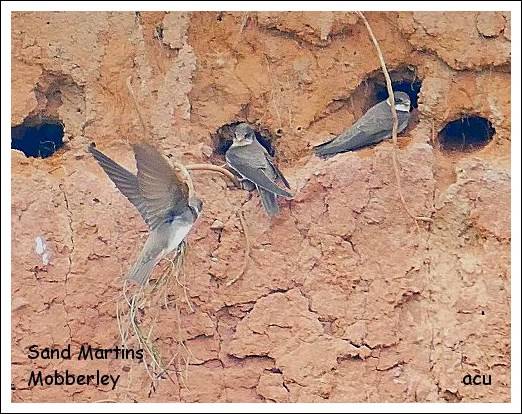 singing the whole time, and shelduck still not doing much at pool. Looks like there is a ltt nest in the hedge line opposite the obs - at the end of the continuous bit before the water - 2 birds going in as I walked down and when walked back.
I walked down to see the sand martin ‘cliff - thanks for directions! It was delightfully busy - much toing and froing - at least 30 birds flying at a time I would say. Let’s hope it doesn't get disturbed… when I got back to the pool the martins had same idea and were feeding and occasionally landing on the south shore (quite wide now) as we saw before. Also a swallow drinking.
"...........
singing the whole time, and shelduck still not doing much at pool. Looks like there is a ltt nest in the hedge line opposite the obs - at the end of the continuous bit before the water - 2 birds going in as I walked down and when walked back.
I walked down to see the sand martin ‘cliff - thanks for directions! It was delightfully busy - much toing and froing - at least 30 birds flying at a time I would say. Let’s hope it doesn't get disturbed… when I got back to the pool the martins had same idea and were feeding and occasionally landing on the south shore (quite wide now) as we saw before. Also a swallow drinking.
"...........As usual Geoff and Sheila Blamire have been very busy over the last week, including an early morning BBS ..........Here are the highlights (or rather anything new from reported before) from Millington and Mere over the last few days.
Millington: watching a pair of brown hares for ages while listening to a Skylark singing; pair of Buzzards mating; new pair of Red-legged Partridges. Also the ‘usual’ Yellowhammers, Whitethroats, Skylarks and Lapwings.
Little Mere: male Mandarin (last time seen April 2024 and bred in 2023 producing 8 ducklings); 4 Egyptian Geese and 2 Greylag Geese. And pair of Great Crested Grebes and at least 2 Grey Heron chicks – now exercising their wings.
We did our Breeding Bird Survey on Sunday. It was rather chilly at 6:45am (“Visits should ideally start between 6am and 7am”!). I started doing the survey back in 1999 (26 years ago!) and many changes over the years – habitats, species and the overall number of birds. All have been negative. Looking back over the years my memories include Little Owl breeding, pair of Spotted Flycatchers, number of Yellowhammers and brown hares (I record mammals as well). Swallows and House Martins used to breed on one of the farms. Used to have so many pairs of House Sparrows breeding on half a dozen houses, not any more. Highlight on Sunday? Pair of Oystercatchers. Everything is now so ‘sterilised’. Many houses have been rebuilt or renovated. Pristine lawns. I could go on but I’m sure you have the main gist. .............
 I met G&S in Tatton on Monday morning (28/4), they'd had two Great White Egrets on Melchett mere and a Great Crested Grebe on eggs at the same location. I'd heard my first singing Reed Warblers on Knutsford Moor but nothing else of note, despite spending half an hour on the bench overlooking the main mere. We'd all missed an overflying Osprey, seen by Darren Morris from his front garden on Manor Crescent!
I met G&S in Tatton on Monday morning (28/4), they'd had two Great White Egrets on Melchett mere and a Great Crested Grebe on eggs at the same location. I'd heard my first singing Reed Warblers on Knutsford Moor but nothing else of note, despite spending half an hour on the bench overlooking the main mere. We'd all missed an overflying Osprey, seen by Darren Morris from his front garden on Manor Crescent!On Wednesday (30/4) a small group of mid-weekers enjoyed a wonderful mornings birding at Northwich's Neumann's Flash.
Things began well with a singing Whitethroat at the Witton Mill car park. It was still there when we returned a couple of hours later. The bird was one of eight different warbler species we encountered as we made our way around Neumann's and Ashton's flashes before ending up at Pod's Hide, overlooking Neumann's. Blackcaps, Chiffchaffs and Willow Warblers in abundance, singing from the undergrowth plus Sedge Warblers in the shrubbery towards the centre of Ashton's. We had to wait until we reached the far side of Neumann's, with it's phragmites reedbeds, before encountering the Reed Warblers. From Pod's Hide, Tufted Duck, Coot, Moorhen, Mute Swan, two Goosanders, Shelduck, Avocet, Great White Egret, Little Grebe, Common Sandpiper and a pair of confiding Water Rail with their two? chicks. We finished with a list of 52 species in a little over 2½ hours. A good location at the optimum time of the year.
A reminder from Karina about our next field trip - a week on Sunday (11/5)
Sunday May 11th 2025 Belvide / Blithfield Reservoirs. Meet at 10.00am
Leader Phil Rowley. Please contact Phil should you wish to join the visiting group.
philipr266@gmail.com
Non-members of WMBC will be charged £5 pp. Please take cash with you to pay Phil on the day.
Following on from our first visit last year in June, we are lucky to be able to return at a slightly earlier time of year. Access to Belvide is by Inclusive Club membership only and again, Phil Rowley has kindly arranged us access via the West Midland Bird Club. He will make a record of each car’s registration on the day.
Click this link for more information Belvide
DIRECTIONS
Getting to Belvide: Use Shutt Green Lane for access to Car Park. Use Postcode ST19 9LX in Google maps/ Sat-Nav etc. What3Words: ///distracts.this.reinvest
Species recorded on a mid-week trip to Neumann's Flash - 30th April 2025. |
 23rd April 2025 ......Woolston update
23rd April 2025 ......Woolston updateDavid Bowman's request for help in securing retrospective planning permission for the new elevated viewing platform at Woolston Eyes SSSI has generated 87 responses from members of the public. Of those 86 were in favour so it seems inevitable that permission will be retrospectively granted. Apparently a generous permit holder has donated £1500 to cover the cost of the application!
 Just after the last update I received news from Geoff and Sheila Blamire of some late Winter visitors that have remained with us (12/4).........."Walked nearly 12km Friday morning taking Mere and Millington area. The usual Yellowhammers, Lapwings, Skylarks (so lovely to say ‘usual’ with those species!) and Goldcrest, Willow Warbler (haven’t seen/heard there for 2 years), Blackcaps, Greenfinch feeding on old blackberries, etc. But the most unusual is a field with c50 Fieldfares and Redwings and a few Starlings. Wonder how long the winter thrushes will be with us? They can linger until May"............
Just after the last update I received news from Geoff and Sheila Blamire of some late Winter visitors that have remained with us (12/4).........."Walked nearly 12km Friday morning taking Mere and Millington area. The usual Yellowhammers, Lapwings, Skylarks (so lovely to say ‘usual’ with those species!) and Goldcrest, Willow Warbler (haven’t seen/heard there for 2 years), Blackcaps, Greenfinch feeding on old blackberries, etc. But the most unusual is a field with c50 Fieldfares and Redwings and a few Starlings. Wonder how long the winter thrushes will be with us? They can linger until May"............Three days later (15/4) they were out in the same area on their daily walk ........"We did 12km around Millington and Mere this morning and started off well as we walked down the drive with a Willow Warbler singing, also heard the Chiffchaff singing in the garden (still coming to the pond to bathe, including the pair of Long-tailed Tits). Little Mere: at least 2 Grey Heron chicks on the nest, pair of Egyptian Geese flew off and a female Great Crested Grebe joined the male – yippee! Chapel Lane: male Yellowhammer – the first time seen here since they bred here last year. Peacock Lane: at least 4 Lapwings flying around the field – the farmer was spraying the crop! He was sticking to the tram lines so the nests might be okay. Most of the time the Lapwings were taking off and dropping down in the field again. Have to see…. Also there was a male Yellowhammer singing on Peacock Lane. Moss Lane: pair of Yellowhammers. Millington Lane: 2 Whitethroats including song and display flight (our first for 2025), 1+ Skylarks singing, pair of Yellowhammers and 2 Buzzards circling".........
Last Thursday (17/4) KOS Secretary, Karina Stanley visited the Sudlow Lane area of Knutsford, where she'd had the seven Yellow Wagtails two days previously ......"Having submitted my email in support of the platform at Woolston Eyes, I took myself off down Sudlow again and, in a brook, I surprised a beautiful pair of Mandarin duck!".......

Derek Pike and Bob Groom also ventured down the lane, Derek had two Yellow Wagtails and Bob one - a bright male.
Also on the 17th I was out in the Fox Harbour area of Mobberley ........." 9°C this morning when I set off to Gleavehouse Pool but much more acceptable than yesterday, now the wind has abated.
At least eight Wheatears on the "big field" with Yellow Wagtails overhead and perched on the hedgerows.
On the pool, the usual two Mallards and two Shelducks were joined for a short time by a pair of noisy Greylags. One of the Little Ringed Plovers had returned and fed busily on the muddy margins. No sign of the second though. "..........
On Saturday (19/4) there were no Wheatears but a nice surprise awaited at the pool. ........."The big field has now been completely covered with manure, prior to ploughing. They will be growing Maize.
The Wheatears seem to have moved on, in their place a nice White Wagtail. I managed a record shot.
At the pool, no Little Ringed Plover just the usual Shelduck and Mallard pairs. Lots of Sand Martins about so I wandered down to "Simcock's hill" where they've nested previously. There were some fresh holes and a dozen or so birds low overhead. So I think they are almost certainly going to use this location again.
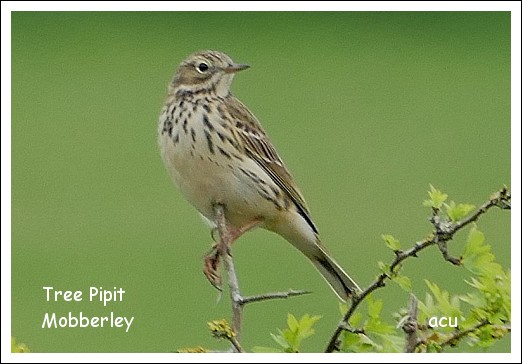
I met Wendy Stratford at the obs and we watched the Sand Martins carefully. They were landing on the short grass at the side of the pool and copulating, perhaps confirming they were not just passing through and are intent on staying in the area.
As I initially approached the pool, I noticed a pipit perched at the top of a hawthorn bush. It didn't call but neither did it fly off and allowed a close approach. Later, looking at the pictures I took, I thought that it looked a bit "different" and sent the image to Hugh Pulsford who confirmed my suspicions that it was a Tree Pipit!
I passed a Yellow Wagtail on the barley field they used last year and again managed a record shot. Wendy had four, Two males and two females as she made her way home."..........
On Saturday (19/4) Bob Groom travelled over the Neumann's Flash area and was disappointed to find the viewpoint across Ashton's Flash sans seat. .........."Pushed on to the bund, anxious for a sit down only to be disappointed by the absence of the bench seat which had apparently been taken into custody as 'unsafe' (don't believe it!). Male Marsh Harrier made an appearance, Redshank with the Shovelers and Shelducks. Very few hirundines but several Buzzard sightings. There were apparently 10 Avocets at Neumann's and I managed to see at least 4 of them. Little Grebe, 2 Oystercatchers, Water Rail calling, my first Reed Warbler of the Spring...".........
Geoff and Sheila visited Tatton's private Witchcote Wood on Sunday (20/4) to do the second leg of the Marsh Tit survey ........" We did our 2nd Marsh Tit survey this morning. Got to Tatton Park 8am and left about 12 noon. Four hours of hard slog (6km) – made worse because we got lost twice. One during the survey (the squiggle on the map), second time on the way back (the big loop). Last time we were there was 25 days ago – the vegetation has really grown so it was difficult to follow our route. Just as well we had grid refs. Anyway – no Marsh Tits. When we got lost the first time, Geoff said just go back and record no responses – he was joking – I think!!! ".............
Hard going! but, undeterred, they were out again the following morning ........"Even though we experienced rain it was a good morning. Cape of Good Hope Farm, Holford: 3 Oystercatchers, male Reed Bunting, Whitethroat (song) and pair of Long-tailed Tits. Inovyn offices area: pair Yellowhammers (incl song). Holford track: Whitethroat (incl song flight) and pair of Linnets. Railway: Whitethroat (incl song flight). Holford Hall area: male Yellowhammer (song). Also many Chiffchaffs and Blackcaps.
Forgot to say yesterday as we drove into Tatton at 8am the 2 Great White Egrets were on Melchett Mere – very close to the road. "
A reminder that on Friday it's our AGM. It won't take long, 15 minutes last year! Then we can settle down and enjoy a presentation by our Hon. Chairperson.
KNUTSFORD ORNITHOLOGICAL SOCIETY AGM
FRIDAY 25th APRIL 2025
8pm
JUBILEE HALL, STANLEY ROAD, KNUTSFORD WA16 0GP
Speaker: Sheila Blamire With 3 countries, 3 eagles and 3 vultures, our Chairman's talk is: 'Three months Birding in Europe'
After the current spell of unsettled conditions, the forecast for next week looks quite promising. Plenty of warm sunny Spring weather - so get out there and make the most of the best time of the year for birding and let me know what you're up to. I can always accommodate more reports!!
15th April 2025 ..... Woolston Eyes.
  |

The trip list began at the entrance where Chiffchaff, Willow Warbler, Sparrowhawk and Blackcap were the first entries in participants notebooks before we reached the bridge across to the main part of the reserve.
The usual Mallards and Tufted Ducks from the bridge whilst, a little further on, a Kingfisher was having some success removing small fry from the murky waters below. Things became a little confusing as we made our way to the tower hide, with the songs and calls of Redstart, Wood Warbler and even Wryneck emanating from the phragmites reedbeds. They were coming from recordings being played from within the reeds, to lure passing migrants into the mist nets set up by the ringers. I was always under the impression that this technique was only employed in the Autumn, after the breeding season had ended - so perhaps not.
The John Morgan hide is a substantial structure and the whole party managed to squeeze in to enjoy elevenses and views right across number 3 bed. Although we didn't see any Black-necked Grebes from the hide, there was plenty going on in front of us - a pair of Marsh Harriers were in constant view and appear to be preparing to nest on the reserve, chasing off any intruding buzzards in a spectacular fashion - see Simon's excellent image at the top of this update. On the water - Canada, Greylag and a Barnacle Goose; Coot, Moorhen, Teal,Gadwall, a flotilla of Pochard and even a female Garganey found by Sheila, our Chairperson. Not the easiest bird to identify!
There were a few birds using the well-stocked feeders, including Blue and Great Tits, Great Spotted Woodpecker, Greenfinch, Bullfinch and a lone Siskin.
Normally a visit to Woolston is confined to number 3 bed but this year we were planning to visit the new number 4 bed too and Karina decided it was time to move on. We took the path in an anti-clockwise direction, via the two lower hides and back to the cars. On the way we passed one of the mist nets
 set deep in the undergrowth; it contained two struggling birds. I'm guessing that not all of the party had witnessed this sort of thing before and there followed much discussion about the ethics of mist netting birds during the breeding season especially as, on this occasion, the nets contained Willow Tits, a species that is on all the red lists and declining rapidly. The ringer appeared and skillfully removed both birds and brought them over for us to look at. One of the pair had been ringed previously and they were a known couple of individuals. He explained why they were ringing and assured us that the birds would suffer no adverse reactions. I'm not sure everyone was convinced. Perhaps the ringing community need to do a little more PR work with casual birders and the public in general.
set deep in the undergrowth; it contained two struggling birds. I'm guessing that not all of the party had witnessed this sort of thing before and there followed much discussion about the ethics of mist netting birds during the breeding season especially as, on this occasion, the nets contained Willow Tits, a species that is on all the red lists and declining rapidly. The ringer appeared and skillfully removed both birds and brought them over for us to look at. One of the pair had been ringed previously and they were a known couple of individuals. He explained why they were ringing and assured us that the birds would suffer no adverse reactions. I'm not sure everyone was convinced. Perhaps the ringing community need to do a little more PR work with casual birders and the public in general.Having returned to the cars we drove back along the track towards the first locked barrier, parked a short distance away, unlocked the very substantial metal gates and entered number 4 bed. The official route to the elevated viewing platform takes you right around the perimeter of the bed - a long, long trudge, but arrangements had been made in advance and we were allowed to take a much shorter path to the platform. It's still quite a distance though, but eventually the two large stretches of water came into view and we were able to pick out Common Sandpiper and Little Ringed plovers. The platform is an impressive affair. It's not high, only about seven meters but give marvelous views across the whole of number 4 bed. From the top we had great views of the reserve's star birds - Black-necked Grebes and there were plenty of them - 57 at the last count. Also ticked off on the list - Snipe, Shelduck, Oystercatcher and Stonechats, overhead Swallows, House and Sand Martins. This was a memorable day's birding and we ended up with an impressive 66 species. Our thanks go to Karina for all her hard work and for leading this trip.
By coincidence, this week, we have received this message from Dave Bowman, Chairman of the Woolston Eyes Conservation Group.
An unusual post here, requesting a bit of help for Woolston Eyes. When we finished construction of the No.4 wetland three years ago, we wanted to provide a viewing facility for our permit holders.
 So, we raised £22,000 and built a wonderful, elevated platform overlooking both wetland cells. We did so with the consent of Peel Ports and with the understanding that planning consent was not needed. However, a certain local councilor has been pressing Warrington Council to pursue the issue of planning consent and we received a letter threatening to require us to take the platform down. So, we spent £1,500 to put in a retrospective planning application, which is due to be heard at the end of this month.
So, we raised £22,000 and built a wonderful, elevated platform overlooking both wetland cells. We did so with the consent of Peel Ports and with the understanding that planning consent was not needed. However, a certain local councilor has been pressing Warrington Council to pursue the issue of planning consent and we received a letter threatening to require us to take the platform down. So, we spent £1,500 to put in a retrospective planning application, which is due to be heard at the end of this month.We would be grateful for anyone who is willing to support our application, as the loss of the platform would be a real blow, both to our many hundreds of permit holders and to our ability to monitor the rare breeding birds on the site.
You can help by sending a supportive email to devcontrol@warrington.gov.uk quoting the case number 2025/00253/FUL perhaps copying to Brian brianmartin1940@hotmail.com and/or David Bowman DSBowman123@aol.com
All submissions should be sent in as soon as possible. The closing date is 20/4/25.
Many thanks in hopeful anticipation.
Members have been out and about in the week since the last update, enjoying the continuing spell of warm, sunny Spring weather.

On Thursday (10/4) I paid my first visit of the year to the north end of Mobberley village, next to runway 2 at Manchester Airport ..........."Mobberley again. The noisy part!
I parked at the top of Wood Lane and walked alongside the runway as far as the concrete blocks, just before the drop down to the Bollin.
Just 23 species, so a bit disappointing. Chiffchaffs everywhere, singing Goldcrests, two Blackcaps and an early Whitethroat singing from the undergrowth, it only showed itself briefly, so perhaps it's not until a female is in the vicinity that they do their display flight.
The Whitethroat was a short distance along the road from where you park. On the second bend when walking toward the airport buildings - easy walking. It was 13 days earlier than my first last year, seen at Brockholes."..............
Geoff and Sheila Blamire were at Rostherne on the same morning ........"The Whooper Swan was still there and showing much better than when we first found it 2 days ago. Many Blackcaps and Chiffchaffs singing. And the usual Cetti’s but no Willow Warbler. Pair of Jays (or could have been 2 pairs!). 4 Long-tailed Tits chasing each around the obs. 2m Mandarins and 1m Shoveler."..............
On Friday (11/4) I found myself in the quieter end of Mobberley (it's a big place [the second biggest parish in England - allegedly]) having seen a Little Ringed Plover the previous day ............." The dry spell of weather we've enjoyed so far this month seems to have come to an end, as a low pressure system moves in from the Atlantic. It's brought only a few spots of rain so far, my weather station measured only 0.3mm at 7:00pm this evening.
The met. Office forecast gave a 90% chance of rain at 11:00am but I took a gamble and walked over to Gleavehouse Pool. I'm glad I did.
A
 muck spreader has been at work on the big field that runs from Mill Lane to Pedley Brook and deposited manure down two strips of the field, about 10 yards wide. It doesn't seem to have put the Wheatears off and I counted seven as I crossed towards the gate on the far side. A Yellow Wagtail called loudly as it flew overhead and dropped down towards the pool, with a second bird perched on top of the boundary hedge.
muck spreader has been at work on the big field that runs from Mill Lane to Pedley Brook and deposited manure down two strips of the field, about 10 yards wide. It doesn't seem to have put the Wheatears off and I counted seven as I crossed towards the gate on the far side. A Yellow Wagtail called loudly as it flew overhead and dropped down towards the pool, with a second bird perched on top of the boundary hedge.Reaching the obs I hadn't had time to take my rucksack off before I noticed a wader right in front of me, feeding on the mud. It wasn't the Little Ringed Plover I'd hoped for but a summer plumage Dunlin, quite unconcerned with my presence!
The Little Ringed Plover was still there though and eventually it and the Dunlin met up and ended up feeding together as they made their way around the muddy margin of the pool. The best of friends.
At this point I sent a text to Wendy Stratford, as I knew she was anxious to see the LRP. I settled down and kept the two birds in view, hoping they'd remain until she arrived.
Before then though, David Simcock, who owns the land we spend so much time enjoying, turned up and I was able to get some valuable information about the crops he was growing.
The main crop, 40 acres, is Spring barley. After harvesting, the stubble is left until next February, giving a valuable source of food for over-wintering birds. This is part of a government scheme, as is the 5 acres that he's sown with wild flower seed, on the understanding that it's not touched for two years. So the wildlife and the farmer both benefit!
Shortly after David had left I was amazed when a second LRP arrived and began doing circuits of the area, calling loudly in display flight. Eventually it landed and began chasing off any Pied Wagtails that approached what he now considered his territory!
After a few minutes of action things calmed down and the new arrival began feeding with the other two birds.
Wendy arrived and was able to have good views of all three birds plus a brightly coloured male Yellow Wagtail that dropped in, but she missed the display from the second LRP. On her way home she counted 10 Wheatears, so they must be finding the manure being spread on the field to their liking!"............
Great to see the Yellow Wagtails back again in their local stronghold.
Karina did better though and had seven today (15/4) ........"A veritable feast of 7 in field, left hand side of Sudlow Lane from Knutsford, before motorway, in middle where crop growth is limited. Lapwing displaying & skylarks singing.. NB watch out for beehives in the field!".........
Karina has sent out an email to all KOS members with details of our AGM, a week on Friday - 25th April.
KNUTSFORD ORNITHOLOGICAL SOCIETY AGM
FRIDAY 25th APRIL 2025 8pm
JUBILEE HALL, 18-24 STANLEY ROAD, KNUTSFORD WA16 0GP
Speaker: Sheila Blamire
With 3 countries, 3 eagles and 3 vultures, our Chairman's talk is: "Three months Birding in Europe"
We look forward to concluding our 2024-2025 programme and moving on to the next.
Species recorded at Woolston Eyes, Saturday 12th April 2025 |
We're continuing to enjoy some beautiful Spring weather; blue skies and temperatures in the upper teens - just right!
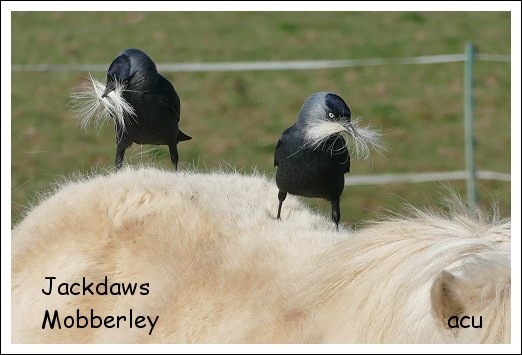 I've been spending a lot of time in the Fox harbour area of Mobberley, where it's nice and quiet, with the easterly winds meaning aircraft are approaching Manchester Airport from the south-west and taking off over Manchester.
I've been spending a lot of time in the Fox harbour area of Mobberley, where it's nice and quiet, with the easterly winds meaning aircraft are approaching Manchester Airport from the south-west and taking off over Manchester.I was down there last Wednesday (2/4) and had a pleasant surprise..........12°C and blue skies with a fairly strong easterly wind which was surprisingly mild. I could see cumulus clouds in the distance over the Pennines. Walked over to Gleavehouse Pool via Pavement Lane, then home through Mobberley SQ.
A pair of Jackdaws were collecting nesting material from the back of a pony in one of the paddocks; both parties seemed to be happy with the arrangement.
Long-tailed Tits at both nest sites, two Shelduck on a small pool on the right as you walk along Gleavehouse Lane, Linnets and Tree Sparrows but no Swallows yet at Blackthorn Farm. Good numbers of singing Skylarks, I was hoping for a Wheatear but non yet. Lapwings calling from the recently sowed fields; I think they're wheat or barley. Whatever it is, it's growing fast.
At the pool a drake Shelduck that looked to be on patrol, joined later by what is presumably its mate. the usual two Mallards plus Moorhen and Coot on the small pond.
A Swallow passed quickly through, followed by a second as I walked towards the SQ. "Best" bird of the day was a Yellow Wagtail, calling loudly as it flew overhead as I progressed along the track towards Mill Lane............... This area is the local stronghold for Yellow Wagtails, let's hope this continues, as we've lost so many species over the years from Fox Harbour.
I had hoped for a Wheatear but didn't have to wait too long ..........."Another beautiful morning. 18°C, peaking at 19.8°C this afternoon.
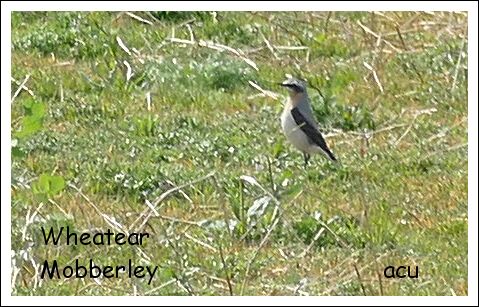 I walked to Gleavehouse Pool but nothing of note, just a couple of Swallows going through and Lapwings in the field behind the obs. I cut the morning short at 11:30am and left for home.
I walked to Gleavehouse Pool but nothing of note, just a couple of Swallows going through and Lapwings in the field behind the obs. I cut the morning short at 11:30am and left for home.Darren Morris had a Wheatear in Tatton Park the following morning (5/4), on the Beech Avenue side of Melchett Mere.
In Knutsford, on the same day (5/4), KOS Secretary Karina Stanley had a Willow Warbler in song - the first of the year.
Geoff and Sheila Blamire took in Mere and Millington on Friday Morning (4/4) ........."As we stepped out of the door the Song Thrush was singing very loudly (as usual), along with a Blackbird, and a Goldcrest! Unfortunately, a lawn mower started up which drowned the Goldcrest song. We’ve seen the Goldcrest bathing at the back of the pond (secluded) with a pair of Long-tailed Tits, while the Chiffchaff baths in the bird bath in full view (2 days in the run).
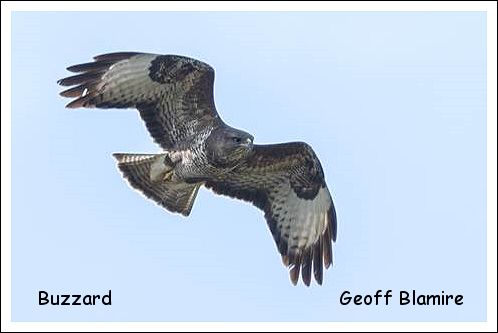 Little Mere: pair of Grey Herons with young but we can't see how many (2024 had 5 young), 3 Egyptian Geese (1 playing gooseberry), and a Great Crested Grebe – hoping that the other one will show itself sometime. Chapel Lane: 10+Meadow Pipits, pair of Buzzards,. Peacock Lane: pair of Red-legged Partridge, 4+ Lapwings (as before the crop is too high to see any sitting birds), pair of Red-legged Partridge (different pair), pair of Skylark (1 singing), 1 Buzzard and pair of Long-tailed Tits. Moss Lane: 3+ Yellowhammers. "...........
Little Mere: pair of Grey Herons with young but we can't see how many (2024 had 5 young), 3 Egyptian Geese (1 playing gooseberry), and a Great Crested Grebe – hoping that the other one will show itself sometime. Chapel Lane: 10+Meadow Pipits, pair of Buzzards,. Peacock Lane: pair of Red-legged Partridge, 4+ Lapwings (as before the crop is too high to see any sitting birds), pair of Red-legged Partridge (different pair), pair of Skylark (1 singing), 1 Buzzard and pair of Long-tailed Tits. Moss Lane: 3+ Yellowhammers. "...........Bob Groom went over to Rostherne on Sunday morning (6/4) and was rewarded with excellent views of a rare bird on the reserve ..........." I did a long stint in the Observatory, which felt surprisingly chilly. No hirundines! Regulars included Buzzards, Stock Dove, LTTs , Chiffchaff, 32 Meadow Pipits and a Kestrel on Cherry Tree Lane and the pair of Goldeneyes still present but the star bird was a female Hen Harrier, white rump clearly seen as it circled briefly (1.45 PM), only the third sighting I've had there in about ten years. Later a Peregrine made a brief appearance.."............
The Blamires, meanwhile, were out and about in Plumley.......""We did a longer walk this morning around Holford and Plumley. The Wigeon have disappeared replaced by 2 pairs of Shelduck. Also Meadow Pipits, Buzzard, Kestrel, many Chiffchaff and Blackcap, etc. Saw two Guinea Fowl – first time we’ve seen them there. The highlight was that House Martins returned to Langford Farm (means we’ve seen House Martin before Swallow!)............
Also on Sunday (6/4) Wendy Stratford visited Astbury Mere, Congleton .........." I went on a Cheshire East Ranger walk around Astbury Mere, at 7:00am; didn’t even know it existed. We had great views of male and female blackcaps (the males were singing most of the time we were there), singing chiffchaff and willow warbler! Reed bunting singing but I didn’t see it. Sand martins flying high and low over the mere most of the time we were there - maybe 30 at max. Good views as it was a crystal clear morning. All the usuals, lots of tufties, gcg, mute swans etc, and nesting Moorhen and coot. As we were waiting to set off a sparrowhawk flew low over the car park. The Ranger mentioned the KOS and the blog several times!"......... Thanks Wendy, the Ranger obviously knows a good thing when he sees it!
Tatton Park is now open on a Monday again and I had a wander round on Monday this week (7/4) .........."The temperature dipped below freezing just before dawn this morning but it quickly warmed up and stood at 8°C when I parked at Dog Lodge.
Lots of Chiffchaffs down on the Moor, a bit too early for Reed Warblers but a Cetti's was belting it out over the far side of the reed beds. On the back pool, noisy Canada and Greylag Geese, Coot, Moorhen, Mallard, Tufted Duck plus Great Crested and Little Grebes.
My first Blackcaps of the year had arrived and were in song in Dog Wood. Siskins seem ready to move on and a dozen or so were in the tree tops in clamorous conversation. The Herons seem to have quite well-grown young, the adults standing guard above the nests. Four Gadwall flew in as I was watching the herons.
From the bench,
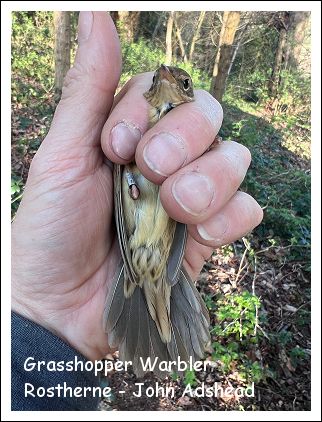 overlooking the old bathing area, I counted 10 Goldeneye - five males and five females. One of the Great White Egrets loped past, heading towards the quieter end of the mere; although the park was quieter than I anticipated, given that it's the school holidays.
overlooking the old bathing area, I counted 10 Goldeneye - five males and five females. One of the Great White Egrets loped past, heading towards the quieter end of the mere; although the park was quieter than I anticipated, given that it's the school holidays.An Oystercatcher flew over calling and four Shelducks flew in from the east and landed on Melchett Mere. No hirundines in the 45' I spent there and, surprisingly, I didn't see a Buzzard, although a male Kestrel appeared hovering over the long grass behind the bench.
On the way out, single Speckled Wood and Orange-tip butterflies were enjoying the sunshine.
I had 40 different species during the morning and was reminded of the Tatton Challenge from the late '70s. It's the right time of the year, if anyone wants to take this up - the most difficult of ornithological challenges!!
http://www.10x50.com/25years/challenge1.htm
I think there was a bit of linguistic license in play there, although Garry Healy did once get to 85 after a dawn to dusk marathon!
Reading through the article I see we had Ruddy Duck and Marsh Tits. Both long-gone now but we'd have been surprised by today's Great White Egret and Cetti's Warbler and, perhaps, Gadwall, Oystercatcher and Shelduck! "..........
Bob was in the Rostherne observatory again, on Monday........" Chilly again in the Ob, did rather too long a stint, initially had John Adshead (too bright for ringing, apparently) and Phil Dell for company. Quite a good list, including the first Sparrowhawk I've seen there for a while. My first singing Blackcap and the regular Chiffchaff but no hirundines.. The Goldeneyes were still there and a drake Mandarin looked very colourful in the strong sunlight. John had a drake goosander earlier. Lots of Buzzards, including one in an encounter with a pair of Ravens. The Long-Tailed Tits were back and to , just a single Goldfinch. 4 Lapwings. Pair of Stock Doves, such an attractive bird but rather overlooked."...........
Geoff and Sheila were also there on Sunday ........."Heard our 4th warbler species from the obs this morning – Willow Warbler, also Cetti’s, Blackcap and Chiffchaff also 1 Whooper Swan and 1 Shelduck on the mere"...........
Late news! Bob mentioned sharing the obs with Phil Dell and John Adshead. John is a ringer and, this morning (9/4), he caught and ringed, under license, two Grasshopper Warblers and two early Reed Warblers!
1st April 2025.........Out and about with the KOS
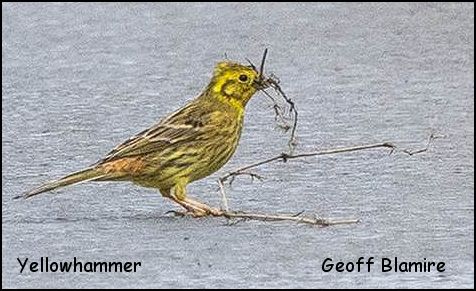 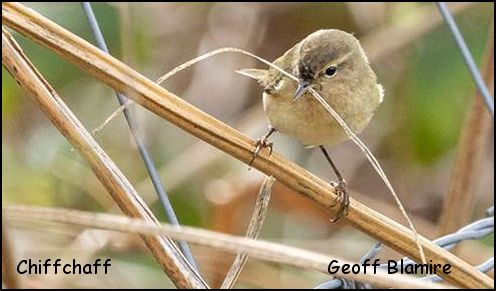 |
Geoff and Sheila Blamire found it hard going in Tatton's Witchcote Wood last Wednesday (26/3)......."We entered Tatton at 8am and got home at 1pm – completely exhausted! We did our 2nd Willow Tit survey and our 1st Marsh Tit survey – meant that each stop (8) took 15 mins plus walking between each stop (never straightforward) and then it took an hour to walk back to the car.
Sorry Darren – but we are starting to hate the wood!!!
So uneven with hidden trunks and branches, mixture of ditches, pools and creeks, if the brambles didn’t get you the hollies and honeysuckles would!
So what about the Willow and Marsh Tit surveys? Zero. Zilch. Nought. But we tried.
Had 2 Treecreepers, alarming Buzzards, many Chiffchaffs, GS Woodpeckers drumming, Jay, singing Blackbird, Song and Mistle Thrushes, etc. But no Goosanders this time.
It was a relief to spend the afternoon gardening. ".........
G&S were in a private part of the park but there's plenty to see in areas open to the public, including the two Great White Egrets that seem to have become permanent fixtures.
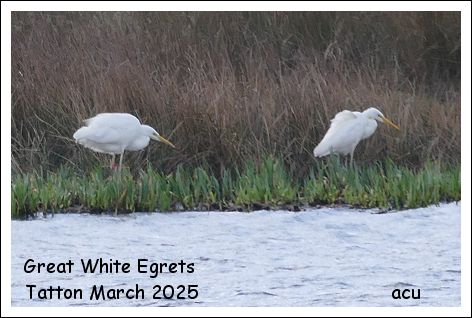 Park ranger Darren Morris keeps a careful eye on them ........."Two great white egrets in Tatton today on Melchett mere. I’m not sure if they are fighting or flirting!
Park ranger Darren Morris keeps a careful eye on them ........."Two great white egrets in Tatton today on Melchett mere. I’m not sure if they are fighting or flirting!They fly around together for a while, seem to endure the company and then squabble (like me and Yvonne)… After a full afternoon of this, later in the day, I noticed one flying back in the direction of Rostherne Mere. I think our male, tagged red AFU, has a prospective mate/enemy who resides at Rostherne."..........
The two Egrets showed well last Thursday (27/3) when I visited the park, before moving on to Mobberley ........" Thursday, early doors, seems a good time to visit Dog Wood. I only met one dog walker but returning later in the morning it was like Crufts again.
Loads of Chiffchaffs but no Blackcaps yet. Although the Blackcaps nest in brambles, they do like rhododendrons to sing from and most of Dog Wood's have been removed. Treecreeper, Song and Mistle Thrushes, Great Spotted and Green Woodpeckers. I spent some time on the bench overlooking the old bathing area, the two GW Egrets were on Melchett and seemed to be the best of friends today! 18°C at 1pm with a light, southerly wind. 25 Tufted Ducks and 6 Goldeneye but no hirundines. I then drove back to Mobberley, parked on Broad Oak Lane and walked over to the disused railway bridge with good views over the various Lapwing fields. Plenty of Lapwings but a bit confusing with birds all over the place, some must now have eggs, though, as they were mobbing any gulls that appeared,
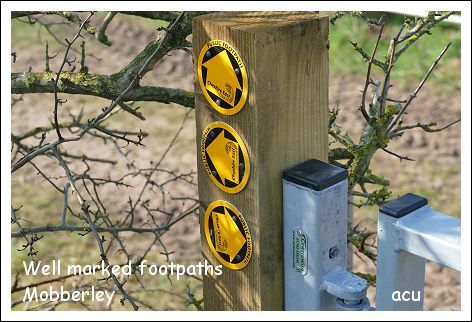 although they seemed to tolerate the corvids.
Yesterday I walked to Gleavehouse Pool, but there was even fewer birds than on Monday. Walking back along the track I turned right, instead of left towards the farm. This brought me out at the top of Damson Lane, coming out near the Roebuck. It was further than I remember and I did 6Km. I was glad of the bench at the top of Mill Lane!
Cheshire East Council struggle with potholes but they do a great job with footpath signs and new kissing gates. ".........
although they seemed to tolerate the corvids.
Yesterday I walked to Gleavehouse Pool, but there was even fewer birds than on Monday. Walking back along the track I turned right, instead of left towards the farm. This brought me out at the top of Damson Lane, coming out near the Roebuck. It was further than I remember and I did 6Km. I was glad of the bench at the top of Mill Lane!
Cheshire East Council struggle with potholes but they do a great job with footpath signs and new kissing gates. ".........The following morning (28/3), having returned from Poole, Wendy Stratford walked over to the Lapwing fields ......."Seven Lapwings feeding in the sheep field, two exploring guinea fowl and some rabbits.
Three in the field by the bridge (can only see a bit of it - there will have been more) and four in the lapwing field, then another four flew in from the south east. The crop is growing so there could be more hunkered down. There was also a grey partridge about half way between me and the hedge.
I went out on another birds of Poole harbour boat trip - best views yet of the white tailed eagle pair - synchronised flying before landing on dead tree. Also summer plumaged black-tailed godwit, ruff, marsh harriers and the famous forster's tern - just arrived back and obligingly perching on several buoys. Apparently it was blown over the Atlantic several years ago and now commutes between Poole and Brittany instead of N and S America. Sounds like a good move…"........
Thanks Wendy. The Forster's Tern is thought to have moved up to Lancashirethis week!
On Saturday (29/3) I gave Gleavehouse Pool another coat of looking at, heard about an interesting sighting and saw my first Swallow of the year .........."I thought I'd give Gleavehouse Pool another try and I'm glad I did. I was approached by a lady with two very boisterous dogs. She told me that her and her husband do the gardens at Lake House. I don't know if they are gardeners or they live there - it's very posh!
Anyway she had a picture on her phone of two birds they'd seen on Mobberley Brook this week. That's the one that flows past the Victory Hall and joins the Birkin Brook near Birtles Farm, eventually flowing into the River Bollin, on the way picking up the overflow from Rostherne Mere via Blackburn's Brook. The picture showed a male and female Goosander. That's the first I've heard of on Mobberley Brook.
Just after she'd moved on, a Swallow appeared, did a couple of circuits of the pool before gaining height and heading north. My first of the year.
A Little Grebe was also a surprise; it appeared from nowhere and seemed quite at home.
Lapwings chasing any corvids that appeared was encouraging. "........
On the same morning, Geoff and Sheila had a rewarding time at Rostherne Mere ........" Very eventful morning! We watched a Chiffchaff building a nest just to the right of the entrance to Wood Bongs.
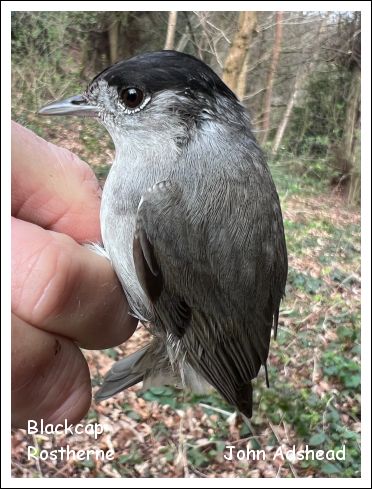 We were standing on the path but it wasn't very happy with us, so we quickly moved on. There was a Blackcap singing in the wood. Previously I heard a brief Blackcap at the Mere end of Ciceley Mill Lane. Not much on the mere – one male Goldeneye, 4 Sand Martins flying through, usual singing Cetti’s and Chiffchaff, etc. We were keeping an eye on the clock to witness the partial eclipse – standing by the gate about 10.40am we saw a big bite out of the sun (wearing proper eclipse viewers). We left just before 11am but a big cloud obscured the sun at 11.10. But little later it cleared – approx. 40% eclipse? Heading home and just before Ciceley Mill Pond a Red Kite drifted low across the lane, before gained height and disappeared in view!"............
We were standing on the path but it wasn't very happy with us, so we quickly moved on. There was a Blackcap singing in the wood. Previously I heard a brief Blackcap at the Mere end of Ciceley Mill Lane. Not much on the mere – one male Goldeneye, 4 Sand Martins flying through, usual singing Cetti’s and Chiffchaff, etc. We were keeping an eye on the clock to witness the partial eclipse – standing by the gate about 10.40am we saw a big bite out of the sun (wearing proper eclipse viewers). We left just before 11am but a big cloud obscured the sun at 11.10. But little later it cleared – approx. 40% eclipse? Heading home and just before Ciceley Mill Pond a Red Kite drifted low across the lane, before gained height and disappeared in view!"............Rostherne ringer, John Adshead caught 13 Chiffchaffs in March, including a returning bird from last year. Yesterday (31/3) he and fellow ringer Malcolm Calvert caught the first Blackcap of the year (see picture).
Geoff and Sheila seem to be doing well for Yellowhammers, we appear to have lost ours in the Fox harbour area of Mobberley ........."Did a 12km walk around Millington area this morning (31/3). These are the highlights. Peacock Lane: male Linnet, female Yellowhammer and another singing out of sight, 4+ Lapwings (the crop is too high to see sitting birds). Moss Lane: 2 pairs of Yellowhammers with one female collecting nest material (see photo) and singing Skylark. Millington Lane: 1m 1f Yellowhammer and Buzzard. Millington Hall Lane: singing Blackcap and another Buzzard. Plus numerous Chiffchaffs around the area. ".........
KOS Secretary Karina Stanley also took advantage of the beautiful spring weather yesterday ........."Out for a stroll today. Along with a nice range of finches and buntings: Linnets, Chaffinches, Goldfinches, Greenfinches and Yellowhammers (1pair) and a male Reed Bunting; there were 3 singing Skylarks; 4 singing Chiffchaff; a pair of Buzzards - 1 very pale;~ 7 Lapwing- 2 displaying, and a pair of frisky Kestrels who were ‘messing around’ on a pylon and then proceeded to mate on top of a small tree right in front of me. Never seen that before. The noise!
Butterflies- a small tortoiseshell, a peacock and several cabbage whites. ".......
Karina has circulated an email amongst KOS members, reminding us of forthcoming events in April.
"Our next trip is to SSSI Woolston Eyes Nature Reserve on Saturday April 12th. Use WA4 1PD for Sat Navs. Meet at the first locked barrier at 10 am.
Non-permit holders for Woolston Eyes are welcome to join us as KOS has paid a £20 deposit for the visit. Non-permit holders are charged £3, but permit holders are free to enter and have the magic keys to open the locked barriers.
We’ll go to No 3 bed and check reports to see if No 4 is worth visiting nearer the time. Recent reports show that No 4 has had quite a few pairs of Black- necked grebes. It’s a long trek round though. Bring a lunch and your key if you have one.
Please let me know if you're planning on coming as I’m designated leader for this trip. Thank you. karina.stanley@ntlworld.com
Apr 25 Fri AGM and MEMBERS’ IMAGES 8pm As you know, our AGM is at the end of the month. It would be great to see you there. No charge for the AGM!
This year our indoor evening meetings have been incredibly well attended; it makes such a difference. Thank you for your commitment to KOS and we hope you will continue with your support. No increase in membership charges.
See you in the Jubilee Hall, Stanley Road, Knutsford WA16 0GP
All the best
Karina "
Some rather disturbing news from Bob Groom, following a trip to Burton Mere Wetlands on Saturday (29/3) ........" Today Matt drove us to Burton Mere in my car. Bitter wind and later rain. Very disturbing, you'd expect it would be busy as a Saturday but Reception was locked and the cafe was closed. No buggy so couldn't get very far. Peregrine, usual good views of marsh harriers, a party of whooper swans, ruff, redshanks, BTGs, Avocets, Shelducks, a single Great White etc.. A number of Swallows went over. Brief view of a Cetti's. We had to leave early to get warm as no hot coffee available on site. One fears for the future of the reserve..."
25th March 2024 ...... Another first!
They say that one Swallow doesn't make a Summer, but it can make a birdwatcher's day, as Bob Groom found out on Monday (24/3)!..........."I noted in the obs log that Mike Duckham had earlier seen a Swallow and shortly afterwards saw one myself, my first of the year. Phil Dell had logged a marsh harrier yesterday but I only saw Buzzards. There was a largish raptor being mobbed at one point that looked to have some lightness on it but it was in the haze well beyond the red house and never approached the mere so remains in the category of wishful thinking. A female Reed Bunting hung around for some time looking very attractive.. Regulars included Heron, Nuthatch, 2 (promising) Coal Tits.. A male Goldeneye still graced the mere and a Cetti's was very vocal at the mereside."..........
Well done, Bob - right place and the right time!
Sheila Blamire has recovered from her recent cold and she and Geoff were out and about again last Thursday (20/3) with a 7 miler ..........." We walked around Millington area this morning – 11.5km – the most I’ve walked since I started with my cough/cold 4 weeks! Brilliant morning. The highlights were: 15 displaying Lapwings in the sky at the same time; 3 sightings of Long-tailed Tits including party of 4 birds – they seem to be doing well this year; female Linnet same in the same area as the
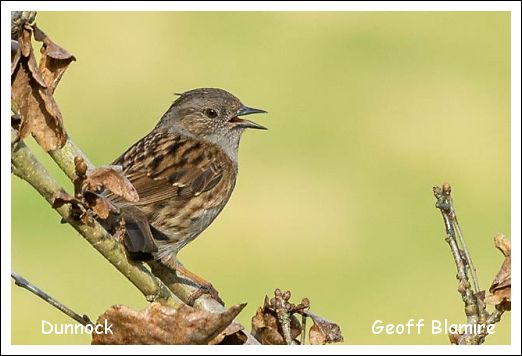 Lapwings; several singing Chiffchaffs; Grey Heron still sitting tight (using last year’s nest) at Little Mere – I know that breeding Grey Heron isn't particularly special but when it’s on your patch and they managed to fledge 5 young last year starting so late (June) it’s special. Also, a pair of Egyptian Geese tried to take over the nest beginning February – fortunately the Grey Herons "booted" them off. Fingers crossed for this year.
Our Song Thrush starts singing very early in the morning and late in the afternoon – every day without fail. The trail cameras in the garden are revealing a pair of foxes, hedgehog and wood mice.
"...........
Lapwings; several singing Chiffchaffs; Grey Heron still sitting tight (using last year’s nest) at Little Mere – I know that breeding Grey Heron isn't particularly special but when it’s on your patch and they managed to fledge 5 young last year starting so late (June) it’s special. Also, a pair of Egyptian Geese tried to take over the nest beginning February – fortunately the Grey Herons "booted" them off. Fingers crossed for this year.
Our Song Thrush starts singing very early in the morning and late in the afternoon – every day without fail. The trail cameras in the garden are revealing a pair of foxes, hedgehog and wood mice.
"...........Plenty of Lapwings for G&S and also for Wendy Stratford in Mobberley on Friday (21/3).........."I have walked down to see lapwings every day and it's been pretty consistent - eg today there were 5 feeding in the ex-sheep field, 3 on the lapwing field (one on scrape as usual) and 6 as far as I could see on the field between lapwing field and railway. In addition there were between 6-10 flying around, often displaying and calling. There seem to be territorial disputes in the field with the most birds in. Also 2 bumble bees and quite a few honey bees this week, heard a chiffchaff singing several times in the lane and watched nervously as all 11 guinea fowl crossed the lane! ".............
The Guinea Fowl Wendy refers to belong to a house further down Smith Lane. They're free range - very free range and wander the whole area, including the road with impunity.
I found this online, Wendy - ......"The meat of young guineas is tender and tastes like that of wild game. The meat is lean and rich in essential amino acids."....... Something to bear in mind!!
Wendy was out again on Sunday, her birthday, and what better way to celebrate than with a stroll down to Gleave House Pool!.........."The LTT nest looks very good - toned in now, no sign of any activity. Skylarks up - at least 3 over Gleavehouse field, probably another 3 over skylark field and another 3 behind obs. At the pool 2 lapwings flew over east to west as I arrived. 3 teal flew up, 2 shelduck resting, 2 canadas swimming, 2 pied wagtails on shore. When I left I realised there was 4th teal still on the north shore (north of fence line). A buzzard circled high over SQ, low flying kestrel over field, and a tree sparrow in pavement lane. "...........
Thanks Wendy, lets hope the Shelduck nest there again, as they did in 2021, 2022 and 2024. In 2023 the Black-bellied Whistling Ducks beat them to it!
I walked down to Gleave House Pool on Monday morning (24/3) Nothing much there but I did have a nice surprise a little further on ......"This morning I walked to Gleavehouse Pool via Goostrey's, where I availed myself of a warm sausage roll that was enjoyed while sitting in the obs.
I'd taken a pair of gardening gloves and secateurs which were used to remove some of the encroaching brambles and hawthorn from around the obs, ensuring a more comfortable experience for GHP aficionados.
A large flock of winter thrushes from the path leading from the thatched cottage at the top of Mill
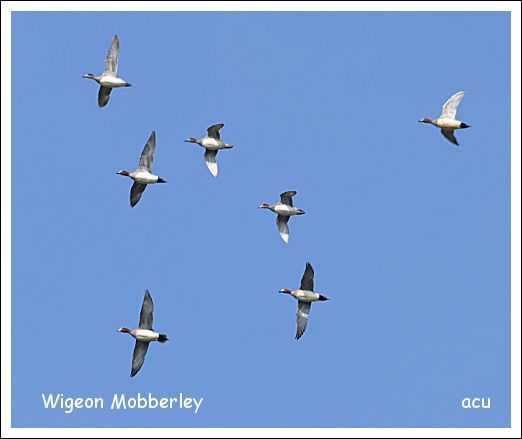 lane, both species. Skylarks in song but just one overflying Lapwing, some of the fields had been ploughed and tilled ready for planting / seeding so any lapwings that had started nesting would have to begin all over again.
lane, both species. Skylarks in song but just one overflying Lapwing, some of the fields had been ploughed and tilled ready for planting / seeding so any lapwings that had started nesting would have to begin all over again.The pool was disappointing today, just a couple of Mallards, Coot, Moorhen and an overflying Oystercatcher. Suitably refreshed by the sausage roll and a can of diet coke I decided to follow the route we took on the KOS evening walk last summer.
Two Chiffchaffs by the bridge over Pedley Brook, I counted 6 in song during the walk. The barn-like buildings at the top of the rise up to the top path must be owned by some sort of commercial organisation. It has large picture windows that overlook the well-tended grounds and the small pool that has been extended and is obviously well looked after too, there is even a barbecue positioned in the trees overlooking the water. It was attracting plenty of birds, with 30 Canada geese, 7 Lapwings, two Teal and I was amazed when a flock of 22 Wigeon appeared. They did a few circuits of the area before landing on the pool.
Nothing else of note but I did see Buzzard and Sparrowhawk. Along Gleavehouse Lane the Long-tailed Tits' nest is complete and the ever-present Tree Sparrows were very active.
4.9Km, 3 hours and 40 species.".........
Geoff and Sheila's Wigeon are still with them, this from Sunday (23/3)........."We walked around Holford and Plumley this morning: no sign of Curlews sure they've left for their breeding grounds, Wigeon still present and Little Egret with them, 2 new field pools after the rain yesterday held a single Teal, pair of Coots and 120+ Black-headed Gulls, around the area c6 Chiffchaffs, Jay, 2 GS Woodpecker, 8+ Goldfinches and finally pair of Oystercatchers by Langford Farm – a quite common occurrence there. Unusually no raptors until one Buzzard seen over The Smoker."...........
Yesterday I received a nice text from Phil Rowley, down in Staffordshire......."I had a good 5+ hours at Belvide yesterday from 8.30AM
I walked to the furthest hide at the west end of the reservoir with Chiffchaff, Song Thrush, and Skylark singing.
With the hide to myself, there were 5 Yellowhammer close by in the budding Willows and a single male Linnet in the scrub in front of me.
On the water were lots of Pochard, Teal, Shoveler, Tufties, Gadwall, Goldeneye, Mallard, coots etc with Mute Swans and Grebes courting, one grebe I saw catch the smallest of Pike, a predator in miniature and on the North bank a Grey Heron snaffling up a mole!!!!
Noting..
3 Great White Egret
2 Dunlin
1 Little Ringed Plover
16 Sand Martin
2 Swallow
1 House Martin
I missed out by 15 mins on the 8 Kittiwake and 2 Sandwich Terns, but a most enjoyable few hours".........
Thanks Phil for a nice report from Belvide, a reserve we'll be visiting on May 11th this year.
Before then though it's our March indoor meeting this Friday (28/3) as our Secretary, Karina reminds us.
Friday March 28th : 8pm ‘Vibrant Sri Lanka: Blue Magpies, Blue Whales and Blue Skies’. Ashley Grove. Jubilee Hall, 18 - 24 Stanley Road, Knutsford WA16 0GP. 8pm but come beforehand for a bit of socialising.
Vibrant, diverse, beautiful... whichever way you choose to describe this amazing little country, it's very hard to do it justice with just pictures. However, this talk will give you an insight into the prolific wildlife of Sri Lanka. With such varied habitats and landscape, from lush forest to arid salt lakes, it's no wonder this country holds such wonders. Blue Whales, Leopards, Elephants, hundreds of bird and butterfly species, many of which occur only here. We will take a journey with Ashley to many of the top locations and discover the wildlife to be found at each, so bring your sunglasses, it's going to be a colourful one.
Our Treasurer Frank will be available to take any Membership monies (staying at £20) and has kindly agreed to introduce the speaker for me as I will be away.
April sees the final outing of the 24-25 programme to Woolston Eyes on Sat 12th. I'll be leading this trip and will give out details later.
Thank you for your continued support.
All the best
Karina
20th March 2025 ....... Leighton Moss.
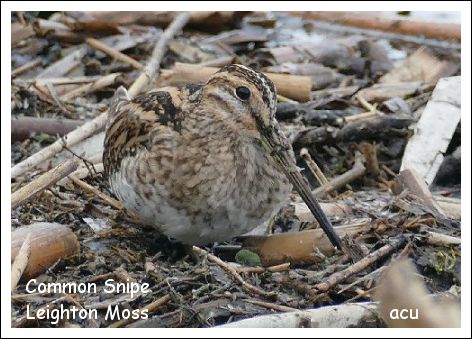 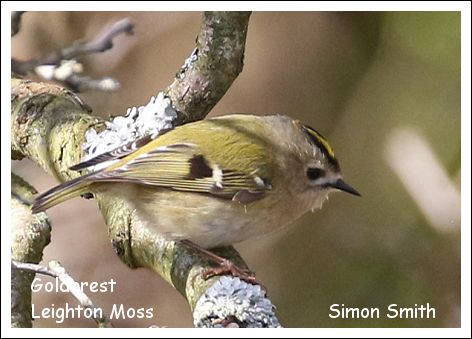 |
A pleasant morning on Saturday (15/3) for what's become our annual spring trip up to the RSPB's Leighton Moss nature reserve. My weather station showed an overnight temperature of -1.0⁰C rising to 8⁰C during the day, cool but quite acceptable.
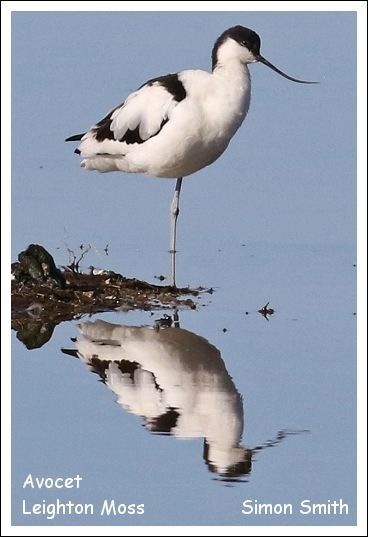 Having made good progress up the M6 we stopped en route at Warton Crag, home in the past to a pair of Peregrine Falcons. No sign of Peregrines on Saturday though, just flocks of noisy Jackdaws and a lone singing Chiffchaff.
Having made good progress up the M6 we stopped en route at Warton Crag, home in the past to a pair of Peregrine Falcons. No sign of Peregrines on Saturday though, just flocks of noisy Jackdaws and a lone singing Chiffchaff.For a change, this year we opted to visit the Allen and Eric Morcambe hides first, before moving on to the main reserve.
The pools in front of the hides were busy with birds - Shelduck, Wigeon, Teal and Shoveler in the immediate foreground and large flocks of Pink-footed Geese in the distance. Plenty of waders too - Avocets had returned in good numbers but on this occasion they were outnumbered by Common Redshanks, there was apparently a Spotted Redshank somewhere amongst them but we failed to find it. Single Black-tailed Godwits and Common Snipe plus two Dunlin were added to the rapidly expanding day list, as were Grey Heron, Little Egret and a Great White Egret.
The main car park at the reserve was chock-a-block when we arrived at about 11:30am but it's a big reserve and there's always room in the hides. The lower hide was closed for refurbishment and was due to open on Monday; from a distance it looks to be an impressive addition to the facilities. As usual our first port of call was the sky tower with its excellent views across the whole of the reserve. Surprisingly few wildfowl were on view, but careful scanning revealed Coot, Moorhen, Little Grebe, Great Crested Grebe, Pochard, Gadwall, Canada goose, Pintail and Goldeneye. A Goldcrest and a Treecreeper were welcome additions to the list as was just the faintest sound from a distant "booming" Bittern. These NHS hearing aids are excellent!
Cetti's Warblers and a Water Rail were heard as we walked down to the Jackson and Grisedale hides, good views of Marsh harriers in flight from the Jackson hide but little else although Bob Groom who arrived there later met two very competent ladies of a certain age and they were able to put him onto a Jack Snipe lurking in the reeds. News of this bird only reached the main party when they were in the Causeway hide, nevertheless those with sufficient energy walked all the way back to add this bird to their lists. Dedication!
Walking back from the Causeway hide a Bittern surprised us with a loud BOOM! from just a few yards away. Everyone present heard it this time! The list of species, seen or heard, stood at 60 when it was circulated in the evening and subsequently rose to 66 after everyone had been able to consult their notebooks. Great effort team and thanks to KOS Secretary Karina for acting as leader for this trip - a job well done.
While we were at Leighton Moss, Maria Freel stayed closer to home and enjoyed a wander down to Tatton Park's Melchett Mere from her flat in the park's mansion house .........Had a lovely morning on Melchett mere. No sign of the chiffchaffs calling yet, down in Somerset they've been calling since at least the 4th of March. At the mere, I was greeted immediately by a male goosander flying overhead. It was nice to see some redwing still about in a large mixed flock of starlings and thrushes. The last vestiges of winter ducks still clinging on with a trio of goldeneye and a few more pochard. Interestingly two teal very early on scooted out of sight quite quickly. A couple of pairs of stock doves were flapping about in the trees by the Allen hide, and a male GSW graced me with his presence on the feeders. Two reed buntings were in the trees over the edge of the mere, along with all the usual suspects. By far the highlight were the 15 snipe tucked away around the edge of the mere. Lovely stuff. .......... Thanks Maria, a nice report.
Bob Groom was out and about the following morning doing the WeBS count with Pete Kelly, who will be taking over the count when Bob finally retires ......."Pete and I did the monthly count. Several Buzzards, I had a Raven, Pete a single Sand Martin, just one Cormorant and one juvenile Mute Swan, no egrets but the Heronry was in full
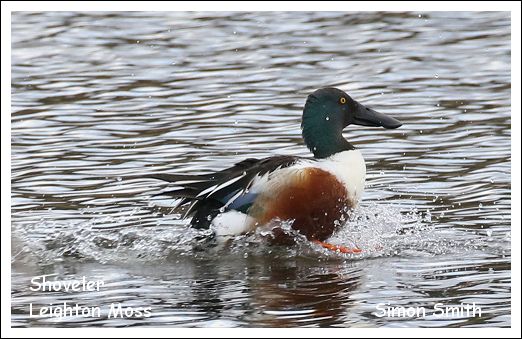 swing. 2 Oystercatchers on Tower Island. 7 Great Crested Grebes 6 Mandarins a highlight. 4 drake Goldeneyes plus females. 3 Pochard, 2 Gadwall, 2 Teal. Cetti's heard. Pete had 2 chiffchaffs."..........
swing. 2 Oystercatchers on Tower Island. 7 Great Crested Grebes 6 Mandarins a highlight. 4 drake Goldeneyes plus females. 3 Pochard, 2 Gadwall, 2 Teal. Cetti's heard. Pete had 2 chiffchaffs."..........Geoff and Sheila Blamire were also on the go on Sunday morning (16/3) ........" We had the same flock of Wigeon as last Sunday (9/3) - 45/44 but again no Curlews – last time we saw them was 1st March. We also had a pair of Egyptian Geese by Inovyn Offices – one was limping and one of the wing feathers was sticking out – had been injured somehow? Also Chiffchaffs, Buzzards, Great Spotted Woodpeckers drumming, etc."..........
Monday morning (17/3) and they were out again ......""We checked the Millington area this morning: 15 Lapwings in 3 different fields (2,11,4) where they bred last year; 15+ Fieldfares; 80 Starlings; 1 Kestrel; 3 Buzzards; 2 Skylarks singing.
Looking forward to warmer weather – it was cold this morning as Tony remarked!..........
Yes, it was a bit nippy on Monday morning: I'd walked from home to a vantage point overlooking the Mobberley Lapwing fields ........"I went over to Broad Oak Lane and across the fields to the disused railway bridge. LTT nest, that looked complete, with both birds in attendance. Redwings and Fieldfares very active.
As Wendy pointed out, good views of the adjacent fields from the bridge. The field normally used by the Lapwings had 4 pairs, but none looked to be incubating yet, as they only start to sit tight when the clutch is complete because all the chicks need to hatch at the same time.
A second field adjoining Broad Oak Lane held a pair and a third field that has been ploughed had 15 birds in a loose flock, although there was some display and calling from a couple of them.
A bit cold."..........
Jude Halman and I completed days 3 and 4 of the Willow / Marsh Tit survey on Wednesday (19/3) and today (20/3). Knutsford Moor / Dog Wood on Wednesday and Sandmere this morning ........" A cold start (-2°C) but above freezing as Jude and I set off for the Willow / Marsh Tit survey on Knutsford Moor and Dog Wood.
Both calls played today, separately of course, but no responses from anything!
2 or 3 Chiffchaffs in song, GS Woodpecker, 3 Treecreepers, Great White Egret flushed as we approached the heron viewpoint. Jude counted 10 active herons' nests.
Sandmere tomorrow.".........
And Sandmere it was, this morning. Summarised by Jude ........" This morning visiting Sandmere for the Willow/Marsh Tit survey.
The weather was perfect, Brimstone butterflies on their first flight were in abundance.
Three Redwings perched high on the top of the Silver Birches.
No response from Willow/Marsh but, when playing the Willow Tit song, Great Tit, Long-tailed & Coal Tits soon appeared, this didn't happen with the Marsh Tit song.
Buzzard, Jay, Magpie, Chiffchaff, Great Spotted Woodpecker, lots of Dunnocks, Great Crested Grebes plus the usual.
Thanks Tony, another visit in mid-April, when the survey ends. ".........
Rostherne Mere was visited by 20 Whooper Swans on Sunday (16/3) and, this morning (20/3) ringer John Adshead had good views of a female Marsh harrier floating over the reedbeds. The Whoopers had moved on the following morning when Ken Davies and I spent a couple of hours in the reserve's observatory .........." It was a good morning and Ken's list reached 40 by the time we returned to the cars.
Shoveler 2, Goldeneye 6 (3 pairs), Sparrowhawk, Buzzard, Wigeon 12, Cetti's Warbler - one in song all morning, Great Spotted Woodpecker drumming, a pair of Bullfinches - the male looked spectacular in it's spring finery, c. 20 Sand Martins, good numbers of Lesser Black-backed Gulls passing through, Chiffchaff in song, a pair of Long-tailed Tits, three Ring-necked parakeets flew over as we left - what wonderful fliers! "...............
Species recorded on the KOS trip to Leighton Moss on Saturday 15th March 2025 |
The First Sand Martins duly appeared in Tatton Park on Monday 10th March with five, found by park ranger Darren Morris as they hawked for insects over Tatton Mere
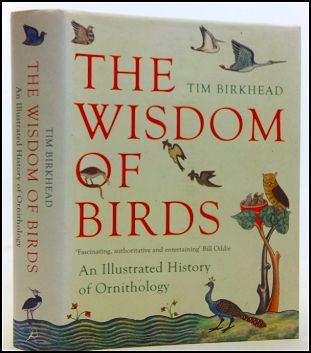 at 3:12pm; five days earlier than last year.
at 3:12pm; five days earlier than last year.No entrants to the 2025 Sand Martin competition chose the 10th, nor the preceding two days, so the winner was one of the four people who went for the 11th. Olwen Usher came 3rd (11:11), Hugh Pulsford 2nd (10:32) but the winner was Caroline Williams (10:16) and she will receive a signed copy of "The Wisdom of Birds - an illustrated history of ornithology" written by Tim Birkhead. Caroline also won the 2022 competition - KOS members must try harder!
The first returning Chiffchaffs are also back with us and in good numbers too. Again it was Darren who heard the first of the season as he travelled to work early on the morning of the 7th March ......."There's been a little egret along the stream from Tatton Mere towards the Old Hall.
I counted 11 active herons' nests today at Higmere, so slightly down on numbers.
A few stonechat in the deer sanctuary.
A singing chiffchaff on Knutsford Moor this morning as I was cycling in too.
Two kingfishers on the fence by the bird hide very active and calling plus another two down at the Higmere end of the mere.".........
Thanks Darren, we'll miss your records when you retire!
Karina Stanley also heard Darren's Chiffchaff plus another couple as well ......"Spied a pair of Hares today in Ashley. Managed to get a record shot of the one in pursuit. Could hear them "grunting" to each other.
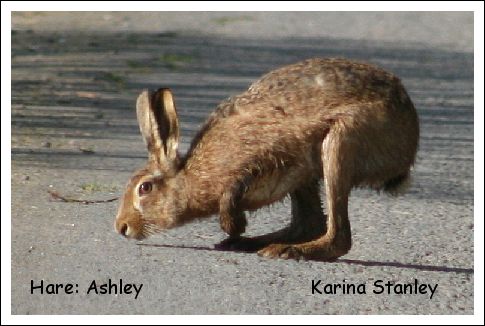 Also saw a Comma and a Small Tortoiseshell butterfly in the bramble patch by Dog Wood yesterday. In Tatton (in addition to the birds seen by others this week on Sand Martin duty), I saw a beautiful female GSW , heard GW yaffling in the horse field, Nuthatch calling all around and listened to the delightful soft call of a male Stonechat (saw 2 pairs). Darren's Chiffchaff was singing away- we had one here on Blackhill Lane yesterday and another in Ashley today before the Hares arrived.
"........
Also saw a Comma and a Small Tortoiseshell butterfly in the bramble patch by Dog Wood yesterday. In Tatton (in addition to the birds seen by others this week on Sand Martin duty), I saw a beautiful female GSW , heard GW yaffling in the horse field, Nuthatch calling all around and listened to the delightful soft call of a male Stonechat (saw 2 pairs). Darren's Chiffchaff was singing away- we had one here on Blackhill Lane yesterday and another in Ashley today before the Hares arrived.
"........Geoff and Sheila Blamire were also out and about on the 9th and ticked off their first Chiffchaff ........." We did a short walk around Inovyn and Holford this morning (I’m still not good). Cape of Good Hope Farm (I like the name) there were 44 Wigeon on a small pond – unfortunately we flushed them so it was an correct count (we had 35+ on 1st March). The usual Buzzard there as well. Great views of a hare. Heard our first Chiffchaff on the wood by the railway crossing. Pair of Egyptian Geese on the field north of small roundabout Chester Road on the drive back."..........
I was on Sand Martin patrol on Sunday (9th) ........" The temperature at noon peaked at 18°C and it certainly brought the crowds out in Tatton. I don't remember seeing so many folk out and about since the covid restrictions were first lifted in 2021. (It's 5 years ago today when we were told "You must stay indoors"!)
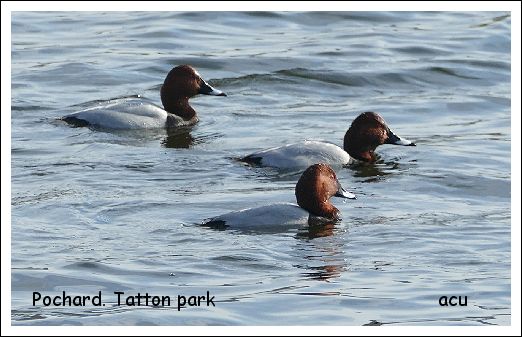 No Sand Martins, just the usual wildfowl including Pochard, Tufted Duck, Goldeneye. A Great Spotted Woodpecker called from Dog Wood, as did a Green Woodpecker.
No Sand Martins, just the usual wildfowl including Pochard, Tufted Duck, Goldeneye. A Great Spotted Woodpecker called from Dog Wood, as did a Green Woodpecker.On the way to Tatton I stopped off along Smith Lane, where I heard my first Chiffchaff of the year and also a GSW in the distance. No Lapwings on the two big fields opposite Smith Lane Farm but I could see birds in tumbling display flight across the other side of the railway."........
Wendy Stratford had a closer look at the Lapwing fields the following morning (10/3) .........." Walked around the lapwing fields this afternoon, crossing the railway line twice - the red light warning siren is very loud! Good view from the old bridge of the field between there and the lapwing field.
In total there were 8 lapwings in the field between the lapwing field and the railway line (and meadow pipits again). one in the lapwing field on the "scrape" in the middle - might be sitting?
Over the far side of the railway line there were 10 lapwings on the ground, at least one looked to be sitting. The field has been turned over but no sign of anything growing, and quite large areas have been left as grass - maybe for the lapwings? There were no lapwings in any of the other fields that side of the railway. While I was watching the far field some of the birds flew up and joined others that flew in from the south - there were 19 in total, calling but not displaying. Flying in quite a tight group they circled and flew south.
Also saw 3 buzzards calling and interacting over the fields. ".............
When not in Tatton on Sand Martin duty Bob Groom also paid a couple of visits to Rostherne Mere. On Saturday (8/3) he had a tantalising glimpse of what could have been a Lesser Spotted Woodpecker ......."OBSERVATORY - Simon had a chiffchaff but I missed it. Also a Mandarin. Sparrowhawk, Buzzards, LTT. Goldcrest, 2 Goldfinches, 2 Stock Doves, 5 Goldeneyes etc. - and what might have been a small woodpecker but it was too elusive for us... No sand martins.."..........
He was at the same location again this morning (12/3) ....... "Visited the Obs. Through his 'scope Phil picked up c.dozen Sand Martins low over the raft of Wigeons. Not easy to make out. My first.. 2 Great Spots, 2 Stock Doves, Heron, Long Tailed Tit, Buzzard, Goldfinches.. Sheelagh Halsey logged a lesser spotted yesterday! Later I had my first sighting of a Little Egret on the patch (from Moss Lane). Pair of Lapwings buzzing a Buzzard over newly ploughed field.".......
It looks as though Saturday's small woodpecker could have been a lessepecker, Bob. Tick it off!
I had a text this morning from Phil Ashley with news of a pair of Grey Partridge at Gleave House Farm. I went over to have a look but they weren't about; they used to be quite common in that area but I've not seen one there for many years.
6th March 2025 ........ Waiting for our summer visitors.
Last Saturday (1st March) was the start of the meteorological spring and, this year, the spring equinox falls on the 20th March at which point the days become longer than the nights. Of course, for the members of the KOS, spring actually starts on the day that the first Sand Martin of the year is seen over either one of the two Tatton meres (Melchett or Tatton).
Despite our best efforts there have been no sighting yet, although they are about, with records from Woolston Eyes and Budworth Mere, so we should get one in the next few days!
Bob Groom was in the park last Thursday (27/2); no Sand Martin but he did come across the long-staying Great White Egret ........."The Great White Egret was at Melchett Mere (far side) again today. Also Cormorants, Heron, Raven. Only a few ducks but a drake Goldeneye was the star, to be appreciated as will be gone in a few weeks time. Kestrel near Tatton Mere and a surprisingly small Buzzard, appearing no bigger than the Carrion Crow that was having a go at it. Female Great Spotted Woodpecker on feeders."...........
As Bob points out the Goldeneye and the rest of the wildfowl that winter with us will soon be heading north. It's a time of change as our summer visitors begin to return and species like the Goldeneye leave us until the autumn.
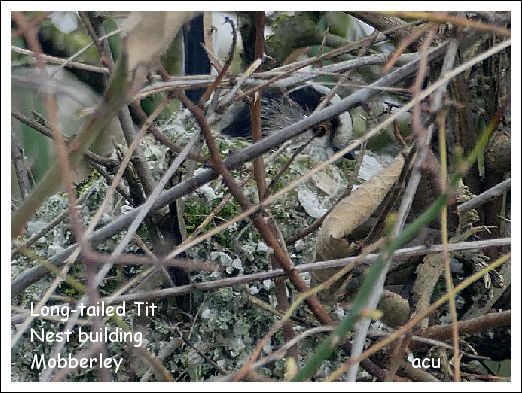
Some of our resident birds are already nesting - the Grey Herons in Tatton's Higmere Plantation are on eggs and this week, in Mobberley, I've watched Long-tailed Tits building their beautifully intricate domed nest, constructed of lichen and cobwebs, and lined with feathers (up to 1500, apparently). The nest in the photo is quite advanced and the birds were returning with material and wriggling about in the cup to persuade it into shape. Shortly the dome will be added and the nest lined with feathers ready for up to a dozen, tiny eggs. As well as the still images I also managed a rather shaky video as one of the birds was shaping the bottom of the nest https://www.youtube.com/watch?v=mEi4qwwLQZQ
This Long-tailed Tits' nest is on Gleavehouse Lane and I'd found the start of a second the previous week nearby, on Pavement Lane ........"I took a short walk at 3pm round the Pavement Lane area. Quite cool, just 7°C with bright sunshine. A Buzzard showed well followed a short time later by a Red Kite! Last week I met a young chap on a bike at about the same time and he said that he'd stopped because he'd just seen a Kite.
I watched a pair of Long-tailed Tits moving through a hawthorn hedge to a spot they seemed very interested in. On further investigation I could see the start of a nest, the very early stages - a platform made from moss. One to keep an eye on. "...........
Long-tailed tits are unconcerned by the presence of human onlookers whilst they are constructing their nests, so I was happy to share the location with local birders. Wendy Stratford took a look the following morning on her way over to Gleavehouse Pool ..........." Thanks Tony, you are right - it was almost glowing in the hedge!! (And the arrow in the photo helped!) Both birds were there.
Had a lovely walk - cool at first but it warmed up. Kestrel preening and splaying its tail feathers in one of the oaks as you enter the first field. 2 skylarks up singing over Gleavehouse house field, 1 over skylark field and 1 almost directly above the Obs! At the pond a lapwing flew up from the 'headland' near the Obs as I approached - no other birds apart from a pied wagtail. 25 young cows entered the field from the bottom end (footpath roped off there) and gathered on the south shore to drink.
As I walked out of the pond field (there is a new gate now) these were 3 lapwings in the field through the gate on the right - flying up and down out of the stubble. 3 skylarks on the ground in the skylark field - crests and tails up!
I walked down Smith Lane past my house to the next field down. Surprised to see 46 redwings feeding, and also 4 lapwings and 2 mistle thrushes feeding together further down. There were 6 Meadow Pipits as well. "...........
Last Friday (28/2) we welcomed professional photographer Mark Sisson to the Jubilee Hall for our monthly indoor meeting. His talk was titled "Wild Islands: the Nature of the Falklands". Over the past 50 years I've sat through 100s of lectures - good, bad and indifferent: this was one of the best I can remember! He began his photographic career as a 14 year old using a Pentax film camera and so became used to carefully considering an image's composition before pressing the shutter release button. This was evident in the images he showed us on Friday, they were exceptional - let's hope Sheila will book him in for a return visit!
Geoff and Sheila were out the following morning (Saturday 1/3) and again on Sunday (2/3) ............." We covered the Plumley/Holford area Saturday Morning. Inovyn offices field: 5 Curlews; Cape of Good Hope Farm: 35+ Wigeon, Kestrel, Buzzard; Plumley Lime Beds Wood: 6 Redwings; Holford: male Stonechat, Yellowhammer, Stock Doves on one of the 2 Barn Owl boxes; Langford Farm: 2 Oystercatchers.
Sunday morning did a quick walk to Rostherne. Rostherne Obs: very few wildfowl on the mere but nice to see a male GS Woodpecker drumming. Mere: 40+ Fieldfares, Greenfinch singing, c10 Rook nests and the usual species on Little Mere including Grey Heron sitting tight on the nest (no sign of the Egyptian Geese – last seen on Friday), 1 Great Crested Grebe. "...............
The team were out again on Monday (3/3) but Sheila's cold began to take its toll ............"Did a slightly shorter walk around High Legh and Millington but still over 11km so I had to sit on a wall on Mereside Road while Geoff got the car to fetch me. I thought I would ignore the effects of my cold but……. I actually lay on the bed for over an hour!!!
Chapel Lane: 11 Lapwings on the left field before the bridge and 2 on the left field after the bridge, c40 Redwings and a few Fieldfares and Buzzard.
Peacock Lane: 10 Lapwings, include display, then the next field 12 Lapwings.
Total number: 35 Lapwings.
Moss Lane: Skylark singing.
Agden Lane: Buzzard sitting on a pylon.
Couldn’t walk to Millington Lane and Newhall Farm to check on the Skylarks there – do that another time. "............
Bob was out on Sand Martin patrol again in Tatton on Tuesday........." Grabbed an hour before duty. The sun was nice but the wind wasn't. The Great White again at Melchett; at one point it stood tall and flapped its wings, spooking half-a-dozen Snipe. Also present 8 Cormorants and a Heron. Several Buzzards seen. A male Stonechat sat up nicely with a second bird nearby. Very few ducks. Just one drake Goldeneye still present. No Sand Martins.."..........
Park ranger Darren Morris has kindly sent me a copy of the Tatton Wildlife Spring Newsletter, in which he looks forward to the return of the summer migrants; something that's common to all lovers of our wildlife. What a wonderful time of the year - thanks Darren - you can read it here.
Next Saturday (15th March) we have what's become an annual spring visit to the RSPB's excellent Leighton Moss nature reserve. KOS Secretary Karina will be leading the trip and has sent the details to all members.
Saturday March 15th : RSPB Leighton Moss.
Meet 10.00 am Main Car Park by the Visitor Centre ready to go to the car park at the Allen/Eric Morcambe hides. We can car share to the car park at Allen/Eric Morcambe hides; the road to this area has been repaired.
Toilet facilities are open dawn to dusk at the Visitor Centre, please be ready to move on at 10.00am to the car park by the Allen/Eric Morcambe hides.
We are going to start at the Allen/ Eric Morcambe hides because there is an excellent high tide of 9.13m at 11.55 am. Avocets have started to arrive at the Allen Hide area this week. This area was best for birds on our last visit as the tide was high.
Moving on…we will go back to the Visitor Centre for refreshments and walk some of the reserve. The Lower Hide is currently closed.
See attached map of the reserve. Take your RSPB membership card and let me know if you are coming. I am leading instead of Tony Ellis. Kindly let me know your plans secretary@10x50.com
Sat Nav: LA5 0SW
26th February 2025 ...... Some early records.
Observers at Woolston Eyes were surprised by the appearance of the year's first Sand Martin, hawking over the reserve on Saturday (22/2). It was the earliest ever record from this well-watched location.
KOS Secretary, Karina Stanley, reports a singing Blackcap on Monday (24/2)........"Incredible to hear a singing Blackcap in the garden this morning!"........... You'll recall that Karina had a male Blackcap feeding in the garden on boxing day, perhaps this was the same bird. Wintering Blackcaps in Britain are thought to be from a population that breed in central Europe and the birds that breed in Britain spend the Winter in Iberia and North Africa. There's an interesting article here.
Geoff and Sheila Blamire were out and about last Wednesday (19/2), taking in Mere and Rostherne ........"Yesterday morning we did a quick walk around Mere. Little Mere: one Grey Heron was on the last
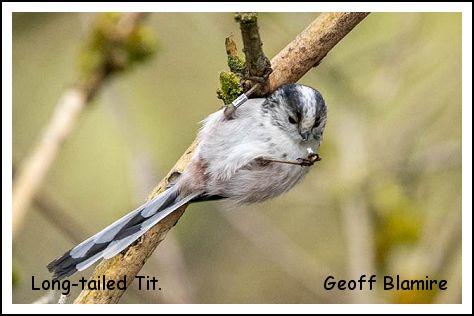 year’s nest while the pair of Egyptian Geese sat under the tree – rather think the geese are not going to give up on the elite address!
year’s nest while the pair of Egyptian Geese sat under the tree – rather think the geese are not going to give up on the elite address!Then afterwards we met up with Darren at Rostherne gate for him to give us a key, code, map and where to park, for us to carry out Willow/Marsh Tit survey. He had to go back to work and left us to do a recce in Witchcote Wood – a fabulous wood. We think we’ll have to do another recce before doing the survey because we ran out of time, obviously before mid-March.
Today we did a very quick visit to Rostherne (nephew and family arriving tomorrow – so lot to do!). Nice to see 4 Long-tailed Tits, Goldcrest and 2m and 3f Goldeneyes. "..........
Yesterday they paid a second visit to Witchcote Wood ........"Did our 2nd recce this morning covering all areas. We walked (scrambled/tripped/leapt) just under 5km but it felt as more 50km!
It’s a fabulous wood, with so much potential. We flushed 2 Woodcocks from different parts of the wood; 2 Buzzards really didn’t like us being there with a lot of screaming (again from different parts of the wood); we disturbed a superb fox with a magnificent winter coat; finally we came across a pair of Goosanders on Birkin Brook! "............
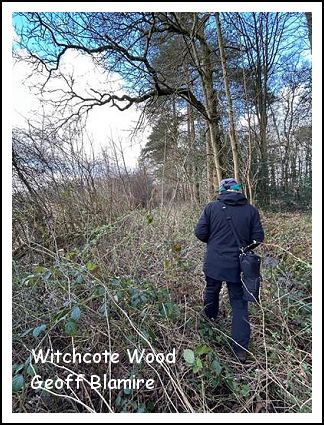
Thanks team, let's hope the Goosanders nest again, Jayne Davies came across a family party there in 2021 ........."I was out in the Tatton deer enclosure, and was surprised and delighted to see a female goosander with 9 little chicks on the brook that flows through the deer enclosure to the Birkin. Sadly no record shot - I was taken completely by surprise, and they swam away pretty quickly towards the Birkin as soon as they saw me. I just had time to count the little ones." "...........
On Saturday (22/2) Jude Halman and I completed the Willow Tit survey on Knutsford Moor and Dog Wood, in Tatton Park ..........."At last some decent weather, 12°C and dry for Jude and I as we completed the first Willow Tit survey on Knutsford Moor and in Dog Wood.
The birds seemed to appreciate it too, there was plenty of springtime activity with song from Blue, Great and Coal Tits. More Song Thrushes than I have heard for a long time. Three separate Treecreeper sightings and lots going on in the heronry.
On the Mere Canada Geese, Goldeneye, Pochard, Mallard, Great Crested Grebes.
No responses from the Willow Tit recordings, although it did attract Great Tits! "............
So no luck this time from these two sites, nor from Sandmere but we'll be repeating the same exercises a second time in a few weeks time.
Also on Saturday Bob Groom went over to Rostherne Mere.............."my first visit to the Observatory in some time and it was quite rewarding. Lovely weather indeed. Frequent Buzzard sightings and 2 Sparrowhawks, Great Spotted Woodpecker, Redpoll, Goldcrest, 2 Goldfinches, Chaffinch, Long Tailed Tit, Nuthatch, Coal Tit catching a fly! Song Thrush serenaded us. Phil had a good count of Wigeon but after he'd gone, numbers rose still further (to c.120), c.140 Lapwings.. Stock Dove was a notable sighting (these days). Party of Redwings passing.. 8 Goldeneyes but only a single Goosander. Several Shovelers and a good number of Teal. No heron seen."..............
Bob returned to the obs. on Monday, staying a little longer than he'd planned!.........."I headed over to the Observatory late morning, meeting Tony on his way out. The sun was shining and it looked promising for a good session. There was a Shelduck on the mere and a Sparrowhawk zipped past. Male and female Goosanders and Goldeneyes.
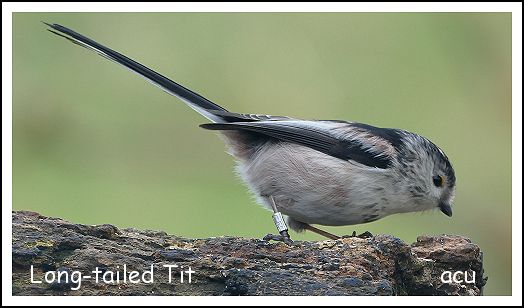
Raven, c.80 Lapwings, Long Tailed Tit, Goldcrest, 2 Goldfinches, Chaffinches, Nuthatch.. Suddenly the Sky darkened and a dramatic storm ensued. Sleet was briefly illuminated by the sun as it thrashed the mere. A tremendous crack of thunder sent all the Wigeon (42 per TU) into the air, circling in panic before dropping back down to the water. The sleet turned to rain and the sky slowly cleared. I hung on and hung on and finally a Buzzard appeared and circled round. By then it was 3.00 PM and I needed to leave..
(Light showers was the Met Office caption for today. What a joke, after the storm there was a lot of water everywhere..)"...............
Karina has circulated a message for all KOS members with details of forthcoming events, beginning with this Friday's indoor get together..........."A few KOS updates for your Spring diary:
This Friday 28th Knutsford Jubilee Hall 8pm: ‘Wild Islands: the Nature of the Falklands’ by professional photographer Mark Sisson.
Wild Islands: the nature of the Falklands
‘This talk is in tandem with my latest book of the same title, produced in association with Falklands Conservation. This wonderful archipelago has become almost a spiritual photographic home for me over the last decade that I have been photographing here and this talk looks to illustrate just why. You can expect plenty of penguins, an abundance of albatross and a diverse array of images that will illustrate the real nature of just why these islands offer so much in terms of wildlife and photography.’
It’s our penultimate talk of the season. Come along beforehand and have a catch up with the friendly KOS group.
March will be with us this weekend and we have a trip to Leighton Moss for you followed by our final talk for a while.
Saturday March 15th : RSPB Leighton Moss 10.00 am. I'll be leading this and will be in touch soon with all the details.
Friday March 28th : 8pm ‘Vibrant Sri Lanka: Blue Magpies, Blue Whales and Blue Skies’. Ashley Grove. Knutsford Jubilee Hall.
Thanks to Sheila for organising such a great variety of talks for 2024/2025; she's already organised another brilliant programme starting in September. "..........
Thanks Karina. Non-members are welcome at all our indoor meetings, there is an entry fee of £6 but, for children under 18, it's absolutely free.
The indoor meetings start at 8:00pm but doors are open from about 7:15pm - Jubilee Hall, Stanley Road, Knutsford WA16 0GP
19th February 2025 .......... Sand Martin competition entries.
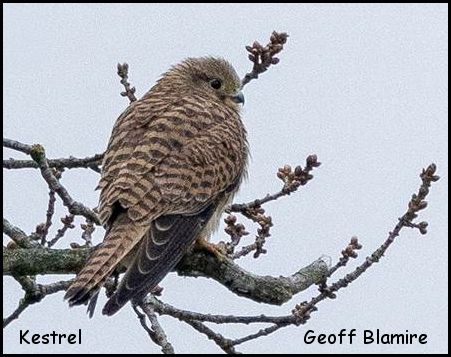 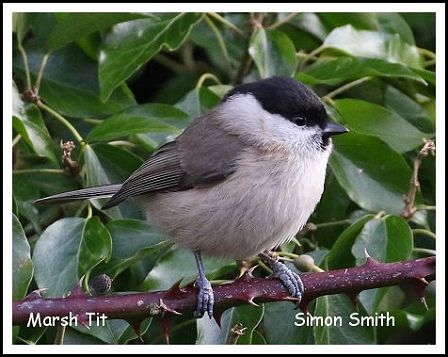 |
29 entries for this years Sand Martin competition, slightly down on last year but it wasn't publicised anywhere else, just on this website.
As usual there's a big range of dates; from the 23rd of February through to the 27th of March.
Three dates have each attracted four
On Monday Judith Halman and I visited Sandmere and Dovemere in Allostock, as part of the Willow Tit and Marsh Tit breeding survey organised by RSPB Northwest and the Cheshire and Wirral Ornithological Society (CAWOS). Looking through some of my old notebooks, the first mention of Sandmere was on the 2nd July 1974 when Len Mason and I paid a visit. Sandmere and Dovemere are separated by a narrow bund and now owned by the Prince Albert Angling Society but there are public footpaths around both waters.
In those early days sand extraction had just finished and the main attraction were nesting Little Ringed Plovers and, on that first visit, we found two nests with eggs. Gradually, over the years, birch trees have taken over and now cover large areas of what were sandy deserts. It is here that Willow Tits could be found and is the last place I have seen them in the breeding season, away from their stronghold at Woolston Eyes.
Jude and I covered 4Km on Monday, stopping in likely spots to play a recording of Willow Tit songs and calls but, on this occasion, there was no response. We have another chance later in the Spring when hopefully it'll be a bit warmer!
The temperature on Monday was just 2⁰C , a continuation of the cold conditions we've recently "enjoyed"! My weather station showed that the temperature has risen over 10⁰C on only one day (3/2) in February so far. The average of readings taken every 10" is only 4⁰C !
Geoff and Sheila Blamire found it a bit nippy last Tuesday on their daily walk ..........."Did a 11km walk to Rostherne area this morning – it was cold!

Little Mere: the last update was that the pair of Egyptian Geese have taken over the Grey Heron nest from 2024 – well this morning pair of Grey Herons have reclaimed their nest! One of the Egyptian Geese was under the tree. Rather think the herons will have the upper hand versus the geese…..
Ciceley Mill Pool: female Goosander (unusual here), pair of Mute Swans and Grey Wagtail on the flooded car park (see Geoff’s photo).
Rostherne: Martin’s Field 140 Fieldfares (majority)/Redwings/Starlings, Sprouts Fields c80 Redwings on the furthest field, the nearest field to the car park had been commandeered by a Buzzard and a Kestrel!! Obs just female Bullfinch (and the usual passerines) and very few wildfowl – disappointing. "...............
Meanwhile Simon Smith and Lyn Graves have been a little further afield.
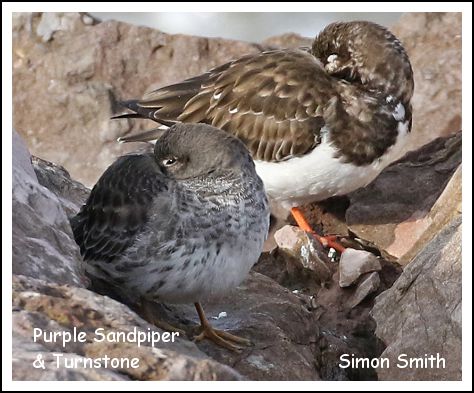
This from last Sunday (16/2)
............"We went to Leighton Moss yesterday. The feeders were attracting the usual suspects and the Marsh Tits were posing nicely. At the Causeway hide, we had a good, close look at Common Gulls that were in a mixed flock with Black-headed. A Bittern flew across the entire reed bed but, as usual, it was too far for a decent photo. (Pictures attached)"..............
And yesterday (18/2)
............."We went to North Wales yesterday for a spot of sunny, but breezy birding: Llanfairfechan (Turnstone & Oyster Catchers), Marine Drive, Llandudno (Eider, Guillemot in winter finery & Shag), RSPB Conwy (few birds, cafe closed – no bara brith!) and Rhos-on-Sea (Golden Plover, Purple Sandpiper). Pictures attached"...............
Derek and Jean are still getting plenty of House Sparrows in the garden ..............." This morning looking through bathroom window, I wondered what all the blobs in the trees far side of Academy field were with my bins counted most of them 80+ Woodpigeons. Jean went far a walk around Redrow site heard a Raven, we had around 20 House Sparrows in garden but they were flighty smallest movement and they were gone, came back and gone again all within seconds, we still have one Song thrush visiting. "..............
Here in Bucklow Avenue we're not seeing any House Sparrows but, by way of compensation, up to 12 Goldfinches, 5 Greenfinches, 5 Siskins and single Chaffinches and Redpolls.
11th February 2025 ...... Hawfinches
First of all, a reminder that the closing date for the 2025 Sand Martin Competition is this coming Saturday (15th February). So, if you haven't already entered, you should do so ASAP by clicking here. It will only take a couple of minutes and remember it's open to anyone, not just KOS members.
Our assumption that Maria Freel's Hawfinch, outside the window of her flat in the Tatton Park mansion, was a first ever Tatton record was misplaced as Steve Barber has pointed out in an email after the latest update of the 28th January.
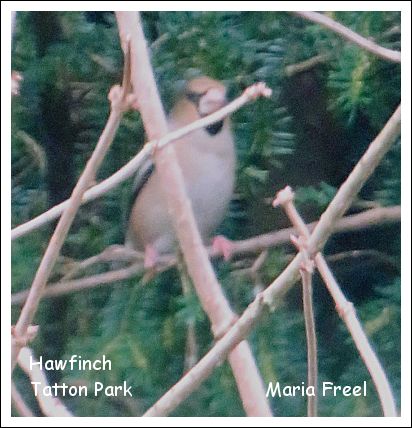
............."Back in January 1997 Bryan Roberts prepared a summary list of the birds of Tatton Park and Knutsford Moor. The list included Hawfinch with the comment "5 records of 9 birds late Feb-May".
For what reason, I don't know but perhaps I was looking stuff up for Bryan. Anyway, I have a note of two Tatton Park records. One bird on 9th May 1942 seen by A R Summerfield and reported in the L&CFC Report for the year and another of three birds there on 28th April 1963 from the MOS Report for the year.
Their Cheshire status was somewhat different in those days!"............
Thanks Steve and thanks Maria for your record shot of the actual bird - it could well be the Park's first record this century!
Geoff and Sheila Blamire's daily outing on the 31st of January revealed more signs of a long-awaited Spring ............."We walked just under 12km around Millington area this morning – definitely winter thrush morning! Chapel Lane 90 Redwings, then little further down Peacock Lane c300 winter thrushes in 1 field – about 2/3 Redwings and 1/3 Fieldfares. Little Mere we saw Grey Wagtail and a Goldcrest on the same fence! Definitely looks like the pair of Egyptian Geese are planning to breed on Little Mere – one was on the Grey Heron's nest from 2024 with the other one under the tree with the nest.
Spring is definitely in the air – saw crocuses last week and this week snowdrops at 2 different sites. "................
The following morning (1/2) found them heading over to Rostherne Mere.........." This morning we did 12km walk from home, along Chester Road, round Cherry Tree Lane, along Marsh Lane, through sprout fields to the Rostherne Obs. Not much of note until we got to the sprout fields: 150+ Fieldfares, c60 Redwings and Kestrel which flew into Wood Bongs
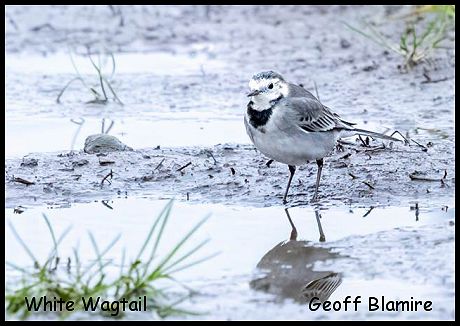 where singing Mistle Thrush and Song Thrush. Quite busy below the Obs: drumming GS Woodpecker, singing Cetti’s Warbler, Long-tailed Tits, Goldfinches, etc.
where singing Mistle Thrush and Song Thrush. Quite busy below the Obs: drumming GS Woodpecker, singing Cetti’s Warbler, Long-tailed Tits, Goldfinches, etc.Little Mere: the pair of Egyptian Geese where actually on the heron's nest (from 2024), plus a Grey Heron on the margins. "...........
Last Saturday G&S were surprised to come across a very early White Wagtail!!............"We decided to go to Plumley/Holford this morning to see if we could find any Curlews (after the talk yesterday evening). We did! 9 Curlews (small number but at least we saw them), c25 Wigeon (half the flock were grazing on the grass), c50 Redwings, GS Woodpecker heard drumming, 3 Dunnocks displaying, we disturbed a Buzzard with a small rodent, then 4 Pied Wagtails – except I’m sure that one was a White Wagtail. See Geoff’s photos"..............
Bob Groom was on grandad duties last Wednesday (5/2) and took the team over to Redesmere .........." A lovely afternoon so we went over to Redesmere to 'feed the geese' though there may even have been more BHGs! No less than 4 drake Goldeneyes, a Curlew flew over, as did a Buzzard. The usual 'sentinel' Cormorant. A big gathering of Fieldfares , Redwings and Starlings in the adjacent field. (Former 2 species in 3 figures.) On the way back called at Acre Nook, already difficult to see the water with the planting and in a few weeks it will be impossible. Spoilsports is too mild a word for them..".............
Judith Halman was in Tatton the following morning (6/2)......"What a fabulous day, frosty in Tatton this morning Great White Egret still on Melchett mere lots of Song Thrushes singing. The Allen hide no KOS cards so I left the three I had in my pocket but I would like some more if you have some handy"............
As I'd just received my Tatton Garden Society membership pack (it allows members access to the park plus free parking at any of the car parks) I went in on Friday (7/2) and did the necessary......."Nice to see the feeders were full and were attracting numerous Blue, Great and Coal Tits, plus a male Great Spotted Woodpecker. Two Treecreepers were in view on the birch trees surrounding the hide.
On the Mere three Grey Herons and the resident Great White Egret; Mallard, Wigeon, Teal, Tufted Duck, Gadwall and Little Grebe.
Some good photo opportunities but I'd left my camera at home!"...........
I wasn't able to attend the February field trip due to a prior engagement but it seems to have gone very well and trip leader Sheila has sent me an excellent account of proceedings.
KOS trip on Sunday 9th February was to Neumann’s Flash and Marbury Country Park. The weather forecast was reasonably okay but it ended up very chilly with a cold wind – at least it kept dry!
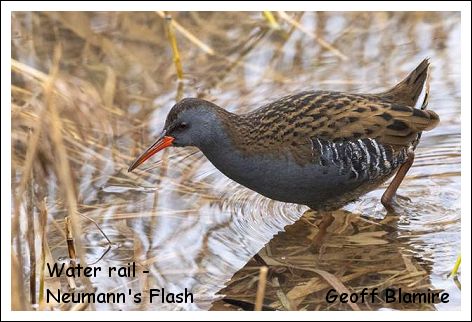 10 members set off at 10am from the Witton Mill Bridge car park to walk along the Witton Brook towards Big Wood via Butterfinch Bridge. We added Robin, Jackdaw, Blue Tit, Blackbird, Reed Bunting, Teal, Mallard, Goldfinch, Long-tailed Tit (always good to see), Woodpigeon, Song Thrush, Carrion Crow, Coal Tit, Great Tit, Magpie, Nuthatch, Chaffinch and couple of Buzzards overhead. The first stop in the Big Wood was at the Woodland Hide where the bird feeders attracted many small birds, but our attention was drawn to a stunning Goldcrest – the smallest bird in the UK.
10 members set off at 10am from the Witton Mill Bridge car park to walk along the Witton Brook towards Big Wood via Butterfinch Bridge. We added Robin, Jackdaw, Blue Tit, Blackbird, Reed Bunting, Teal, Mallard, Goldfinch, Long-tailed Tit (always good to see), Woodpigeon, Song Thrush, Carrion Crow, Coal Tit, Great Tit, Magpie, Nuthatch, Chaffinch and couple of Buzzards overhead. The first stop in the Big Wood was at the Woodland Hide where the bird feeders attracted many small birds, but our attention was drawn to a stunning Goldcrest – the smallest bird in the UK.The wind factor increased as we reached the path slopes down to the waters edge of Budworth Mere. Wildfowl included Mute Swans with their cygnets, Canada Goose, Great Crested Grebe, Black-headed Gull, Lesser Black-backed Gull, Herring Gull, Cormorant, 6 Oystercatchers, Coot (c40!), Tufted Duck, Lapwing and 5 gorgeous Goosanders – 2 males and 3 females. Not as many as we saw on our Christmas walk but still a treat to see. We moved onto the viewing screen overlooking Coward Reedbed, where we met up with our 11th member, and where we consumed well-earned elevenses. While looking out for one of the 2 Bitterns occasionally seen from the hide (no luck), but did increase our list with Kingfisher (brief view!), Grey Heron, Cetti’s Warbler, single Shelduck, Curlew (several seen bathing) and 3 stunning male Goldeneyes.
Although we failed to see Hawfinch on the Christmas walk we decided to give it another try around the Ranger’s Cabin and the "Carriage Drive". Drums roll….. the majority of our members managed to see one, with help from Steve Hart (who used to be a KOS member a long time ago). A new species for some!
Final destination was Neumann’s Flash via Diary House Meadows, where very few wildfowl were present – surprisingly no Wigeon, just a small flock of Shoveler, 1 male and 1 female Goosander and only 2 Shelducks. But seeing a pair of Pintails, many peoples favourite duck, made up for this. Walking down the Bund we visited Pod’s Hide overlooking a different part of Neumann’s Flash – it didn’t disappoint when the "confiding" Water Rail appeared – nice way to finish our 8.55km morning "stroll".
Species recorded on trip to Neumann’s Flash and Budworth Mere on Sunday 9th February 2025: |
28th January 2025 ......... a new species for the Tatton list?
I normally try to update this part of the KOS website three or four times a month, sometimes even more during the Spring. Just two this month I'm afraid as, the morning after the "Re-fresh Knutsford" exhibition, I went down with a dose of 'flu. Not just ordinary flu, this was man-flu - the real deal!
Anyway, somehow I survived but did miss some significant events including the important January committee meeting when the programme for the next 18 months is decided, the indoor meeting on the 24th January and the two Big "Garden Birdwatch" events with The Friends of Knutsford
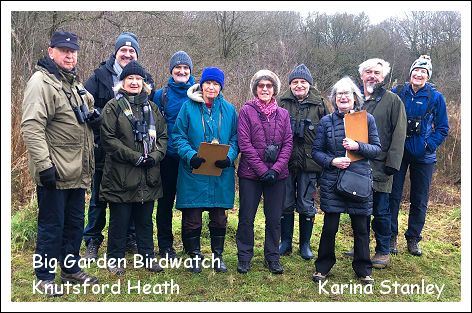 Moor on Saturday (25/1) and the Friends of the Heath the following day.
Moor on Saturday (25/1) and the Friends of the Heath the following day.KOS Treasurer, Frank Dearden kindly summarised the two indoor events for me.
....."The outdoor programme has one new site and the return of two names from the past. Whixall Moss is in the programme for July of this year. In March 2026 there is a trip to Point of Ayr, proposed by Bob; followed in April by a day trip to Lake Vyrnwy. The multi day outing is to Anglesey in May. Sheila is investigating whether that hotel on the Anglesey side of the Menai Bridge is available.
First class meeting last night; you would have loved it. No birding - all ornithology. Alan Fielding showed a few slides of Eagles and a brief video of the fitting of a tag. For the remaining slides there were lots of maps and charts and even (after a health warning) a couple of graphs!! Fascinating stuff. The first half of the talk explained what we have learnt from satellite tagging before moving on to tagging’s impact on raptor persecution. This last part was, for me, surprisingly positive.
Good turnout once again for the meeting. Twenty-one in attendance, despite several regulars missing the subject matter had attracted others.
When news leaked out that you would not be present, Darren immediately leapt into your chair and said that he was taking command of the lights!"......
Thanks Frank and also thanks to Darren for looking after the
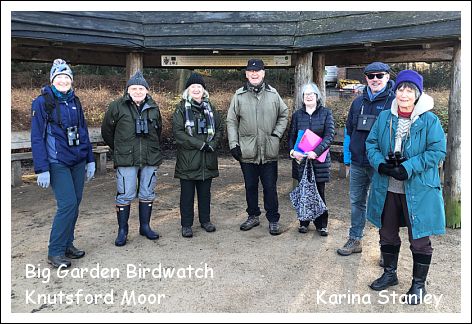 lights - without any training too!!
lights - without any training too!!The three day holiday from Sunday 15th June to Tuesday 17th June has been completely revamped and details of the new arrangements have been sent via email to all KOS members.
KOS Secretary, Karina reminds us of two events coming up in February ........."Sunday February 9th Neumann’s Flash Witton Car Park 10:00 am leader Sheila Blamire
Sat.nav.CW9 5LN near the entrance to the Northwich recycling centre.
Kindly let Sheila know if you intend to come along chairman@10x50.com
It’s a nice close venue and Sheila will lead us around the area according to the latest best finds.
Our Speaker Meeting is about the Falkland Islands:
Friday February 28th Wild Islands: the nature of the Falklands Mark Sisson. 8pm Jubilee Hall, Knutsford WA16 0GP.
‘This is talk coincides with the publication of my latest book of the same title, produced in association with Falklands Conservation. This wonderful archipelago has become almost a spiritual photographic home for me over the last decade that I have been photographing here and this talk looks to illustrate just why. You can expect plenty of penguins, an abundance of albatross and a diverse array of images that will illustrate the real nature of just why these islands offer so much in terms of wildlife and photography.’ "..........
The morning after our January field trip to Tatton, Geoff and Sheila Blamire were out and about again on their daily walk (12/1) ...........""After the lovely walk yesterday in Tatton Park we decided to do Holford and Plumley this morning. Set off in fog but it cleared quite quickly. We walked through the Inovyn offices towards Cape of Good Hope Farm where there's a big pond which has produced many species. It was completely frozen over but nearby a flock of 190+ Lapwings were hunkered down in the snow and nearer to us were 5 Snipe. Down the Holford track we were pleased to see that the Barn Owl was in its box – so it has survived the cold spell. Nearby were 14 Curlews, 4 Lapwings, 6 Fieldfares and c50 Starlings. At Langford Farm we recorded 3 Curlews, 8 Lapwings and 4+ Snipe. Driving back along Hulse Lane, in the garden of Hulse Heath Farm, 25+ Fieldfares and 5+ Redwings were feeding on fallen apples. Saw them there in Jan/Feb 2023 as well.
So another good morning…… .............
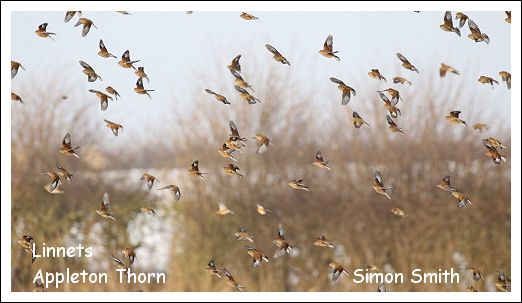 On the same day (12/1) Simon Smith and Lyn Graves spent some time closer to home near Warrington........."Apologies for the no-show yesterday. We find Tatton cold at the best of times and just couldn't face it with yesterday's temperatures, though I expect it looked beautiful in the frost.
On the same day (12/1) Simon Smith and Lyn Graves spent some time closer to home near Warrington........."Apologies for the no-show yesterday. We find Tatton cold at the best of times and just couldn't face it with yesterday's temperatures, though I expect it looked beautiful in the frost.I’ve been out today, chasing a large flock of finches that a neighbour saw. Turned out to be hundreds, if not thousands, of Linnets gleaning the fields near Appleton Thorn – pictures attached, including a brief video of their murmuration-like activity. There were a few Chaffinches with them but, surprisingly, no Goldfinches. Also saw the occasional Yellowhammer and even a Brambling "............
With all the recent snow and ice, Bob Groom has been confined to barracks but was finally able to get out to Rostherne on the 18th January........"My first visit to the Observatory this year was quite rewarding. Kestrel in Tatton Dale en route. Buzzard , looking formidable in the nearer dead tree. Later Sparrowhawk thermalling with a Buzzard. Couple of hundred Lapwings. Redpoll, briefly perched. Goldcrest in big tree to the left. Also Nuthatch, 4 Goldfinches and a Chaffinch visiting the bird table. Great Spotted Woodpecker in mereside tree. Heron, two Mute Swans, m & f Goldeneyes, 2 m Goosanders, Tawny Owl calling (at mereside), 3 Stock Doves. 20+ Canada Geese in field. Pair of Great Crested Grebes performing the weed ceremony, they obviously think it's Spring! "...........
He was out again the following morning at Tabley doing the monthly WeBS count with Pete Kelly ......."Very cold and raw, but at least fine. Must credit Pete for bearing with my extreme slowness. No big numbers, apart from close to a hundred Mallard. c.20 Greylags.1 Little Egret, 1 Heron, 1 Cormorant, only 1 Great Crested Grebe. 'Highlight' male and female Goldeneyes. 2 Shovelers. 2 M.S. Surprising absence of buzzards but Pete was lucky spotting a peregrine. Good views of Raven."...........
Geoff and Sheila were out at the same time and also found it a bit nippy! ..........."We agree it was very cold and raw – probably coldest this year! But we were pleased we went!!!
Highlights: 400+ Lapwings; 41 Curlews; 2 flocks of Redwings (c40 and c50); flock of 100+ small birds including Chaffinches (mostly), Greenfinches, Goldfinches, Reed Buntings, and had a very brief sight of a possible Brambling (could have more species, eg Linnets); 14 Wigeon; Little Egret; Barn Owl; Grey Wagtail; Buzzard; etc. ".............
Most people seemed to have been disappointed with their Big Garden Birdwatch results this year but Derek Has sent me the results from Knutsford Moor (Saturday 25th) and Knutsford Heath the following day. ..........""
Saturday 25th January - 11am-noon
KOS assisting Friends of the Moor.
Weather - Full sun no cloud 2c at start 5c at finish. Wind nil slight breeze at finish.
Members of KOS - Karina, Jude Jayne, Frank ,Derek, Joy
Members of F o M Janet Mc Cappin +1
Two groups Karina,Jayne , Frank + male . second Janet Frank Joy Derek.
Maximum number of birds in view at the same time.
3 Blackbird, 73 BHG, 2 Blue Tits, 2 Canada geese,1 Carrion Crow,2 Coots,2 Goldfinch,1 GSW,2 Great Tits,9 Jackdaws,4 LTTits,5 Mallards,5 Moorhens,2 Nuthatch,1 Redwing,2 Robin 2 Mute Swan,12 Tufted Duck,5 Woodpigeons, 1 Wren,1 Jay, 1 LBB Gull,1 Treecreeper,3 Whistling Ducks,5 House Sparrows, 2 Cormorants 2 Magpie. ............
The following day, on the Heath.
Sunday 26th January 11am -12pm
KOS assisting Friends of the Heath
Weather - 4c nearly full cloud cover at start, finish cold strong wind, sleet
Members of KOS Frank, Jude, Joy, Jayne Davies, Alan Gillespie, Derek and Karina
Members of Friends of the Heath
Kevin Griffiths, Jan McCappin, Terry Griffiths and 5 others.
Maximum number of each species in view at the same time
1 Blackbird, 2 BHG,3 Blue Tits, 5 Carrion Crow, 2 Goldfinch, 1 Coal tit,1 Collared Dove,1 Feral pigeon,1 Great tit,3 Jackdaws,2 Jays, 6 Long-tailed Tits, 2 Magpie,1 Nuthatch,1 Robin 8 Woodpigeons,1 Wren.
Not very good
https://www.friendsoftheheath.org.uk/bgb-2025-the-results
Thanks Derek - it's the taking part that counts!
I did our garden Birdwatch at the same time, on Sunday and did quite well. Just 10 species but this included 11 Goldfinches, 2 Greenfinches and, with 5' to go, 2 Siskins. My first of the Winter!
Maria Freel, who has a flat in the grounds of Tatton Park, did well during her one hour session when a Hawfinch appeared on the feeders! Darren and I think this is a new species for the park!!
Tatton regular, Roger Barnes tells me that the first herons have returned to the heronry in Tatton's Higmere plantation. So Spring really is just around the corner.
While you're here click this link to enter our KOS 2025 Sand Martin Competition. It's open to all, not just KOS members. You'll find the easy-to-follow instructions and it should only take a couple of minutes to complete.
Wendy Stratford had a walk to Gleavehouse Pool on the 16th of January and did quite well ............" Walked to the pool this morning (weather too good to resist). It was frozen solid with no birds (no water visible at all).
However the walk was well worth it....
40+ redwings in the horse field at pavement/Gleavehouse junction.
5 meadow pipits in first Gleavehouse field
40 starlings in field east of livery stables
At least 40 fieldfares in the skylark field (counted 3 times making sure didn’t count redwings and starlings!) By some way this is the largest number of fieldfares I have ever seen. On the way back there were more - counted 76!
2 buzzards sat on the hedge of skylark field
A skylark was singing (not full song, but singing!) over field behind Obs
60-70 lapwings in the field behind the last house on the right before Mill Lane
The weather was sunny and cloudless all the way, and surprisingly dry underfoot.
"...............
Thanks Wendy, it's a great area at any time of the year and I'm looking forward to the warmer weather when the Swallows have returned to the farm and a quick scan of the paddocks often reveals passing Wheatears.
Skylarks will be in full song and the Yellow Wagtails have returned to add a splash of colour. On the pool itself perhaps the Shelducks will breed again and, who knows, the Little Ringed Plovers may stay for the Summer. Whatever, it will be great to just sit there and enjoy the peace and tranquility.
We have no time to stand and stare?
12th January 2024 ....... The Tatton Field Trip.
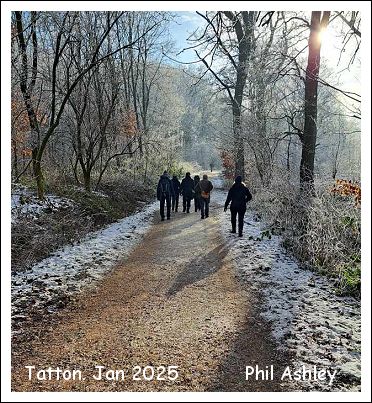 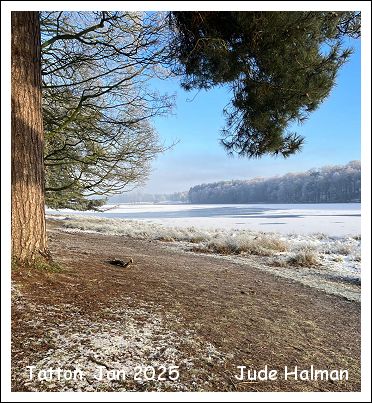 |
-7.5⁰ C as a small group of stalwarts met up at the Dog Lodge layby for our January field trip to Tatton Park. The snow that fell during the week hadn't melted and had become compacted and icy
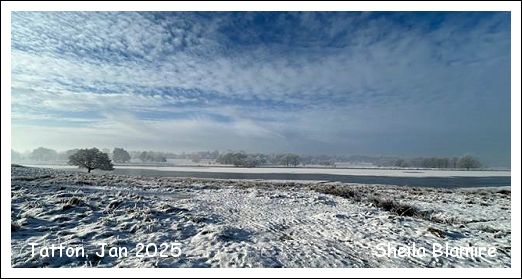 , so we set off slowly and carefully; except of course for the "professionals" in the group who were fully equipped with slip-on snow grips and bounded ahead!
, so we set off slowly and carefully; except of course for the "professionals" in the group who were fully equipped with slip-on snow grips and bounded ahead!Fortunately Middle Walk had been gritted and we were able to navigate this, the steepest part of the walk, safely and make our way to Knutsford Moor.
The Moor pool was completely frozen over and held only two Mute Swans, Lesser Black-backed and Black-headed Gulls, with a Moorhen calling from the reedbed and an overflying Siskin.
Reaching the main Knutsford entrance to the park we turned right and headed towards Tatton Mere. The woodland here proved quite productive and provided, Nuthatch, Treecreeper, Bullfinch, Blue Tit and drumming Great Spotted Woodpeckers for the day list.
The mere was almost completely frozen over but, in the distance, we could see a patch of clear water that held a large collection of water birds. Before then though, close to the waters edge, a stand of conifers that was clear of snow was full of small birds taking full advantage of the exposed undergrowth. Here were Redwings, a Jay, Stonechats, Goldcrest and even a couple of Meadow Pipits.
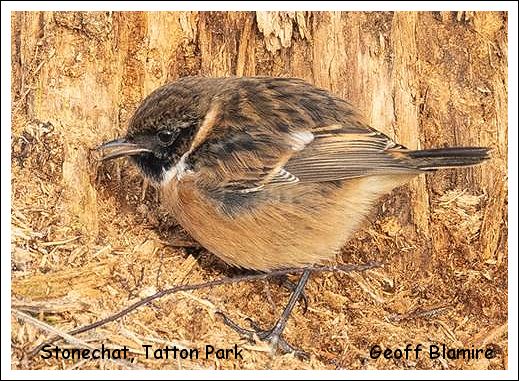 . Normally you'd find the Stonechats in the reeds, swooping down for any insects that ventured out into the open but here they were grubbing around at the base of a rotten tree, quite unperturbed by our presence and kids sledging a few yards away on one of the park's few little slopes (see Geoff's picture).
. Normally you'd find the Stonechats in the reeds, swooping down for any insects that ventured out into the open but here they were grubbing around at the base of a rotten tree, quite unperturbed by our presence and kids sledging a few yards away on one of the park's few little slopes (see Geoff's picture).Moving on to the remaining patch of unfrozen water, we recorded a nice selection of wildfowl. Canada Geese were the most numerous species, estimates varied between 200 and 1,000 but, let's say, there were a lot! Also present, Mallard, Tufted Duck, Goldeneye, Coot, Pochard, Great Crested and Little Grebes. a flock of noisy Greylag Geese appeared out of the mist that came and went all morning, bringing with it a sudden drop of temperature so that, when it lifted and the sun broke through, it actually felt quite warm!
The plan now was to walk to the Allen Hide for elevenses but when we arrived there we found that it was padlocked (incidentally, the Knutsford Drive [from the Knutsford entrance up to the Mansion] is never gritted avoiding any chance of later run-off into the mere, a SSSI). Consequently there was no road traffic on that route all morning.
While we were deciding on a course of action Karina found us a small flock of finches feeing on seed heads overhanging the outlet stream from Melchett Mere; Siskins and Redpolls. Fantastic views and a photographers dream, as you can see by Geoff's superb image!
We decided to make our way back along the east side of Tatton Mere, then through Dog Wood to the cars.
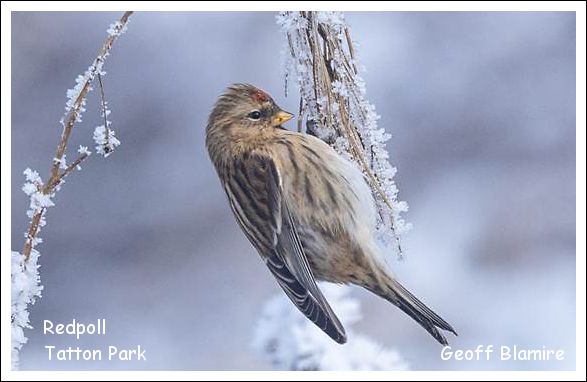 Highlights of part#2 of the trip included a trim little Grey Wagtail exploring the reeds on a small, frozen pond, the morning's only raptor - a Buzzard and a singing Coal Tit in Dog Wood.
Highlights of part#2 of the trip included a trim little Grey Wagtail exploring the reeds on a small, frozen pond, the morning's only raptor - a Buzzard and a singing Coal Tit in Dog Wood.We'd been out for about three hours and covered 6.04Km; the day list reached 43 species and it had become warmer, a sizzling -2⁰ C as we said our goodbyes!
More Siskins are now arriving in our gardens; Tony Ellis had nine in his Knutsford garden last Thursday (9/1), Wendy Stratford a single bird the following day on Smith Lane in Mobberley and, on the same day, Jayne Davies had the first of the season in her garden, only about 100 yards from our house in Mobberley but I've yet any on our feeder.
Geoff and Sheila had an interesting morning a week ago (4/1) on their daily walks ........." We go to Rostherne probably 3 times each week but this morning we timed it superbly. John Adshead brought up to the Obs an adult male Kingfisher he'd caught in Doll’s Meadow. What a beautiful bird to see up close. Other birds seen include 2 Goosander, female GSW, female Bullfinch, 88 Canada Geese, plus usual wildfowl. On sprout fields up to 40 Redwings, 15 Fieldfares, 5+ Song Thrushes and 1+ Mistle Thrush. Walking back the shooters in the field next to Ciceley Mill had just finished – and were walking back to their vehicles which were taking up all the footpath. Also Little Mere: 2 Egyptian Geese."...........
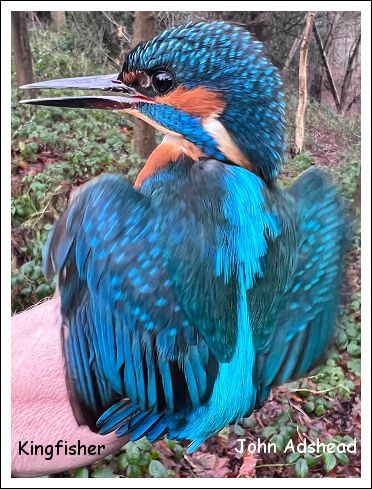
This coming Saturday (18/1) Knutsford Town Council are again organising their Re-fresh Knutsford event. As last time the KOS will have a stand, this time we've been promoted and will be in the main St. John's Church. Will we get any new members? We didn't last time but if we don't attend we certainly won't!!.
More important dates for your diary from KOS Secretary Karina - it's going to be a busy month .........."KOS January 2025 updates
This Saturday 11th January is our trip to Tatton. 9:15 am Tony Usher is our leader. Meet in the Dog Lodge layby, Mobberley Road. Weather forecast for 9:15am looks crisp and grey. Kindly let Tony know if you intend to come along. Thank you. tony.usher@zen.co.uk
Evening meeting:
Jan 24th Friday Jubilee Hall 8pm ‘Where Eagles Fly - what satellite tracking has shown us’ by Dr Alan Fielding.
We now have enormous amounts of data from satellite tracking devices fitted to Golden Eagles in Scotland. The information from these tags is providing many new insights into Golden Eagle ecology. For example, when do they disperse, where do they go, when and where do they settle? What does information from the birds tagged for the South of Scotland Golden Eagle project tell us about the potential for a revival of Golden Eagles in England?
Come along for a social catch up before 8pm. We look forward to seeing you there.
RSPB Big Garden Birdwatch local events
Saturday January 25th 11:00-12:00 am Friends of the Moor invite KOS members to help with the annual event. Turn up on the Moor by the pavilion and you can join the fun. Contact Jan FOTM for more details if needed. jan_mccappin@hotmail.com
Sunday January 26th 11:00-12:00 am Friends of The Heath will be hosting their event and value KOS members input. Turn up on the Large Heath at the starting point by the notice board on the west side by Northwich Road. Contact Kevin FOTH for more details if needed. kevin@bainhall.co.uk
We are putting together next year’s programme of events. All ideas and feedback much appreciated. ".............
Now then a chance to do some proper ornithology and do your bit for conservation!!
........" CAWOS is undertaking a new species survey in 2025 of Marsh-tit and Willow-tit. The survey being led by Hugh Pulsford and Professor David Norman.
Comparison of the 2004-2006 ATLAS* data with current information suggests a significant decline for both species across Cheshire and Wirral. RSPB North West in conjunction with Lancashire Wildlife Trust and Greater Manchester Carbon landscape projects are also conducting similar surveys to the north of us in 2025. Additionally, there are other conservation groups looking at habitat management. Therefore, in working collaboratively we hope to improve the future prospects for these declining species.
For practical and technical reasons it’s not possible to send all the associated information in this one message to all CAWOS members. Therefore we ask if you could please read the information below carefully and then, if you think you might be able to get involved, email ahugh.pulsford@btinternet.com for the full information pack, giving details of the area you might be able to cover.
Survey requirements in summary
For Willow-tit two sessions, up to 14 days apart in calm weather from Mid-February to early March and mid-March to early April.
For Marsh-tit two sessions, up to 14 days apart in calm weather from Mid-March to early April and mid-April to early May.
Willow-tits prefer waterlogged (Carr) broad leaved woodland with birch and scrub available (although during the ATLAS, some were located in mixed woodland). Willow Tits tend to feed almost exclusively in the scrub layer, and is one of only a few species that excavates their own nest hole.
Marsh-tits are a bird of mature woodland, especially of Oak or Beech, a habitat preference very different from that of Willow-tit. A scrub layer of mixed vegetation of 2-4 m is important, and they prefer quite extensive woodland stands of trees.
A simple playback technique early in the breeding season can identify birds on territory. Therefore, surveyors will need a playback method via mobile phone or an mp3 player. The playback recordings will be provided. Recording methods will be paper-based in the field (form provided), plus an a later web upload.
The field-based methodology involves walking across an areas of suitable habitat and stopping every 200m or so and play the call/song for 2 minutes. You then wait up to 5 minutes for any response, the type of which you can record on the form, along with any habitat details and a precise grid reference.
Location data from the Atlas for both species will be provided, showing the layout of km squares (tetrads). Whilst it is essential to try and have any previous confirmed/probable or possible breeding tetrads covered, we are very keen for any new suitable habitat areas to be covered, right across the Cheshire and Wirral. Please note that a negative result is very valuable. So if you have a local patch or local area nearby, then please have a go and record presence or absence.
For Willow Tit, The Woolston Eyes reserves and beds are being allocated to WECG members. Similarly, Rostherne Mere NNR and Danes Moss CWT, and the area north of Danes Moss are already allocated to surveyors.
If you are not sure if your local area is suitable, or if you have any other queries please do not hesitate to ask. Cheshire and Wirral is an extremely large area so we need lots of volunteers please! If you have any local connections via clubs/societies/community groups who you think might be able to get involved please do forward this message.
Kind regards
Carolyn (sent on behalf of Hugh Pulsford)
ahughpulsford@btinternet.com "............
Last but certainly not least. Please enter the 2025 KOS Sand Martin Competition. It's open to anyone and will take only a couple of minutes of your valuable time.
Species recorded on our trip around Tatton Park on Saturday 11th January 2024. |
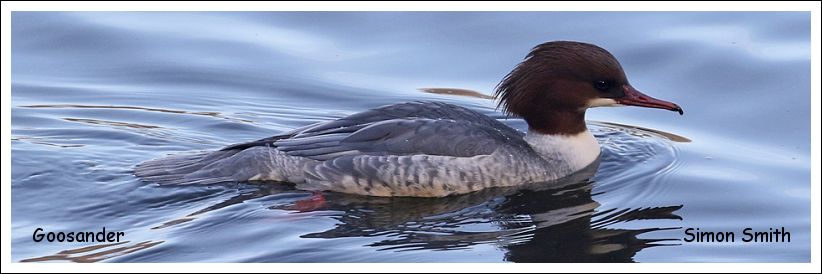 |
KOS members were out and about over the Christmas period, even on Christmas day!
Geoff and Sheila Blamire drove out to the Plumley area.........." As we drove up Moss Lane towards the Inovyn offices c24 Redwings and c6 Fieldfare passed overheard, then as we parked c200 Starlings were seen and Curlews heard (never did see them!). Heading towards Cape of Good Hope Farm we could hear the distinctive call of Wigeons – took me a few minutes to find them on a pond which is difficult
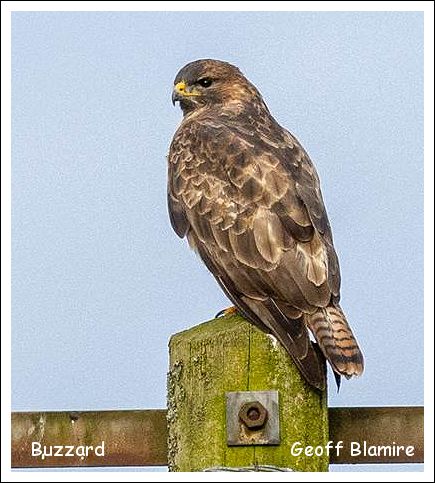 to see from the track. We checked in the Barn Owl box (seen the Barn Owl every time since the end of November) – but not this time.
to see from the track. We checked in the Barn Owl box (seen the Barn Owl every time since the end of November) – but not this time.We had 3 great sightings of Buzzards. First along the railway – one sat in a tree with its wings drooping down – very unusual. Then one perched on top of a pole – it didn’t move as we drove underneath it. Finally, the best, was one eating a pigeon along Trouthall Lane, Plumley – just a couple of feet from the car.
We finished at Keepers Cottage. There was a man looking through a scope – he was looking at a Yellowhammer. Haven’t seen Yellowhammer since end of September. We then checked the field with horses along Cheadle Lane – the Little Egret was still there.
So a great morning – then back for Christmas lunch…… ".............
Derek Pike and Jean Brooks turned back the clock and took a stroll along nearby Sudlow Lane ................ "We decided to have a Christmas day walk, like we did in the old days. We walked down Sudlow Lane, the first notable sighting was a Raven on top of a pylon making a racket, great views looking through bins, with its beak opening and shutting, next notable sighting some fifty yards in front, on the other side of M6, was a Buzzard sat in a tree scouting for prey in the sunshine. We could hear Nuthatches in two or three places, and had a quick view of a GS Woodpecker.
The very first sighting, not counting the dozen or so House Sparrows in the garden along with a Robin, was a House Sparrow, then a Carrion Crow followed by - Wood Pigeon,Black-headed Gull, Magpie, Blackbird, Great Tit, Blue Tit and Jackdaws, Jean also spotted a pair of Egyptian Geese, also Jay, Starling, Pied Wagtail and that was about it.
There was a paucity of small birds, where were all the Goldfinches for example and not one Fieldfare or Redwing.
If I kept records, which I don't, my gut feeling was that years ago we would have seen many more species and more birds in general; but not a Raven or Egyptian Goose of course!
But a lovely day weatherwise and a good stroll."
In Knutsford KOS Secretary, Karina Stanley, reports (also on Christmas day) a Yellowhammer behind Bexton Hall, a flock of c.70 Winter thrushes (more Fieldfares than Redwings) and a Grey Wagtail. She also has a male Blackcap in the garden, feeding on apples and, perhaps not quite so welcome, the first Ring-necked Parakeet on her garden feeders!
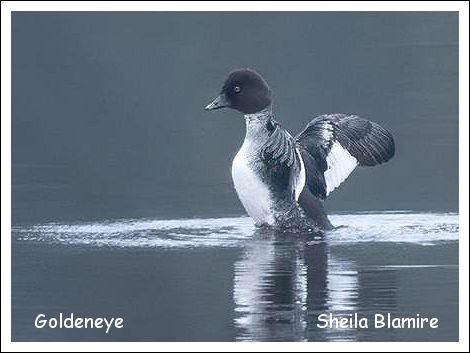 I mentioned in the last update (24/12/24) that Mistle Thrushes were in song at more than one location. They've now been joined by Song Thrushes, as Geoff and Sheila noted last Saturday (28/12) ..........." Little Mere: female Goldeneye, 3m Shovelers, plus usual Tufted Ducks, Mallards, Cormorant, Coots, etc.
I mentioned in the last update (24/12/24) that Mistle Thrushes were in song at more than one location. They've now been joined by Song Thrushes, as Geoff and Sheila noted last Saturday (28/12) ..........." Little Mere: female Goldeneye, 3m Shovelers, plus usual Tufted Ducks, Mallards, Cormorant, Coots, etc.Ciceley Mill Pool: 3m 2f Wigeons, pair of Mute Swan, 6 Tufted Ducks, Mallards, Grey Heron, Coots, etc.
Rostherne village: 3 Ring-necked Parakeets eating tree buds (originally 2 of them eyeing up Mrs Gates feeders!).
Sprout Fields, Rostherne: 80+ winter thrushes (more Redwings than Fieldfares), c30 Meadow Pipit (the furthest field), 2 singing Song Thrushes on the edge of the fields – competing against each other.
Rostherne Obs: 2 female Bullfinches eating the old blackberries, usual Nuthatches, wildfowl (limited visibility), etc…. "..........
A good turnout on Monday (30/12) for what's become our annual Christmas walk, taking in Neumann's Flash and Budworth Mere. 16 members assembled in the Witton Mill Bridge car park where the trip leader Sheila outlined the route that we'd be following. A couple of Redwings flew overhead and a lovely Grey Wagtail landed amongst the parked cars as we set off towards Butterfinch Bridge. The expected species were added to the day list as we made our way over to Budworth Mere via Big Wood - Jay, Long-tailed Tit, Robin, Nuthatch, Song Thrush, Blackbird, Goldfinch, Chaffinch and Wren.
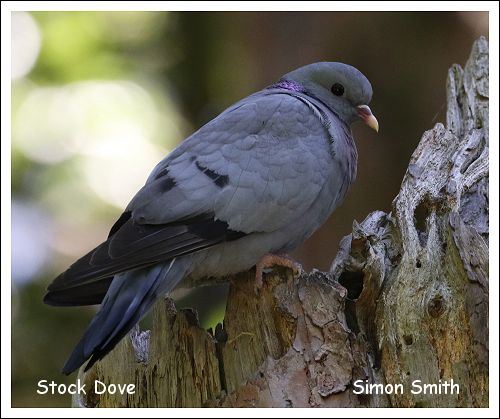
A decent collection of wildfowl were on view as we reached the mere where the path slopes down to the waters edge. Stars of the show were once again the Goosanders, 21 of them in total, in pristine winter attire. What beautiful birds!
Other species seen included Canada Goose, Mallard, Great Crested Grebe, Little Grebe, Teal, Mute Swan and Tufted Duck. Across the far side of the mere Frank Dearden picked out a handful of Curlew, probing the mud along the shoreline.
Elevenses were enjoyed when we reached the viewing screen, overlooking the T. A. Coward memorial reedbed. The feeders were very busy but we only had brief views of one of the resident Kingfishers. Despite a long session a little further on, there was no sign of the Hawfinches that have been frequenting the tall trees to the rear of the rangers' buildings. A local birder I talked to had been watching for some hours but had seen only one bird as it flew overhead.
On then down Marbury Lane as far as Butterfinch Bridge where we took a left turn and headed toward Neumann's Flash; a Cetti's Warbler sang briefly as we approached the reedbeds and out on the water another nice selection of water birds. Here Wigeon predominated with about 60 birds present but also smaller numbers of Shoveler and Shelduck, two Great White Egrets showed well, albeit at a considerable distance across the far side of the flash. The list now stood at 46 species for the morning but this was increased to 50 by a contribution from Bob Groom, who'd followed a different route to the rest of the party, including Stock Dove. I was glad about that as it's given me a chance to feature the superb image, taken at Burton Mere by Simon, of this beautiful but often overlooked species!!
2025 has begun with some challenging weather conditions. Overnight my weather station recorded 69.9mm (2.75") of rain and social media posts are awash (literally!) with pictures of the resultant floods. Sudlow lane, where Derek and Jean walked on Christmas day, is impassible, images from Smith Lane in Mobberley show a floating car under the railway bridge and in Tatton water is pouring off the adjacent fields into the Mere. I guess the same is happening at Rostherne. The sky is clearing at the moment and temperatures will drop below freezing tonight, so it should provide interesting driving and walking conditions in the morning!
As we visited Budworth Mere / Neumann's Flash on Monday it's been decided to move January's field trip there to February and swap February's Tatton walk to January (Saturday 11th). I will be leading this outing, so let me know if you intend to come along. tony@10X50.com
We've not heard anything yet from the Friends of the Moor or Friends of the Heath about the RSPB's Big Garden Birdwatch on January 25/26 this year (we're normally invited to help out). Enquiries are ongoing.
We also volunteered to take up a table at this year's "Refresh Knutsford" event but again we've not heard anything.
Looking forward to Spring, we are now inviting entries to the 2025 Sand Martin Competition where you're asked to use your skill and knowledge to predict (guess!!) when the first Sand martin will appear over Tatton or Melchett Mere. It's not you who has to find it, there will be plenty of people looking and it's open to anyone not just KOS members. There will be a small prize for the winner. Only one entry per person is allowed and anyone found cheating will again be suspended upside down over a picture of a well-known personality. This year, of course, it will be Donald Trump. So get your entry in NOW by clicking here and filling out the form - a 2' job!
So that's it, you're up-to-date, so it only remains for me to wish a happy and healthy New Year to all KOS members and friends and anyone else who happens upon this little bit of cyberspace!
Species recorded on the Christmas walk Budworth Mere - Monday 30th December 2024 |
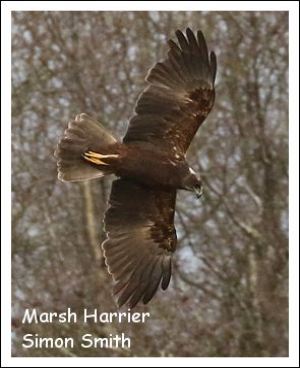 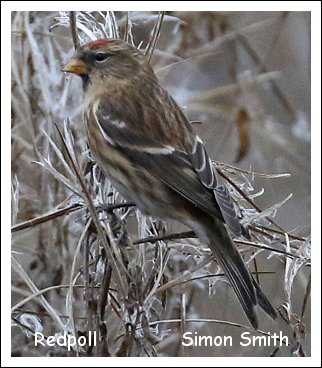 |
It's always nice to get the shortest day behind us and we're able to look forward to lighter mornings and evenings, although we'll have to wait until the 30th December before the latest sunrise this year.
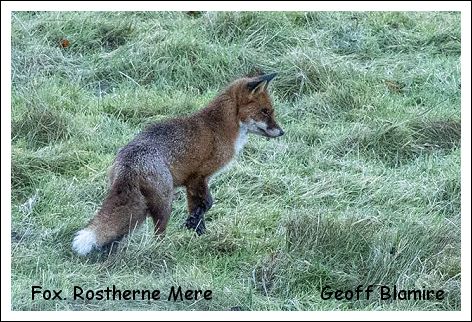 Cheshire's earliest Sand Martin record is the 15th of February, so not long to wait now and I'll have to rescue the Sand Martin competition from cyberspace and try and remember how it all works!
Cheshire's earliest Sand Martin record is the 15th of February, so not long to wait now and I'll have to rescue the Sand Martin competition from cyberspace and try and remember how it all works!Walking down the garden the following morning to fill the feeders I was delighted to hear the full song of our resident Dunnock, an uplifting sound like that of a bubbling mountain stream, a sure sign that Spring is just around the corner!
More signs from Knutsford today (24/12) where KOS Secretary, Karina had a Mistle Thrush in song, as did Geoff and Sheila at Rostherne on one of their daily walks.
On his way to work in Tatton Park, early this morning, Darren Morris heard a Great Spotted Woodpecker drumming as he cycled through Dog Wood. Darren also tells me that he's had both Little and Great White Egrets in the park recently. On the 21st he recorded two Great Whites, neither of which bore leg rings, so it looks as if they are additions to the long staying bird carrying a red ring, that was previously reported.
Last Friday (20/12) Geoff and Sheila were in the Rostherne observatory and watched a fox vole hunting, just in front of the obs. Geoff managed to get some excellent shots, one of which you can see on the left. Later in the day Bob Groom visited the reserve and, although he didn't catch up with Reynard he didn't do badly ........"G&S had been watching a handsome fox catch prey just before I arrived. My highlight was a Peregrine that flew low across the mere from Mere Covert to Harper's Bank. C.50 Lapwings, frequent Buzzard sightings, Jay, good selection of wildfowl including a Goldeneye.."...........
Yesterday (23/12) we enjoyed a morning visit to the observatory; walking over the turnip fields, in the distance, a flock of c.30 Pink-footed Geese
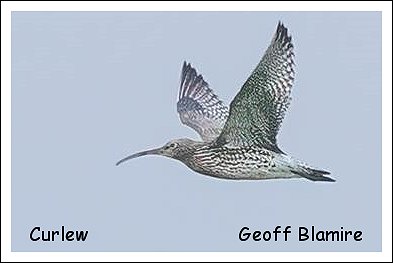 headed west and the same number of finches were commuting between the field and the peripheral hawthorn hedge. Also there about 25 Redwings and a handful of Fieldfares. Apparently the latter are well down in number this winter.
headed west and the same number of finches were commuting between the field and the peripheral hawthorn hedge. Also there about 25 Redwings and a handful of Fieldfares. Apparently the latter are well down in number this winter.Wildfowl were also down in number but we did have 42 Wigeon. 2 Goldeneye, 3 Goosanders 3 and 21 Shoveler. In front of the obs. Goldcrest and Treecreeper.
Geoff and Sheila seem to be doing well with winter thrushes and over-wintering Curlew ..........." Sunday 22nd Dec Plumley and Holford area: must have had every season this morning – very windy, sun, rain, hail and a rainbow! About 12 Curlews (just love their haunting calls), 40 Redwings, Kestrel hovering only 8+ feet high in strong winds (in the drive to Plumley), and finally a Little Egret with horses in a field along Cheadle Lane (amazing – saw one there 1st Jan to 5th Feb 2023).
Monday 23rd Dec Millington area: 20+ Redwings, another site 30+ Redwings, 12 Fieldfares and 24 Starlings and 1 or 2 Buzzards. Little Mere: Great Crested Grebe, 3 Shovelers, Grey Heron, Tufties, etc and a Grey Wagtail.
Our walk this morning was over 12km – by the time we got back my fitbit registered 21,000 steps – the next time I looked the battery was dead – so I 'lost' all those steps where the weeks total is concerned (I aim for 135,000 - 140,000 steps per week). ".............
Nice to hear from Simon Smith and Lyn Graves from Warrington. Simon has been trying for the Marbury Hawfinches for some time now, perhaps he'll have more luck next Monday on our Christmas walk to Budworth Mere ..........."We went to Marbury last week, but still haven’t caught up with the Hawfinches yet. There appear to be up to 5 now, at times. However, nice view of a juvenile Marsh Harrier over the reedbed there and, of course, Redwings in the usual place.
Also, was at Burton Mere Wetland on Sunday and had a good look at a small flock of Lesser Redpoll.
Pictures attached. "..........
Thanks Simon. You can see the images at the start of this update.
17th December 2024 ............ The Christmas Party.
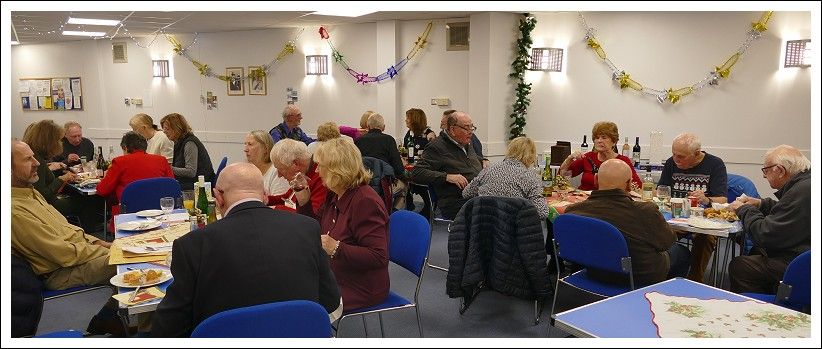 |
24 members and friends enjoyed our KOS 50th anniversary Christmas party last Friday evening (13/12). Secretary Karina and her husband David had again been busy decorating the Jubilee Hall and setting out the tables earlier in the afternoon prior to our arrival.
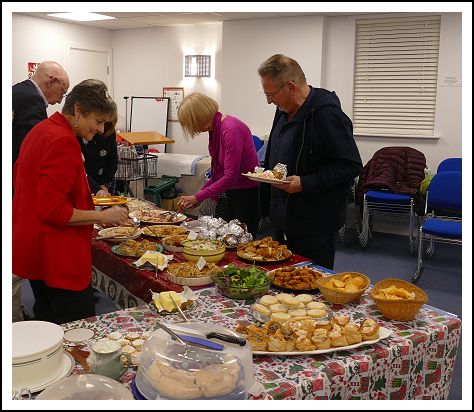
As tradition demands, I provided the baked potatoes and gradually more people arrived with their offerings - all the usual favourites - Goostrey's pork pies, specially flown in from Mobberley, sausages, cooked meats etc. and a table full of puddings, ready to challenge the self-discipline of those who should really be watching their sugar intake!
My picture quiz proved to be a little more challenging this year and the tie-breaker wasn't needed. Sheila Blamire proved to be the eventual winner with a score of 43 out of 50.
The evening was rounded off in fine style by Dave Butterworth who took on the unenviable task of auctioning off unsold items from the bring and buy table. Every little helps!
This annual party is our main fund raising event of the year and provides much needed cash that help to pay for hire of the hall and lecturers' fees. Hon. Treasurer, Frank Dearden had done the necessary calculations and revealed that this year we raised a record amount for the kitty!
"Thank you to all involved for the staging of a very successful and enjoyable evening.
On the financial front it was the best party ever. Gross takings were £468 beating the previous best of £442 in 2019/20. Within this total a sum of £130 was raised for Lower Moss Wood Nature Reserve.
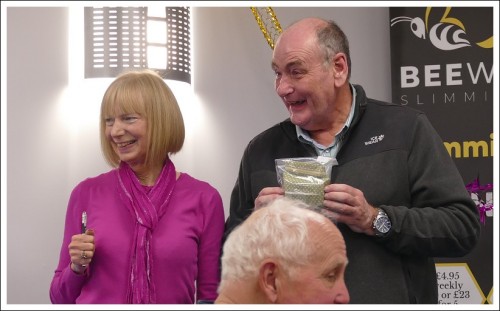 The breakdown of takings was as follows:
The breakdown of takings was as follows:Admission £223.00
Raffle £105.00
Bring and buy / Butterworth auction £89.20
Donations £51.00
£468.20
Thanks again and Merry Christmas!
Frank"
Thanks Frank and all who contributed to such as successful evening.
Yesterday (16/12) Jude Halman and I spent a couple of hours in the observatory at Rostherne Mere - "A mild morning with the temperature of 10°C. More wildfowl present than last week - 56 Shoveler, 24 Mallard, 29 Canada Geese, 32 Teal, 10 Mandarin (all male), 72 Wigeon, 4 Egyptian Geese, 1 Goldeneye and 13 Goosanders.
1 Buzzard, 2 Grey Herons, Cetti's Warbler in song, male Great Spotted Woodpecker and a Treecreeper.
A flock of c.35 Meadow Pipits in the "sprout field" on the way back to the car park. (the sheep are actually feeding on turnips https://www.farmseeds.co.uk/products/forage-crops/roots/stubble-turnip/ so it should be the "turnip field" !)"
The Goosanders were very active, perhaps there's a hint of Spring in the air as we're now only four days away from the shortest day of the year!
In the early days of the KOS we used to have field trips down to the Shropshire meres in the hope of catching up with their wintering Goosanders but now it's become unusual not to see the species when visiting Rostherne on any day in December. In fact, a week ago on the 12th December Mike Duckham counted no less than 35 Goosanders. A record count and the most since 32 in January 2011 during a spell of unusually cold weather.
Two days later the same observer had a Lesser Spotted Woodpecker on one of the alder trees in front of the observatory; so it looks as though the Lesserpeckers are hanging on in our area!
On Sunday (15/12) Bob Groom and Pete Kelly did their December WeBS count at Tabley Mere and were delighted to find both Little and Great White Egrets in attendance. It's an ideal location for both species to breed; at one tome Tabley hosted Britain's largest heronry.........."A bit treacherous underfoot with the wet leaves and branches broken off by the gales but at least it stayed fine. One Great White
 Egret and at least three Little Egrets the highlights. Couple of Herons, 5 Cormorants. 8 Great Crested Grebes, 4 Goldeneyes, Lots of Mallards but very few Coot. A welcome 16 Pochard. Long-Tailed Tits in the wood."..........
Egret and at least three Little Egrets the highlights. Couple of Herons, 5 Cormorants. 8 Great Crested Grebes, 4 Goldeneyes, Lots of Mallards but very few Coot. A welcome 16 Pochard. Long-Tailed Tits in the wood."..........Needless to say, the Blamires, Geoff and Sheila have been out and about on their daily walks. This from the 7th December .........."Seen many winter thrushes around Millington over the last few days:
Peacock Lane: 41 Redwings, 8 Fieldfares, 5 Blackbirds, 1 Mistle Thrush and Boothbank Lane: 60 Fieldfares, 20 Redwings. Some of the Fieldfares have superb plumage.
Seen the regular Kestrel along Peacock Lane, Raven along Boothbank Lane, but the male Goosander seems to have disappeared from Little Mere – been there from Sat 30th Nov to 6th Dec. "...........
More recently, yesterday (16/12),........." We walked to Knutsford this morning because Geoff had a dental appointment – 11.8km!
Yesterday morning we went to Plumley/Holford but number of birds was down: 200+ Starlings, 3 Wigeon, 3 Redwings, Barn Owl in the BO box and 2 Curlews only – we visited all sites we’ve seen Curlews over the last 4 years but nothing there…. 1st January 2023 we had 207 Curlews from 2 sites – so hope the numbers increase next month! "..........
Colin Butler has produced an excellent report of his recent trip to Gambia. Non-stop birding from start to finish including plenty of humorous anecdotes (the proof and sensitivity reader was laughing out loud as she read Colin's report)!!! You can read it here.
Tatton ranger Darren Morris has kindly sent me a copy of the Winter addition of the Tatton Winter Wildlife Newsletter. You can read it here.
Thanks Colin and Darren.
4th December 2024 ......... Marshside and Martin Mere.
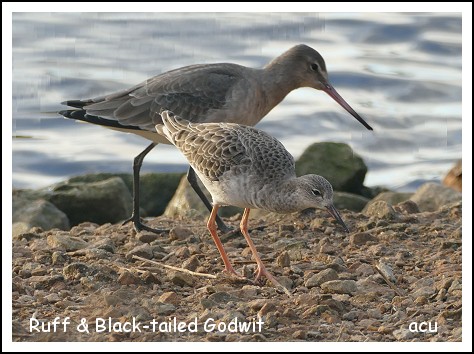 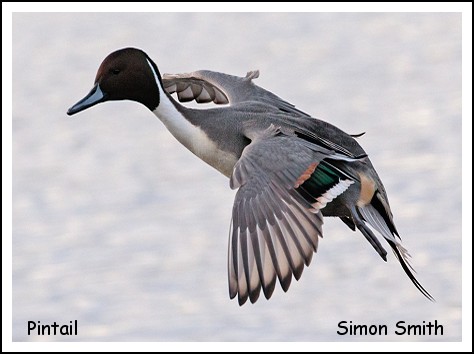 |
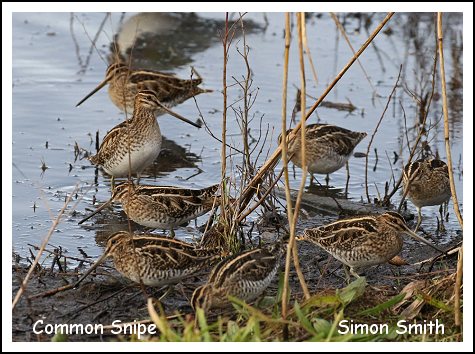 |
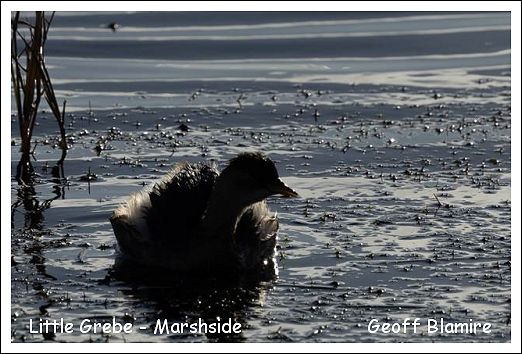 So it was wall-to-wall sunshine as we reached Marshside but this brought its own problems as, at this time of the year, the sun is low in the sky and, as the hides at Marshside look east, viewing was difficult with many of the wildfowl only seen in silhouette. (see Geoff's Little Grebe image). Slightly overcast would have been preferable but you can't have it both ways and it was better than the rain we'd driven through on the way!
So it was wall-to-wall sunshine as we reached Marshside but this brought its own problems as, at this time of the year, the sun is low in the sky and, as the hides at Marshside look east, viewing was difficult with many of the wildfowl only seen in silhouette. (see Geoff's Little Grebe image). Slightly overcast would have been preferable but you can't have it both ways and it was better than the rain we'd driven through on the way!Frank gave us a quick briefing (he'd done a reccè the previous weekend) before we set off towards the Sandgrounders' hide.
The day list began with the expected species - Skylarks, Woodpigeons, Meadow Pipits overhead and flocks of Pink-footed Geese in the distance. From the hide - Mallard, Moorhen, Cormorant, Curlew, Gadwall, Wigeon, Teal, Canada Goose, Shoveler and Shelduck.
Moving on to Nel's hide, via the junction viewing screen, Colin and Don were lucky enough to catch a quick view of a Peregrine as it landed briefly on a fence post overlooking the estuary. Good numbers of list-filling passerines popped in and out of view in the thick roadside hedges as we walked down to Nel's - Reed Bunting, Greenfinch and Goldfinch; Bob Groom was also able to add Kestrel and Sparrowhawk to the day's tally.
There were some spectacular flocks of birds on view from the hide - Redshanks, Lapwings, Black-tailed Godwits and, especially, Golden Plovers in their hundreds. From time to time something would spook them and they'd take to the air en masse, flashing gold and white against the Winter sun.
 |
We spent about two hours at Marshside, longer than usual as it's normally so cold there out in the open, but it was a mild day, peaking at 14⁰C during the afternoon.
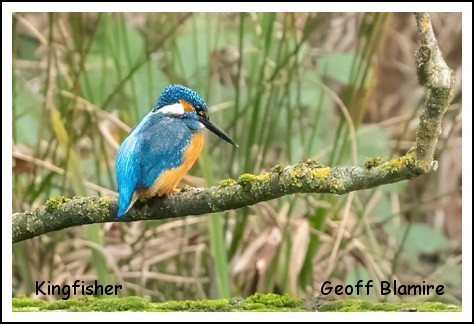 Eventually Frank decided that it was time to move on to Martin Mere; we had a bit of luck on the way when we spotted a Cattle Egret in a field full of sheep, we'd had them at Martin Mere last year at this time but, on this occasion, it was the day's only sighting.
Eventually Frank decided that it was time to move on to Martin Mere; we had a bit of luck on the way when we spotted a Cattle Egret in a field full of sheep, we'd had them at Martin Mere last year at this time but, on this occasion, it was the day's only sighting.Admission to Martin Mere is undoubtedly expensive (free for members of the WWT, otherwise £16.50 for adults and £14.81 for concessions). I thought it was worth the expense, huge numbers of a whole range of species, all in one place. Close-up viewing, ideal for the less experienced and for the photographers amongst us. I ended up with 36 images from various sources all of which would have looked good on this website!
Anyway we all filed in and then, as is often the case with the KOS, members dispersed to their favourite part of the reserve - the Ron Barker hide, the Discovery hide (for butties) or, in my case, the restaurant for a coffee.
Walking down to the Ron Barker hide more species for the list - people recorded Blackbird, Blue, Great and Long-tailed Tits, Chaffinch, Goldcrest, and Siskin. A lone Marsh Harrier floated over the phragmites reedbeds and a huddle of photographers in one corner of the hide were busy snapping an obliging Kingfisher perched nicely on an overhanging branch.
This year I walked through the pens where the captive birds are housed and formed the impression that things had improved with a bigger range of wildfowl on view. Returning towards the Discovery hide in time for the afternoon 3pm feed I had a Great Spotted Woodpecker and a small group of Snipe gathered together a few yards in front of one of the viewing screens (see Simon's excellent image at the start of this update)
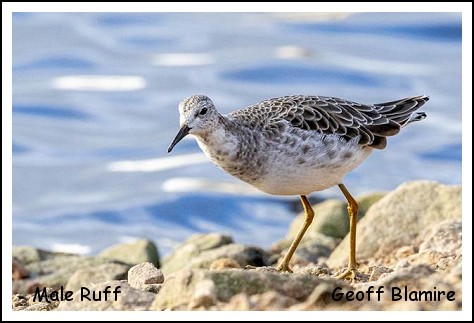
It was the usual chaos when one of the staff appeared at 3pm, scattering feed in all directions from her trolley. There doesn't seem to be any pecking order, it's everyone for themselves - swans, ducks and a few Black-tailed Godwits and Ruffs. One of the Ruffs was obviously an adult male in it's Winter plumage, it'll be a fine sight in a few months time!
We'd had a good day with 68 different species recorded this year, five more than in 2023 but it was time for home and we left at about 4pm with enough time to watch the end of the Liverpool v Man. City match that kicked off as we left the reserve. That was the plan but it wasn't to be! As we motored up Parbold Hill the Saab started to struggle with the steep incline and, with the M6 to come, Frank brought the ailing vehicle to a standstill in the driveway of a large house just before the junction 27 island. A call was then made to the RAC and, after wading through (and ignoring) various options pointing us in the direction of online facilities, Frank managed to speak to a human being who would arrange for the dispatch of a patrol vehicle. After half an hour or so our knight in shining armour appeared, although rather than a knight it was a young lady, dressed not in armour, but a head to toe orange hi-viz overall!
A laptop was connected to the car's data port and the computer and the engine compared notes before reaching some sort of agreement as to possible reasons for the power loss. The car was then jacked up and the lady crawled underneath, ponytail lying in the road, eventually re-appearing with a rusted jubilee clip from a hose
 on the turbo that had snapped off and caused the problem. A replacement was found in the van and quickly fitted to the engine; the old one was retained by Frank to be used in a future discussion with his garage!
on the turbo that had snapped off and caused the problem. A replacement was found in the van and quickly fitted to the engine; the old one was retained by Frank to be used in a future discussion with his garage!After following us for a short distance to make sure the problem had been solved our saviour drove off into the night, but not before we'd proffered our sincere thanks and asked her name, it was Lucy - Lucy in the Sky with Diamonds - a little gem!
We hadn't expected to see any Whooper Swans again for some time but a routine morning the following day (2/12) was enlivened by the appearance of 15 Whoopers at Rostherne Mere. We didn't see their arrival, so they must have flown in from the east and landed close to the Bittern hide. They were still there when we left at noon but we never had a decent view of them as they remained partially obscured behind the mereside trees at the east side of the mere. They all appeared to be adults.
The Rostherne Bearded Reedlings are still present on the reserve and one of the ringed birds has been re-trapped. In order to encourage them to remain some grit trays have been made and positioned in the reedbeds. Geoff and Sheila Blamire were there last Thursday (28/11) as the trays were being moved into position.........""When we arrived Steve (Ormerod), Sieff, Bill and Phil were busy finishing the grit trays. I asked whether at least one could be positioned so can be seen from the obs. They asked us to wave from the obs. so they could position them correctly! Unfortunately we left before we could fulfill our task so I asked Tim to do that important job! Apparently 2 trays can be clearly seen from the obs. John and Malcolm were busy ringing when we arrived and they had already re-caught (controlled) the female Bearded Reedling so they are still around. ............
The following morning G&S had a pleasant surprise on their daily amble .........."We did a 10.8km walk around Plumley/Holford this morning – postponed from yesterday because of the fog. Holford: 18+ Curlews (Langford Farm), 350+ Starlings, but the best was a Barn Owl in a Barn Owl box! Never seen Barn Owl there before, just Stock Doves and one time a Little Owl. Also male Great Spotted Woodpecker on feeders in Plumley village.".............
Don't forget that a week on Friday (13th December) it's the famous KOS Christmas party. Secretary Karina has sent an appropriate email out to all members.
Species recorded on a KOS trip to Marshside and Martin Mere on 1st December 2024. |